

Qutub Minar / Qutab Minar / Qutb Minar Delhi (Entry Fee, Timings, History, Built by, Images & Location)
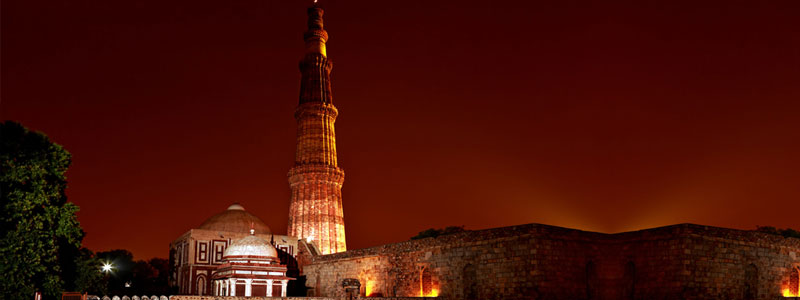
Qutub Minar Entry Fee
- 35 per person for Indians
- 0 per child (below 15 Years)
- 550 per person for Foreign Tourists
- 25 for Still Camera (non-commercial use)
- 25 for Video Camera (non-commercial use)
Qutub Minar Phone
011 2336 5358, 011 2664 3856, quick qutub minar facts.
- Type : Monument
- Status : UNESCO world heritage site
- Qutub Minar Height : 72.5 meters
- Qutub Minar diameter at the base : 14.32 meters (47 feet)
- Qutub Minar diameter at the top : 2.75 meters (9 feet)
- Qutub Minar floors : 5 storeys
- Location : Kalka Das Marg, Mahrauli
- Nearest Metro station to Qutub Minar : Qutub Minar Metro Station
- Qutub Minar Built by : Qutub-ud-din Aibak while the additions were made by his successors Iltutmish and Firoz Shah Tughlaq
Qutub Minar Timings
Links: Website | Map

Qutub Minar Address : Mehrauli , New Delhi , Delhi , 110030 , India
About Qutub Minar, Delhi
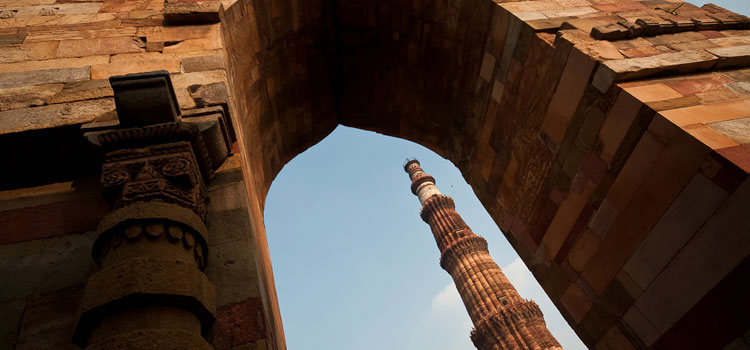
One of the most popular places to see in Delhi, Qutub Minar (Hindi: क़ुतुब मीनार, Urdu: قطب مینار) is a UNESCO World Heritage Site, presenting a glimpse into the grandeur of the past. Owing to its worldwide popularity Qutub Minar has become an integral part of every Delhi Tour.
Delhi Qutub Minar boasts of being one of the tallest minarets in the world as the height of Qutub Minar is 72.5 meters . Built in 1192 by Qutab-ud-din Aibak, it is considered to be first building, marking the arrival of Muslim rulers in the country. Although there are also a few contradicting theories on the same.
Surrounded by an appealing garden, Qutub Minar creates a sight worth remembering. Tourists also come to relax here at the garden and admiring the imposing figure of the minaret. Most of them can be seen taking photos of this stunning architecture, to remember the experience through Qutub Minar images.
Qutub Minar History
There are many stories about Qutub Minar construction. As per some, this minaret was built as symbol of victory and to mark the start of Islamic invasion, while according to some it was built for the purpose of praying. According to the widely accepted history of this minaret, it was Qutub-ud-din Aibak the first Muslim conqueror of Delhi who built Qutub Minar in in 1192.
As per the Qutub Minar history, although the construction was stated by him, only the basement of the minaret could be completed during his reign. The main mosque was also built in 1197. Later, three more storeys were added to the minar during the rule of his successor Iltutmish around 1230. After that again in 1368, the last storey of the Qutub Minar was added by Firoz Shah Tughlak.
The inscriptions of the minaret are in Arabic; these inscriptions providing detailed information on Qutub Minar. As per these inscriptions on the minaret, it was also restored by the Sikandar Lodi during 1489-1517. Later in 1829, it was again repaired by the Major R. Smith.
One could access the top of the Qutub Minar before the year of 1974. Through a path via a narrow staircase, tourists could reach the top and enjoy the mesmerising view of the surrounding areas. Later due to an unfortunate accident in 1981, the entry was prohibited.
In the month of December, 1981, there were around 300-400 tourists inside the minar when an electricity failure occurred; this led to complete darkness inside the staircase. This in turn led to stampede. Around 45 people died in that incident. This resulted in banning entry to the inside of tower. However, the architecture of Qutub Minar is equally captivating from outside, making this place worth visiting.
Qutub Minar Architecture
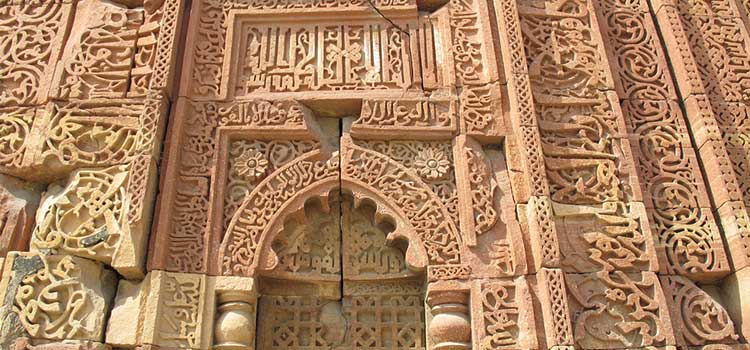
Built in the style of Indo-Islamic Afghan architecture, Qutub Minar is built with red sandstone. Presenting a perfect example of architectural excellence, it stands at a majestically. The Qutub Minar height is 72.5 meters and there are 379 steps to reach its top. The minaret is around 47 feet wide at the base while at the top it is around 9 feet. It is consisted of 5 towers, with each tower showcasing a different design. The difference in architectural style is mainly because of the changing in the rulers over the course of its construction.
Not only the style, even the materials used for building various storeys of Qutub Minar Delhi also vary from the Qutab-ud-din Aibak to the time of Firoz Shah Tughlak.
Built with red sandstone, its storeys have intricate carvings and inscriptions from Holy Quran, while balconies have been ornamented and supported by exquisitely decorated brackets. The base of storeys differs from each other. For instance, the base of first storey is angular and circular grooves while the base of second storey is round in shape and on third storey you will see angular fluting.
Qutub Minar also boasts of being taller than many popular buildings in the world such as Tower of Pisa, Great Pagoda in China, etc.
Places to see near Qutub Minar
The Qutub complex is also consisted of the mosque Quwwat u'l-Islam (Light of Islam), which is considered to be the oldest mosques in the Northern India. It has been built using the materials from around 27 temples, traces of which can be seen in the Hindu style ornamentation of the building. The architectural beauty of this mosque attracts many admirers. It is also said that Hindu artisans also helped in building this mosque. To the western side of the mosque, tomb of Iltutmish is located.
Iron Pillar is also located nearby, which is another popular tourist attraction in Delhi. Iron Pillar was constructed in the honour of Chandragupta II in the 4th century during the Gupta reign. With a height of 7.2 meters, this pillar has been built with 98 percent of iron yet it hasn’t rusted and still stand in robust condition. On the top of the pillar an image of God Garuda can be seen.
Another notable structure here is the Alai-Darwaza Gate which was built in 1311 in the Indo Islamic style of architecture.
Qutub Minar is also proud to be the first monument in India where the facility of e-ticket was introduced. In addition to this, picture of Qutub Minar on the travel cards that are issued by the Delhi Metro Rail Corporation also indicate the historical and architectural significance of this minaret.
Image Gallery Qutub Minar, Delhi

Qutub Minar Timings and Entry Fee
Qutub Minar timings are from 7 AM to 5 PM. The opening time of Qutub Minar is 7 AM and it is best to visit the monument during early morning hours to avoid the crowd. The closing time of Qutub Minar is 5 PM. It is open all days of the week.
The entry fee of Qutub Minar is Rs.35 per person for Indian residents, while for the foreign tourists, the ticket charges are Rs.550 per person.
Although one can visit Qutub Minar anytime during the day, the best time to visit is during the Indian classical music festival which usually happens during the month of November or December. While visiting, you can leave your bags in the cloakroom and explore this ancient monument comfortably.
Where is Qutub Minar in Delhi & How to reach?
Qutub Minar is located around 30-40 minutes away from the central New Delhi. From Delhi airport, it will take around 20 to 25 minutes to reach the Qutub Minar.
There are many buses that run at regular intervals to Qutub Minar. Tourists can also hire a taxi or travel in auto rickshaws. If you are wondering where is Qutub Minar then you need worry, as it is a popular attraction of the city, finding the route wouldn’t be a difficult task.
One of the best ways to reach Qutub Minar Delhi is via the metro rail. Qutub Minar has its own metro station that falls on the yellow line connecting Samaypur Badli to HUDA City Centre. There are other three metro stations located close to the Qutub Minar namely Saket Metro Station, Chattarpur Metro Station and Hauz Khas Metro Station, all falling on the Yellow line. These are at a distance of 1.8 km, 3 km and 3.7 km respectively from the monument.
Qutub minar station is located at a distance of 1.6 kilometres to the southeastern side of the monument. Tourists can take a metro train till Qutub Minar station and then hire a local auto rickshaw to the monument. It takes around 4-6 minutes to reach Qutub Minar from the metro station exit by an auto. One can also walk to cover the distance and it takes around 20 minutes to reach the monument.
Qutub Minar Facts & information about qutub minar
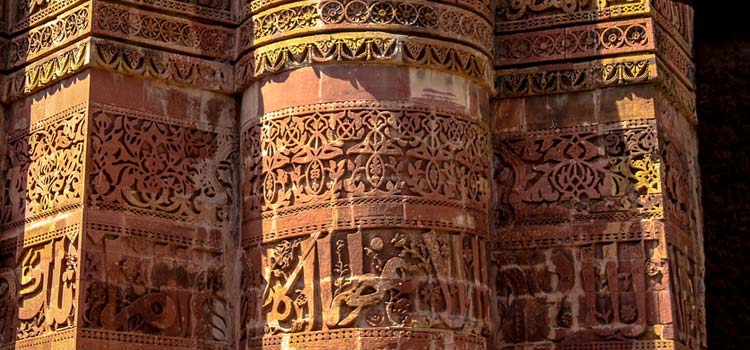
Location Map for Qutub Minar Delhi
Excited About Delhi?
Request A Call Back!
Holiday Packages
- Delhi to Kerala Honeymoon Packages
- Delhi City Tour Packages
- Delhi Local Sightseeing Tour Packages
- Delhi to Jim Corbett Tour Packages
- 1 Day Delhi Tour Packages
- Delhi to Shimla Tour Packages
- Delhi Darshan Tour Package
- Delhi & Manali Tour Packages
- Delhi Tour Packages
- Delhi Sightseeing by Metro
- Delhi Mathura Tour Packages
- Delhi Vrindavan Tour Packages
- Delhi Agra Tour Packages
- Delhi Mathura Vrindavan Tour Packages
- Delhi Agra Mathura Vrindavan Tour Packages
- Delhi Haridwar Tour Packages
- Delhi Rishikesh Tour Packages
- Delhi Haridwar Rishikesh Tour Packages
- Delhi Agra Fatehpur Sikri Tour Packages
Popular Tourist Places to Visit in Delhi
- Qutub Minar Delhi
- Red Fort / Lal Kila Delhi
- India Gate Delhi
- Iron Pillar Delhi
- Lotus Bahai Temple Delhi
- Akshardham Temple Delhi
- Humayun's Tomb Delhi
- Lodhi Gardens Delhi
- Rajghat Delhi
- Jantar Mantar Delhi
- Rashtrapati Bhavan Delhi
- Jama Masjid Delhi
- Nizamuddin Dargah Delhi
- National Rail Museum Delhi
- Gandhi Smriti Delhi
- Nehru Planetarium Delhi
- Chandni Chowk Delhi
- Connaught Place Delhi
- Hauz Khas Delhi
- National Zoological Park Delhi
- Purana Qila Delhi
- Agrasen ki Baoli Delhi
- Garden of Five Senses Delhi
- Hauz Khas Fort Delhi
- ISKCON Temple Delhi
- Paharganj Delhi
- Dilli Haat Delhi
- Lajpat Nagar market Delhi
- Sarojini Nagar Market Delhi
- Bangla Sahib Gurudwara Delhi
- Safdarjung's Tomb Delhi
- Tomb of Balban Delhi
- Sacred Heart Cathedral Delhi
- Khirki Mosque Delhi
- Fatehpuri Masjid Delhi
- Kalka Ji Mandir Delhi
- Shanti Vana Delhi
- Khan market Delhi
- Adventure Island Delhi
- Fun N Food Village Delhi
- Just Chill Water Park Delhi
- Splash The Water Park Delhi
- Scary House Delhi
- Entertainment City Noida
- KidZania Delhi NCR
- Millennium Park Delhi
- Wet N Wild Resort & Water Park Gurugram
- Jurassic Park Inn Sonipat
- Delhi Rides Amusement Park
- The Atlantic Water World Delhi
- Guru Tegh Bahadur Memorial Delhi
- Delhi Eye / Kalindi Kunj Park Delhi
- National Museum of India Delhi
- Surajkund Mela Delhi
- Karol Bagh Market Delhi
- Kingdom of Dreams Delhi
- 32nd Milestone Gurugram
- MoJoLand Water Park Murthal
- Laxminarayan Temple / Birla Mandir Delhi
- Club Platinum Resort & Water Park Delhi
- Oyster Water Park / Appu Ghar Gurugram
- Shankar's International Dolls Museum Delhi
- Aapno Ghar Water & Amusement Park Gurugram
- Parliament House / Sansad Bhavan Delhi
- Cathedral Church of the Redemption Delhi
- Worlds of Wonder Amusement & Water Park Noida
- Waste to Wonder / Seven Wonders Park New Delhi
- Drizzling Land Water & Amusement Park Ghaziabad
- Fun Town Amusement and Water Park Bahadurgarh
- FFUNMAX Amusement Park and Water Park Faridabad
- Gauri Shankar Temple Delhi
- National Craft Museum and Hastkala Academy Delhi
- Shree Adya Katyayani Shaktipeeth Mandir Delhi
- National Science Centre Delhi
- Janpath Market Delhi
- Sis Ganj Gurudwara Delhi
- Digambar Jain Temple Delhi
- Pracheen Hanuman Mandir Delhi
Guide to Qutub Minar in Delhi
:max_bytes(150000):strip_icc():format(webp)/10947453_10153084623948270_8191342691038933499_o-591d1e8d3df78cf5fa731909.jpg)
Shraddha Gosavi / TripSavvy
Delhi's Qutub Minar is the tallest brick minaret in the world and one of the most popular monuments in India . Its rather dizzying height of 238 feet (72.5 meters) could be the size of a modern 20 story high-rise residential building! The monument's stark, soaring appearance evokes a sense of mystery, as do the extensive Hindu and Muslim ruins around it. The ruins reflect the violent end of Hindu reign in Delhi in the late 12th century and takeover by the Muslims. In recognition of its historical importance, the Qutub Minar complex was named a UNESCO World Heritage Site in 1993. Find out more about it and how to visit it in this guide.
It's widely stated that Qutab-Ud-Din-Aibak, the first Islamic ruler of north India and founder of the Delhi Sultanate, commissioned the Qutub Minar when he came to power in the early 13th century. However, the monument's true origin and purpose have been the subject of much controversy among historians. This stems from the fact that the site where it's situated previously belonged to Hindu Rajput rulers. Raja Anangpal I of the Tomar dynasty established the fortified city of Lal Kot there in the 8th century. It's regarded as the first surviving city of Delhi.
Numerous Hindu and Jain temples originally covered the place where the Qutub Minar stands. Early Muslim rulers partially destroyed them and converted them into Islamic structures, using materials from the razed temples in their mosques and other buildings. As a result, the structures (including the Qutub Minar), curiously have carvings of sacred Hindu motifs or gods on them. This has created ongoing debate as to whether Hindus or Muslims actually built the Qutub Minar. And, if Muslims did, who exactly? And why?
According to common belief, the Qutub Minar was either a victory tower to mark the start of Muslim rule in India, or an Islamic minaret for muezzins to call the faithful to prayer at the mosque. Yet, researchers have multiple issues with these theories. They argue that the monument lacks appropriate inscriptions, it's too tall to have been built for call to prayer (the muezzin wouldn't be able to climb the 379 narrow spiral stairs to the top five times a day and his voice wouldn't be heard at the bottom), and its entrance faces the wrong direction.
Nevertheless, the Qutub Minar's design looks undeniably like some minarets in other countries—particularly the Minaret of Jam , a UNESCO World Heritage Site in western Afghanistan that dates back to the early 12th century.
One Ghaziabad researcher claimed that the projecting edges of the tower look like a 24-petaled lotus flower, with each "petal" accounting for one hour. Ultimately, he concluded the monument had been the central observation tower of a Vedic astronomical observatory. Most researchers do not believe this to be the case.
The Persian inscription on the eastern entrance of Quwwat-ul-Islam mosque, next to the Qutub Minar, also adds to the mystery. Historians associate the inscription with Qutb-ud-Din Aibak, and it records that the mosque was built with materials from demolished Hindu temples. However, there's no mention anywhere of the Qutub Minar's construction. Apparently, it's also not mentioned in the first official story of the Delhi Sultanate, Tajul Maasir , written in Persian by historian Sadruddin Hasan Nizami. He began compiling this important work at the time Qutb-ud-Din Aibak came to power. It focuses on his brief four-year reign and early reign of successor Shams ud-Din Iltutmish (also known as Sultan Altamash), up until 1228.
Consequently, some historians think the inscription really belongs to Iltutmish, along with the construction of the Qutub Minar.
Whether the Muslims built the Qutub Minar from scratch or converted it from an existing Hindu structure, it's certainly undergone various alterations over the years. Inscriptions on the monument indicate that it was struck by lightning twice in the 14th century! After its top floor was damaged in 1368, Sultan Firoz Shah carried out restoration and expansion works and installed an Indo-Islamic cupola on it. Sikandar Lodi undertook further works on the upper floors during his reign in 1505. Then, in 1803, a severe earthquake destroyed the cupola. Major Robert Smith of the British Indian Army carried out necessary repairs, completing them in 1828. He ambitiously replaced the cupola with a Bengali-style Hindu chhatri (elevated domed pavilion), which was an architectural disaster. It was taken down in 1848 and placed to the east of the monument, where it's called Smith's Folly.
The Qutub Minar is located in Mehrauli, in South Delhi. This neighborhood is about 40 minutes south of the Connaught Place city center. The closest Metro train station is Qutub Minar on the Yellow Line . It's about 20 minutes walk from there to the monument. The distance can be covered on foot during the cooler winter months. In summer, you'll want to take an auto rickshaw (about 50 rupees), bus (5 rupees) or taxi though.
How to Visit Qutub Minar
The Qutub Minar complex is open daily from sunrise until sunset. The best months to visit are between November and March, while it's cool and dry, with February being ideal. The complex does get crowded during the day, and especially on weekends. Hence, those who arrive early in the morning will not only get rewarded with the monument being illuminated sun's first rays but also relative peace.
Ticket prices increased in August 2018 and a discount is provided on cashless payment. Cash tickets now cost 40 rupees for Indians, or 35 rupees cashless. Foreigners pay 600 rupees cash, or 550 rupees cashless. Children under 15 years of age can enter for free. The ticket counter is situated across the road from the complex's entrance. Indians may have to wait up to an hour to be served during busy times. To avoid this, it's possible to buy tickets online . Fortunately, there's a separate line dedicated counter for foreigners, which reduces waiting time.
You'll find toilets, parking and a baggage counter near the ticket counter. Do note that food isn't allowed inside the Qutub Minar complex.
Authorized tourist guides can be hired at the complex but they narrate varied and often concocted tales. Many visitors choose to rent inexpensive audio guides instead and explore at leisure. Alternatively, a handy free audio guide app is available for download . Boards with information, including a map, are also strategically placed at key sites throughout the complex. If you're interested in history, allow a couple of hours to see everything. Unlike many tourist attractions in India, the complex is refreshingly well-maintained.
Do be aware that security guards may approach you and offer to take your photo. They will expect payment for doing so (100 rupees) but they know places for some great shots that you probably won't have thought of.
If you'd like to visit the Qutub Minar as part of a tour, there are a few options. Delhi's Hop On Hop Off Sightseeing Bus service stops at the monument. Delhi Tourism also operates cheaper full and half day sightseeing tours . The monument is included on both.
Delhi Heritage Walks conducts guided walking tours of the Qutub Minar complex on certain days of the month, as well as on a bespoke basis. INTACH runs heritage walks on weekends at different areas of Delhi, including Qutub Minar, on a rotational basis. Also check out these custom walking tours offered by Delhi Walks and Wandertrails .
What to See
The Qutub Minar is part of a larger complex incorporating several other related historical monuments, including a collection of tombs. The most significant of these is Quwwat-ul-Islam (the Might of Islam) mosque, which is considered to be the first extant mosque in India. Even though it's in ruins, its architecture is still magnificent, especially the Alai Darwaza (formal entrance).
The Iron Pillar is another baffling monument in the complex. Despite historians and archeologists intensively studying it, no one really knows why it's there. Scholars have determined that it was constructed during the early period of Gupta reign between the 4th and 5th centuries, based on an inscription on it. It's thought to have been made for a king in honor of Hindu god Lord Vishnu and originally located at Vishnupadagiri (modern-day Udaygiri) in Madhya Pradesh, where it may have been used as a sundial. Vishnupadagiri is on the Tropic of Cancer and was a center of astronomical studies during the Gupta period. What's particularly unusual about the pillar is that it hasn't rusted, due to the unique iron-making process of the ancient Indians.
The tombs in the complex are those of Shams ud-Din Iltutmish (who died in 1236), Ala-ud-din Khilji (regarded as the most powerful ruler of the Delhi Sultanate, who died in 1316), and Imam Zamin (an Islamic priest from Turkestan who died in 1539). The remains of a madrasa (and Islamic college) belonging to Ala-ud-din Khilji can also be seen.
The other notable monument is the unfinished Alai Minar. Ala-ud-din Khilji started building it to be a tower twice the height of the Qutub MInar. However, works came to a halt after his death.
Unfortunately, it's no longer possible to climb up to the top of the Qutub Minar. The monument was closed after a lighting failure resulted in a stampede, killing nearly 50 people, in 1981.
What to Do Nearby
Mehrauli is away from Delhi's other popular tourist attractions but there's plenty worth doing to fill in a whole day there. The neighborhood is dotted with an array of relics from Delhi's oldest city and the many dynasties that ruled it. Many of them can be found within Mehrauli Archeological Park, next the Qutub Minar complex. It contains the remains palaces, mosques, tombs (one of which was converted to a residence by a British official), and step wells. It's open daily from sunrise until sunset, and there's no entrance fee.
The degenerated remnants of Lal Kot lie inside Sanjay Van, a thick forest bordering the Qutub Minar complex, starting from Adham Khan’s tomb. The forest is best explored by those who like trekking. It has multiple entry points, with Gate 5 near the complex being preferred.
Still haven't had enough history? Take a trip to Tughlakabad Fort, about 20 minutes east of Qutub Minar. It dates back to the 14th century.
The 20-acre Garden of Five Senses , 10 minutes drive from Qutub Minar, is popular with nature-lovers. Its manicured grounds are decorated with sculptures.
For an offbeat experience , head to hipster hangout Champa Gali. This up-and-coming street is lined with cafes, design studios, and boutiques. It's in Saidulajab, an urban village close to the Qutub Minar complex and Garden of Five Senses.
Hauz Khas urban village is a cool Delhi neighborhood about 15 minutes north of Mehrauli. It's one of the city's best food and beverage destinations. Plus, there are yet more ancient ruins and a deer park that's fun for kids .
Alternatively, if you're feeling hungry you can fine dine at a restaurant overlooking the Qutub Minar complex. Options include international Indian cuisine at ROOH (newly opened in April 2019), European cuisine at QLA , and global cuisine (prepared using mostly organic ingredients) and whiskey at Dramz .
Finally, those who are interested in Indian handicrafts must visit Dastkar Nature Bazaar , about 10 minutes south of Mehrauli in Chattarpur. It's one of the top places to buy handicrafts in India because the products aren't the usual run-of-the-mill items. There are new themes and artisans every month, in addition to permanent stalls. Do note that it's closed on Wednesdays.
One Week in Delhi: The Perfect Itinerary
Delhi's Lotus Temple: The Complete Guide
Lodhi Garden in Delhi: The Complete Guide
14 Famous Forts and Palaces in India that You Must See
12 Most Popular Historical Monuments of India
Trips to Delhi: A Complete Guide
10 Iconic Attractions and Places to Visit in Delhi
Fatehpur Sikri in India: The Complete Guide
7 Cool Neighborhoods to Explore in Delhi
11 Abandoned Step Wells with Amazing Architecture in India
Essential Guide to Visiting Mandu in Madhya Pradesh
18 Top Things to Do in Delhi
Humayun's Tomb in Delhi: The Complete Guide
The Ultimate Guide to the Taj Mahal in India
Hyderabad's Charminar: The Complete Guide
12 Cultural Things to Do in Goa Beyond the Beaches and Bars

- Qutub Minar Visiting Hours
Plan Your Trip
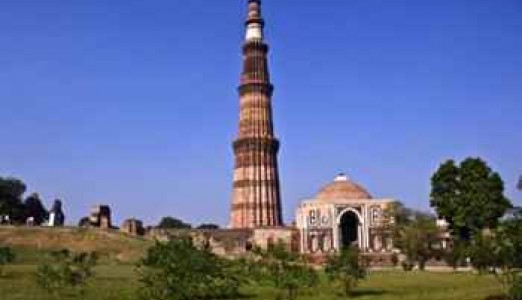
The second most visited monument in India, second only to the Taj Mahal, the Qutub Minar is a masterpiece that will leave you impressed with its unparalleled magnificence. During your tour to Delhi , you can’t miss a visit to this grand monument. Interestingly, the Qutub Minar is open for its visitors throughout the week so you can head to South Delhi and will not be disappointed no matter what day you choose to visit. However, we would suggest that you plan your trip on a weekday instead of a weekend as weekends tend to get a little too overcrowded in the Qutub Complex.
The entry timings of Qutub Minar are from 7:00 in the morning to 5:00 in the evening but in order to increase the prospects of night tourism, the government also started nighttime exploration of the monument. Tourists can also admire the majestic structure of Qutub Minar under the evening sky from 8:00 PM to 10:00 PM. This initiative aims to enhance the experience of night tourism, providing an opportunity for visitors to marvel at the Qutub Minar's beauty in a different light .
Write your suggestions
- Check Delhi Suggestion and Experiences
- Delhi Airport Transfers
- Delhi Overview
- Delhi Travel Guide
- Restaurants In Delhi
- Shopping In Delhi
- Places To Visit In Delhi
- History Of Delhi
- Things To Do In Delhi
- Best Time To Visit Delhi
- Delhi Excursion
- Qutub Minar
- Ticket Price for Visiting Qutub Minar
- How To Visit Qutub Minar By Air
- How To Visit Qutub Minar By Train
- How To Visit Qutub Minar By Road
- Hotels Near Qutub Minar
- FAQ - Qutub Minar
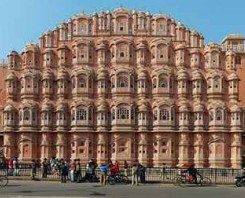
- add to cart
3 Nights 4 Days Delhi Agra and Jaipur Golden Triangle Tour

Private Old Delhi Walking Tour with Rickshaw Ride and Food Tasting
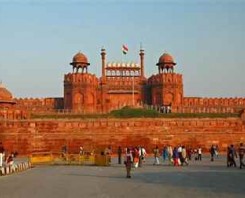
Old Delhi Havelis Chandni Chowk Walking Tour with Lunch or Dinner

One Full Day Delhi City Tour Package
Write your suggestion.

Plan your Trip
- Skip to main content
- Skip to primary sidebar
Delhi Capital
One Stop Information Guide
Qutub Minar in Delhi: Timings, Height, Ticket Prices, and Entry Fees
Last Updated on August 12, 2023 By Editorial Staff Leave a Comment
- 1.1 Timings: Qutub Minar
- 1.2 Height and Architectural Splendor: Qutub Minar
- 1.3 Ticket Prices and Entry Fees: Qutub Minar
- 1.4 Opening and Closing Times: Qutub Minar
- 1.5 Final Thoughts: A Voyage Through Time and Culture
- 1.6 Qutub Minar FAQ
Qutub Minar: Exploring Delhi’s Iconic Monument
Amidst the vibrant tapestry of Delhi’s bustling streets stands the remarkable Qutub Minar , a towering testament to India’s rich history, architectural finesse, and cultural heritage. This UNESCO World Heritage Site beckons visitors to unravel its captivating narrative, delving into its soaring height, intricate carvings, and the stories it holds. In this in-depth exploration, we embark on a journey to uncover the nuances of the Qutub Minar’s timings, height, ticket prices, opening and closing times, and entry fees, gaining a deeper appreciation for this historical gem.
Visiting the Qutub Minar Complex is a journey through time, offering insights into India’s past, architectural brilliance, and cultural heritage.
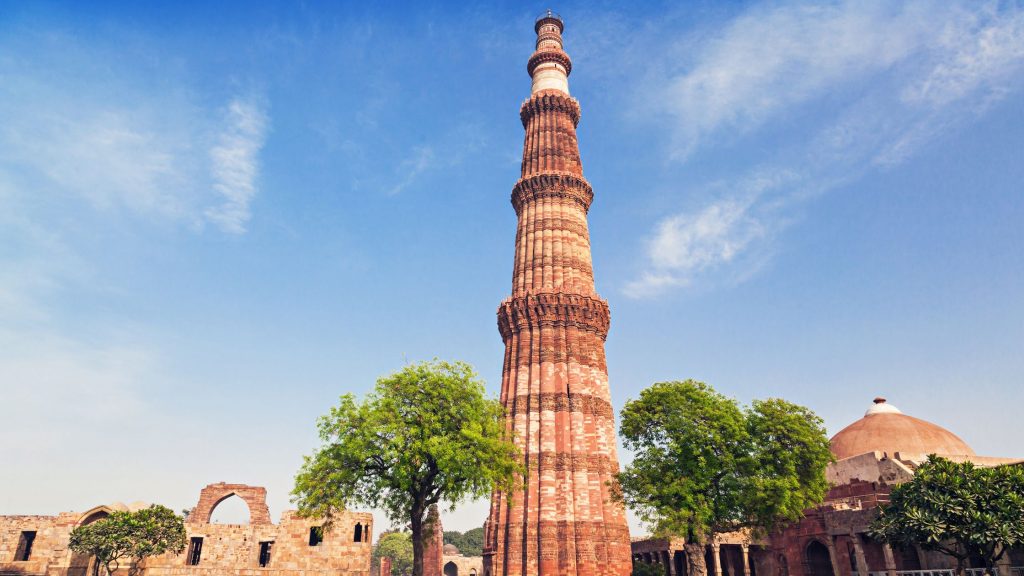
Timings: Qutub Minar
The Qutub Minar complex extends a warm welcome to history enthusiasts and curious minds alike, opening its gates throughout the week. Its schedule mirrors the natural cadence of the day, allowing for a comprehensive exploration of its wonders.
- Sunrise Embrace: With the break of dawn, the complex awakens, inviting early risers to witness the spectacle of the rising sun casting its golden glow upon the minar’s intricate facade.
- Daylight Adventures: As the day progresses, the complex offers a rich canvas for exploration. Visitors can take their time to admire the minar’s majestic height, study its ornate carvings, and lose themselves in the surrounding architecture and lush gardens.
- Sunset Serenity: The closing hours at sunset provide a tranquil ambiance, as the minar stands bathed in the soft hues of dusk. This moment offers an opportunity for quiet contemplation and reflection on the day’s discoveries.
Height and Architectural Splendor: Qutub Minar
The Qutub Minar’s towering height of approximately 73 meters (240 feet) is not just a numerical fact; it’s a testament to the architectural genius of its creators.
- Stories of Elegance: Rising in five distinct stories, the minar is adorned with intricately designed balconies that reflect the skilled craftsmanship of the artisans who contributed to its construction.
- Architectural Harmony: The minar’s architectural style is a harmonious fusion of Persian, Turkish, and Indian influences, encapsulating the cross-cultural exchanges of its era.
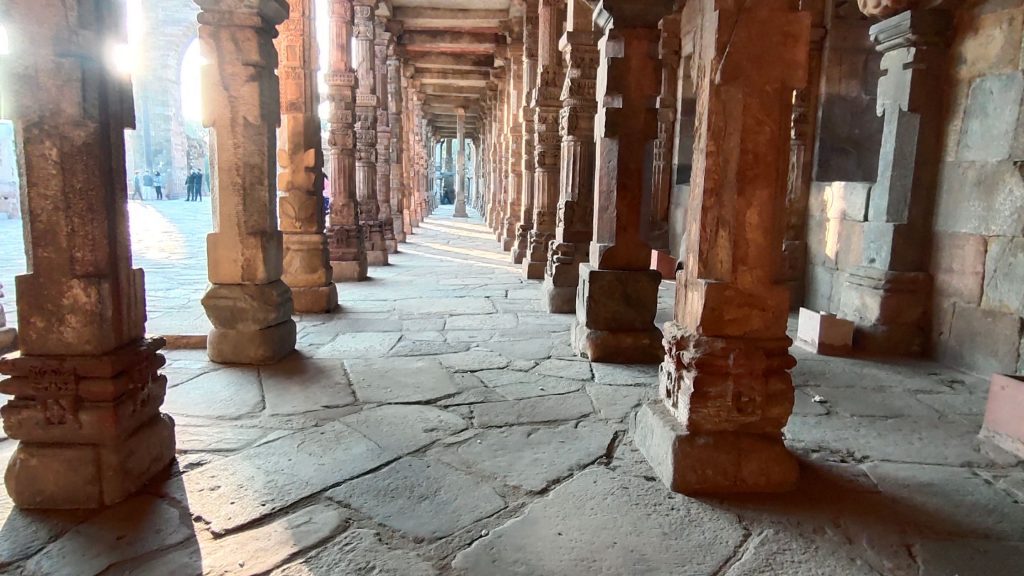
Ticket Prices and Entry Fees: Qutub Minar
To unlock the gates of the Qutub Minar complex and step into history’s embrace, visitors can acquire entry tickets at the main gate. The pricing structure accommodates different categories of visitors, with Indian citizens and those from SAARC countries benefiting from affordable entry fees. Foreign tourists, while paying a slightly higher fee, are treated to an experience that transcends geographical boundaries, offering a glimpse into India’s cultural mosaic. For the most up-to-date information on ticket prices, it’s advisable to refer to the official website or local sources, especially for students, children, and senior citizens who may be eligible for concessions.
☛ Book Qutub Minar Tickets Online
- Accessible Pricing: The pricing structure caters to diverse audiences. Indian citizens and visitors from SAARC countries benefit from affordable entry fees, promoting inclusivity and ensuring that more people can partake in this cultural voyage.
- Global Perspective: Foreign tourists, while subject to a slightly higher fee, are rewarded with an immersive encounter with India’s artistry and historical heritage.
Opening and Closing Times: Qutub Minar
The Qutub Minar complex extends an invitation that spans the entirety of the day, accommodating the varied preferences of its visitors. The timings of Qutub Minar are from 7 am in the morning to 9 pm in the evening. It remains open all days of the week. There are three time slots for visitors which are as follows:-
- Morning Reverie: The complex opens its gates at sunrise, offering early-bird visitors the chance to experience the minar’s grandeur bathed in the soft, golden light of morning.
- Daylight Exploration: Throughout the day, the site welcomes explorers, encouraging them to uncover the nuances of its architecture, carvings, and historical significance.
- Sunset Farewell: As the sun sets, the Qutub Minar complex bids adieu to its visitors, creating a serene atmosphere that invites reflection and a sense of connection with the past.
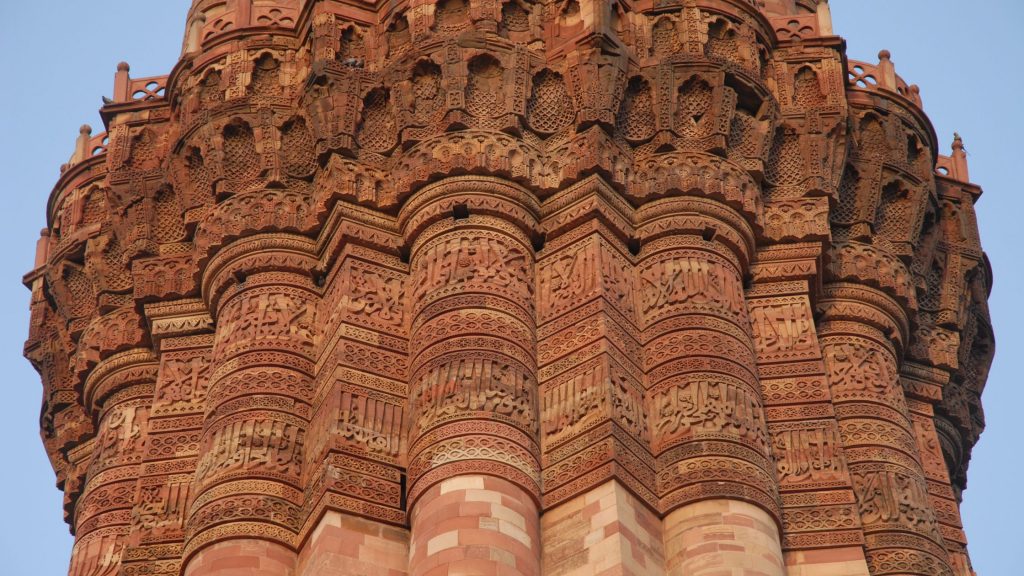
Final Thoughts: A Voyage Through Time and Culture
A visit to the Qutub Minar complex transcends conventional tourism; it’s an odyssey through history, an ode to architectural brilliance, and a conduit to India’s cultural mosaic. As the sun sets over the minar, casting a warm embrace on its surface, visitors depart with a lasting impression – that the Qutub Minar is more than just a structure; it’s a gateway to centuries past, a symbol of cultural heritage, and a timeless embodiment of India’s narrative.
Qutub Minar FAQ
1. What is the Qutub Minar, and where is it located?
The Qutub Minar is a historic tower located in Delhi, India. Situated in the Qutub Minar Complex, it stands as a remarkable example of architectural brilliance and cultural heritage.
2. What is the historical significance of the Qutub Minar?
The Qutub Minar was commissioned by Qutb-ud-din Aibak in the 12th century to celebrate his victory in Delhi. It subsequently became a symbol of India’s diverse cultural influences, reflecting the fusion of Persian, Turkish, and Indian architectural styles.
3. What are the timings of the Qutub Minar Complex?
The Qutub Minar Complex opens its gates from sunrise to sunset, welcoming visitors to explore its historical and architectural wonders throughout the day.
4. How tall is the Qutub Minar?
The Qutub Minar stands at an impressive height of approximately 73 meters (240 feet), making it one of the tallest brick minarets in the world.
5. What can visitors expect to see at the Qutub Minar Complex?
Aside from the magnificent Qutub Minar itself, the complex houses other significant structures such as the Quwwat-ul-Islam Mosque and the iconic Iron Pillar, each with its own historical and architectural importance.
6. How can I obtain tickets to the Qutub Minar Complex, and what are the ticket prices?
Entry tickets to the Qutub Minar Complex can be acquired at the main gate. The pricing structure accommodates different categories of visitors. Indian citizens and visitors from SAARC countries enjoy affordable entry fees, while foreign tourists have a slightly higher fee.
7. What are the opening and closing times of the Qutub Minar Complex?
The complex opens its gates at sunrise, inviting early visitors to witness the minar bathed in the gentle morning light. Throughout the day, visitors can explore its offerings. The site’s closing time at sunset provides a serene and reflective atmosphere.
8. Can I explore the Qutub Minar Complex during sunset?
Yes, the Qutub Minar Complex is open until sunset, allowing visitors to experience the serene beauty of the monument as the sun sets over Delhi.
9. What efforts are undertaken to preserve the Qutub Minar Complex?
The preservation of the Qutub Minar Complex is a priority, with dedicated conservation initiatives in place to protect its historical and cultural significance.
10. What makes the Qutub Minar a must-visit destination?
The Qutub Minar offers a unique blend of history, architecture, and cultural heritage. It provides a glimpse into India’s past, architectural finesse, and the influences that have shaped the nation’s identity over the centuries.
Visiting the Qutub Minar Complex is a journey through time, an opportunity to appreciate the craftsmanship of the past, and a chance to connect with the rich tapestry of India’s cultural heritage. As you explore its intricacies, take in its towering height, and immerse yourself in its historical significance, you’ll find yourself captivated by the stories etched into its walls and the beauty that transcends generations.
Reader Interactions
Leave a reply.
Your email address will not be published. Required fields are marked *

The Legacy of Qutub Minar: Travel Guide to Delhi’s Architectural Splendour
- April 5, 2023
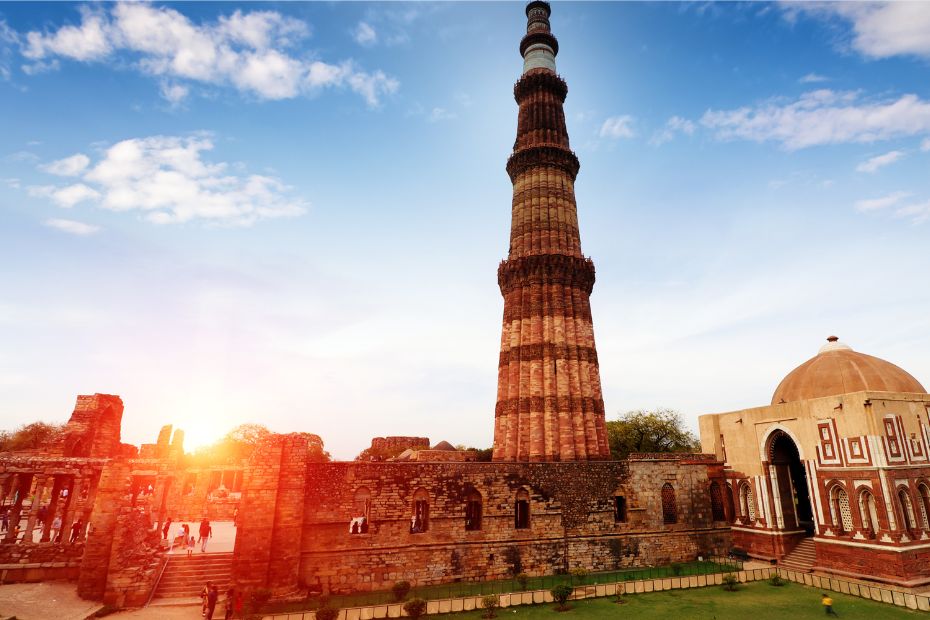
Uncover the rich history and architectural wonders of Qutub Minar, Delhi’s iconic UNESCO World Heritage Site. Explore the tower’s significance, nearby attractions, and travel tips.
Imagine stepping into a time machine, where the past and the present seamlessly blend, as you stand in awe of a soaring tower that has withstood the test of time. Welcome to Qutub Minar, Delhi’s ancient wonder, where history, architecture, and culture come alive.
Built in 1193 by Qutb al-Din Aibak, Qutub Minar is an impressive 73 meters (240 feet) tall, with a spiral staircase of 379 steps. This UNESCO World Heritage Site has captivated travelers for centuries as they marvel at its intricate Indo-Islamic architectural style and remarkable history.
Join us as we delve into the fascinating world of Qutub Minar, exploring its majestic structure, enthralling legends, and vibrant festivals. Get ready to embark on a journey through time and discover what makes this monumental tower an unmissable destination for any traveler to India.
Some key highlights of Qutub Minar include:
- Its construction began in 1193 by Qutb al-Din Aibak, the founder of the Delhi Sultanate.
- The spiral staircase, with 379 steps, leads to the tower’s top.
- The tower’s historical significance.
- Its stunning architecture showcases a blend of indigenous Indian and Islamic design elements.
- The UNESCO World Heritage Site status was granted in 1993, recognizing its cultural and historical importance.
Qutub Minar is a standalone tower and part of a larger complex that houses several significant monuments. Some of these include:
- Alai Darwaza: A magnificent gateway built in 1311 by Alauddin Khilji, showcasing intricate carvings and geometric patterns.
- Quwwat-ul-Islam Mosque: The first mosque built in India, dating back to 1193, and adorned with Hindu and Jain temple pillars.
- Iron Pillar: A 7-meter (23 feet) tall iron pillar, famous for its rust-resistant properties and ancient Sanskrit inscriptions.
- Tomb of Iltutmish: The final resting place of the Sultan who expanded the Delhi Sultanate and contributed to the tower’s construction.
When visiting Qutub Minar, remember to:
- Allocate sufficient time to explore the entire complex, as there’s much to see and appreciate.
- Bring a camera to capture the tower’s stunning architecture and intricate carvings.
- Wear comfortable shoes as you walk around the expansive complex.
- Respect the cultural and historical significance of the site and follow the rules set by the authorities.
Qutub Minar is a must-visit destination for anyone exploring Delhi. Its towering presence, rich history, and exquisite architecture make it a true wonder that leaves a lasting impression on every visitor.
The Architectural Marvels of Qutub Minar Complex
As you step into the Qutub Minar complex, prepare to be captivated by the architectural marvels that surround you. This sprawling site has several impressive monuments, each showcasing a unique blend of Indian and Islamic design elements. This section will guide you through the most remarkable structures and their fascinating details.
- Qutub Minar itself: The complex’s main attraction, this 73-meter (240 feet) tall tower, features five stories adorned with intricate carvings and inscriptions. Notice the red sandstone used for the first three stories and the white marble for the upper two—Marvel at the tower’s tapering design and the bands of calligraphy encircling it.
- Quwwat-ul-Islam Mosque: As you explore the complex, you’ll discover the first mosque built in India. The mosque features a unique combination of Hindu and Islamic architectural styles, with its courtyard lined with intricately carved pillars taken from Hindu and Jain temples. Don’t miss the ornate mihrab, a semicircular niche in the wall, indicating the direction of Mecca.
- Alai Darwaza: This stunning gateway, built by Alauddin Khilji in 1311, is the southern entrance to the Quwwat-ul-Islam Mosque. Admire the red sandstone and marble construction, geometric patterns, and intricate carvings that embellish its façade. The Alai Darwaza is a testament to the architectural innovations of the time, featuring the first true arch in Indian history.
- Tomb of Iltutmish: Pay a visit to the mausoleum of the third Sultan of Delhi, Iltutmish, who added three stories to Qutub Minar. The tomb, situated northwest of the mosque, boasts an impressive array of calligraphy and carvings, including an exquisite mihrab with fine lattice work. The tomb’s architectural style blends Islamic and Indian elements, a hallmark of the early Delhi Sultanate.
- Iron Pillar: This 7-meter (23 feet) tall iron pillar stands tall in the mosque courtyard, known for its rust-resistant properties. The pillar, believed to be over 1,600 years old, features Sanskrit inscriptions that predate the construction of Qutub Minar. The pillar’s metallurgical composition and rust-free nature have long intrigued scientists and historians.
- Alai Minar: Venture to the unfinished tower started by Alauddin Khilji, who intended it to be twice the height of Qutub Minar. Although the tower remains incomplete, the massive base provides a glimpse of the ambitious plans that never came to fruition.
- Madrasa and Tomb of Alauddin Khilji: At the western end of the complex, you’ll find a madrasa, or Islamic school, built by Alauddin Khilji. Adjacent to the madrasa lies the tomb of the Sultan, a simple structure that contrasts with the elaborate architecture of the other monuments.
Exploring the Qutub Minar: A Step-by-Step Guide
Embark on an unforgettable journey as you explore Qutub Minar and its surroundings. Follow this step-by-step guide to make the most of your visit to this historic site:
- Arrive at the entrance: Start by reaching the main entrance of the Qutub Minar complex. Be ready to purchase your entry tickets and go through the security check.
- Admire the tower: As you enter the complex, take a moment to marvel at the towering presence of Qutub Minar. Notice the intricate carvings and inscriptions on its red sandstone and white marble exterior.
- Explore Quwwat-ul-Islam Mosque: Proceed to the Quwwat-ul-Islam Mosque, India’s first mosque. Observe the repurposed Hindu and Jain temple pillars, a testament to the cultural fusion of the era.
- Visit Alai Darwaza: Walk towards the Alai Darwaza, a magnificent gateway that showcases the architectural brilliance of Alauddin Khilji’s reign.
- Discover the Iron Pillar: Don’t miss the mysterious Iron Pillar, renowned for its rust-resistant properties and ancient Sanskrit inscriptions.
- Capture memories: Remember to bring your camera to capture the beauty of the monuments and the picturesque surroundings.
- Take a break: After exploring the complex, unwind at one of the nearby cafes or restaurants to replenish your energy and relish some local flavors.
This guide will ensure a memorable and enriching experience at the Qutub Minar complex. Soak in the history, culture, and architectural wonders that make this site a must-visit destination in Delhi.
The UNESCO World Heritage Status of Qutub Minar
Qutub Minar’s undeniable historical and architectural significance earned it the prestigious UNESCO World Heritage status in 1993. As you visit this iconic site, take pride knowing it’s recognized as a cultural treasure that must be preserved for future generations.
The UNESCO recognition highlights:
- The tower’s representation of the fusion of indigenous Indian architectural styles.
- Its role symbolized power and victory, marking the establishment of the Delhi Sultanate.
- The preservation of the monument is a reflection of India’s diverse cultural heritage.
Contribute to the awareness and conservation of this magnificent monument, ensuring its legacy endures for centuries.
Tips for Visiting Qutub Minar: Entry Fees, Timings, and Accessibility
To make the most of your visit to Qutub Minar, keep these practical tips in mind:
- Entry fees: Be prepared to pay the entrance fee, which differs for Indian nationals and foreign tourists. Note that children under 15 enter for free.
- Timings: Plan your visit between 7 am and 5 pm, as these are the official visiting hours for Qutub Minar.
- Accessibility: The monument is easily accessible by public transportation, such as the Delhi Metro, buses, or auto-rickshaws.
- Comfortable attire: Wear comfortable clothing and shoes while walking around the expansive complex.
- Weather considerations: Schedule your visit during the cooler months (October to March) for a pleasant experience.
Nearby Attractions and Culinary Delights Around Qutub Minar
Once you’ve explored Qutub Minar, don’t miss the opportunity to discover nearby attractions and indulge in some of Delhi’s best culinary delights. Here are some fantastic places to visit and dine at in the vicinity:
- Mehrauli Archaeological Park: Venture into this historical gem, spread across 200 acres and home to over 100 fascinating monuments. Admire structures like Balban’s Tomb, Jamali Kamali Mosque, and Rajon Ki Baoli.
- Chhatarpur Temple: Experience the serenity of this massive Hindu temple complex dedicated to Goddess Katyayani. Marvel at its architectural grandeur, blending traditional North Indian and South Indian styles.
- Dilli Haat: Shop for handicrafts, textiles, and jewelry at this vibrant open-air market, showcasing the diversity of Indian art and craft traditions—sample regional delicacies from various Indian states at the food stalls.
- Garden of Five Senses: Unwind at this beautifully landscaped garden that stimulates your senses. Stroll through themed areas, admire contemporary sculptures, and enjoy the lush greenery.
Now that you’ve sorted your itinerary, it’s time to savor some scrumptious local cuisine. Here are a few dining options near Qutub Minar:
- Karim’s: Treat yourself to mouthwatering Mughlai dishes at this iconic restaurant, known for its succulent kebabs, flavorful biryanis, and melt-in-your-mouth kormas.
- Indian Accent: Indulge in a contemporary twist on Indian cuisine at this award-winning restaurant. Relish innovative dishes presented with impeccable attention to detail and artistic flair.
- Qutub Kitchen: Satisfy your taste buds at this charming eatery, offering a diverse menu featuring Indian, Chinese, and Continental dishes. Don’t miss their delicious butter chicken and garlic naan.
- Olive Bar & Kitchen: Unwind in the Mediterranean ambiance of this chic restaurant, nestled in an enchanting garden. Savor delicious wood-fired pizzas, fresh salads, and an extensive selection of wines.
- Auro Kitchen & Bar: Socialize at this trendy gastro pub, boasting a spacious terrace, eclectic menu, and creative cocktails. Enjoy live music performances, and DJ sets on select nights.
By exploring these nearby attractions and sampling the culinary delights around Qutub Minar, you’ll truly immerse yourself in the rich cultural tapestry of Delhi. So, make the most of your visit by delving into the city’s history, art, and gastronomy.
The Legend of Qutub Minar: Tales and Myths
Delve into the enchanting legends and myths surrounding Qutub Minar, which add an air of mystery and intrigue to this ancient monument. Here are some famous stories that have captured the imagination of generations:
- The Tower of Light: According to one legend, Qutub Minar was originally built as a “Minar of Light” or “Vishnu Stambh” by a Hindu king. It’s said that the tower emitted light, which could be seen from miles away, guiding travelers and pilgrims to the city.
- The Love Story of Qutub and Rani Durgavati: Another famous tale revolves around the love story between the Hindu princess Rani Durgavati and a Muslim prince named Qutub. As their love was forbidden, they built Qutub Minar to symbolize their union, overcoming societal barriers.
- The Connection to the Tower of Babel: Some believe Qutub Minar is linked to the biblical Tower of Babel. This theory suggests that the tower was built to reach the heavens as a means for human beings to attain divine knowledge and power.
- The Curse of the Iron Pillar: The Iron Pillar, located within the Qutub Minar complex, is said to be cursed. According to legend, anyone who can encircle the pillar with their arms while standing with their back against it will have their wish granted. However, attempting this feat can bring bad luck or misfortune.
- The Haunted Minar: There are tales of the towers haunted by jinns and spirits. Some visitors claim to have heard mysterious sounds and felt inexplicable chills, fueling beliefs in paranormal activity.
- The Secret Tunnels: Rumors persist about a network of secret tunnels connecting Qutub Minar to other important locations in Delhi. Though not yet discovered, these tunnels are said to have been used by royals and nobles to escape during times of danger.
- The Vanished Builders: A popular myth claims that the builders who constructed Qutub Minar mysteriously vanished overnight, leaving no trace behind. Some attribute this disappearance to supernatural forces, while others suggest that the builders were skilled artisans who moved on to new projects.
These legends and myths surrounding Qutub Minar have captivated the hearts and minds of people for centuries. While it’s essential to appreciate the monument’s historical and architectural significance, exploring the stories and folklore that have become an inseparable part of its mystique is equally fascinating.
Qutub Minar’s Iron Pillar: The Mystery of Rust Resistance
One of the most intriguing aspects of the Qutub Minar complex is the enigmatic Iron Pillar, which has stood the test of time without succumbing to rust. This marvel of ancient metallurgy continues to baffle scientists and historians alike. Here’s what you need to know about this mysterious pillar:
- Origins: The Iron Pillar dates back to the 4th century, initially commissioned by King Chandra, a Gupta Dynasty ruler. Inscriptions on the pillar mention his name and title, explaining its origin.
- Composition: The pillar is approximately 7.21 meters tall, with a diameter of 48 centimeters at the base, tapering to 29 centimeters at the top. It’s made of 98% wrought iron, weighing around 6.5 tons.
- Rust resistance: The most remarkable feature of the Iron Pillar is its rust resistance, despite being exposed to the elements for centuries. This exceptional durability is attributed to the high phosphorus content in the iron, which forms a protective layer of iron oxide (misawite) on the surface.
- Metallurgical prowess: The rust resistance of the Iron Pillar is a testament to the advanced metallurgical skills of ancient Indian artisans. They employed the forge welding technique, which involved heating and hammering multiple iron pieces to create the final structure.
- Relocation: The pillar originally stood in a temple complex in modern-day Madhya Pradesh, dedicated to Lord Vishnu. It was later moved to its current location by Qutb-ud-din Aibak, the founder of the Delhi Sultanate, in the early 13th century.
- Cultural significance: The Iron Pillar symbolizes India’s rich metallurgical heritage and the prowess of ancient Indian artisans. It’s also an important reminder of the cultural exchange and integration throughout history, as rulers from different dynasties and regions added their unique contributions to the Qutub Minar complex.
The Iron Pillar of Qutub Minar remains an enduring enigma, inspiring awe and curiosity among visitors, scientists, and historians alike. As you explore the Qutub Minar complex, take a moment to marvel at this remarkable testament to ancient Indian ingenuity and craftsmanship.
The Art of Calligraphy and Decorations in Qutub Minar
Qutub Minar is a stunning example of Indo-Islamic architecture, showcasing the exceptional artistry of calligraphy and intricate decorations. As you explore the monument, take the time to admire these beautiful details that add depth and character to the structure:
- Calligraphy: The tower’s exterior features bands of intricate calligraphy, primarily in Kufic and Nagari scripts. These inscriptions include Quranic verses, details about the tower’s construction, and information about the rulers who contributed to its completion.
- Decorative motifs: Various decorative motifs adorn the Qutub Minar, reflecting the diverse cultural influences that shaped its construction. These motifs include geometric patterns, floral designs, and ornamental details, showcasing the skilled craftsmanship of the artisans who worked on the monument.
- Varied styles: Qutub Minar’s five stories display distinct decorative elements, reflecting the unique characteristics of the different periods and rulers who contributed to its construction. For example, the first three stories, built by Qutb-ud-din Aibak, feature predominantly Islamic motifs, while the fourth and fifth stories, constructed by Firoz Shah Tughlaq, exhibit a blend of Islamic and Hindu styles.
- Carved stone panels: As you explore the Qutub Minar complex, pay attention to the intricately carved stone panels adorning the walls of various structures. These carvings feature depictions of animals, plants, and human figures, reflecting the artistic sensibilities of the time.
- Balcony decorations: The balconies on each tower story are adorned with elegant stone lattice screens (jalis) and decorative brackets. These features enhance the tower’s visual appeal and are a testament to the extraordinary skills of the stonemasons who crafted them.
- The Iron Pillar: As mentioned earlier, the Iron Pillar within the Qutub Minar complex is another example of the decorative artistry of ancient India. Its inscriptions, in Brahmi script, provide insights into the Gupta Dynasty and its metallurgical prowess.
The art of calligraphy and decorations in Qutub Minar serves as a window into the rich cultural and artistic heritage of India’s past. As you visit this architectural marvel, take the time to appreciate the intricate details that make it an enduring symbol of the country’s diverse history and artistic traditions.
The Qutub Festival: A Celebration of Music, Dance, and Culture
The Qutub Festival is an annual cultural event celebrating India’s artistic heritage at Qutub Minar. Here’s what makes the festival a must-visit experience:
Organizers: Delhi Tourism and the Government of Delhi collaborate to organize the festival, promoting tourism and cultural awareness.
Timeframe: The festival takes place in November or December, spanning several days of entertainment and activities.
Performances: Visitors can enjoy a mix of:
- Classical music
- Fusion music
- Traditional dance forms, including Kathak, Bharatanatyam, and Odissi
Workshops and exhibitions: The festival hosts events related to:
- Indian arts and crafts
Food stalls: Various Indian cuisine is available, representing the country’s diverse culinary traditions.
Nighttime illumination: Qutub Minar is illuminated, creating a magical atmosphere for the festival.
The Qutub Festival is a unique opportunity to immerse yourself in India’s rich artistic heritage while enjoying the beauty of the Qutub Minar. Include it in your itinerary if you visit Delhi during the festival season.
The Restoration and Conservation Efforts at Qutub Minar
Qutub Minar, a UNESCO World Heritage Site, requires ongoing restoration and conservation efforts to preserve its beauty and historical significance. As you visit this architectural marvel, take a moment to appreciate the hard work that goes into maintaining this iconic monument:
- Archaeological Survey of India (ASI): The ASI is crucial in preserving Qutub Minar, overseeing its restoration and conservation projects.
- Structural repairs: Over the years, natural disasters and weathering have caused damage to Qutub Minar. ASI performs regular structural repairs to ensure the tower’s stability and safety.
- Cleaning and maintenance: Regular cleaning and maintenance of the monument help maintain its aesthetic appeal. This includes removing dirt, pollution, and vegetation growth that can damage the stone structure.
- Preservation of inscriptions and carvings: Efforts are made to preserve the delicate inscriptions and carvings on the monument, using gentle cleaning methods and protective coatings to prevent erosion and damage.
- Monitoring and research: ASI researches and monitors the monument’s condition to identify potential issues and plan appropriate conservation measures.
- Visitor management: Visitor access is restricted to certain areas to protect the monument, and climbing the tower is no longer permitted. This helps minimize the potential damage caused by tourism.
By following these guidelines, you can contribute to the ongoing restoration and conservation efforts at Qutub Minar, ensuring that future generations can enjoy this remarkable monument.
Panoramic Views: Climbing the Stairs of Qutub Minar
In the past, visitors could climb the stairs of Qutub Minar to enjoy breathtaking panoramic views of Delhi. However, public access to the tower’s interior and staircase is restricted due to safety concerns and preservation efforts. Despite this limitation, you can still appreciate the architectural beauty of Qutub Minar and its surroundings:
- Admire the exterior: Take a leisurely walk around the Qutub Minar complex, marveling at the intricate carvings, inscriptions, and architectural details of the tower.
- Explore the Qutub Minar Complex: Discover the other historic structures, such as the Quwwat-ul-Islam Mosque, Alai Darwaza, and the Iron Pillar.
- Capture photographs: Capture the beauty of Qutub Minar and its surroundings from various angles and perspectives, creating lasting memories of your visit.
- Visit nearby monuments: For panoramic views of Delhi, consider visiting nearby monuments like Humayun’s Tomb or India Gate, which offer impressive city vistas.
- Experience a virtual tour: Although you cannot climb the stairs of Qutub Minar, you can still experience its interior through virtual tours and interactive exhibits available online or at the monument’s visitor center.
By exploring Qutub Minar and its surroundings, you can appreciate its architectural splendor and immerse yourself in the monument’s rich history.
Qutub Minar in Popular Culture: Movies, Books, and Art
With its striking architecture and historical significance, Qutub Minar has been a source of inspiration for various forms of popular culture. As you explore the monument, take note of its influence on movies, books, and art:
- Movies: Qutub Minar has been featured in numerous Bollywood and international films, providing a dramatic backdrop for iconic scenes. Notable examples include “Fanaa,” “Delhi-6,” and “Bhool Bhulaiyaa.”
- Books: Many authors have written about Qutub Minar, incorporating its history and legends into their narratives. Books such as “City of Djinns” by William Dalrymple and “The Last Mughal” by the same author explore Delhi’s past, including the stories surrounding Qutub Minar.
- Art: The monument has inspired countless artists who have captured its beauty through paintings, sketches, and photography. Art exhibitions and galleries often showcase artworks featuring Qutub Minar, highlighting its cultural and historical significance.
- Music: Qutub Minar’s enchanting ambiance has influenced musicians and composers, who have dedicated songs and compositions to the monument or used its setting for music videos.
- Fashion and design: The intricate patterns and architectural details of Qutub Minar have inspired fashion designers, interior decorators, and architects, who draw upon the monument’s aesthetic elements for their creations.
By recognizing Qutub Minar’s influence on popular culture, you can better appreciate this iconic monument and its enduring impact on the creative world.
Qutub Minar’s Influence on Modern Architecture
As you explore the magnificent Qutub Minar, you may notice its impact on modern architecture. Here are some ways in which this ancient monument continues to inspire contemporary architects and designers:
- Tapering design: The gradual tapering of Qutub Minar, which narrows from a 14.3-meter diameter at the base to 2.7 meters at the top, has influenced modern tower designs, making them more stable and aesthetically pleasing.
- Use of materials: Qutub Minar’s combination of red sandstone and marble has inspired modern architects to experiment with diverse materials, textures, and colors in their projects.
- Decorative elements: The intricate carvings, geometric patterns, and calligraphic inscriptions on Qutub Minar have encouraged architects to incorporate decorative elements and motifs into their buildings, adding visual interest and cultural significance.
- Fusion of styles: Qutub Minar’s blend of Indo-Islamic architecture demonstrates the successful merging of different architectural styles, motivating architects to create innovative designs that combine various cultural influences.
- Vertical Gardens: The lush greenery surrounding Qutub Minar has inspired modern architects to incorporate vertical gardens and green spaces in their projects, enhancing their sustainability and visual appeal.
By understanding Qutub Minar’s influence on modern architecture, you can appreciate how this ancient monument continues to shape the contemporary built environment.
Lesser-Known Facts About Qutub Minar: Discovering Hidden Gems
As you explore Qutub Minar, delve deeper into its intriguing history by discovering some lesser-known facts about this iconic monument:
- Multiple builders: Qutub Minar was built over several generations, with construction starting under Qutb ud-Din Aibak and completed by Iltutmish and Firoz Shah Tughlaq.
- Lightning strikes: The tower has been struck by lightning multiple times, with the most severe damage occurring in 1369, leading to the reconstruction of the top floors by Firoz Shah Tughlaq.
- Smith’s Folly: In the early 19th century, a British engineer, Major Robert Smith, added a cupola (dome) to the top of Qutub Minar, which was later removed due to its incongruous appearance and is now displayed in the complex.
- Tower tilt: Qutub Minar has a slight tilt, leaning approximately 65 centimeters to the southwest, which has been monitored for stability by the Archaeological Survey of India.
- Quwwat-ul-Islam Mosque: The mosque within the Qutub Minar complex is considered one of the earliest surviving mosques in India, showcasing a unique fusion of Hindu and Islamic architectural styles.
- An incomplete Alai Minar: Alauddin Khilji began constructing a second tower, known as the Alai Minar, to surpass Qutub Minar in height. However, he couldn’t complete it, and its unfinished base can still be seen in the complex.
Uncovering these lesser-known facts about Qutub Minar can deepen your understanding of the monument’s history and marvel at the stories hidden within its walls.
A Photographer’s Guide to Capturing Qutub Minar’s Beauty
As a photographer , you’ll find endless opportunities to capture the beauty of Qutub Minar. To make the most of your visit, consider these tips and suggestions:
- Best time to visit: Aim for early morning or late afternoon, when the sun’s rays create a warm, golden glow on the monument, enhancing its natural colors and intricate details.
- Camera gear: Bring a versatile lens with a wide angle to capture the entire monument and a zoom lens for close-ups of the intricate carvings and calligraphy.
- Angles and perspectives: Experiment with different angles and perspectives, such as low-angle shots to emphasize the tower’s height or capture reflections in water puddles after rain.
- Include people: Including people in your photographs can help convey the scale of Qutub Minar and showcase the monument’s significance to local culture.
- Capture the surroundings: Don’t forget to photograph the other structures within the complex, such as the Quwwat-ul-Islam Mosque, Iron Pillar, and Alai Darwaza, which offer unique architectural details.
- Be patient: Wait for the perfect moment, such as when birds fly around the tower or a sunbeam illuminates the intricate carvings to capture a truly memorable shot.
- Respect the rules: Follow the guidelines and restrictions within the Qutub Minar complex, such as not using tripods, to ensure a pleasant experience for all visitors.
Go ahead and create stunning photographs of Qutub Minar to showcase its architectural beauty and historical significance.
Also Read : Majestic Red Fort
Frequently asked questions about Qutub Minar.
What is the history behind the construction of Qutub Minar?
Qutub Minar was built in 1193 by Qutb ud-Din Aibak, the founder of the Delhi Sultanate, to commemorate his victory over the last Hindu kingdom. Construction continued under his successors, Iltutmish and Firoz Shah Tughlaq, until its completion in the 14th century.
Who built Qutub Minar, and what was its purpose?
Qutb ud-Din Aibak initiated the construction of Qutub Minar to celebrate his triumph over the last Hindu kingdom. The tower also served as a minaret for the adjacent Quwwat-ul-Islam Mosque, calling the faithful to prayer.
What architectural style is Qutub Minar built in, and what are its unique features?
Qutub Minar exhibits a fusion of Indo-Islamic architectural styles, featuring intricate carvings, geometric patterns, and calligraphic inscriptions. The tower tapers gradually from a 14.3-meter diameter at the base to 2.7 meters at the top, enhancing its stability and aesthetics.
What are the key structures within the Qutub Minar complex?
Key structures within the complex include the Quwwat-ul-Islam Mosque, Iron Pillar, Alai Darwaza, and the unfinished Alai Minar.
What is the significance of Qutub Minar in Indian history?
Qutub Minar symbolizes the advent of Muslim rule in India and the establishment of the Delhi Sultanate. It also serves as an architectural marvel, showcasing the fusion of Hindu and Islamic design elements.
What are the visiting hours and entry fees for Qutub Minar?
Qutub Minar is open daily from 7 am to 5 pm. The entry fee for Indian citizens is INR 40, while foreign visitors pay INR 550.
How can I reach Qutub Minar using public transportation?
You can reach Qutub Minar using the Delhi Metro’s Yellow Line, alighting at the Qutub Minar Metro Station. From there, it’s a short walk or auto-rickshaw ride to the monument.
What is the best time of year to visit Qutub Minar?
The ideal time to visit Qutub Minar is between October and March, when the weather is more relaxed and more pleasant for outdoor exploration.
Are there guided tours available at Qutub Minar?
Yes, guided tours are available at Qutub Minar, providing visitors in-depth insights into the monument’s history and architectural features.
What are some nearby attractions and places to eat near Qutub Minar?
Nearby attractions include the Mehrauli Archaeological Park, the Garden of Five Senses, and the Chhatarpur Temple. Explore Hauz Khas Village, which offers various cafes, restaurants, and bars catering to diverse tastes.
To sum up , Qutub Minar is an essential stop for anyone journeying through Delhi. The monument’s fascinating past, architectural magnificence, and cultural importance provide a remarkable experience. Remember to document the grandeur of this age-old marvel through photographs and delve into the tales, myths, and enigmas that envelop it.
Related Posts

Discover Thailand’s Hidden Gems
Al-kharj: a blend of ancient wells and modern charm.
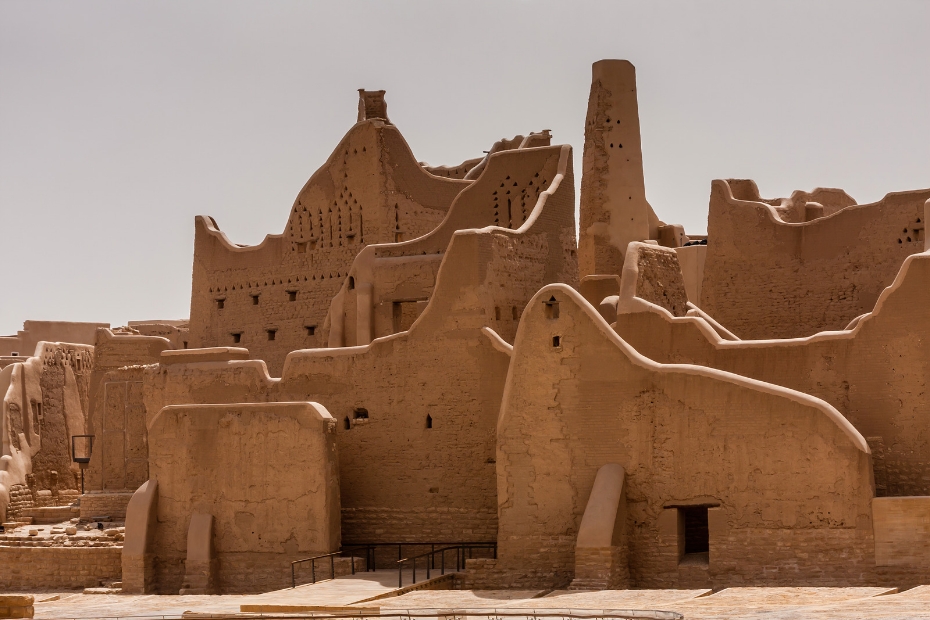
Discovering Diriyah: The Jewel of Saudi Arabia
🗓 Best Time To Visit: October to March, when the weather is pleasant.
⏰ Open Hours: 7 AM to 5 PM, Open all days.
🎟 Entry Fees: INR 30 for Indians, INR 500 for foreigners.
👥 Traveller Types: History enthusiasts, Photographers, Culture Explorers.
🔍 Known For: Tallest brick minaret in the world, UNESCO World Heritage Site, Exquisite carvings and inscriptions.
📍 Distances: 15 km from New Delhi Railway Station, 16 km from IGI Airport.
🚶 Things To Do: Explore the Qutub complex, Photography, Visit Iron Pillar.
💡 Tips: Wear comfortable shoes for exploring the complex, No food and drinks allowed inside.
♿ Accessibility: Wheelchair access available up to the base of the Minar.
📸 Best Photo Spots: The base of the Minar, Alai Darwaza, Iron Pillar.
🎈 Special Events: Qutub Festival, held annually in November/December.
Qutub Minar: Guide to UNESCO World Heritage Site in Delhi
Qutub Minar, a UNESCO World Heritage Site in Delhi , India, is the tallest brick minaret in the world, reaching 239 feet towards the sky. Qutub Minar is known for the Iron Pillar of Delhi, a 6-tonne iron pillar that stands within the complex.
The complex also houses the Quwwat-ul-Islam Mosque, the first mosque built in Delhi after the Islamic conquest, blending Islamic and Hindu architectural styles. The minaret is also known for its spiral staircase of 379 steps, leading to the topmost balcony, offering panoramic views of the surrounding area. Built-in the early 13th century, Qutub Minar is a symbol of the rich history and cultural heritage of India.
What is Qutub Minar?

- Qutub Minar was constructed by Qutb-ud-din Aibak, the founder of the Delhi Sultanate, in 1199 CE, to commemorate his victory over the last Hindu kingdom in Delhi.
- The construction was continued by his successors Iltutmish and Firoz Shah Tughlaq, who added more storeys and balconies to it.
- The tower stands at a height of 72.5 meters (237 feet) with a base diameter of 14.3 meters (47 feet). It comprises five storeys and has 379 steps leading to the top. Various inscriptions in Arabic and Persian on the tower record its history and builders.
- Qutub Minar has witnessed numerous events and changes in Delhi's history. Legends and stories surround it, such as the belief that encircling the iron pillar in the complex with one's arms while standing with the back to it can make a wish come true.
- The tower has been a subject of theories and controversies. Some historians view it as a minaret for the nearby Quwwat-ul-Islam mosque, while others argue it was a victory tower or a sundial. Some suggest it was inspired by the Minaret of Jam in Afghanistan or the Tower of Pisa in Italy.
Entry Fees and Timings for Qutub Minar

- For Indian citizens and visitors from SAARC countries : ₹40 per person.
- For foreign nationals: ₹600 per person.
- Children up to 15 years of age have free entry.
- Qutub Minar is open for visitors from Tuesday to Sunday.
- The timings are from 7:00 AM to 5:00 PM.
Must-See Attractions In Qutub Minar
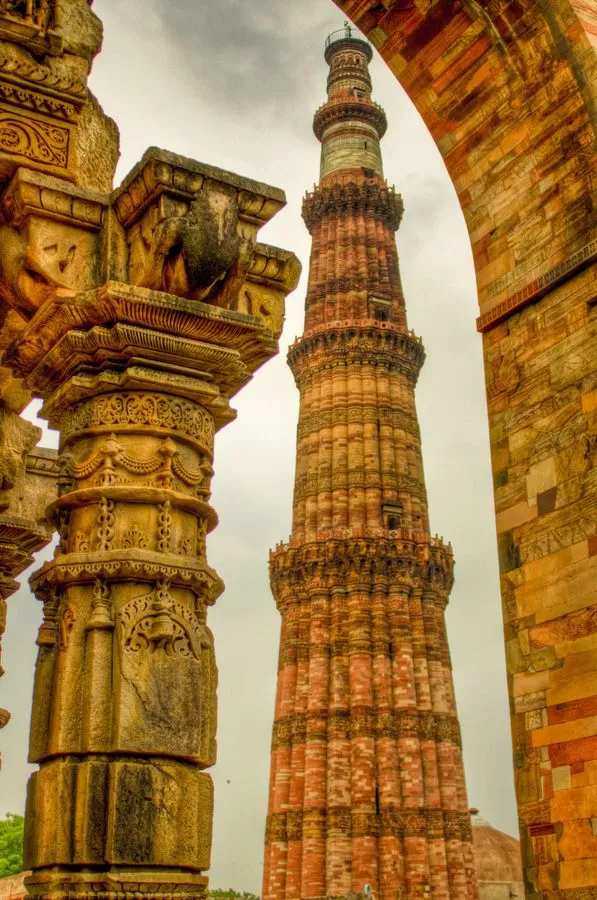
The Qutub complex is a sprawling area that houses many historical and cultural monuments.
Quwwat-ul-Islam mosque : This is one of the oldest and largest mosques in India, built by Qutb-ud-din Aibak in 1193 CE.The mosque has a large courtyard, a prayer hall, and several columns and arches that display Hindu and Islamic motifs.
Alai Darwaza :This is a magnificent gateway that was built by Alauddin Khilji in 1311 CE. It marks the entrance to the Qutub complex and showcases the Turkish style of architecture. It has a domed roof, a pointed arch, and intricate carvings and inscriptions.
Iron Pillar of Chandragupta II : This 7-meter-high pillar stands testament to the skill of ancient Indian blacksmiths due to its resistance to corrosion. The pillar bears an inscription stating it was erected in honor of the Hindu god, Vishnu, and in the memory of the Gupta King Chandragupta II (375–415 CE)
Alai Minar : This is an unfinished tower that was intended to be twice as high as Qutub Minar. It was started by Alauddin Khilji in 1311 CE but was abandoned after his death in 1316 CE. Only the base of the tower remains, which is 24.5 meters (80 feet) in diameter.
Tomb of Adham Khan : This is a octagonal tomb that was built by Akbar, a Mughal emperor, in 1561 CE. It is dedicated to Adham Khan, a general and a foster brother of Akbar, who was killed by him for murdering another general.
Tomb of Iltutmish : Built in 1235, this is the final resting place of Shams-ud-din Iltutmish, the third ruler of the Delhi Sultanate. The tomb is known for its intricate carvings and inscriptions.
Tomb of Imam Zamin : Adjacent to the Alai Darwaza, this sandstone tomb houses the remains of Imam Muhammad Ali, also known as Imam Zamin, a cleric from Turkestan who settled in India during the 14th century.
Madrasa and Alauddin Khilji’s tomb : The madrasa, an Islamic seminary, was built by Khilji alongside his tomb. It reflects the educational and cultural aspects of the site and offers insight into the Islamic education system of the time.
Must Read: Enjoy Delhi with these best things to do in Delhi
Architecture of Qutub Minar

- Qutub Minar features a tapering cylindrical shape made of red sandstone and marble, showcasing different architectural styles on each storey.
- The first three storeys exhibit Islamic influence with fluted columns and pointed arches, while the fourth and fifth storeys reflect Hindu influence with plain walls and circular motifs.
- The architecture of Qutub Minar demonstrates the artistic and technical skills of its builders and craftsmen, featuring intricate carvings depicting floral designs, geometric shapes, and Quranic verses.
- While Qutub Minar's architecture is unique and impressive, it is not the only tower of its kind. Other notable towers include:
Eiffel Tower : A wrought iron lattice tower in Paris, France, built by Gustave Eiffel for the 1889 World's Fair. It stands 324 meters (1,063 feet) high and is a symbol of romance.
Leaning Tower of Pisa : A freestanding bell tower in Pisa, Italy, built between the 12th and 14th centuries. It stands 55.86 meters (183.27 feet) high and is known for its 3.97-degree tilt caused by an unstable foundation.
Burj Khalifa : A skyscraper in Dubai, United Arab Emirates, built by Emaar Properties in 2010. It stands 828 meters (2,717 feet) high with 163 floors, making it the tallest building in the world and a symbol of innovation.
Best Places To Stay Near Qutub Minar
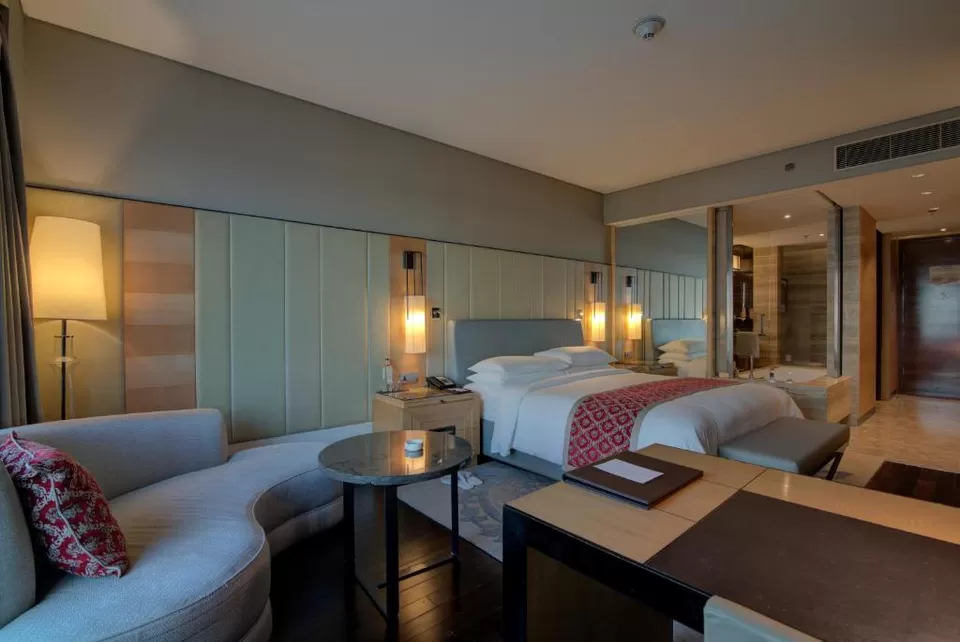
Sheraton New Delhi Hotel : This is a 5-star hotel located 7.9 km from Qutub Minar. It offers spacious and elegant rooms with modern amenities and city views. It also has a fitness center, a spa, an outdoor pool, and three restaurants.
JW Marriott Hotel New Delhi Aerocity : This is another 5-star hotel located 8.5 km from Qutub Minar. It offers luxurious and stylish rooms with air conditioning, minibars, and flat-screen TVs. It also has a 24-hour fitness center, a spa, an outdoor pool, and six dining options.
Udman Hotels and Resorts by Ferns N Petals : This is a 4-star resort located 7 km from Qutub Minar. It offers cozy and comfortable rooms with garden views and free wifi. It also has a banquet hall, a terrace, a lawn, and a restaurant.
Places To Visit After Qutub Minar
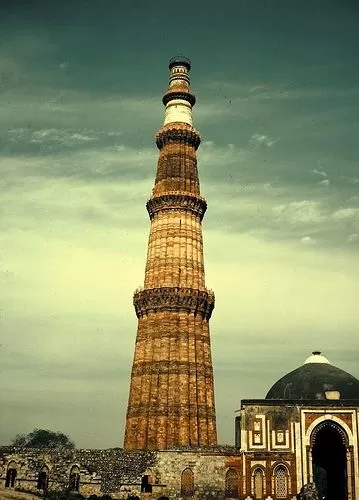
National Museum, New Delhi : The National Museum in New Delhi is one of India’s largest museums. The museum’s key holdings include the Dancing Girl sculpture, a carved ivory tusk depicting Buddha’s life stories, and a significant jade collection.
Lotus Temple : The Lotus Temple, also known as the Bahá’í House of Worship, is notable for its flowerlike shape and has won numerous architectural awards. Opened to the public in December 1986, it is constructed of 27 free-standing marble-clad “petals” arranged in clusters to form nine sides.
Humayun’s Tomb : Humayun’s Tomb in Delhi is the tomb of the Mughal Emperor Humayun and was the first garden-tomb on the Indian subcontinent and inspired several major architectural innovations, leading to the construction of the Taj Mahal.
Mehrauli Archaeological Park : Spread over 200 acres, Mehrauli Archaeological Park is adjacent to the Qutub Minar World Heritage site. It contains over 100 historically significant monuments, including the ruins of Lal Kot, the oldest extant fort of Delhi.
Jagannath Temple : Located in Hauz Khas, this modern temple is built by the Odia community of Delhi and is dedicated to the Hindu God Jagannath. It is renowned for its annual Rathyatra festival, which attracts thousands of devotees.
Garden of Five Senses : A 20-acre park located in Said-Ul-Ajaib village, close to the historic area of Mehrauli. It’s designed to stimulate the five senses with its natural beauty, artworks, and sculptures. The park also hosts various events, including an annual flower show.
Plan a complete Delhi Tour Package and enjoy the best of capital city
Guided Tours In Qutub Minar
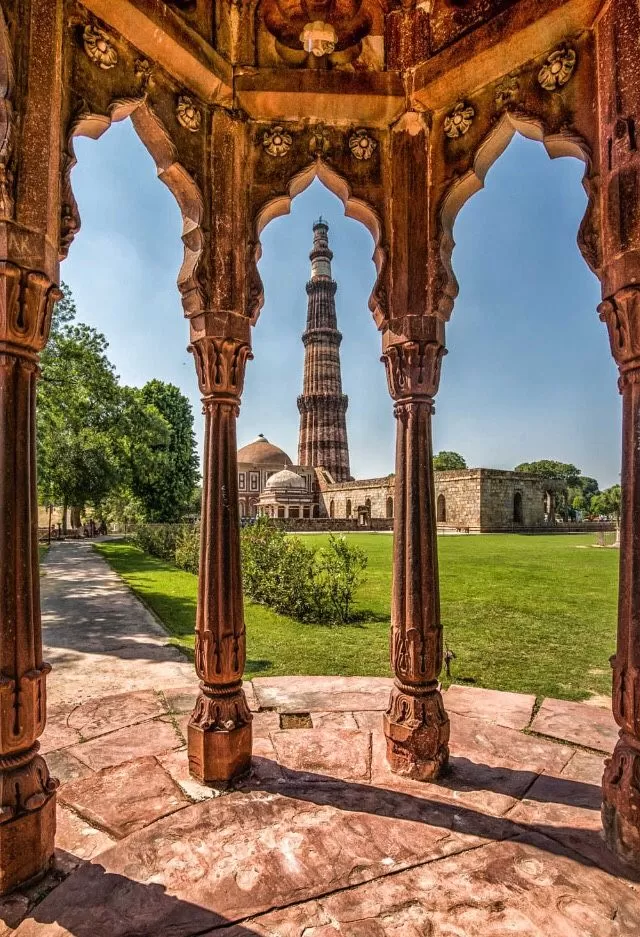
Yes, there are guided tours available for Qutub Minar.
- Tourio offers an audio guide for Qutub Minar, which can be downloaded for a fee of INR 100. The guide is GPS-enabled and provides relevant facts about the monument as you explore it.
- GetYourGuide offers tours and activities for Qutub Minar, including guided tours like the "Delhi: Old and New Delhi Guided Full or Half-Day Tour" starting from INR 2,230
Best Time To Visit Qutub Minar

The best times to visit Qutub Minar are during the early morning or late afternoon to avoid the crowds and the heat.
Visiting on weekdays rather than weekends can help you enjoy a more peaceful experience.
The months of October to March , during the winter season, are generally considered the best time to visit Delhi.
How To Reach Qutub Minar?
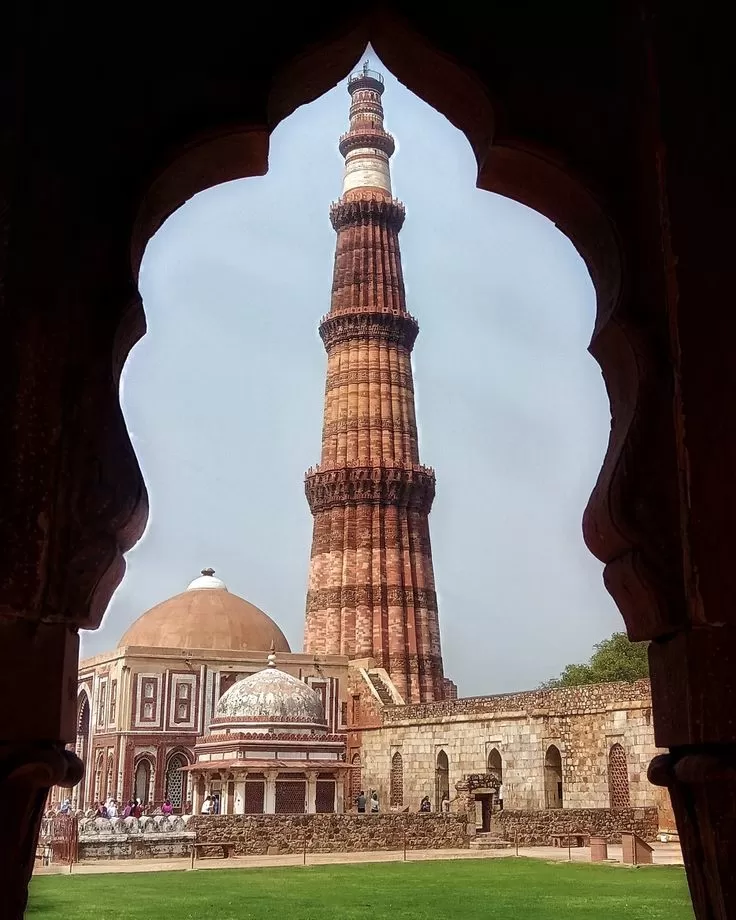
Metro: Nearest station is Qutub Minar (Yellow Line), fare around ₹50-60.
Bus: Several routes available, fares vary.
Auto-rickshaw/Taxi: Easily available, auto fare from ₹30.
Car: Well-connected by roads, parking available, fuel and parking charges apply.
Tourist Bus: Many operators offer tours including Qutub Minar, prices vary.
Qutub Minar Reviews

Places To Visit In New Delhi
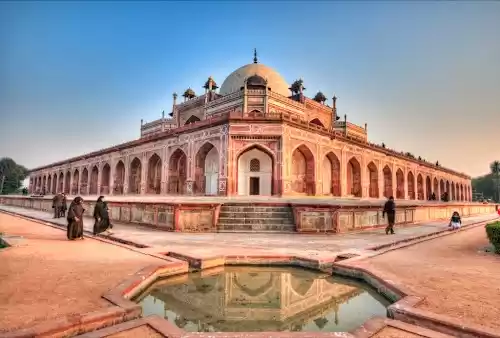
Travel Blogs for Qutub Minar

Qutub Minar
₹ 4,771 onwards
Top Hotel Collections

Hotels Near Qutub Minar
Label : Top Attraction
Tags : Monument
Timings : 10:00 AM - 5:00 PM. Qutub Minar remains open for tourists all days except Sunday
Time Required : 2 to 3 hours
Entry Fee : Indians, SAARC and BIMSTEC: INR 40, Foreign tourists: INR 600 Children up to 15 years: Free with valid ID
Nearest Metro Station : Qutub Minar on Yellow Line
Dimensions : 14.3 metres (47 feet) base diameter 2.7 metres (9 feet) top diameter 379 steps of the staircase
Height : 72.5 metres (238 ft)
Planning a Trip? Ask Your Question
Qutub Complex
Qutub minar, delhi overview.
Qutub Minar is a minaret or a victory tower located in Qutub complex, a UNESCO World Heritage Site in Delhi's Mehrauli area. With the height of 72.5 metres (238 ft), Qutub Minar is the second tallest monument of Delhi. Its construction was started in 1192 by Qutb Ud-Din-Aibak, founder of Delhi Sultanate after he defeated the last Hindu Ruler of Delhi. He constructed the basement, after which the construction was taken over by his son-in-law and successor Iltutmish who constructed three additional stories. The fourth and fifth storeys were built by Firoz Shah Tuglak.
Qutub Minar Highlights
1. quwwat-ul-islam mosque.

2. Alai Darwaza

3. Iron Pillar

4. Alai Minar

5. Tomb of Adham Khan

Read More on Qutub Minar
History of qutub minar.
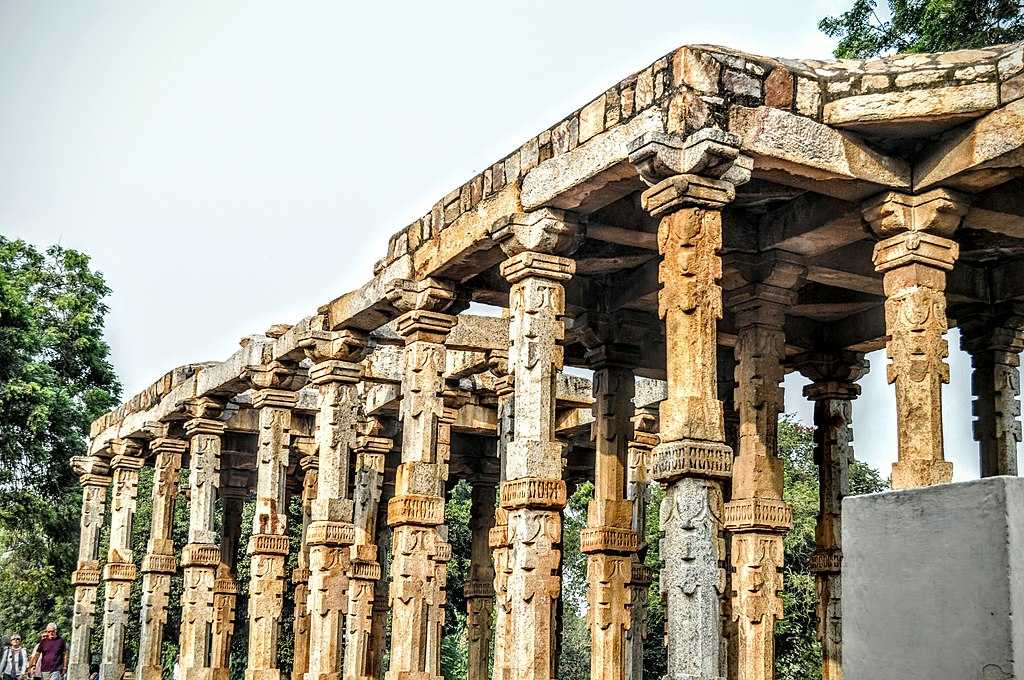
Architecture of Qutub Minar
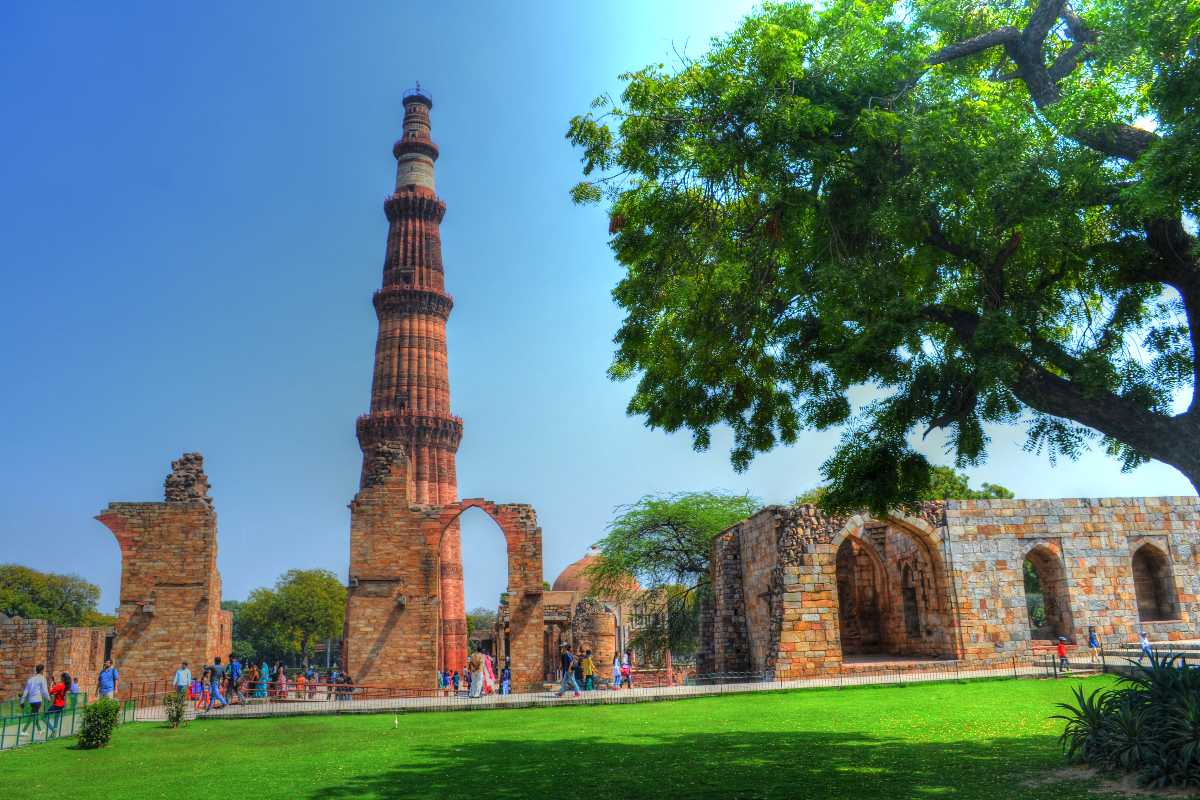
Qutub Festival
Best time to visit qutub minar, trivia about qutub minar, how to reach qutub minar.
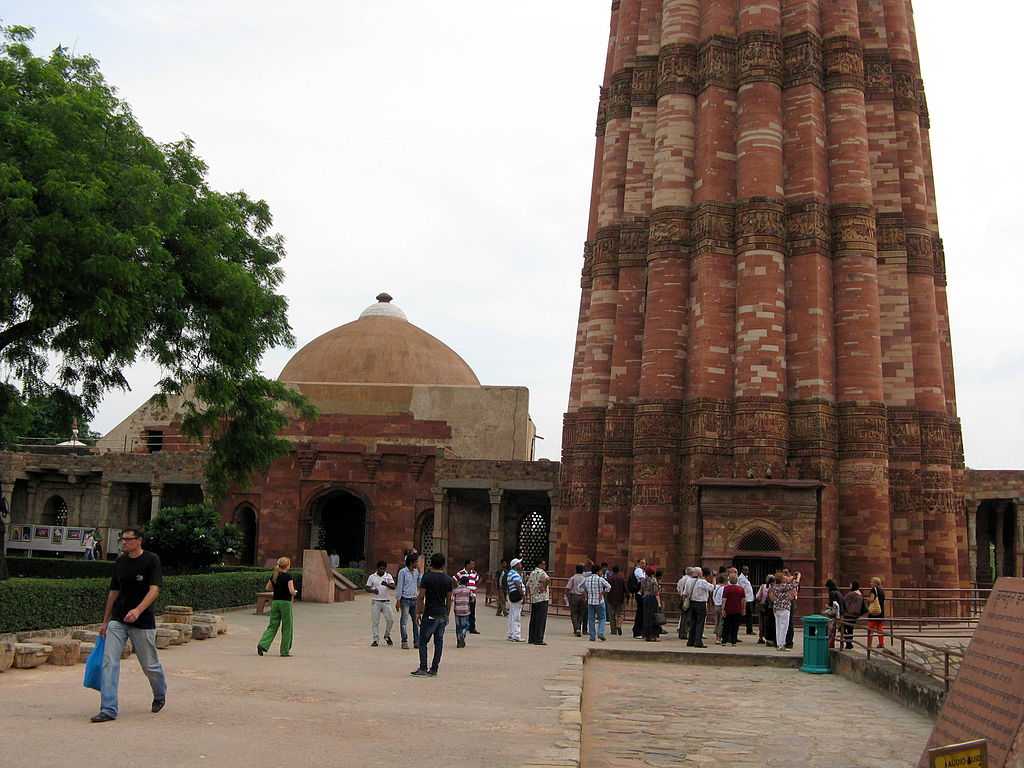
Delhi Travel Packages
Compare quotes from upto 3 travel agents for free
Short Break to Delhi and Agra
4 night 5 days shimla manali package, splendid delhi agra jaipur package, dharamshala dalhousie honeymoon package, romantic kullu manali shimla volvo tour package, spirited kasol and manali trip.
Best Hotels
Hyatt Hotels
Cheap Hotels
South Delhi Hotels
Top Hotels Near Qutub Minar
6.8 (8186 reviews)
7 kms
₹ 5,300 onwards
8.2 (6581 reviews)
₹ 8,973 onwards
7.9 (5731 reviews)
₹ 7,145 onwards
7.7 (5436 reviews)
₹ 7,000 onwards
7.5 (4088 reviews)
₹ 6,999 onwards
8.7 (3863 reviews)
8 kms
₹ 7,500 onwards
Qutub Minar Reviews
Soumita Ghosh
neha choudhary
takeout best
Arushi Gorsi
Have a Question on Qutub Minar?

Other Top Ranking Places In Delhi
Nearby places.

Explore Related Destinations

Related Posts

Fairs & Festivals
Republic Day of India 2024 - All You Need to Know

Food & Drink
Paranthe Wali Gali - What Not to Miss While Heading Out for the Heavenly Sunday Brunch!

Sightseeing
Sunder Nursery, Delhi

Experiences
Majnu ka Tilla - Little Tibet in Delhi

Water Parks In Delhi

Chor Bazaar Delhi - Everything You Should Know About This Thieves Market

Hill Stations
Best Hill Stations near Delhi

Art & Culture
Amar Jawan Jyoti - The Eternal Flame!

14 Malls in Delhi For Shopping, Food, Movies and More!

Best Restaurants in Delhi: These Restaurants in Delhi Are A Must On Your Next Vacay!

13 Amusement Parks in Delhi NCR for a Fun Filled Time

26 Cafes in CP You Just Connaught Miss
Similar Places

Get the best offers on Travel Packages
Compare package quotes from top travel agents
Compare upto 3 quotes for free
- India (+91)
*Final prices will be shared by our partner agents based on your requirements.
Log in to your account
Welcome to holidify.
Forget Password?
Share this page

Savaari Car Rentals Blog
Travel begins with Savaari
Top things to do in Qutub Minar – A complete travel guide
The Qutub Minar is an iconic monument of Delhi. It was built by the famous ruler of the time, Qutub-ud-Din Aibak, in 1193, and it has a height of 73 meters (238 feet). The tower is considered an important architectural heritage because of its Indo-Islamic-styled architecture. The best way to soak in the beauty of this monument is by booking a cab in Delhi. Visiting Qutub Minar is more than just looking at its architectural beauty or learning about its history—it’s a fully immersive experience.
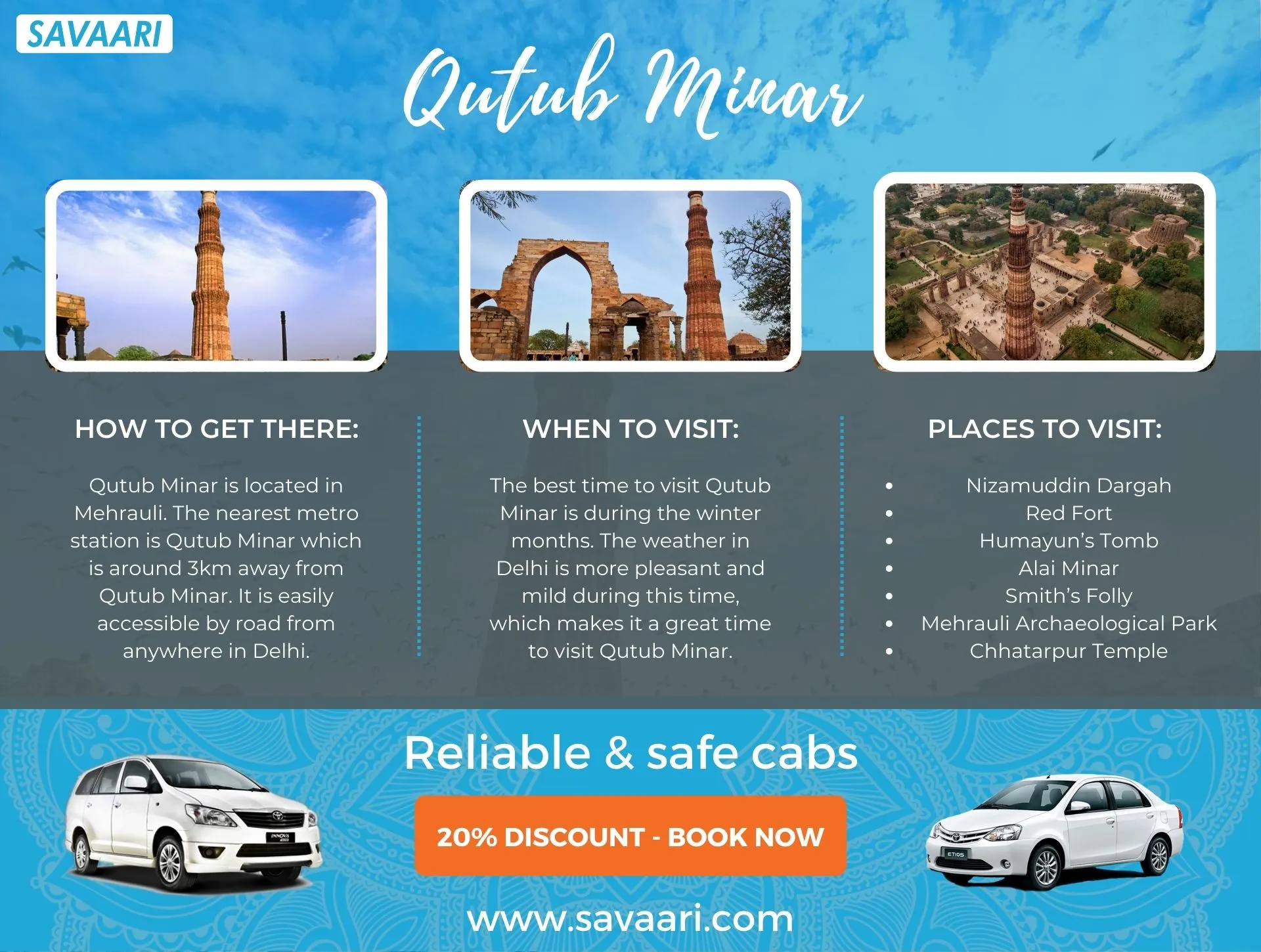
Table of Contents
Architecture.
- Things to do
Places to visit nearby
- How to reach
- Best time to visit
- Travelling Tips
- Timing and entry fee
- Hotels and Resorts
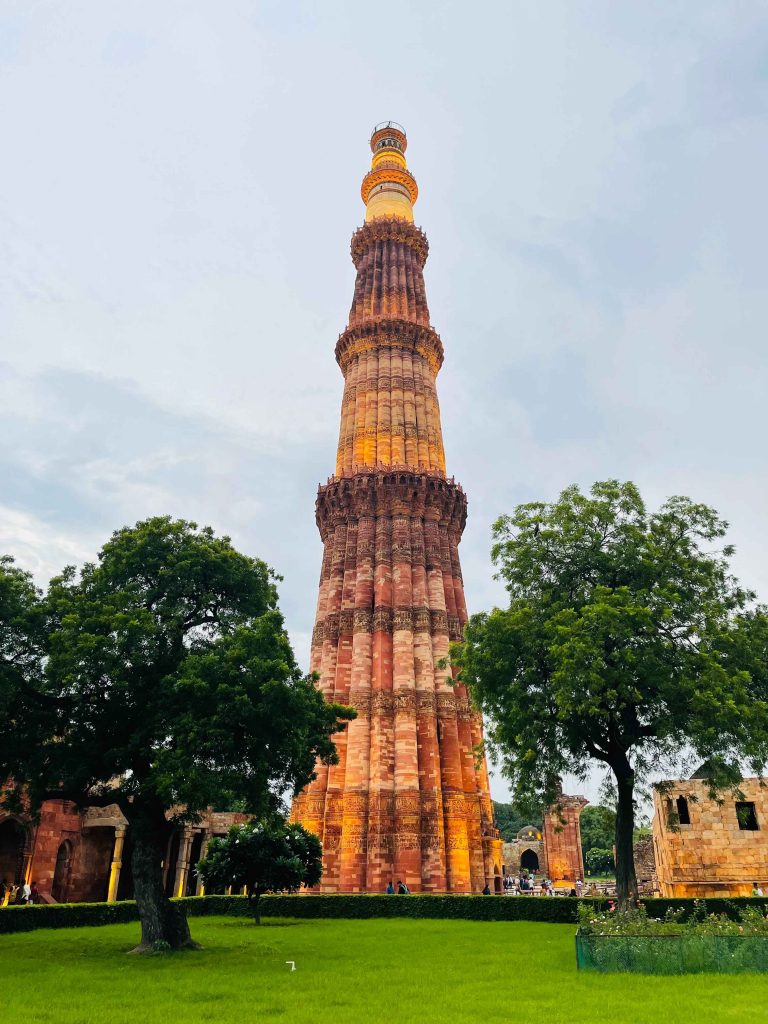
Qutub Minar is a tower that stands tall in the heart of Delhi. It was built by the first Muslim ruler of Delhi and is believed to be one of the tallest brick minarets in the world. The tower is 73 meters high and made of red sandstone and marble.
The towering minaret was built with red sandstone and marble and had a spiral staircase made of red sandstone on its exterior. The top floor contains chambers for prayer, as well as a mosque on the second floor. At each corner of the tower were two small towers called guldaste that guards used to keep watch from above; these have since been removed from the structure due to safety concerns.
The Qutub Minar is considered one of Delhi’s most important landmarks because it provides insight into both Islamic architecture and medieval Indian history; additionally, it has been used as an inspiration by many other artists throughout history, including Shah Jahan, who built the Taj Mahal based off this design.
Qutub Minar is a tower in Mehrauli, Delhi, India. Qutb-ud-din Aybak built it from 1199 to 1210 CE and was the first Muslim ruler of Delhi.
The seminar was constructed as a victory tower to commemorate his triumphs over the Hindu rulers of this region. Although the construction was completed in 1210, it was damaged by lightning strikes and earthquakes and had to be repaired several times. It was restored by Muhammad-bin-Tughluq, Firuz Shah Tughluq, and Sikandar Lodi in the coming years.
This tower is high and has 379 steps to its top. The word Qutub means “axis” or “pivot”, signifying one’s spiritual pivot (or axis) between the temporal world and the spiritual realm.
There is also a mosque inside the complex that can accommodate many worshippers at any time. The mosque is open only for Muslims during prayers; visitors are allowed to enter its courtyard freely at other times. It is one of Delhi’s most popular tourist destinations and attracts about 3.9 million visitors annually.
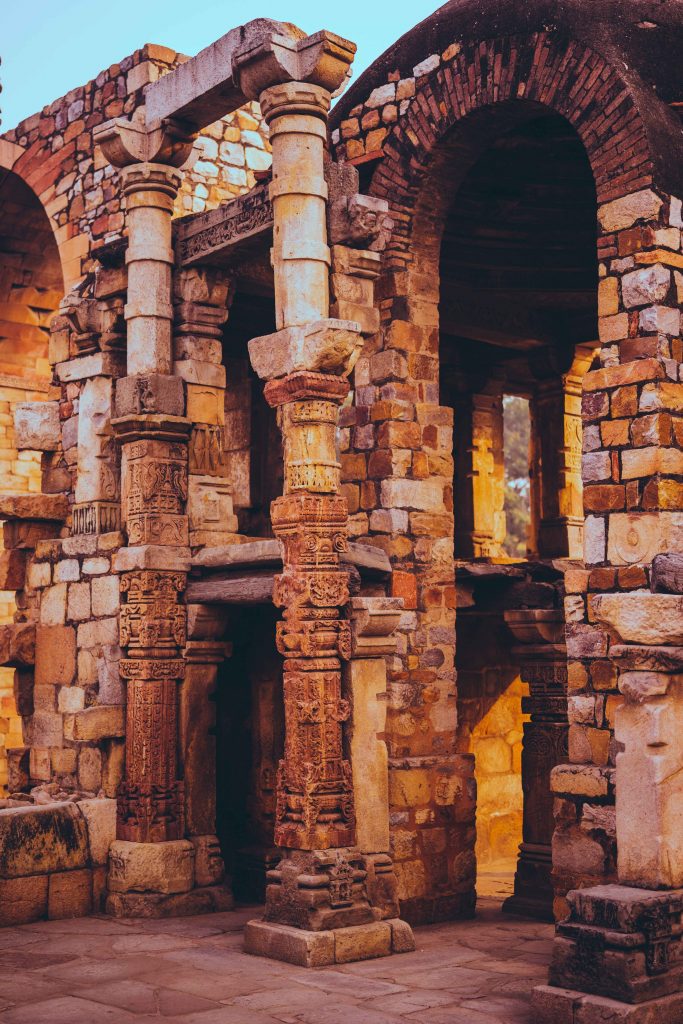
Qutub Minar’s architecture is a perfect example of the beauty of Islamic architecture. The monument comprises five stories, each with a distinct style and design.
The first floor is rectangular, while the second floor is square. The topmost portion has a diameter of 14.3 meters. It contains an inscription that mentions the names of donors who contributed to building this magnificent structure.
The first gate on entering the complex is called “Peshwa Darwaza”. It has three arches and beautiful carvings all over its walls depicting scenes from Hindu mythology like Bhagavad Gita, Ramayana, Mahabharata, etc.
There are five entrances on all four sides except for one side with two doors. Seven floors can be accessed through these entrances. Each floor has over one hundred rooms on every side except for one side with only two; this room faces east towards Mecca and is called the “Tomb Room”.

Facts about Qutub Minar
The Qutub Minar is one of India’s most famous monuments and one of the world’s tallest free-standing towers. But did you know that…
- It was built by Qutb-ud-din Aibak, an enslaved Turkish who became Sultan of Delhi.
- The minaret was about 5 stories high—but the top two stories have since collapsed.
- The tower has been repaired frequently due to earthquakes and other natural disasters.
- Legend has it that its uppermost story was supposed to be made from gold when it was first built.
- Qutub Minar was built from red sandstone and covered with decorative Indo-Islamic carvings and verses from the Quran.
Comprehensive guide to cover Qutub Minar
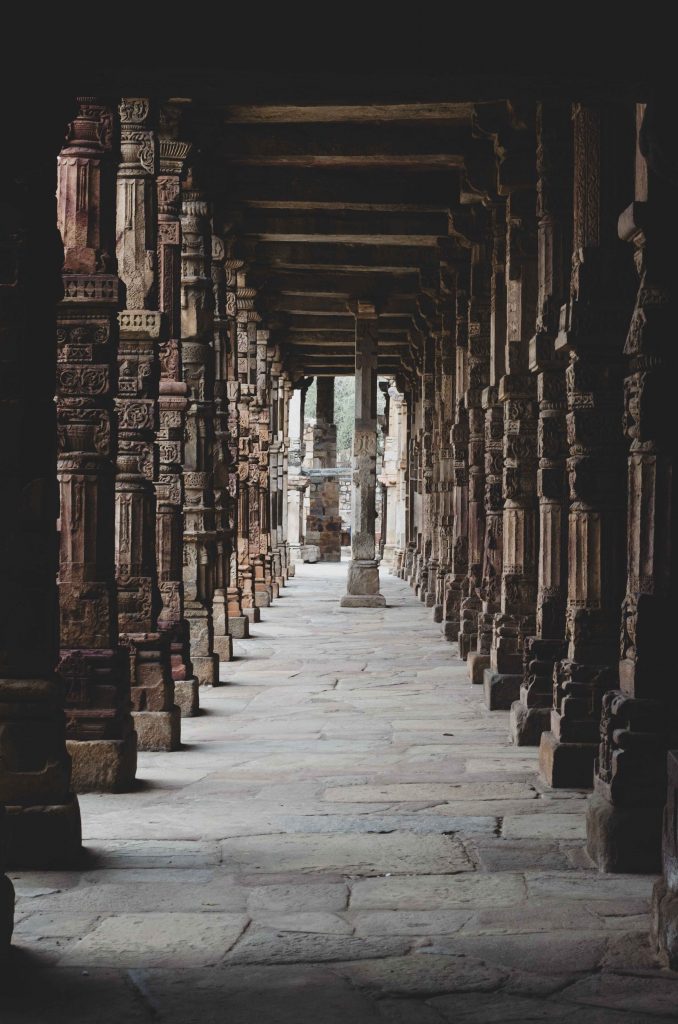
The Qutub Minar is one of the most popular tourist attractions in Delhi, and for a good reason. This historical monument is part of a larger complex called the Qutub Complex, including other temples, tombs, and gardens.
Visitors can still enjoy plenty of things at this site despite these limitations:
- They can take pictures from ground level up through the first few stories.
- They can walk around nearby gardens.
- They can explore other buildings within the complex, like a tomb or mosque, if they’re interested in learning more about Islamic and Qutub Minar architecture or culture.
Things to do in Qutub Minar
If you’re looking for things to do near Qutub Minar, we’ve got you covered!
The interior of this tower is also worth checking out—it contains intricate carvings and beautiful designs made by skilled craftsmen over 900 years ago. Some parts of these carvings have been damaged by weather over time, but they’re still beautiful to look at.
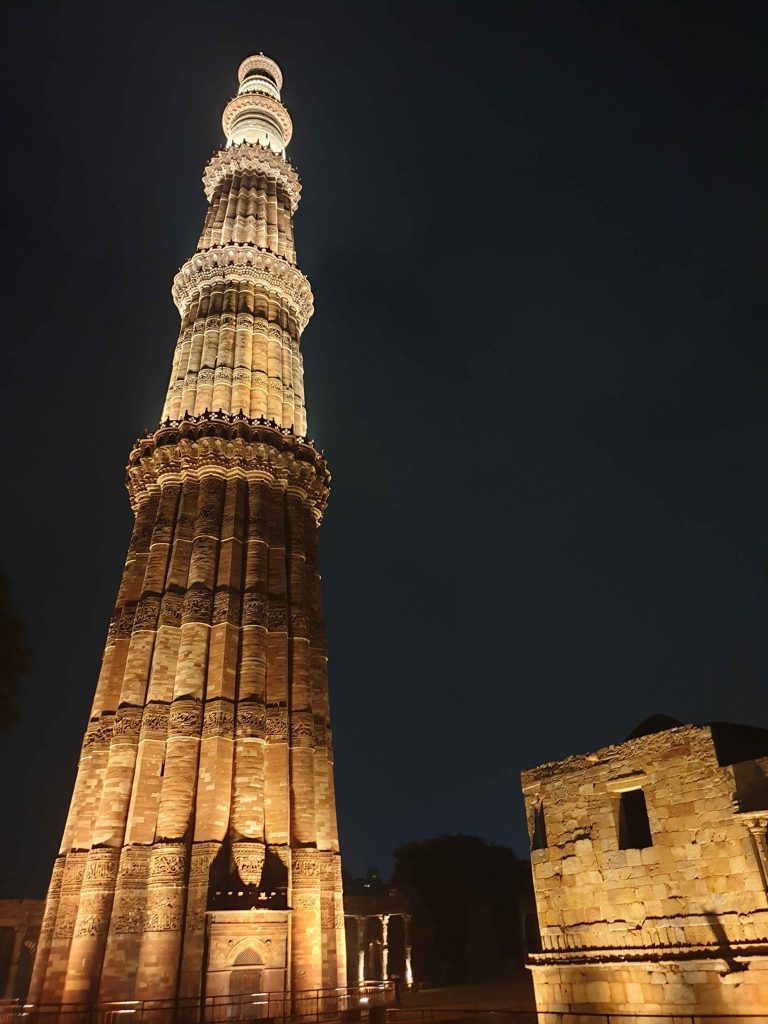
The exterior design structure was built using different bricks that were put together in different ways depending on what kind of structure they would be used for (for example, some parts were made using only red bricks while others were built using both red and yellow).
Here are some of the different things you can do when you visit:
- Visit the Tombs of Qutb-ud-din Aybak and Shamsi Badruz Jahan Begum
- See the Dome of Asaf Khan’s Tomb
- See the ruins of Lal Kot Fort and Humayun’s Tomb
- See the Royal Baths (hammam) inside the complex
Tourists can visit many other attractions near Qutub Minar to make their trip more complete. Don’t forget to know the details and the list of places to visit in Delhi city. Some popular destinations include Humayun’s Tomb, Nizamuddin Dargah, Red Fort, Purana Qila and Safdarjung Tomb among others.
There are many other places nearby where you can go for fun activities such as shopping or just exploring the city on foot or by bike. Delhi is known for its delicious street food, so take a food tour of the city and experience the true flavours of this city. Here are some suggestions for things you can do around Qutub Minar:
- Humayun’s Tomb ( Entry Fee: INR 35 , For Foreigners: INR 550)
Humayun’s Tomb, located in Delhi, India, is famous for its intricate architecture and stunning design. Humayun’s widow built the Tomb after his death in 1556. The structure was built to resemble a Persian tomb replica, which inspired the design.
People can visit the Tomb and explore the intricacies of its architecture. They can also enjoy a panoramic view of New Delhi from atop the terrace of this mausoleum.
The Tomb is located at a distance of 10 km from Qutub Minar.
- Nizamuddin Dargah
The Nizamuddin Dargah is one of the most-visited destinations in Delhi. The famous shrine attracts thousands of visitors every day. It offers them a glimpse into India’s rich culture, history, and traditions.
The Dargah is located in the Mehrauli area of South Delhi. It can be reached easily by road or public transport. The closest metro station is Chawri Bazar, just a few minutes from the shrine.
- Red Fort ( Entry fee: INR 35, Foreigners: INR 500)
Red Fort is one of the most famous monuments in Delhi. It has been named after the color of its sandstone walls. It was built by Mughal emperor Shah Jahan as a symbol of power and to commemorate his victory over the Mongols in 1638.
How to plan a trip to Qutub Minar?
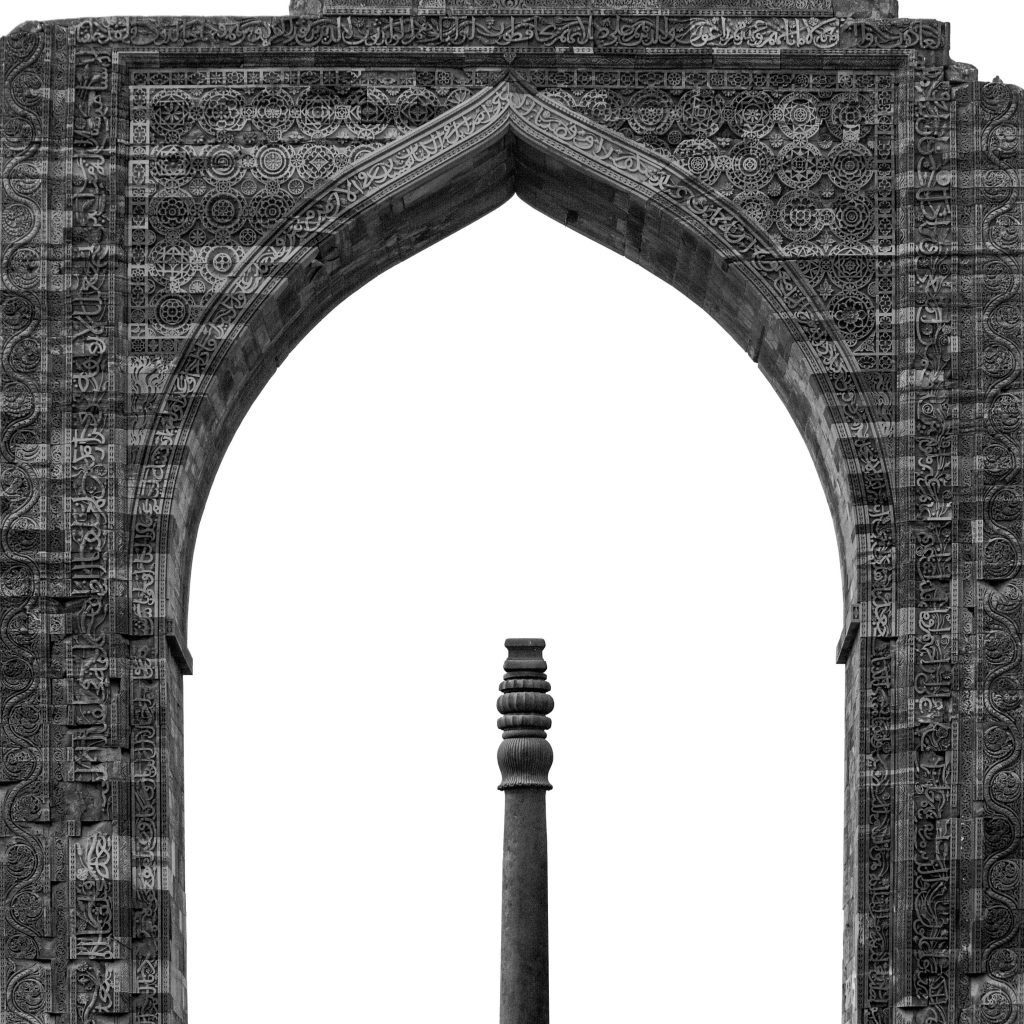
Planning a trip to Qutub Minar is easy if you follow these simple steps.
- Choose the best time to visit: If you want to skip the crowd, it is best to visit Qutub Minar early in the morning.
- Check out the weather: If it is raining or extremely hot or cold, then plan accordingly by wearing warm clothing or a raincoat or umbrella, depending on the season.
- Make sure you have enough cash on hand as there are no ATMs near Qutub Minar, and you may need some money for food and other things such as souvenirs from nearby shops.
- The most important step is booking accommodation near Qutub Minar in advance! You can stay at any one of the many hotels that are close by so that you do not have to worry about transportation while exploring this historical monument.
How to reach Qutub Minar?
The closest railway station to Qutub Minar is Anand Vihar, which is served by the Delhi Metro. The metro system operates on a single line from Anand Vihar to Dwarka Sector 21. You can take an auto or rickshaw from Anand Vihar to Qutub Minar, less than 19 km away. You can also use this route if you’re taking public transportation from other areas of Delhi.
If you’re coming from somewhere else in India, there are many options for getting to Anand Vihar by train. Some trains stop at Old Delhi Station, which is about 15.4 km away from Qutub Minar; others stop at Hazrat Nizamuddin Station (about 13 km away); others stop at New Delhi Railway Station (about 15 km away).
Qutub Minar, one of the best UNESCO World Heritage Sites in Delhi, is located in Mehrauli. The nearest metro station is Qutub Minar which is around 3km away from Qutub Minar. It is easily accessible by road from anywhere in Delhi, taking a cab in Delhi is the best way to travel around the city . To travel to Qutub Minar by car, take the Ring Road (NH-2) and exit at Mehrauli Village.
If you want to reach Qutub Minar in an instant, you can choose to fly to Delhi. The city is connected to major cities in India and other parts of the world through air travel.
Regarding air travel, many airlines operate flights from various cities to New Delhi airports. Air India, Jet Airways, Indigo Airlines, and SpiceJet are some airlines.
Best time to visit Qutub Minar
The best time to visit Qutub Minar is during the winter months.
The weather in Delhi is more pleasant and mild during this time, which makes it a great time to visit Qutub Minar.
During the winter, you can enjoy a walk around the area without getting too hot or uncomfortable.
Also, there are fewer crowds at Qutub Minar during this time of year, so you can enjoy your time there without feeling rushed or crowded.
Travel tips for visiting Qutub Minar
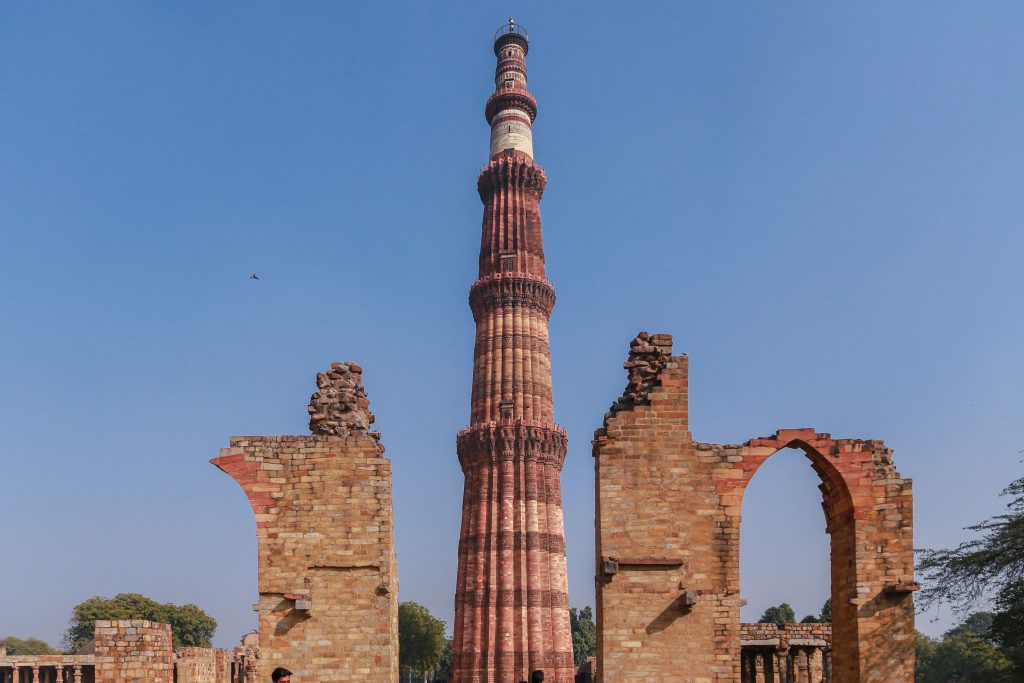
- Travel light. There are no lockers at the Qutub Minar, so you’ll need to carry all your belongings. Avoid robbery by not bringing valuable things.
- Wear comfortable shoes. The Qutub Minar is a steep climb; if you’re not used to exercising regularly, it might be hard on your knees and ankles.
- Bring a water bottle and some snacks. The queues can be long, and there’s nowhere to buy food inside the complex of structures; it’s better to have your provisions in case you get hungry or thirsty before your turn comes up!
- The best time to visit Qutub Minar is between October and March.
- To avoid the crowd, visit during the weekdays. Avoid weekends & holidays.
Qutub Minar timings and entry fee
The Qutub Minar timings say it is open from 9:00 am-5:00 pm daily. If you’d like to visit the Qutub Minar, your best bet is to go during off-peak hours when there won’t be many people around (think early morning or late evening).
Qutub Minar Tickets for entry into the complex are INR 30 for Indians. Still, there is an additional fee for foreigners inside the complex with an entry fee of INR 550.
Hotels and Restaurants near Qutub Minar
Last Updated on May 21, 2024 by V Subhadra
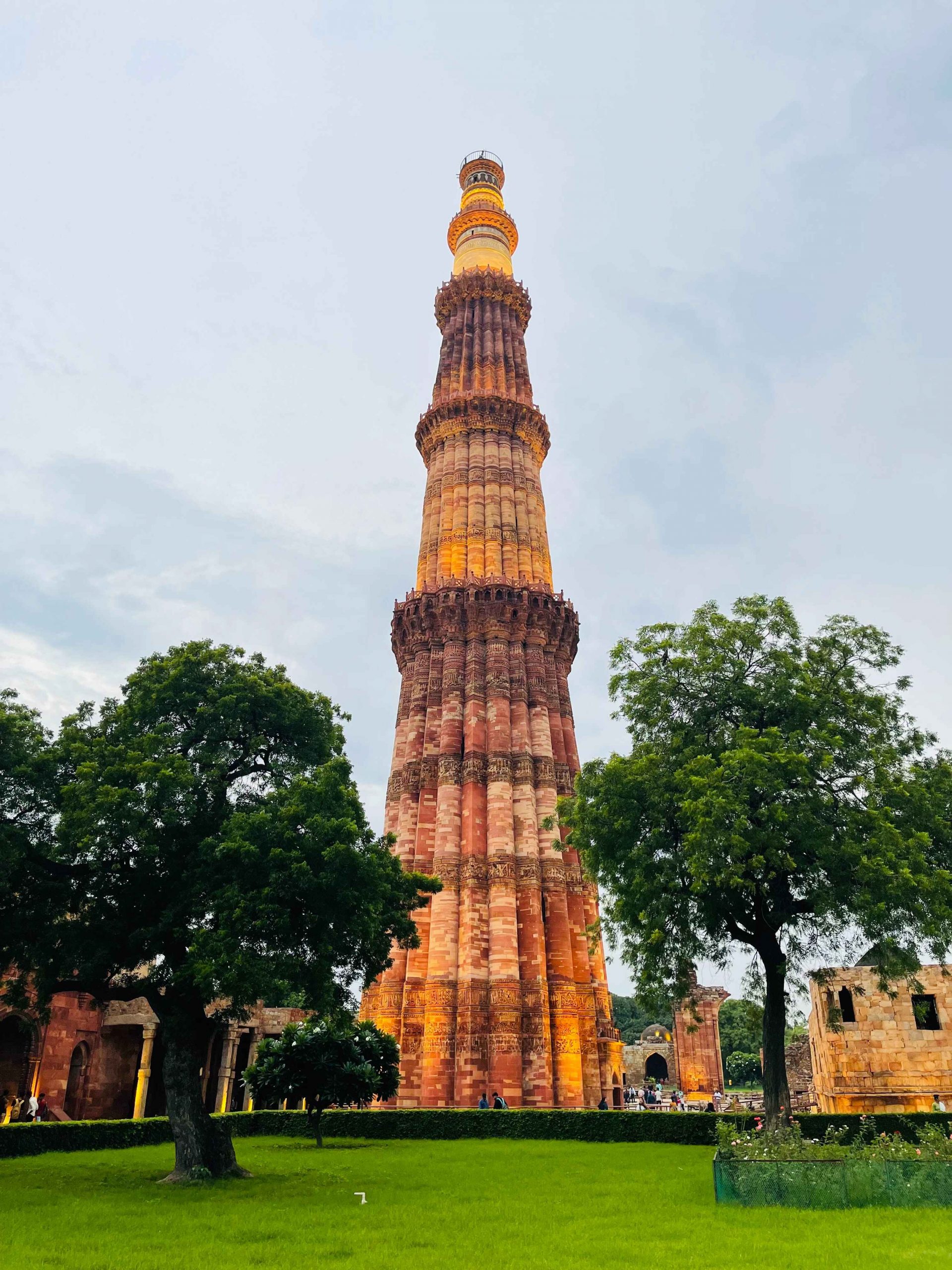
About the author
Related posts, #60daysofsummer – kids’ day out to wonderla bangalore, this hill station in kerala will become your new favourite destination.

Love Letters To The Western Ghats of Karnataka
Leave a reply cancel reply.
Your email address will not be published. Required fields are marked *
Save my name, email, and website in this browser for the next time I comment.
- Attractions
- Places To Visit In Delhi
- Qutub Minar In Delhi

Qutub Minar in Delhi

10:00 am to 4:30 pm

- Foreigners Entry Ticket : free
- Indians Entry Ticket : free

Qutub Minar Delhi is a victory tower or minaret found in the Qutub complex, a UNESCO World Heritage Site in Mehrauli. Qutub Minar is the second-highest structure in Delhi, standing at 72.5 meters. After defeating Delhi's last Hindu ruler, Qutb Ud-Din-Aibak, founder of the Delhi Sultanate, began building in 1192. He built the basement, which was then carried over by his son-in-law and successor Iltutmish, who built three further levels. Firoz Shah Tughlaq erected the fourth and fifth floors.
It is one of the most popular places to visit in Delhi , having been constructed mostly between 1199 and 1220. It is comparable to the 62-meter all-brick Minaret of Jam in Afghanistan, which was built a decade or so before the likely start date of the Qutub Minar Delhi . With Southwestern Asian style, this victory tower represents a fusion of traditional Islamic architecture. Before 1976, the public had access to the top level of the minaret through the internal stairway. Due to suicides, access to the summit was restricted after 2000.
Popular Tour Packages
How to reach qutub minar in delhi.
By Rail The nearest railway station is 17 kilometers away and 55 minutes away, New Delhi Railway Station.
By Bus If you're using the bus, the nearest stop is the Qutub Minar Bus Stand, which is located immediately outside the monument's main entrance. To go to this landmark, board a DTC bus from anywhere in Delhi NCR. It is easy to get around Delhi because there are regular buses, taxis, autos, and online cab services accessible. By Metro Residents of Delhi can catch the metro to the Qutab Minar Metro Station. You may hail a taxi because the monument is only a 6-minute drive from the subway exit.
Best Time Visit Qutub Minar in Delhi
The Qutub Minar is open every day of the week and is open from 7:00 a.m. to 5:00 p.m. Because Delhi experiences scorching summer temperatures, the best time to visit Qutub Minar Delhi is during the winter season, when the weather is mild and nice for touring. The months of October through March are ideal for visiting Delhi.
Tips To Visit Qutub Minar in Delhi
- If you want to avoid the crowds, go to Qutub Minar first thing in the morning.
- If it is raining, excessively hot or cold, or both, dress appropriately by wearing warm clothing, a raincoat, or an umbrella, depending on the season.
- Make sure you have enough cash because there are no ATMs near the Qutub Minar Delhi and you may need money for lunch and other items such as souvenirs at nearby shops.
- The most important phase is to reserve accommodation near Qutub Minar ahead of time. You may stay at any of the nearby hotels to avoid having to bother about transportation while seeing this historical site.
Things To Do Qutub Minar in Delhi
We've got you covered if you're looking for activities to do near Qutub Minar Delhi . Here are some ideas for things to do in Delhi :
- The interior of this tower is equally worth seeing since it has exquisite carvings and stunning decorations created over 900 years ago by expert artisans. Some of these carvings have been weathered over time, but they are still lovely to look at.
- The external design structure was constructed using various bricks that were assembled in various ways depending on the type of construction they would be used for; some portions were constructed using solely red bricks, while others were constructed using both red and yellow bricks.
- Humayun's Tomb in Delhi, India, is well-known for its intricate construction and magnificent design. After Humayun died in 1556, his wife constructed the Tomb. The structure was created to seem like a reproduction of a Persian tomb, which influenced the design.
- The Nizamuddin Dargah is a popular tourist attraction in Delhi. Every day, thousands of people visit the famed shrine. It provides students with an insight into India's rich culture, history, and customs. visiting Nizamuddin Dargah is one of the top Things to Do in India .
- The Red Fort is one of Delhi's most well-known landmarks. It got its name from the color of its sandstone walls. Shah Jahan erected it as a symbol of authority to celebrate his triumph over the Mongols in 1638.
Get In Touch With Our Travel Expert
Nearby places in delhi.

Qutub Minar location Map
FAQs About Qutub Minar in Delhi
01 what is so special about the qutub minar.
Qutub Minar is a minaret that was built in the 12th century in Delhi, India. It is the tallest brick minaret in the world and is a popular tourist attraction. Qutub Minar is 73 meters (240 feet) tall, making it the tallest brick minaret in the world and one of the most significant places to visit in Delhi .
02 What is the significance of Qutub Minar?
It is a symbol of the early Islamic rule in India and is considered an important landmark in the history of Delhi. Qutub Minar, Delhi is also considered a masterpiece of Indo-Islamic architecture.
03 Is there a dress code to visit Qutub Minar?
There is no specific dress code to visit Qutub Minar , Delhi but visitors are advised to dress modestly.
04 Are there any restrictions on photography at Qutub Minar?
Visitors are allowed to take photographs at Qutub Minar, but tripods and selfie sticks are not allowed. Additionally, visitors are not allowed to climb the minaret. You can capture this beautiful place to visit in Delhi in your mobile cameras but shooting for professional reasons is not permitted.
Important Links
- Worldwide Tour Packages
- Things to Do International
- Worldwide Travel Guide
- International Attractions
- Worldwide Honeymoon packages
- International Visa
- Things To Do In Dubai
- Desert Safari In Dubai
- Dubai Tour Packages
- India Tour Packages
- Rajasthan Tour Packages
- Golden Triangle Tour Packages
- Taj Mahal Tour Packages
- Jordan Tour packages
- Egypt Tour packages
- Sri Lanka Tour packages
- Azerbaijan Tour packages
- Singapore Tour packages
- Maldives Tour packages
- Thailand Tour packages
- Oman Tour packages
- Turkey Tour packages
- Bali Tour packages
- Malaysia Tour packages
- Georgia Tour packages
Quick Links
- Terms & Conditions
- Privacy Policy

Trip Advisor Reviews
- “ I would just like to say Alida is the best customer service representative I have met... ” more
- Read reviews |
- Write a review
© 2023 Travejar.com All rights reserved.
Everything you need to know about Qutub Minar Complex, Delhi
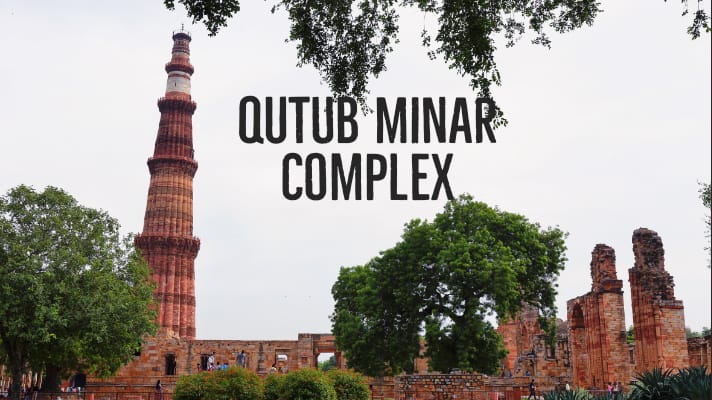
Last Updated on March 11, 2023 by admin
Planning a trip to Qutub Minar Complex, Delhi? This Qutub Minar guide covers all the places to visit within the complex as well as history and architectural facts.
A towering monument, an architectural masterpiece, historically significant, and one of the most iconic landmarks in the city of Delhi is Qutub Minar. Visiting here is one of the best things to do in Delhi .
Built as a sign of victory and to display the power and significance of the existence of the rulers prevailing at that time, Qutub Minar definitely is a monument of wonder and one of a kind.
Qutb Minar and its monuments comprise of Minar, Mosques, and the Iron Pillar making the complete ensemble of a UNESCO World Heritage Site .
Table of Contents
ABOUT QUTUB MINAR COMPLEX
The Qutub Minar Complex was built by the first ruler of the Delhi sultanate, Qutub-Ud-Din Aibak, and later on, completed by his successors over a period of 150 years. The monument stood tall facing all the attacks and natural calamities to date, narrating the grandeur it witnessed over the years.
Qutub Minar’s height is 72.5 meters and the base diameter is 14.3 meters, making it the tallest brick minaret in the world .
QUTUB MINAR COMPLEX HISTORY
Back in the 12th century, this part of North India was ruled by Mohd. Ghori from the Ghurid dynasty who was known to be the invader from Afghanistan.
Qutub-ud-din Aibak was a General in Mohd. Ghori’s army was responsible to look after the invaded lands in India. After the death of Mohd. Ghori, Aibak formed his own kingdom and started to rule under the name of the Mamluk dynasty thus establishing the rule of the then Delhi Sultanate and him being the first ruler.
Qutub Minar facts say that after Qutb-ud-din Aibak , his son-in-law Iltutmish added stories to it, and was repaired and refurbished by Mohd bin Tuglaq and Sikandar Lodi after the events of lightning and earthquake.
The Qutub Minar Complex is now protected and looked after by the Archeological Survey of India under its Delhi circle of monuments. Others are Agrasen ki Baori , Purana Qila, and a few more.
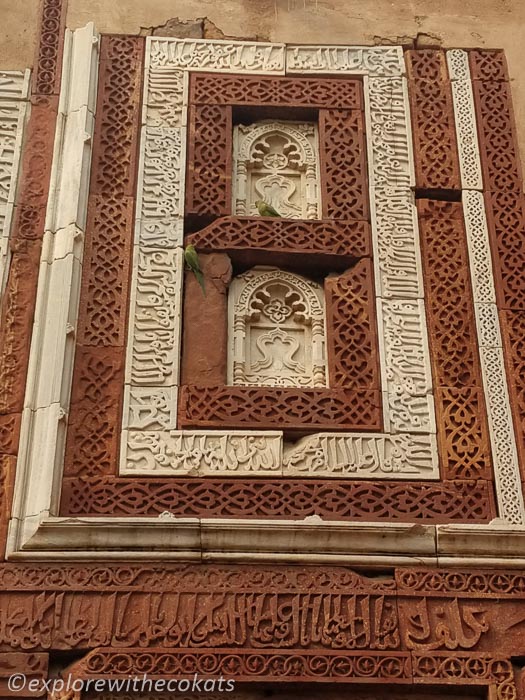
QUTUB MINAR COMPLEX GUIDE
While Qutub Minar always grabs attention, the entire complex has many fantastic monuments that should not be missed.
Qutub Minar
Replete with sandstone and marble Qutub Minar architecture astounds visitors.
Qutub Minar is a five-story monument out of which the first three are built with red sandstones, the fourth is made of marble and the fifth is a mixture of both the two. It is said that, architecturally, it was inspired by the Minaret of Jam in Afghanistan and hence was based on the Afghan style of architecture.
Each story of this monument has a balcony that adorns beautiful designs. From the bottom to the top, one can observe the change in the style of construction and architecture due to the change of time when they were built.
Few architectural experts say that it can also be categorized under Indo-Islamic architecture as the laborers who built them were locals and were overseen by the Muslim architects thus giving it a good cultural blend.
One can find the inscription on the stories of Qutub Minar. These are written in Arabic and are the verses from the holy book of the Quran. Have a look at such an architectural blend at the Mandu fort complex .
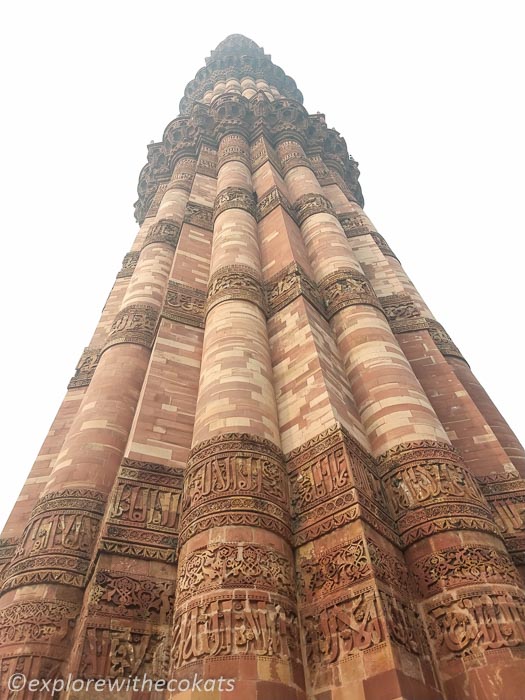
Quwwat-ul-Islam Mosque
Quwwat-Ul-Islam mosque was known as the Jami Masjid in the early days of its inception. It was then renamed as Quwwat-Ul-Islam Mosque meaning the ‘Might of Islam’.
The mosque mainly has a central courtyard and also a big prayer hall. One could observe a large massive stone screen standing in front of the prayer hall. The screen is beautifully carved and has inscriptions from the holy book of the Quran.
It is one of the oldest structures in India depicting the architecture influenced by the Ghurid dynasty. Eventually, many additions were made to this place by Iiltutmish and Alaundin Khilji.
The building was built of red sandstone, grey quartz, and white marble, however, the mosque is now in ruins and being looked after by the Archeological Survey of India.
If you are interested in studying the architecture of this place, going there early in the morning would be advisable. This way one can avoid the tourist rush. Read more about old mosques in the city of Bhopal .
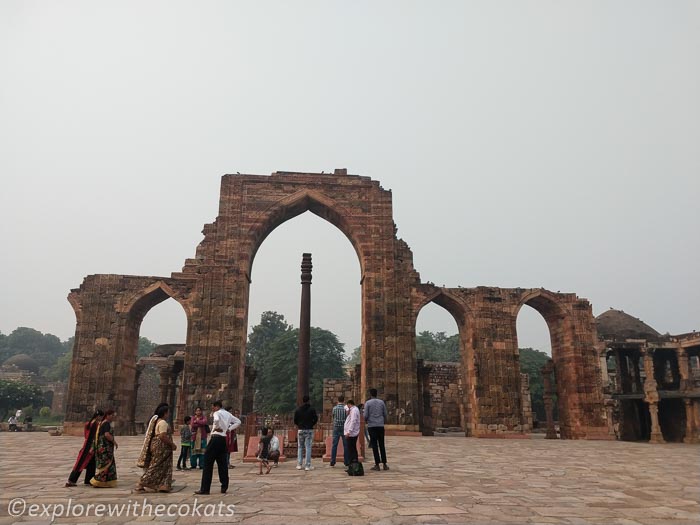
Alai Minar
This is the only unfinished structure in the complex and is associated with the fierce and over-ambitious Alaundin Khilji.
He wanted to outshine the work of Qutubudin Aibak and thus wanted to build this Minar which was supposedly double in size as the Qutub Minar. He wanted Alai Minar to be so tall that everyone in the world would recognize the might of the great Sultan. He believed that the height of the Minar would depict his greatness and courageous nature. He also wanted the Quwwat-Ul-Islam mosque to be increased by four times and hence there were four gates planned to be constructed to accommodate the big size of the mosque.
Although in ruins, it looks beautiful and gives insight into how beautiful and majestic it would have looked if it were completed.
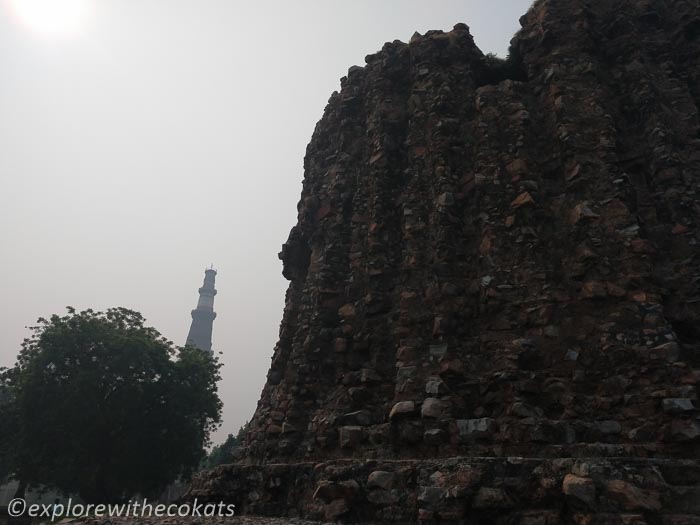

Iron Pillar of Chandragupta Maurya
Weighing around 6 tonnes, this Iron Pillar forms one of the important parts of the Qutub Minar Complex.
It is around 1600 years old and is exposed to different weather conditions in the city of Delhi, but it is standing tall without even an ounce of rust on it making it an amazing piece of metal for study by metallurgy experts.
It has inscriptions in Sanskrit and Gupta Brahmi language which date back to the time of Chandragupta Maurya and have been believed to have been erected to commemorate the victory of the king in various battles. It was dedicated to Lord Vishnu. It was first believed to be erected in Udayagiri which is located in present-day Madhya Pradesh and then brought to Delhi.
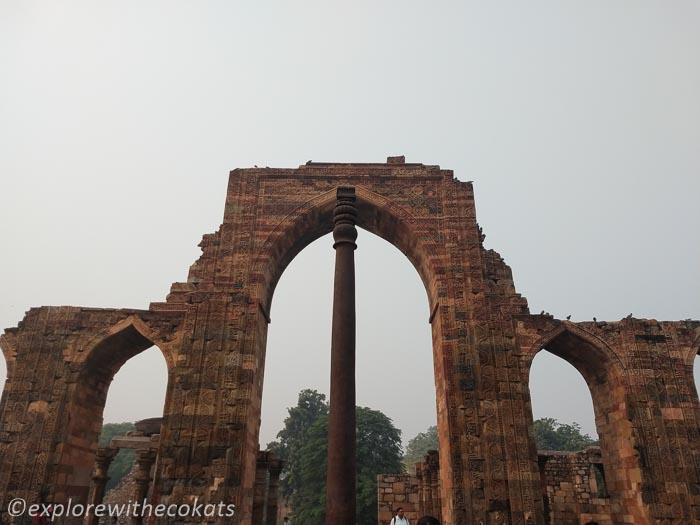
Tomb of Imam Zamin
Along with these monuments, the Qutub Minar Complex also houses the Tomb of Imam Zamin. Imam Zamim was a Turkestani Imam who lived in this Qutub Minar Complex during the reign of Sikandar Lodi. He came to Delhi in the 15th Century and was the Imam of the Quwwat-Ul-Islam mosque.
This tomb was constructed by Imam Zamin himself and was buried a few years after his death. The tomb is a small sandstone structure with an octagonal base.
Tomb & Madrasa of Alauddin Khilji
This is the only example of the Madrasa and Tomb combination in India and a part of the Qutub Minar Complex. The madrasa was built by Aladdin Khilji to propagate Islamic learning and his tomb is located within the madrasa. Though a mighty ruler, Alauddin Khilji, his tomb is the most simple in the city of Delhi as also it lies in ruins today.
It is said that Firoz Shah Tuglaq made a few repairs to the tomb but today one finds it in a secluded state. It is said by Sufi saints that it was a sight of pilgrimage earlier and people used to tie threads for the fulfillment of their wishes.
Tomb of Iltutmish
Another important part of the Qutub Minar Complex is the Tomb of Iltutmish. It is the first tomb of a Sultan in India and was built by Iltutmish himself. It is located in the North West direction of the Quwwat-Ul-Islam mosque.
The outer of the tomb is plain but the inner part is rich in decorative aspects. It has three beautifully carved arches.
The entrance has beautiful geometrical patterns and engraved motifs like lotus, diamonds, and wheels which also gives an insight of the local architecture prevalent at that time.
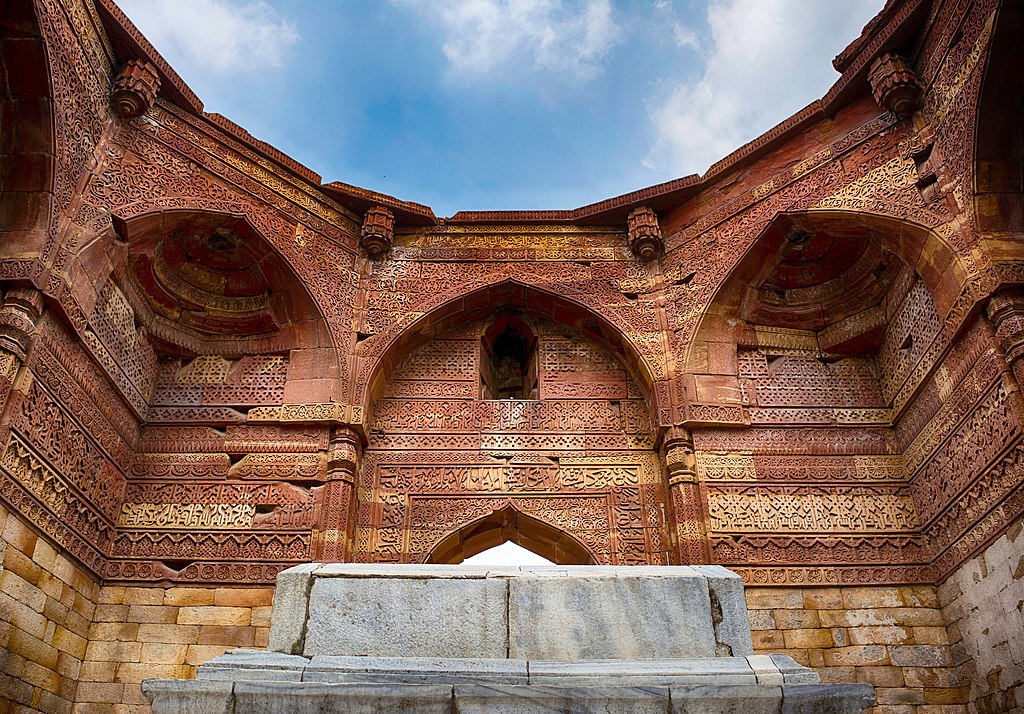
Alai Darwaza
Stands in the southern direction of the Quwwat-Ul-Islam Mosque in the Qutub Minar Complex, is the Alai Darwaza. It was a part of the massive enlargement project undertaken by Alauddin Khilji after his win over the Deccan part of India to show gratitude towards God for his victory.
Under this project, he wanted to enlarge the Quwwat-Ul-Islam and made four gates adjoining it in all four directions. As per his plans, only Alai Darwaza could be constructed as he died after its construction. It looks like a square-shaped domed house with arched entrances. It depicts Indo-Islamic architecture and is amongst the first structures built by such architecture in India.
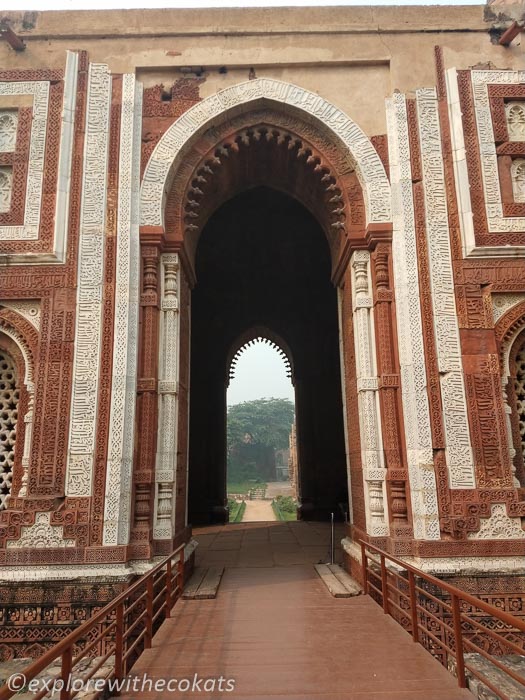
Sanderson’s sundial
Gordon Sanderson was the archaeologist of the Archeological Survey of India and this sundial has been installed to commemorate his achievements. He was appointed to undertake research on several historical buildings in Delhi, Agra, Gwalior, and nearby places.
Smith’s Folly
Folly, or the architectural disaster as mentioned by historians, is a cenotaph or a chhatri-shaped structure placed in the Qutub Minar Complex in Mehrauli, Delhi.
Qutub Minar has been struck by lightning and shaken by earthquakes making it vulnerable and efforts have been taken the time and again to restore the minaret. One such effort was made by Maj Robert Smith directed by the British Governor General of India, Lord Wellesly. He placed a Hindu-style cupola on an Indo-Islamic structure which looked absolutely out of place and out of sync. Hence, it was taken out and placed on the lawns of the Qutub Minar Complex.
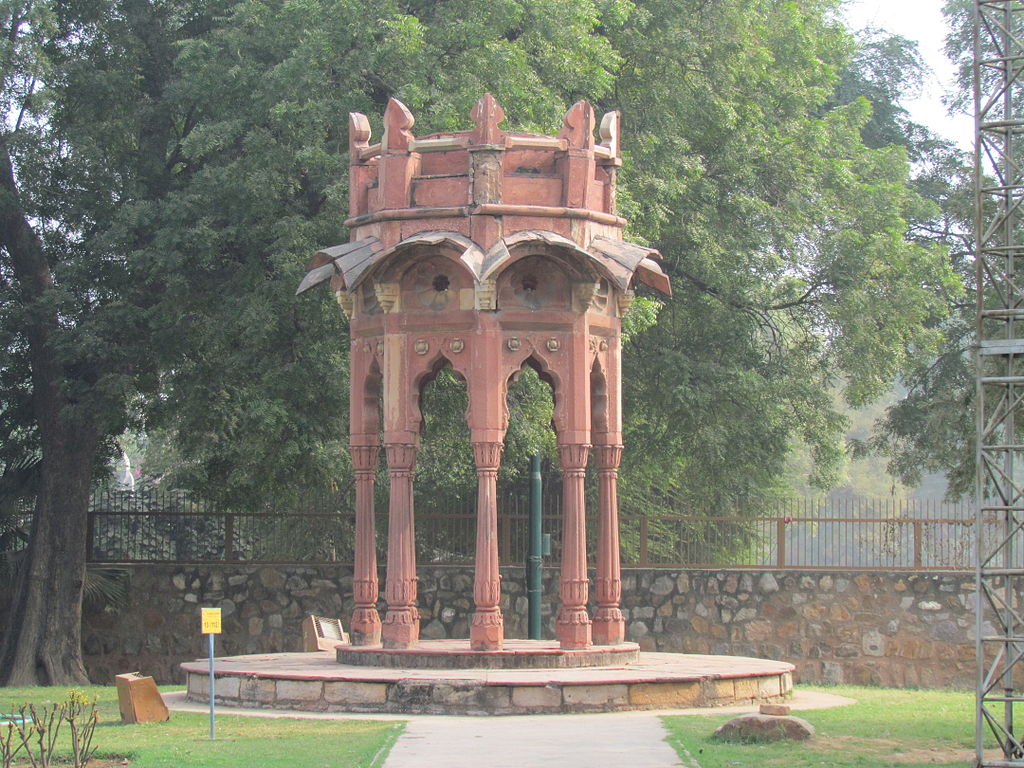
ESSENTIAL TRAVEL INFORMATION
Photography at qutb complex.
Photography is allowed at the Qutub complex. One can click photos from a phone and DSLR with no extra charge. However, the use of tripods or any professional photography needs prior permission from ASI.
Qutub Minar Ticket Price (as of January 2023)
Indian nationals: INR 40
Foreign nationals: INR 500
Video Camera charge: INR 25
Best time to visit Qutb Minar complex
It is advisable to visit Qutub Minar in winter as the cool weather makes it comfortable for sightseeing.
The complex is open every day from 7 am to 5 pm. It opens up again at 7 pm in the evening for night viewing and closes back at 10 pm.
The experience at night is totally different from that of the day as many of the structures including the Qutub Minar are all lit up at night beautifying it to another level.
How to reach Qutub Minar by Metro, Bus, Taxi, Auto
The nearest metro station to Qutub Minar Complex is Qutub Minar Metro Station which is on the yellow line of the Delhi Metro Rail Network. The approximate distance of Qutub Minar from the metro station is 1.60 Kilometres. Auto Rickshaws and taxis are available here and one can also take a DTC bus which has a good frequency.
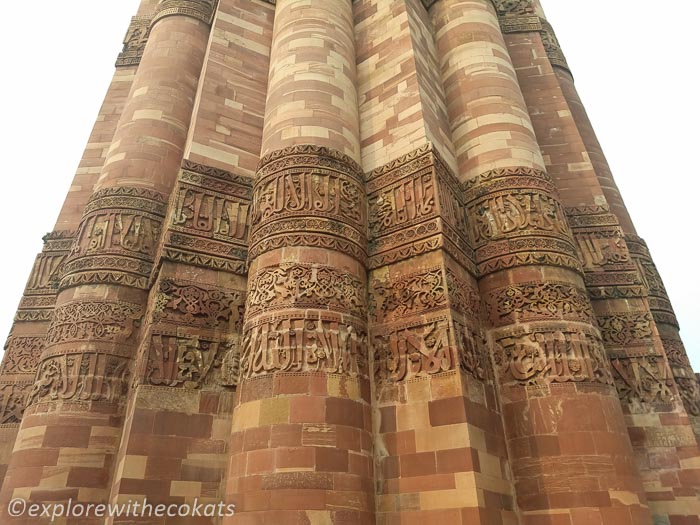
WHERE TO STAY IN MEHRAULI, DELHI
Since all touristy things are spread across Delhi, it may be difficult to decide the area of accommodation in Delhi. South Delhi and Mehrauli offer a few upscale spaces but are safer. Most places have good connectivity with auto-rickshaws, app-based taxis and metro.
There are great options for hotels, resorts, homestays and hostels in Delhi. Some of the options are:
Luxury hotel: ITC Maurya , The Imperial Hotel , The Lodhi
Mid Range hotel: The Claridges, New Delhi , Radisson Blu, CP , Radisson Blu, Dwarka
Homestay: Prakash Kutir B&B , Thikana Delhi
Hostel: The Hosteller , Madpackers Delhi , Zostel Delhi
FAQs for QUTUB MINAR COMPLEX
What is included in the qutub complex.
Apart from the Qutub Minar, other monuments include Quwwat ul-Islam Mosque, Alai Darwaza gate, the Alai Minar and the Iron pillar.
Who built the Qutub Minar complex?
Qutbu’d-Din Aibak laid the foundation of Minar in AD 1199 for the use of the muezzin (crier) to give calls for prayer and raised the first storey. Later on, three more storeys were added by his successor and son-in-law, Shamsu’d-Din Iltutmish.
How many steps are there in Qutub Minar?
The whole tower contains a spiral staircase of 379 steps. Each storey has a balcony that encircles the tower.
Is entry allowed inside Qutub Minar?
No entry inside Qutub Minar is prohibited since the fatal stampede in 1981.
Is worship allowed in Qutb Complex?
As per the Ancient Monuments Act, the Qutub Minar Complex is a monument and no right to worship can be granted at this place.
What is Qutub Festival?
To celebrate the cultural legacy, Qutub Festival is organised every year in the month of November & December. It’s an art festival which happens for three days witnessing live performances of various singers, dancers, and artists.
Are bags allowed in Qutub Complex?
Visitors are not allowed to take any kind of luggage inside the complex. There is a cloakroom, where you will have to deposit bags, backpacks, etc. No food is allowed inside the complex, except drinking water.
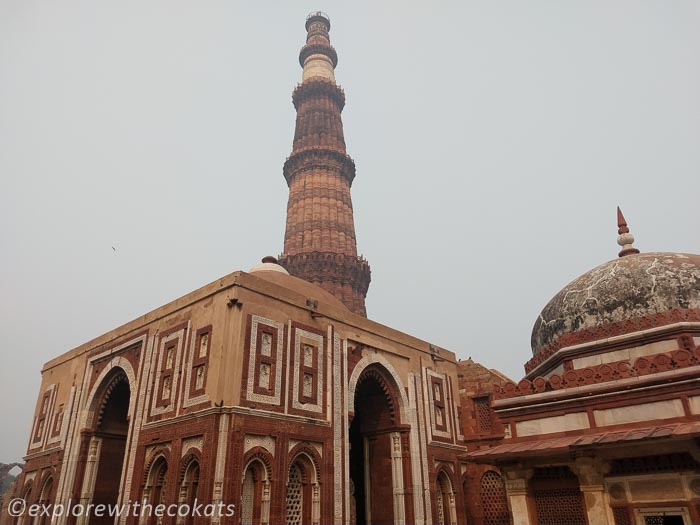
SUSTAINABLE TIPS FOR VISITING QUTUB MINAR COMPLEX
- Do not write on or distort the rocks of the fort. You are witnessing a portion of history so respect it.
- The monuments of Qutub have stood the test of time. It’s good to respect them by not writing names or scratching the surface.
Read More posts from Delhi here
- National War Memorial, Delhi
- Waste to Wonder Park, Delhi
- Best Shopping places in Delhi
Disclaimer – This post contains affiliate links. It means it adds no extra cost to you if you book through the link but I get a referral bonus which helps me earn a little to keep this website up and running. Read about my Privacy Policy .
Pin this post!
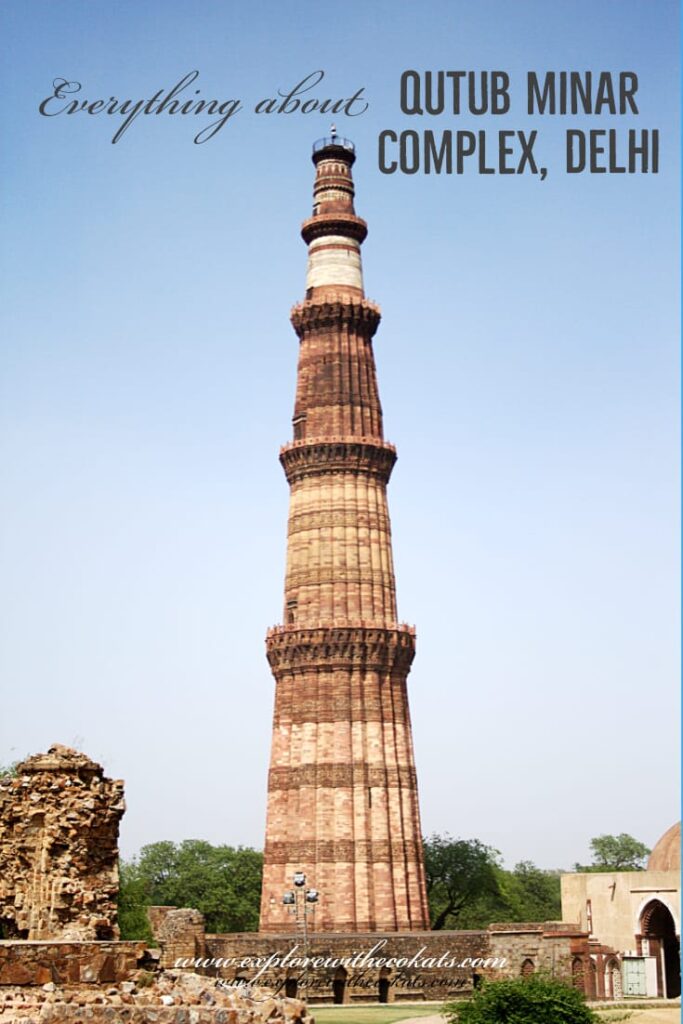
Renu Karanjgaonkar
Renu Karanjgaonkar is a home maker, reiki healer, an avid reader and a travel enthusiast. She has traveled places and believes that travel makes one modest and humble. We can see what a tiny place we occupy in this world.
Kuang Si Waterfalls, Laos: Day trip from Luang Prabang
Things to do in sigiriya | an ultimate guide, you may also like, plan a trip to mandu madhya pradesh with..., trekking in munnar (yellapatty trail), chennakesava temple somanathapura – an epitome of hoysala..., one day in warsaw: warsaw highlights, how i volunteered for a waste pick-up trek..., best wildlife and birding parks in botswana, all about orchha fort and places to visit..., best things to do in hanoi, best things to do in bukhara : a..., 10 lovely places to visit in pachmarhi, madhya....
Ms Renu you have written so well about this historic monument qutub minar. I especially liked the part on Smith’s folly…which am sure many of us wouldn’t know. Thank you so much for giving us a detailed glimpse into the past…we would surely be enlightened travellers with ecokarts as our travel mate. Keep writing ..best wishes
Thank you for your kind words 🙂
Leave a Comment Cancel Reply
Save my name, email, and website in this browser for the next time I comment.
Notify me of follow-up comments by email.
Notify me of new posts by email.

Qutub Minar, Delhi
Visitor information.
- Famous for: History, Culture, Photography
- Entrance Fee: 30 per Indian and Rs.500 per foreigner
- Visiting Time: Sunrise to Sunset
- Visit Duration: 2 hours to 3 hours
The Qutub Minar is a world famed structure which stands tall within the capital of the country, Delhi. Located at Mehrauli, the minar is about 240 meters tall and has got five storeys with a staircase which spirals all the way to the top. A building which has got great historical significance, the construction was started by Qutb ud-din Aibak in 1192 once he took over this region. A peculiar phenomenon is that the first three storeys have been constructed using red sandstone by Iltutmish while the other two storeys were built using marble and sandstone by the emperor Firoz Shah Tughlaq at different periods of time. The beautiful architecture, which attracts tourists from all over the country has been through a lot of important points in history. A cupola which was damaged in it was taken out of the building and has been set up nearby.
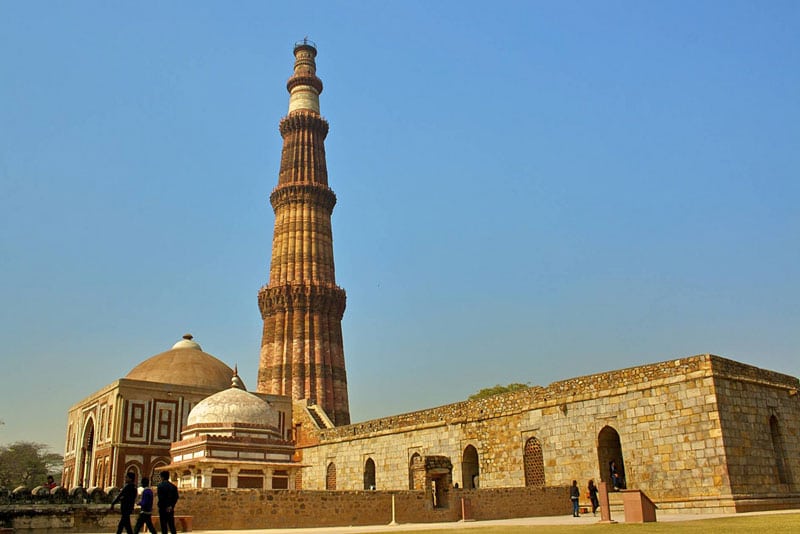
Traveler Tips
- The visitor access to the top of the structure is restricted due to safety concerns.
- The Qutub complex consists of a lot of structures to visit and will involve a lot of walking around.
- To counter the heat, wear a cap and carry water bottles.
Things to Do
- Take a look at the carvings on the walls which are of the verses of the Holy Quran.
- Visit the Quwwat Ul Mosque which is within the complex and was built around the same time as when the construction of minar was started.
- The very famous Iron Pillar , built before the Muslim rulers took over the region, is also a must visit because of its baffling property of not rusting and staying strong from a very long time.
- Photography can be carried out at the location which serves as a great backdrop and includes a lush green garden.
- The cupola like structure which was supposedly the sixth storey, was taken down and now can be viewed by the visitors just nearby the minaret.
- Buy stuff from the local hawkers and the markets to collect some souvenirs.
- The plethora of restaurants situated in the area are great to try out different kinds of dishes.
Availability of Guides
There are plenty of guides available to show you around the various structures located in the area. They will have to be paid a certain amount and can be available to explain the history in various languages which include English and Hindi.
Best Time to Visit
Since Delhi experiences really hot summers, it would be much better if the place is visited during the winter months i.e. from October to March. The best time to walk around the grounds would be during the evenings as the effect of the heat is lessened and makes the visit a much more pleasant experience.
How to Reach
Situated in Mehrauli, which is present in the southern part of the city, this famous tourist location can be easily reached by cabs or auto rickshaws. The metro can be taken to the Yellow Line, which is a walkable distance from the spot. Plenty of buses are available along the route of this location, along with Hop on Hop off service offering buses. Cars can be driven past Sri Aurobindo Marg to reach Lado Sarai where this structure is located.
Interesting Facts and Trivia About the Qutub Minar
- The diameter of the structure measures about 47 feet near the ground level while it thins out to about 10 feet at the top.
- The structures within the premises have architectural styles which have imbibed Muslim, Hindu and Saracenic patterns in their design.
- The Minaret of Jam situated in Afghanistan is said to be an inspiration for the designing of the Qutub Minar.
- A very slight tilt of about 65 centimeters can be observed when viewing the whole tower.
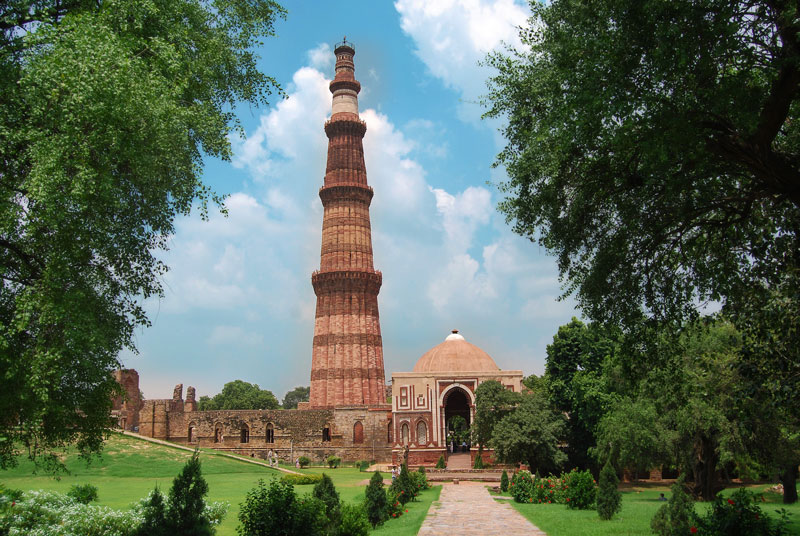
Nearby Restaurants
- Indian Accent
- Hauz Khas Social
Nearby Attractions
- Hauz Khas Village
- Khan Market
- Lodi Garden
The ultimate location to be visited by history buffs and travelers yearning to learn more about the history of the region is what the spot stands for. It perfectly inculcates a lot of history and beauty into a single location, which increases our perspective on the heritage and culture, while also making us stare in awe at the construction and designing of each of the building standing around in the premises.
About Rohit

Leave a Comment Cancel reply
- Lotus Temple
- Qutub Minar
- Garden of Five Senses
- Agrasen ki Baoli
- Humayun’s Tomb
- Chandni Chowk
- Lodhi Garden
- National Gallery of Modern Art (NGMA)
- Tughlaqabad Fort
- Tomb of Safdarjang
- Purana Qila
- India Habitat Centre
- Rashtrapati Bhawan
- Bangla Sahib Gurudwara
- National Zoological Park
- ISKCON Temple
- Things to do in Delhi
- Best Time to Visit Delhi
- Weekend Getaways from Delhi
- Hill Stations Near Delhi
- Forts in Delhi
- Resorts Near Delhi
- Picnic Spots Around Delhi
- Boating in Delhi
- Garden Parks in Delhi
- Haunted Places in Delhi
- Temples in Delhi
- Monuments in Delhi
- Places to Hangout with Friends in Delhi
- Honeymoon Destinations Near Delhi
- Romantic Places in Delhi
- Churches in Delhi
- Adventure Sports in Delhi
Perfect Place for Travel Freaks
Qutub Minar Delhi: Timings, Ticket Price, Height, History, Address, Entry Fees, Nearest Metro station, Opening Time, Online Ticket Booking, Photos, Built By, Images & Location 2024
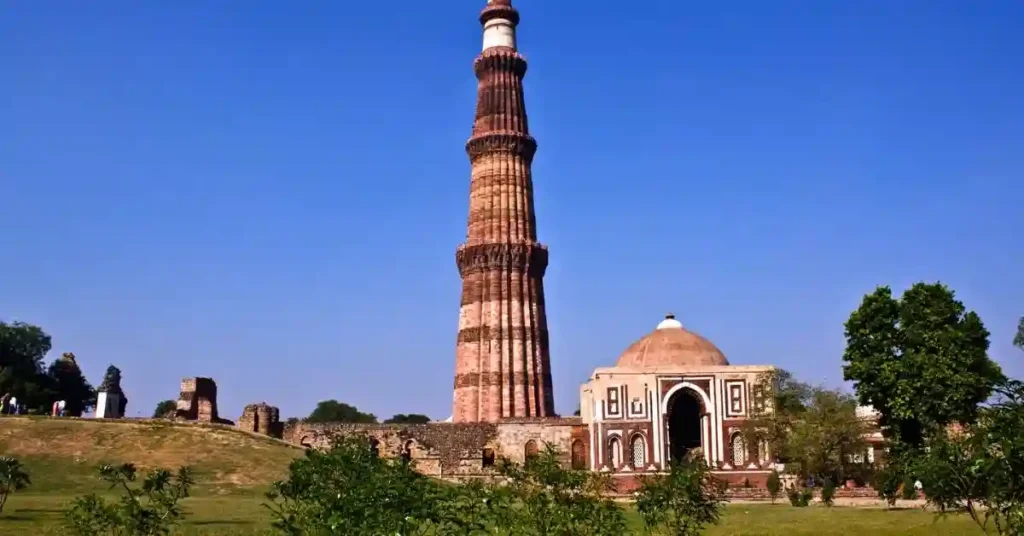
About Qutub Minar Delhi
Qutub Minar Delhi or Qutb Minar is a magnificent historical monument and one of the country’s most iconic landmarks. Located in Qutub Complex in the Mehrauli area of South Delhi, this 72.5 metres (238 ft) tall minaret or victory tower is a UNESCO World heritage Site and is an exceptional example of early Indo-Islamic architecture.
It was Constructed in the 12th century during the reign of Qutb-ud-din Aibak, founder of Delhi Sultanate after defeating the last Hindu Ruler of Delhi. He built the basement of the Qutub Minar and his son-in-law and successor Iltutmish constructed three stories. Finally, Firoz Shah Tuglak constructed the fourth and fifth storeys.
The Qutub Minar is made primarily of red sandstone and marble. The tower is intricately adorned with intricate carvings, inscriptions and beautiful geometric patterns reflecting the fusion of Persian, Islamic and Indian architectural styles. The Qutub Minar’s lower three stories feature intricate fluted designs while the top two stories are simpler in style. The minaret tapers towards the top, culminating in a conical spire.
Qutub Minar and its surrounding complex attract a large number of visitors from around the world, who come to explore the monuments, gardens and enjoy the beautiful views of its surrounding area. It stands as a testament to India’s rich cultural heritage and is a must-visit destination for history enthusiasts.
History Of Qutub Minar Delhi
The history of Qutub Minar Delhi dates back to the 12th century. It was commissioned in 1192 by the founder of the Delhi Sultanate, Qutb-ud-din-Aibak as a victory tower after defeating the last Hindu Ruler of Delhi. The monument was named after him although he was only able to construct the basement and first floor of the minaret during his reign.
Later on, three more storeys were added to the minarets by his son-in-law and successor Shamsuddin Iltutmish in 1220. But in 1369, a lighting strike damaged the topmost story of the Qutub Minar. Eventually, it was reconstructed by Firoz Shah Tughlaq, who also constructed the fifth and final story of the tower. The entrance of the Qutub Minar was built by Sher Shah Suri.
In 1505, an earthquake ruined the minaret and Sikander Lodi reconstructed the top two storeys with marbles. On 1 September 1803, another major earthquake occurred and caused serious damage to the monument and in 1828 Major Robert Smith of the British Indian Army renovated the tower and installed a Pillared cupola over the fifth story of the minaret. But eventually, In 1848, it was removed under the order of Viscount Hardinge, who was the Governor-General of India at that time. However it was reinstalled later at the ground level to the east of Qutub Minar also known as “Smith’s Folly”.
There are various stories about the construction of Qutub Minar Delhi, some say that it was built as the symbol of victory and to mark the start of the Islamic Invasion while others believed that it was built for the purpose of praying.
The entry to the top of the Qutub Minar could be accessed before the year 1974 through the narrow staircase and the visitors used to enjoy the beautiful view of the surrounding areas. But In 1981, due to an electricity failure, 45 people died inside Qutub Minar. After this, the entry inside Qutub Minar was banned.
Architecture Of Qutub Minar Delhi
With a height of 72.5 metres (238 feet), this iconic minaret has 379 steps. Qutub Minar showcases the exquisite Indo-Islamic Afghan architectural style, representing architectural brilliance. The base of this minaret has an approximate width of 47 feet which gradually narrows to 9 feet at top. It has five distinct towers, each displaying a unique architectural design influenced by the changing rulers during its construction.
The materials used for constructing the different stories of Qutub Minar vary from the time of Qutub-ud–din Aibak to Firoz Shah Tughlak. Red Sandstone was used as the primary building material with each storey adorned with intricate carvings and inscriptions from the Holy Quran. The balconies of the Qutub Minar feature ornate brackets which adds to its beauty. The base of each storey has a different design. Qutub Minar surpasses the height of renowned structures such as the Tower of Pisa and the Great Pagoda in China, emphasising its significance in the architectural world.
Attractions Inside Qutub Minar Delhi Complex
- Quwwat-ul Islam Mosque: It was constructed by Qutb-ud-din-Aibak from the parts of Hindu and Jain Temple which were destroyed under the Islamic rule. It was the first Mosque of India. It has an impressive architecture and features intricately carved pillars, beautiful arched gateways and a spacious prayer hall.
- Iron Pillar: It was constructed by Chandragupta II in the 4th century. It is located in the courtyard of Qutub Complex and has a height of 7.21 metres and weighs more than 6 tonnes. It is popular for its rust-resistant composition and detailed inscriptions.
- Alai Darwaza: This main gateway from the southern side of the Quwwat-Ul-Islam-Mosque in the Qutub Complex. It was constructed by Alauddin Khilji in 1311 using red sandstones and white marbles.
- Alai Minar: The construction of Alai Minar was started by Alaudiin Khilji and he wanted to make it two times higher than Qutub Minar. However, he was only able to construct the first floor of the monument before his death in 1316. After that, none of his successors completed the monument and only the first floor of the Alai Minar has been built till date.
- Tomb of Iltutmish: It is dedicated to Sultan Iltutmish who constructed three storeys to Qutub Minar. The tomb was built in 1235 and has exquisite stone carvings and intricate geometric patterns making the tomb more magnificent.
- Madrasa: It is an ancient educational institution which was once a Centre for Islamic learning during the mediaeval period.
- Alauddin Khilji’s Tomb and Mosque: This beautiful tomb showcases intricate stone carvings and domes while the nearby mosque features graceful arches and tall minarets representing Indo-Islamic Architecture.
Qutub Festival
The Qutub Festival is a 3 Day festival which takes place in the November-December at the Majestic Qutub Minar. It is a collaborative effort between the Delhi Tourism and Transport Development Corporation and the Sahitya Kala Parishad. The festival showcases a variety of cultural performances and art forms that captivate Visitors from around the globe. In the festival, Renowned folks and classical musicians grace the stage, attracting both National and International attention to this magnificent Qutub Minar. The festival breathes new life into the monument through three days of mesmerising music and dance. Alongside the performances, Food stalls offer delectable regional delicacies, adding to the vibrant atmosphere of the event.
Qutub Minar Delhi Ticket Price/Entry Fees
The entry fees of Qutub Minar in Delhi for Indians Tourists are Rs 35 per head and Rs 550 for foreigner. There are no ticket for children below 15 Years.
Qutub Minar Delhi Online Ticket Booking
The online ticket for Qutub Minar can be booked from here .
Qutub Minar Delhi Timings
The Qutub Minar is open all 7 days of the week. The Qutub Minar timings are from 7 AM to 9 PM. The opening timing of Qutub Minar is 7 AM & its closing time is 9 PM. The Qutub Minar light & sound show timings is from 7 PM – 9 PM.
Best Time To Visit Qutub Minar Delhi
The best time to visit Qutub Minar is in the early morning and on weekdays to avoid the crowds. You can also visit from October to March when the weather is pleasant. It might take you around 1-2 hours to completely visit the Qutub Minar so come accordingly.
Qutub Minar Delhi Photos/Images
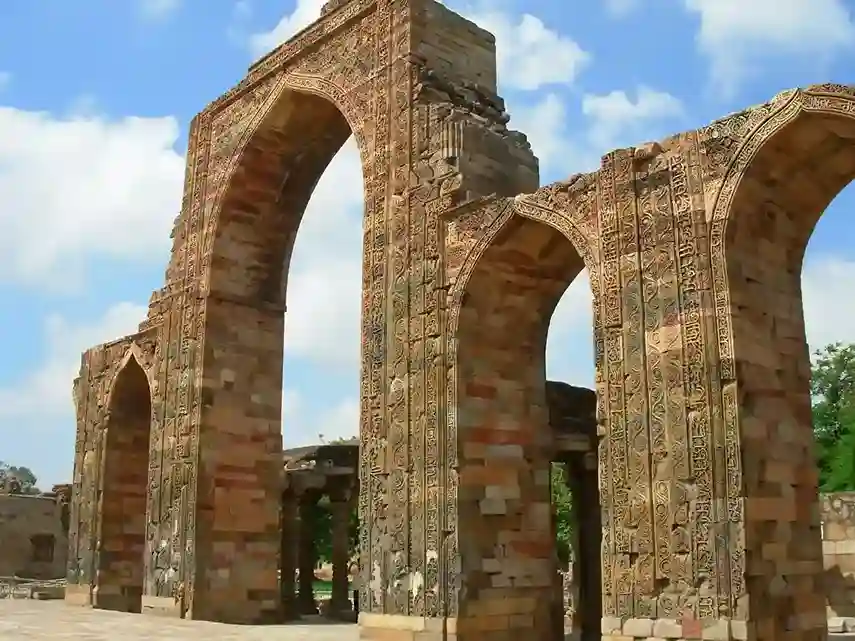
Things To Know Before Visiting Qutub Minar Delhi
- Check the opening hours of the Qutub Minar Delhi Complex.
- There is an entry fee to the Monument.
- Photography is allowed within the complex but tripods and commercial photography may require extra permits.
- Make sure to eat before visiting the Qutub Minar as there is no restaurant inside the complex and Outside foods are not allowed inside the complex.
- Carry a Water Bottle with you as it will be needed.
- Consider to taking a guided tours to learn more about the historical and architectural significance of the site.
Facilities At Qutub Minar Delhi
- Information Desk
- Drinking Water Facility
- Wheelchair Accessibility
Address Of Qutub Minar Delhi
The Qutub Minar is situated at Seth Sarai, Mehrauli, New Delhi, Delhi.
How To Reach Qutub Minar Delhi
The Qutub Minar is Located at Seth Sarai, Mehrauli, New Delhi, Delhi. It is at a distance of 25 KM from Gurgaon and can be reached in around 30-40 minutes from there. It is 12 Km away from Central Delhi and can be reached within 20 minutes. It is easily accessible from all parts of the city. You can reach here by the following modes of transportation:
By Metro: The Nearest Metro Station to Qutub Minar Delhi is Qutub Minar Metro Station on Yellow line which is 1.8 Km away from the Qutub Minar. From there, you can either book a cab/rickshaw or walk to the Museum..
By Bus: The Nearest Bus Stop to Qutub Minar is Qutub Minar Bus Stop which is just 200m away from the Qutub Minar. You can reach here by taking the bus no. 34, 334, 413, 427, 463, 493, 502, 505 or 534.
By Cab/Rickshaw: You can easily book a cab/Auto Rickshaw to the Qutub Minar.
By Personal Vehicle: You can easily come with your personal vehicle.
Parking Facility At Qutub Minar Delhi
Paid Parking Facility is available at the Qutub Minar Delhi.
Website Of Qutub Minar Delhi
The Official Website of Qutub Minar is Delhi Tourism
Contact Number Of Qutub Minar Delhi
You can contact Qutub Minar at 011 2469 8431
Places To Visit Near Qutub Minar Delhi
Top attractions to visit near Qutub Minar in Delhi:
- Mehrauli Archaeological Park (800 m)
- Kila Rai Pithora Fort Delhi (1.5 Km)
- Jahaz Mahal (2.1 Km)
- Sanjay Van (2.4 Km)
- The Garden of Five Senses (2.8 Km)
- Chattarpur Mandir (3.3 Km)
- Hauz K has Fo rt (4.8 Km)
- Tughlakabad Fort (8.1 Km)
- Shri Kalkaji Temple (8.9 Km)
- ISKCON Temple Delhi (9.4 Km)
- Lotus Temple Delhi (9.4 Km)
People Also Read
- Worlds Of Wonder Noida
- Waste To Wonder Park Delhi
- Lotus Temple Delhi
- Akshardham Temple Delhi
- EOD Adventure Park
- Atlantic Water World Delhi
- 5 Best Amusement Parks in Delhi NCR
- 25 Exciting Places to visit in Delhi
- Best Places to visit in Delhi For Free
- 5 Best Amusement Park in Delhi NCR
- 5 Hidden Places in Delhi NCR
- Cheap Places to visit in Delhi
Location Map Of Qutub Minar Delhi
What is the Entry Ticket of Qutub Minar?
The ticket price of Qutub Minar in Delhi is Rs Rs 35 for Indian Tourists and Rs 550 for foreigner.
Is Qutub Minar ticket Free today?
Yes, the ticket price of Qutub Minar is Free for Children Under 15 years of age.
Is Qutub Minar Open Today?
Qutub Minar is Open all 7 days of the week from 7 AM To 9 PM.
Is Mobile Phone allowed in Qutub Minar?
Yes, Mobile Phones are allowed inside the Qutub Minar.
What is the opening and closing time of Qutub Minar?
Qutub Minar opens very early in the morning at 7 AM and its closed around 9 PM.
How Much is a Child Ticket for Qutub Minar?
The ticket price for Children under 15 Years is Free. There are no tickets for them and their entry is totally free.
Which is the Best Time to Visit Qutub Minar Delhi?
The best time to visit Qutub Minar is during early mornings or in evening when the crowd is less and weather is also plesant.
Is Qutub Minar Safe for Couples?
Qutub Minar provides a safe and romantic atmosphere for couples to enjoy their time together. Couples can explore the architecture marvels and take the walk around the serene garden and enjoy each other’s company.
Which is the Nearest Metro Station to Qutub Minar in Delhi?
The Nearest Metro Station to Qutub Minar is Qutub Minar Metro Station on yellow line at a distance of 1.8 Km.
What is the Height/Lambai of Qutub Minar?
The Qutub Minar is 72.5 metres (238 ft) tall.
What are the various monuments in Qutub Minar Complex?
Qutub Minar Complex has various monuments including Iron Pillar, Alai Minar, Alai Darwaza, Tomb of Iltutmish, Imam Zamin’s Tomb, Alauddin Madarsa and Quwwat-ul-Islam Mosque.
Where is Qutub Minar?
Qutub Minar is situated in the Qutub Complex in the Mehrauli area of South Delhi.
What is the timings of Qutub Minar?
The Timings of Qutub Minar Delhi are from 7 AM to 9 PM every 7 days of the week.
Is there any ticket at Qutub Minar?
Yes, there is a ticket at Qutub Minar. The Qutub Minar Ticket Price for Indians is Rs 35 and for Foreign visitors is Rs 550.
Related Posts
Garden of five senses delhi: tickets price, photos, timings, location, nearest metro station, entry fees, closing time, history, architecture, address, how to reach & online ticket booking 2024.
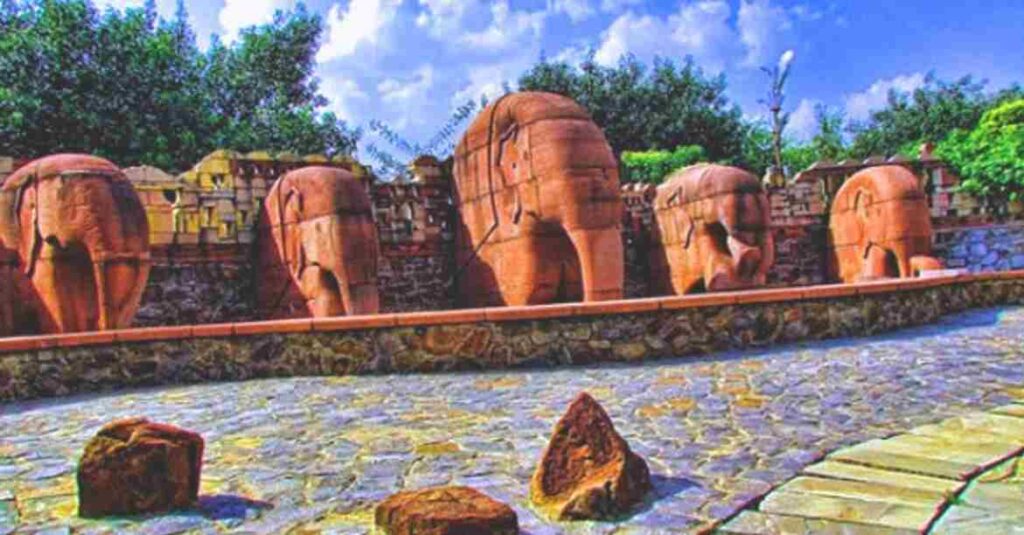
Vegas Mall Dwarka: Timings, Restaurants, Food Court, Photos, Stores, Gaming Zones, Opening Time, Images, Nearest Metro Station, Closing Time, Contact Number, Location & Address 2024

Just Chill Water Park Delhi: Ticket Prices, Rides, Timings, Images, Entry Fees, Online Ticket Booking, Contact Number, Location, Nearest Metro Station, Photos, Address & Reviews 2024

National Rail Museum Delhi: Entry Fees, Timings, History, Images, Location, Nearest metro Station, Foods, Contact Number, Online Ticket, Photos & Reviews 2024
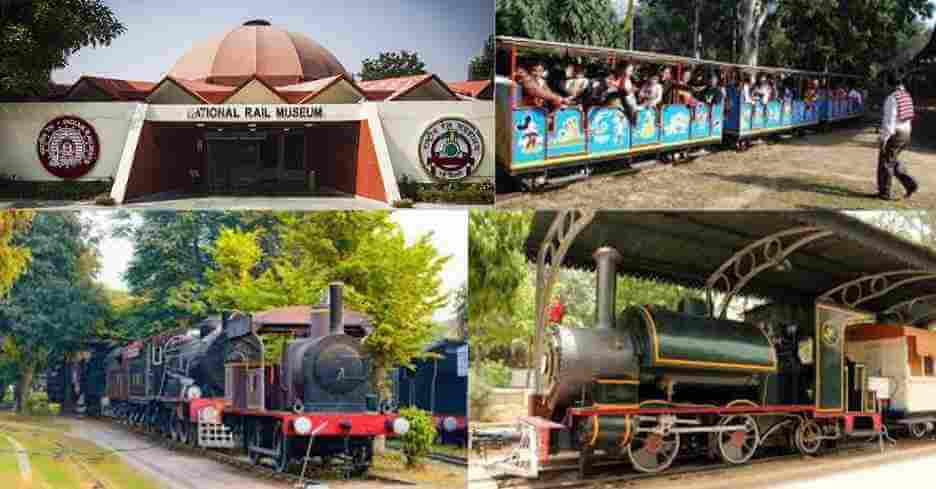
Sunder Nursery Delhi: Tickets Price, Timings, Photos, Nearest Metro Station, Address, Entry Fee, Location, Online Ticket Booking, Images, Maps & Closing Time 2024
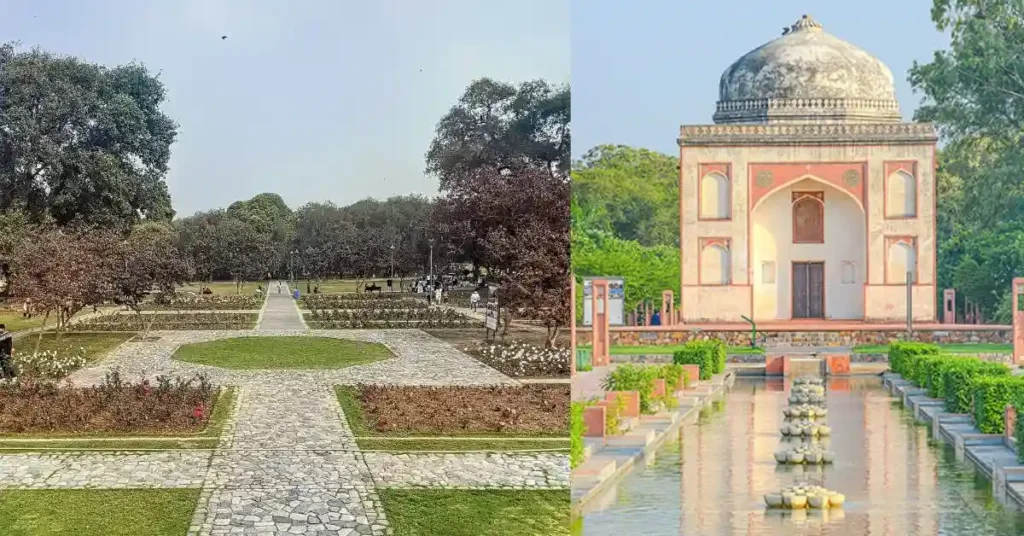
- 1 (888) 414-6804 (USA & Canada)
- +91-99274-65808
- [email protected]
India is now open for International Travelers
Guidelines for international travelers (updated feb., 2023).
- Effective February 2023, mandatory self-declaration form on Air Suvidha for international arriving passengers has been discontinued. So, no self-declaration needs to be completed by international tourists from any country arriving in India.
- RT-PCR Covid Test NOT required for traveling in India, Nepal, Sri Lanka and Bhutan
- To Travel to India Covid Vaccination also NOT required.
- The use of masks on flights is mandatory. Masks are not required anywhere else in India

Qutub Minar Complex – The First Muslim Monument on Indian Soil
If you ask most human beings, they will tell you they want to live forever. This is true, especially of kings who have a deep desire to be immortal. They don’t ever want to die. Hence, you find that throughout history, many of the monuments were designed and built in such a way as to immortalize rulers and reflect their power
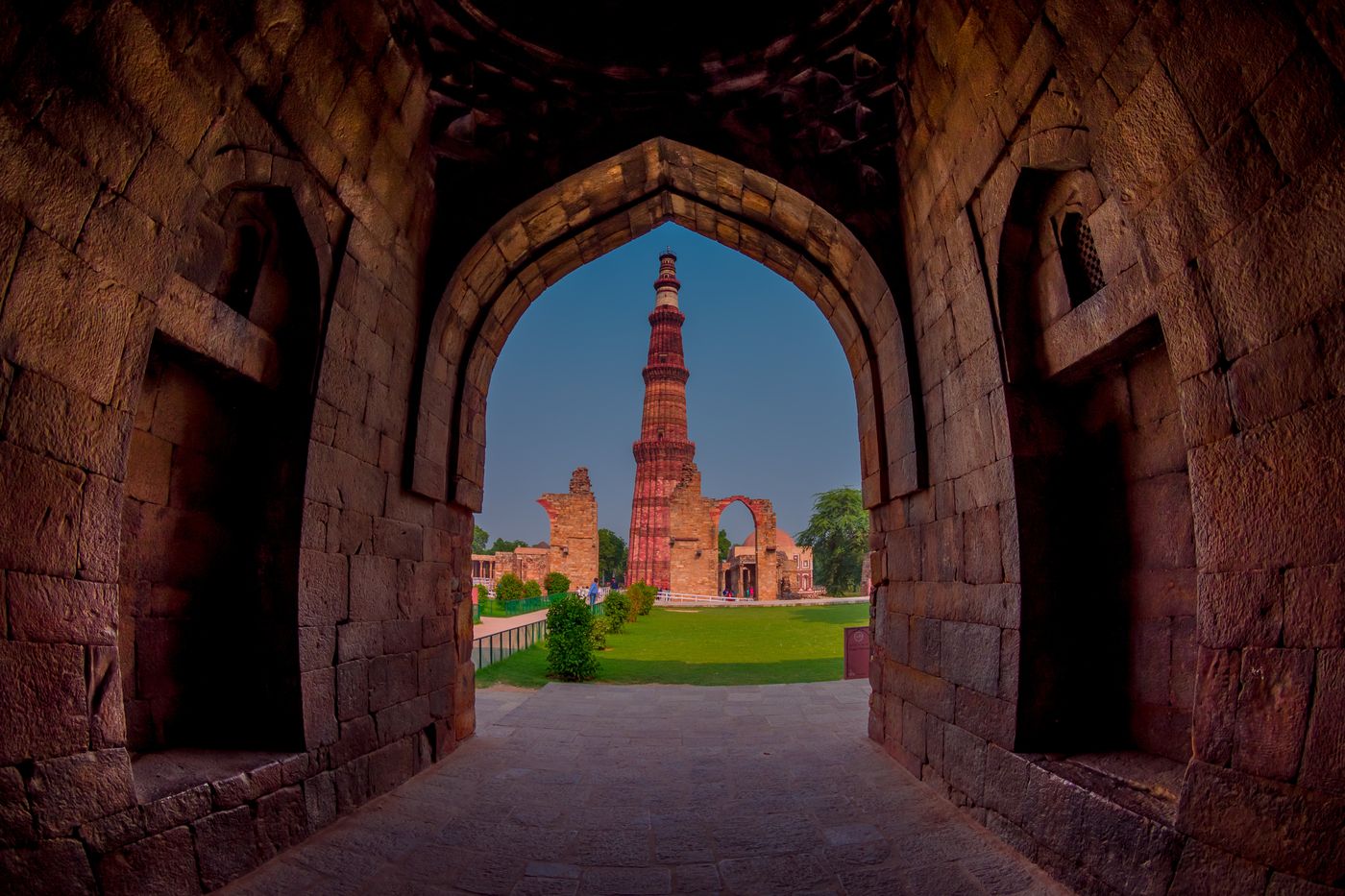
Qutub Minar Complex
TOWER OF TRIUMPH Rulers of Delhi The Mamluk sultans The Khilji rulers The Tughlaq Sultans The Lodis Aspects of the Minar Quwwat-ul-lslam Masjid (Mosque) FUSION OF STYLES Sandstone screen Alai Darwaza A Builder with Visions of Grandeur Imam Zamin’s Tomb LATTICED SCREENS Alauddin’s Madrasa and Tomb Iltutmish’s Tomb Alai Minar Tourist information
TOWER OF TRIUMPH
If you ask most human beings, they will tell you they want to live forever. This is true, especially of kings who have a deep desire to be immortal. They don’t ever want to die. Hence, you find that throughout history, many of the monuments were designed and built in such a way as to immortalize rulers and reflect their power.The Qutb Minar is no different. This five-storey building was built with beautiful marble and sandstone. It extends to the skies as a declaration of sovereignty. This magnificent structure was built to symbolize many conquests and also to commemorate the formation of the Delhi Sultanate in India.
The Qutb Minar stands tall over the city of Delhi and is the main monument of the Qutb complex, a UNESCO World Heritage Site. The historical monuments that make up this complex were constructed from as early as the late 12th century onwards and represent some of the earliest Indo-Islamic architecture in the world. The monuments were built by the Delhi Sultanate rulers. They were built over the city of Qila Rai Pithora, which was established by the Chauhan Rajput clan. Qila Rai Pithora is the first of the seven distinguished cities that made up Delhi. Mehrauli, Firozabad, Tughlaqabad, Siri, Shahjahanabad, and Jahanpanah are the other six.
The Chauhans was an Indian dynasty that ruled sections of what we now call Rajasthan between the 7th and 12th century. However, they were forced to surrender these territories to Muhammad of Ghur in 1193. History records that Muhammad’s general, Qutbuddin Aibak became the first sultan of Delhi. He was the one who started to build the Qutb Minar. Note that the meaning of the word “qutb” is “axis,” and the word “minar” means “tower”). Although Qutbuddin Aibak has been credited with constructing this tower, the facts show that no single ruler can be given the attribution. After finishing one storey, Aibak died. Subsequently, other kings who ruled over the years completed the structure. The neighboring area that surrounds the Minar is called the Mehrauli Archaeological Park . It is rich in history and has several outstanding monuments all over its terrain.
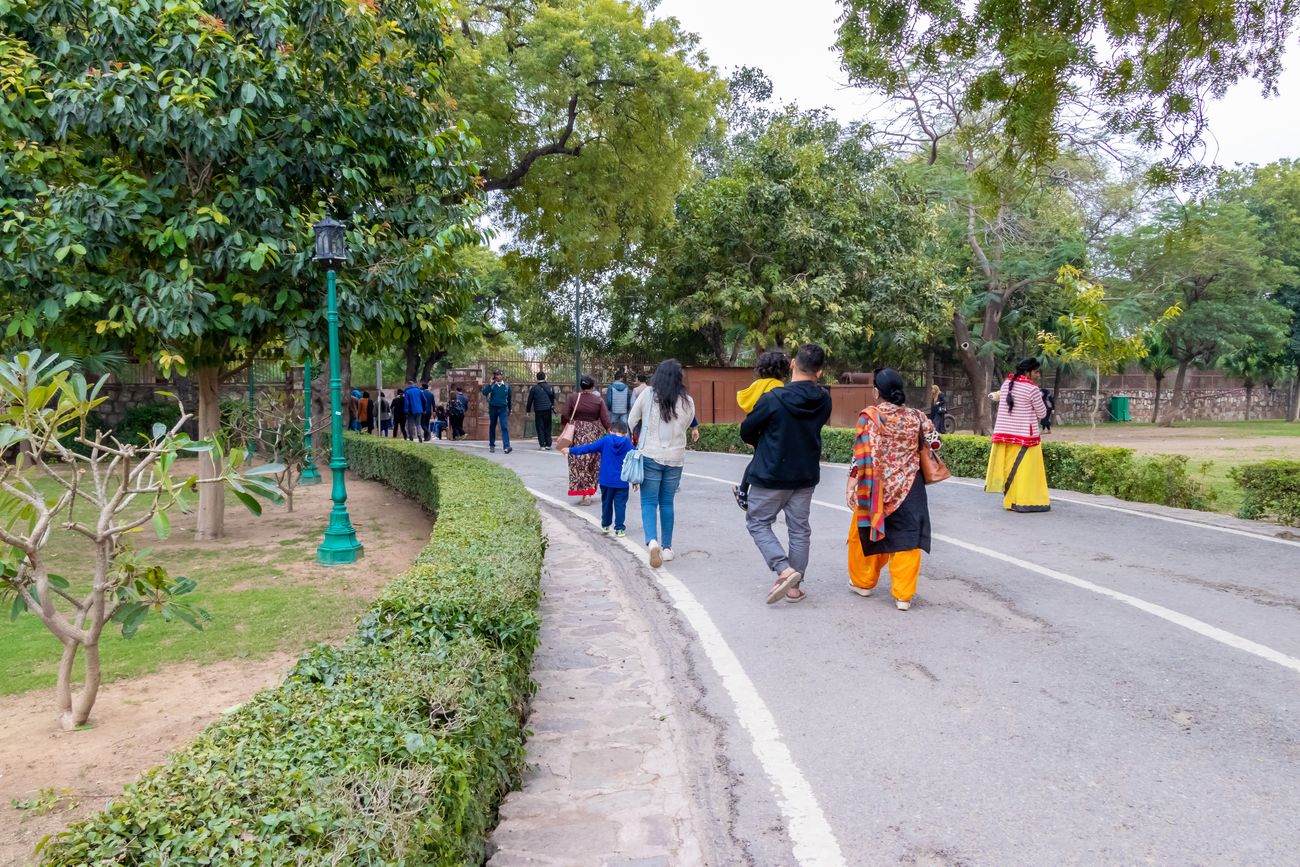
Tourists visiting the Qutub complex in Delhi, India © Singh Virender
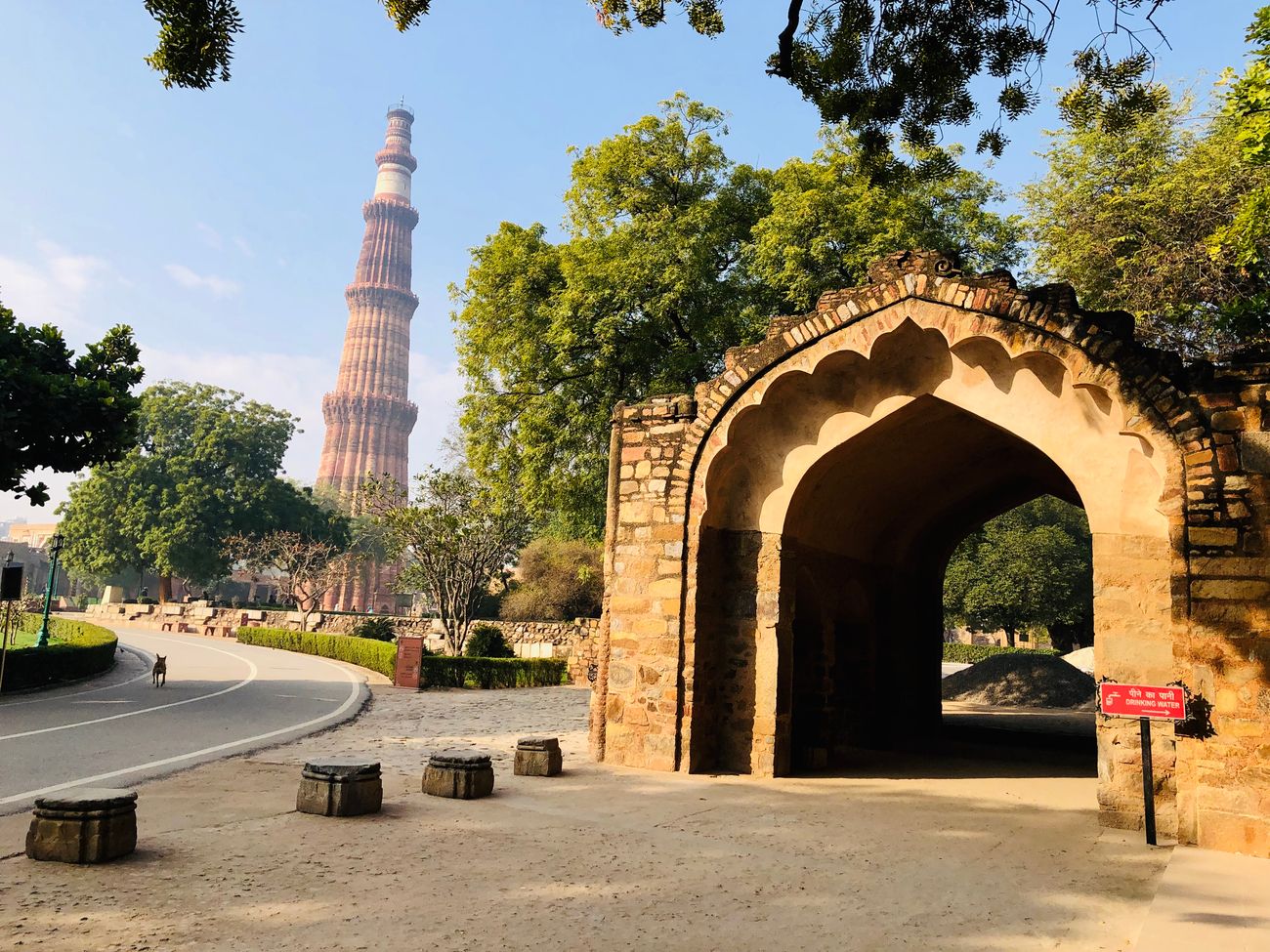
Entrance to Qutub Minar, the ancient minaret which forms part of the Qutub Complex. In 1993 it was declared a World Heritage Site due to its historical significance © Azhar_khan
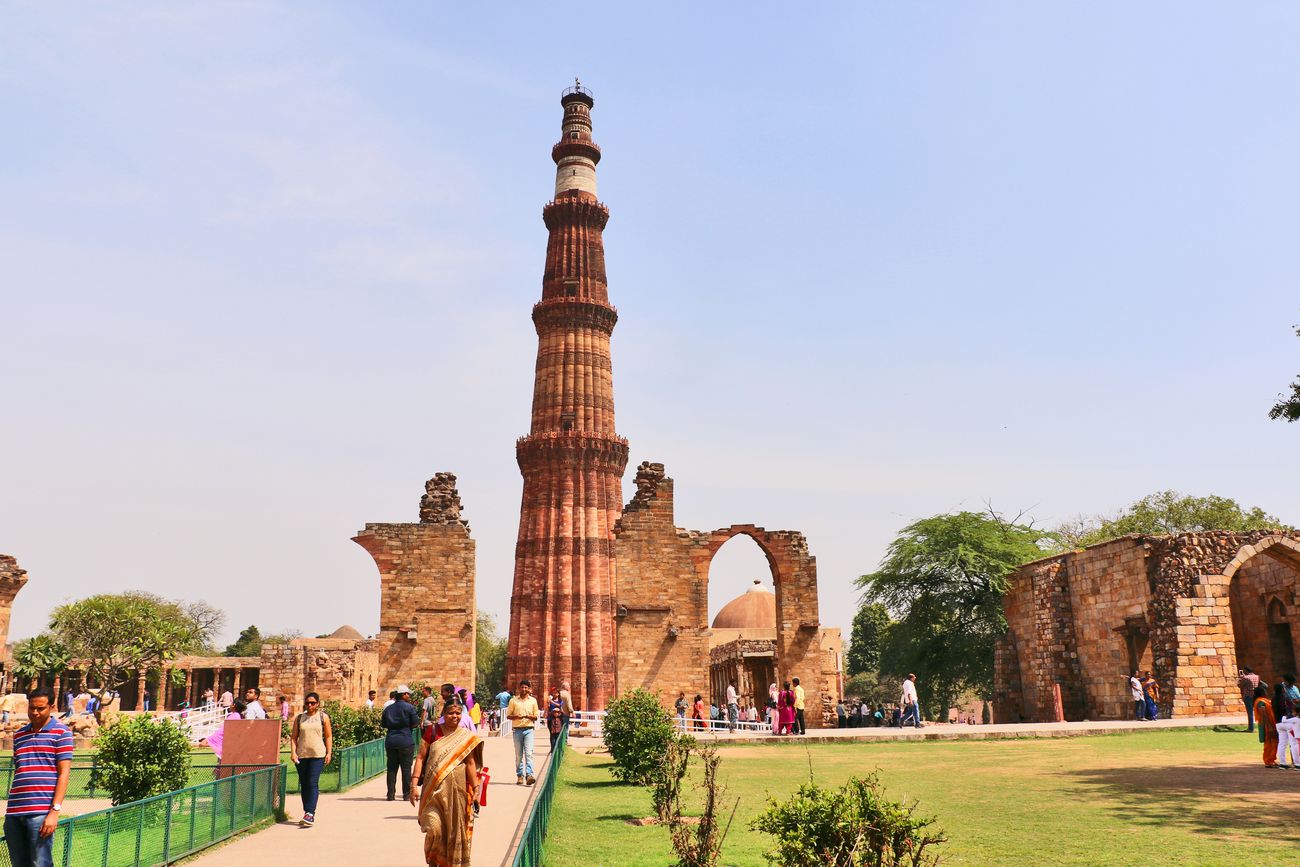
MEDIEVAL MONUMENTS: 12th century The Qutb Complex is located in the south of Delhi, which is the capital city of India. The Qutub minaret consists of five stories and was built in red and grey sandstone. It reaches an impressive height of 72.5m/238ft, the height of a 20 story modern building © mdsharma
Rulers of Delhi
The establishment of the Delhi Sultanate in 1206 was the beginning of a new epoch in the history of India. For more than two hundred years, the Mamluk, once known as the slave kings, the Sayyid, Khilji, Lodi, Tughlaq, and sultans successively ruled India. Their rulership transformed India’s cultural and political environment significantly. After the end of their reign, the great Mughal empire was established. However, in the early 18th century, this empire tumbled quickly. Consequently, European powers were given easy control of the country. The British became a strong political force to reckon with, and in 1857 they deposed the last Mughal emperor. Below are some of the significant dates in the history of the Qutb complex.
1206-1290 Mamluk sultans 1206-1210 Qutbuddin Aibak 1211-1236 Shamsuddin Iltutmish 1266-1286 Ghiyasuddin Balban 1290-1321 Khilji sultans 1296-1316 Alauddin Khilji 1321 -1414 Tughlaq sultans 1351-1388 Firoz Shah Tughluq 1414-1 451 Sayyid sultans 1451- 1526 Lodi sultans 1488-1517 Sikander Lodi 1526-1857 The Mughal emperors 1526-1530 Zahiruddin Babur 1530-1556 Nasiruddin Humayun 1556-1605 Mughal Emperor Jalaluddin Akbar 1605-1717 The other Great Mughals 1836-1857 The Last Mughal Bahadur Shah Zafar
Looking Back in Time
Delhi’s strategic location was an attraction to those from Central Asia who wanted to invade. Muhammad of Ghur (now central Afghanistan), invaded north India and took control of Delhi. His conquest allowed his general, Qutbuddin Aibak, to institute his sovereignty in the city. The Delhi Sultanate lasted until the early 16th century and developed the region significantly. Again, in 1526, yet another Central Asian invaded Delhi. He was Zahiruddin Babur whoBabur who took control of Delhi and facilitated the growth and reign of the Mughal empire for over 200 years in the subcontinent.
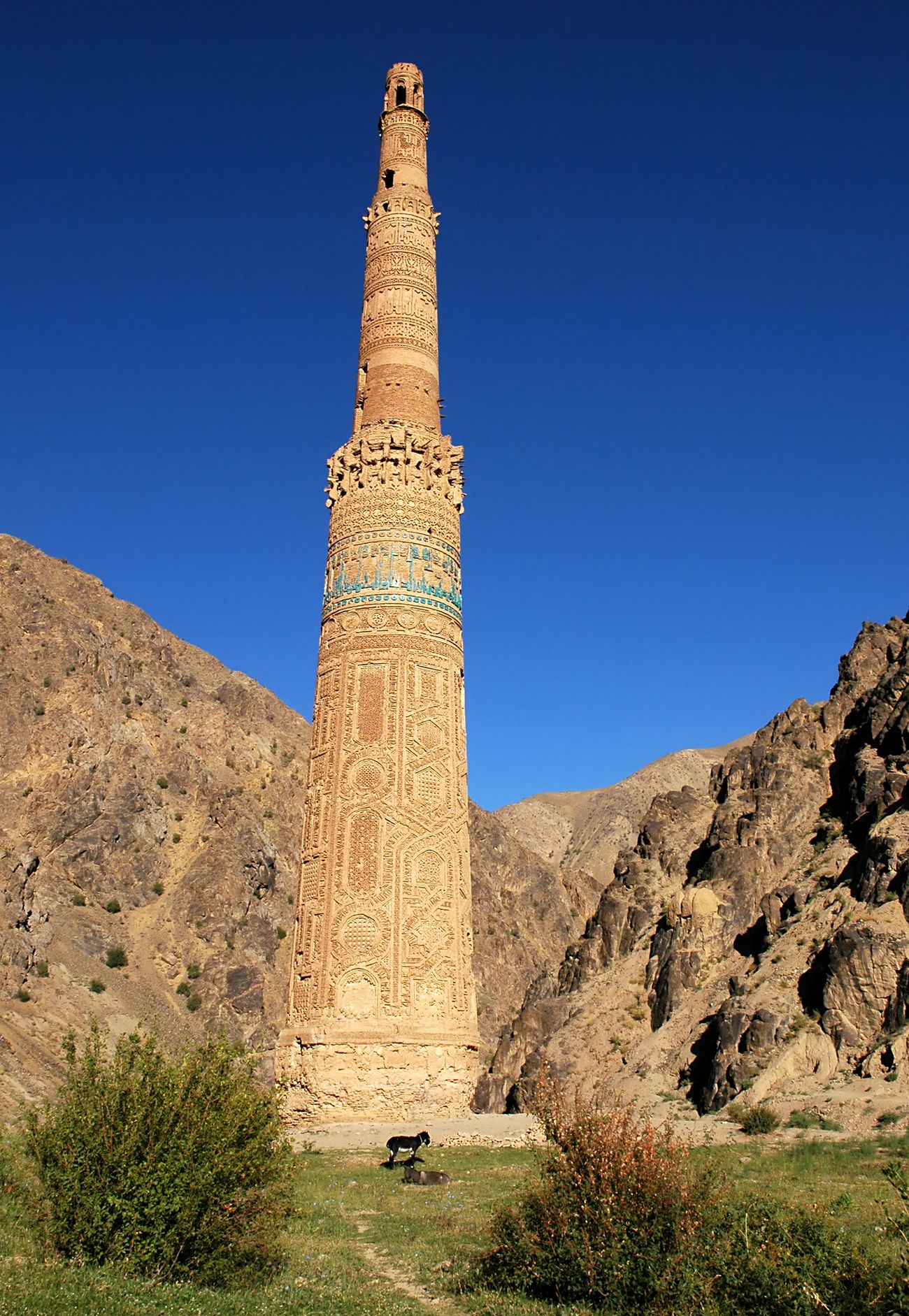
MINARET OF JAM: Inspiration to build the Qutb Minar came from a 65m (214ft) high minaret in the distant valley of Jam in western Afghanistan. The sultan of Ghur, Ghiyasuddin (brother of Muhammad of Ghur) erected this minaret some time between 1193 and 1194 © Jono Photography
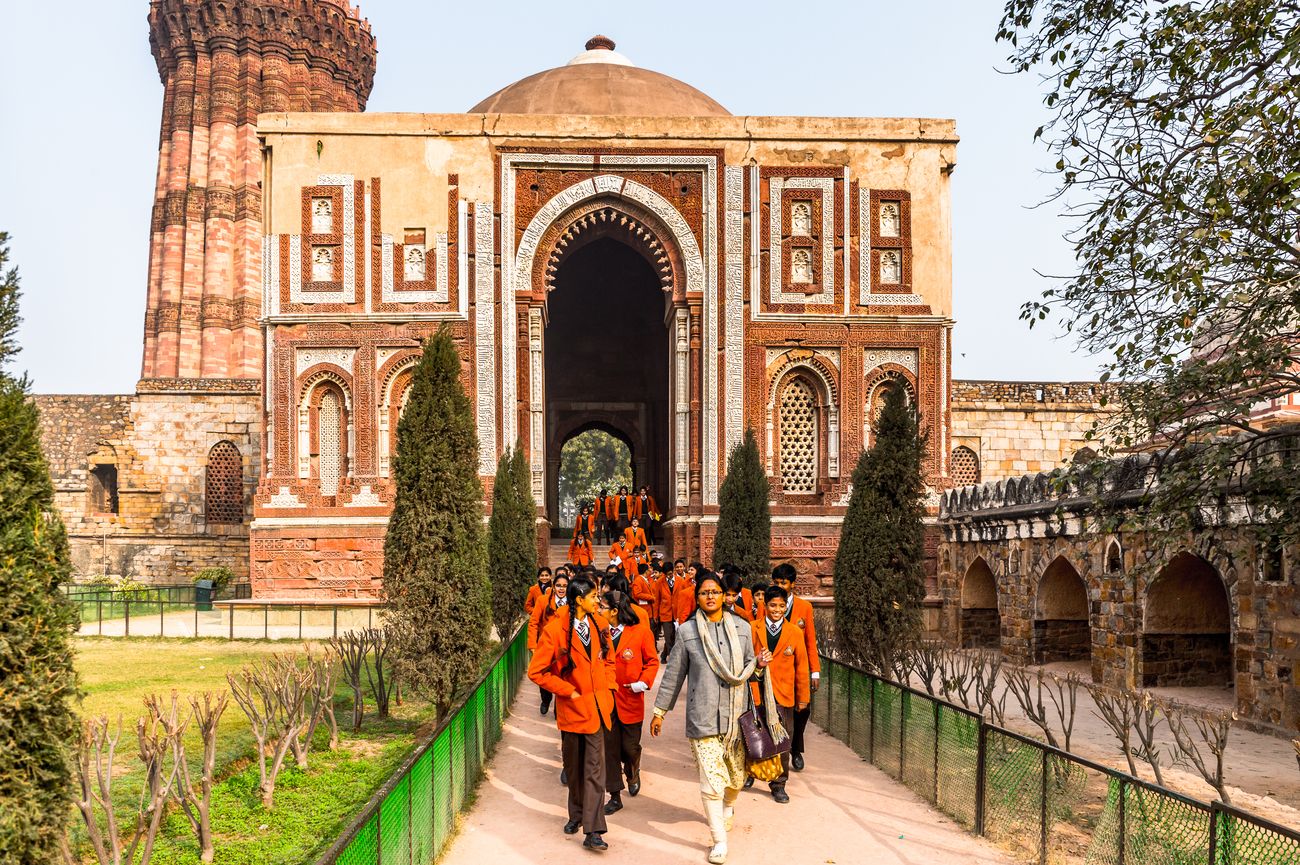
School children in their orange color uniform leaving the Qutum minar complex after visiting along with their teacher © Anton_Ivanov
The Mamluk sultans
The Mamluk sultans were the first Muslim rulers of India. They ruled the country for 84 years. After the death of Muhammad of Ghur in 1206, a former slave, Qutbuddin Aibak, remained in Delhi; he was then enthroned as the sultan. Of note, Qutbuddin Aibak was not the only slave to have been crowned as a sultan throughout history. His son-in-law, Shamsuddin Iltutmish and Ghiyasuddin Balban were also slaves before they were enthroned. Both of these men were Il-bari Turks. You will find their tombs in the Qutb complex. Iltutmish, the third ruler of the Mamluk dynasty of Delhi established the Delhi Sultanate to Sind in the west and Bengal in the east. The eighth sultan, Balban, took absolute control and ruled with an iron fist. He was very successful in repressing uprisings and securing a peaceful kingdom. With the expansion of their empire, the sultans built magnificent monuments around the Qutb Minar to display their might.
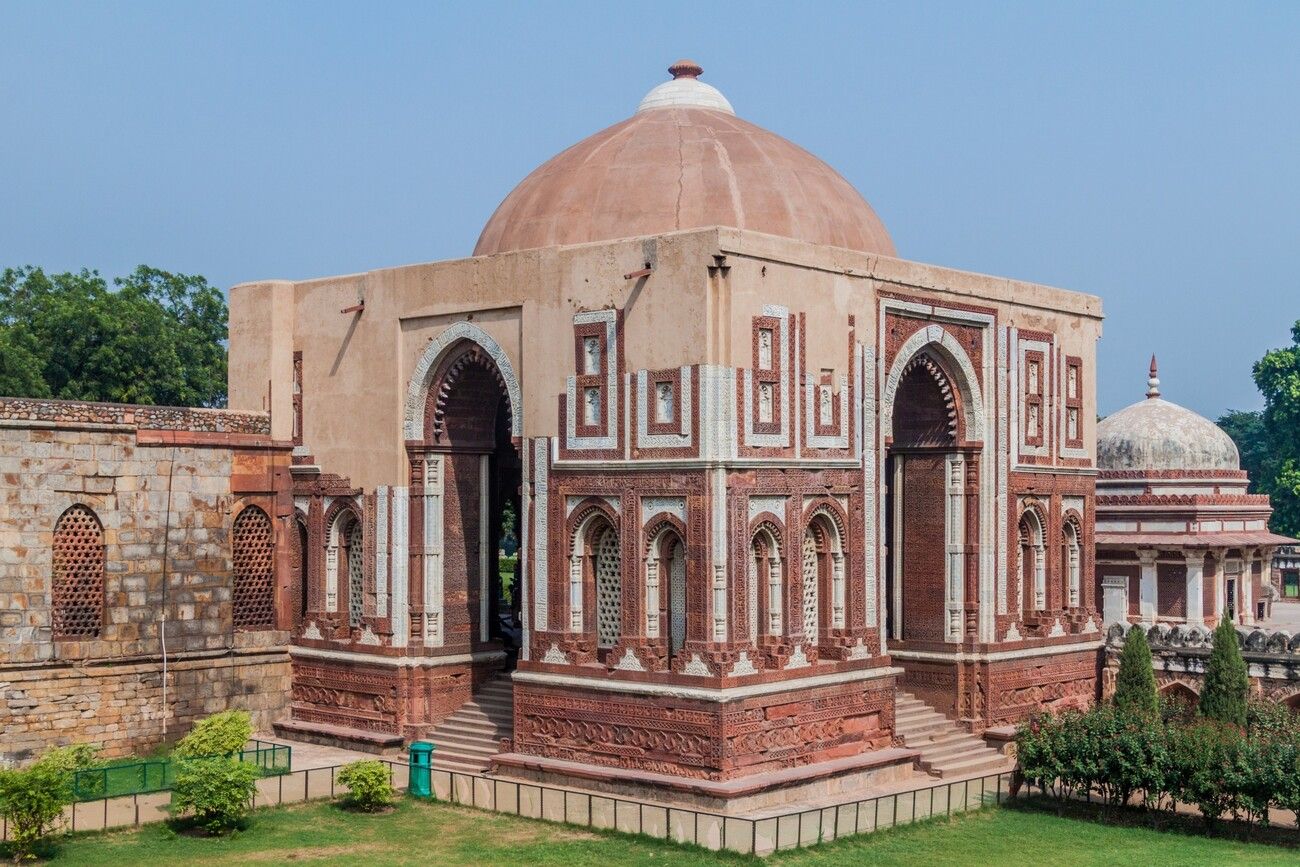
The Khilji rulers
Jalaluddin Khilji was a member of an Afghan tribe. He seized power from Balban’s successors and set up the Khilji dynasty. The Khilji sultan who came after him was his nephew Alauddin Khilji. His ambition was to take control of all India. In pursuit of that goal, he successfully raided and conquered the wealthy kingdoms south of Delhi between the years 1299 and 1305. These victories allowed him to expand the sultanate. He was not only ambitious in his political goals, but he also had a big vision for the architectural landscape of India. This is seen in his elaborate design of the Alai Minar, which was created to compete against the Qutb Minar. However, it remains unfinished. There is also the outstanding Alai Darwaza, and the large extensions on the Quwwat- Il-Islam Masjid, which Aibak built.
The Tughlaq Sultans
Ghiyasuddin Tughlaq was the first Tughlaq sultan. He set up his capital at Tughlaqabad, the third of Delhi’s seven cities. Although the Tughluq dynasty had 11 rulers during its era, only those from the first three generations showed any major interest in architecture.
Firoz Shah Tughlaq, an inventive builder in those times built an additional fourth and fifth storey onto the Qutb Minar. He also established his own city called Firozabad located in the north of Delhi, along the banks of the Yamuna River. In addition, he used his creativity to build many rest houses and schools (madrasas). Hauz Khas in Delhi houses a madrasa and an L-shaped mosque that were both built by him.
Very little development was done to the Qutb complex by the Sayyids. However, Sikander Lodi of the Lodi dynasty repaired and restored the Minar. The octagonal tomb of Sikander Lodi is located in the Lodi Garden, Delhi.
Influences from Afar
The religious, architectural, and other aspects of northern India changed as the new inhabitants established their own religious and social ideas, which they brought with them. They introduced several new architectural designs and techniques. The local craftsmen were not left out because they too were able to use their native skills and creativity while they worked on the monuments the new rulers wanted built.
At one stage, the Hindu or Jain temples were raided and demolished. Some of the material from these temples were used to construct new buildings; for example, the Quwwat-ul-lslam Masjid in the Qutb complex. However, as time went by, this practice ceased and the materials to build these monuments were procured from neighboring areas. The Central Asian rulers were credited with bringing a new architectural feature called the true or keystone arch as seen below. These arches were built with wedge- shaped stone blocks. Before the introduction of this new design, the local craftsmen used corbelled or “false” arches.
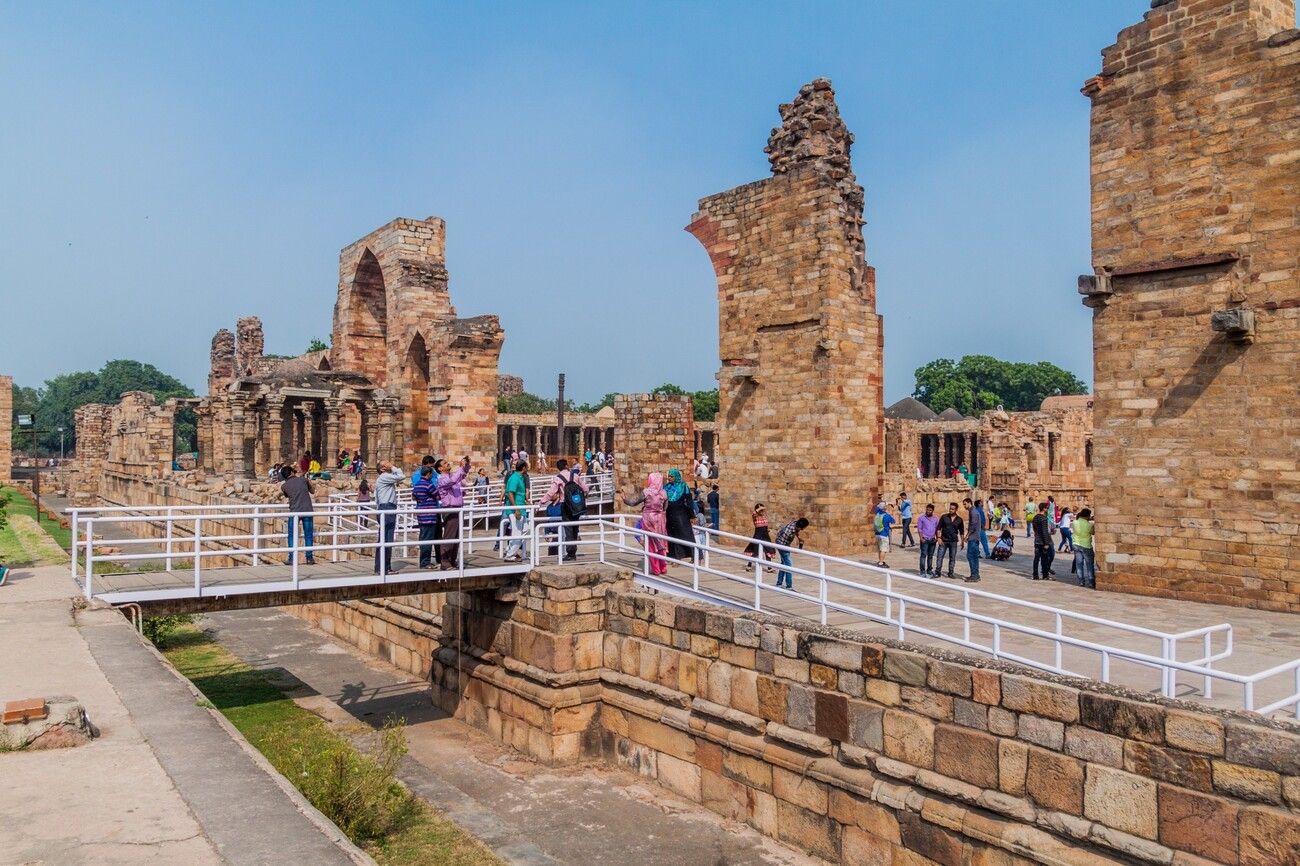
Two Types Of of Arches: To build the corbelled arch, workmen would lay the stones in a horizontal position and then create rounded edges at the top. No extra weight could be supported by these structures. You can see this when you take a look at the Quwwatthe Quwwat-ul-lslam Masjid screen. The first time the “true” arch was built was on the tomb of Balban, which is located far away from the complex. In Pic: The ruins of the Quwwat-ul-lslam Mosque in Qutub Minar complex © Matyas Rehak
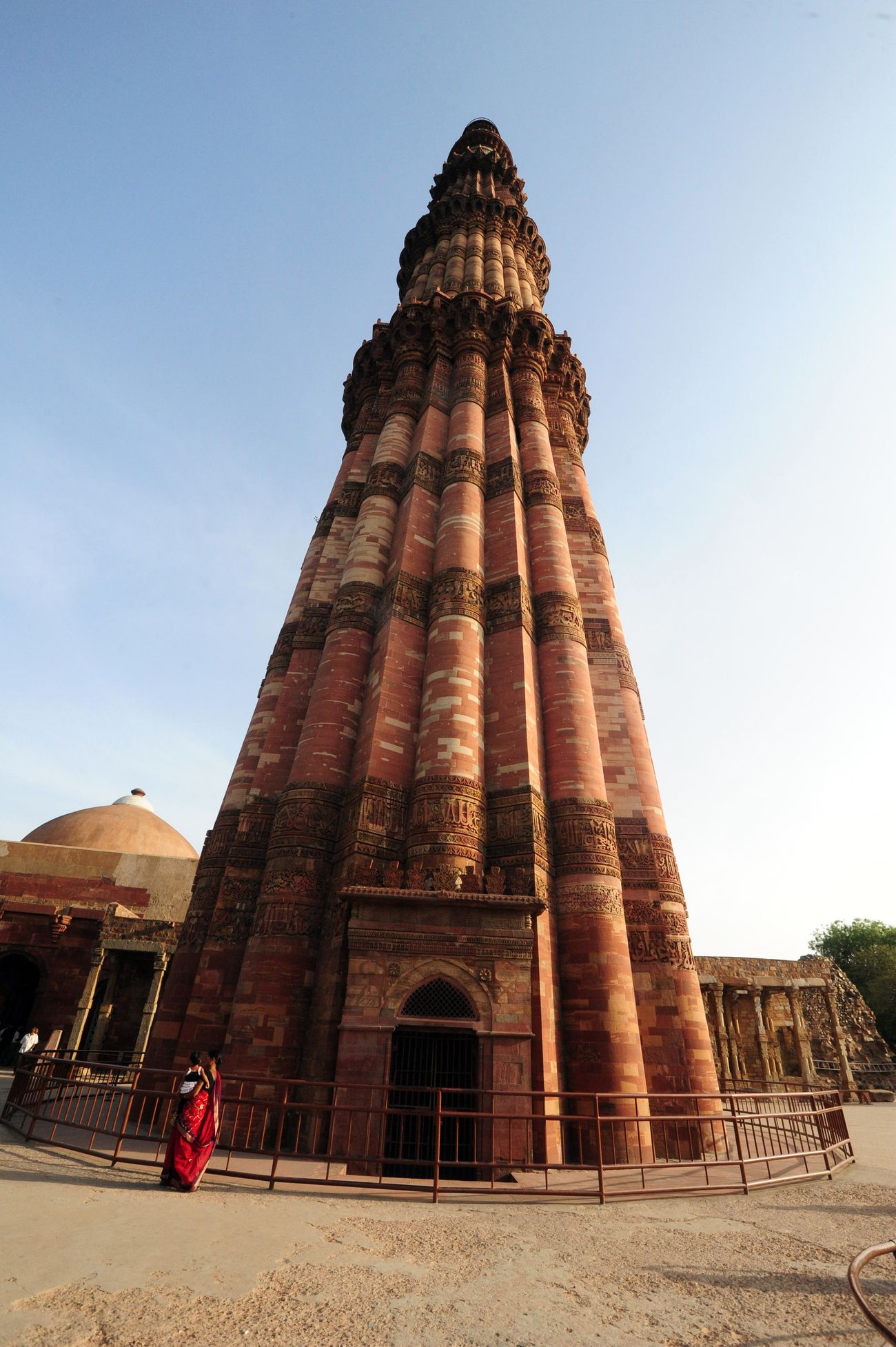
ARCHED ENTRANCE: The gate which is now closed takes you to a unique spiral staircase, which has some 379 steps to the top. Due to the high incidence of suicide attempts, the Archaeological Survey of India installed nets around the structure but on Dec 4, 1981 entering the minaret was banned completely. This was decided after an unfortunate incident the same day when between 300 and 400 visitors found themselves inside the tower during a power failure. Many more people were pushing from the outside to get in. A stampede occurred after someone, in the confusion and mayhem shouted that the minaret was toppling over. Chaos reigned on the narrow inside staircase and many people, including children lost their footing, fell down and were trampled. The weight of the people blocked the door from the inside, preventing the rescue operation from getting underway. Delhi’s Fire Services only managed to break into the tower after a considerate time and by then many have suffocated or died of their injuries. After this tragedy the government immediately placed a ban on anyone entering the monument and for the last 42 years it has been closed. However, the site remains an iconic beacon in the city © halitomer
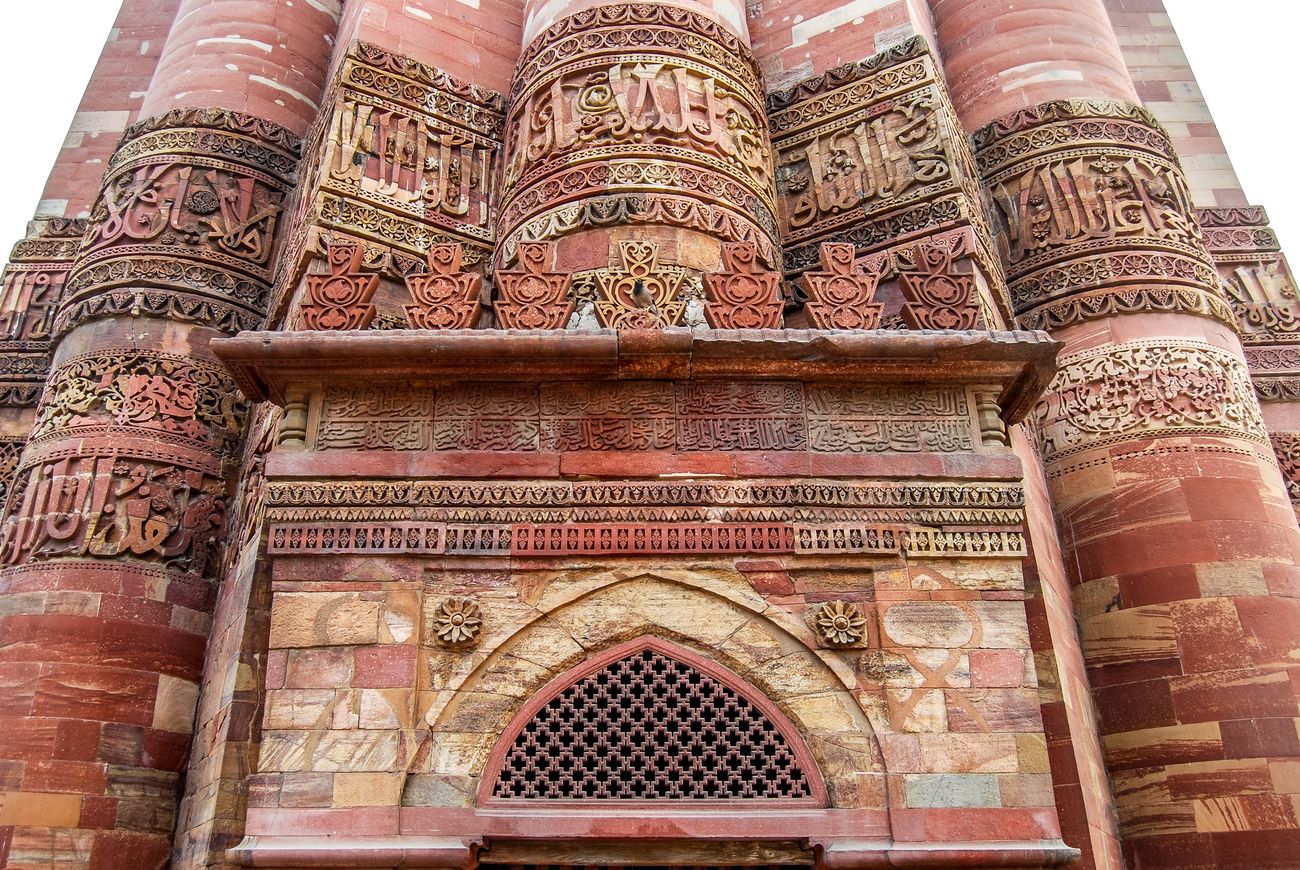
CALLIGRAPHIC BANDS AND FLUTINGS: The Minar’s tapering shaft is bordered by beautiful decorative bands with intricately ingrained records of history or Quran verses in the Naskh or the calligraphy “copying” style. The first three storeys have varying designs. The first storey has interchanged, rounded grooves; the second storey only has rounded ones, while the third storey has only angular flutings or grooves © Faper9.
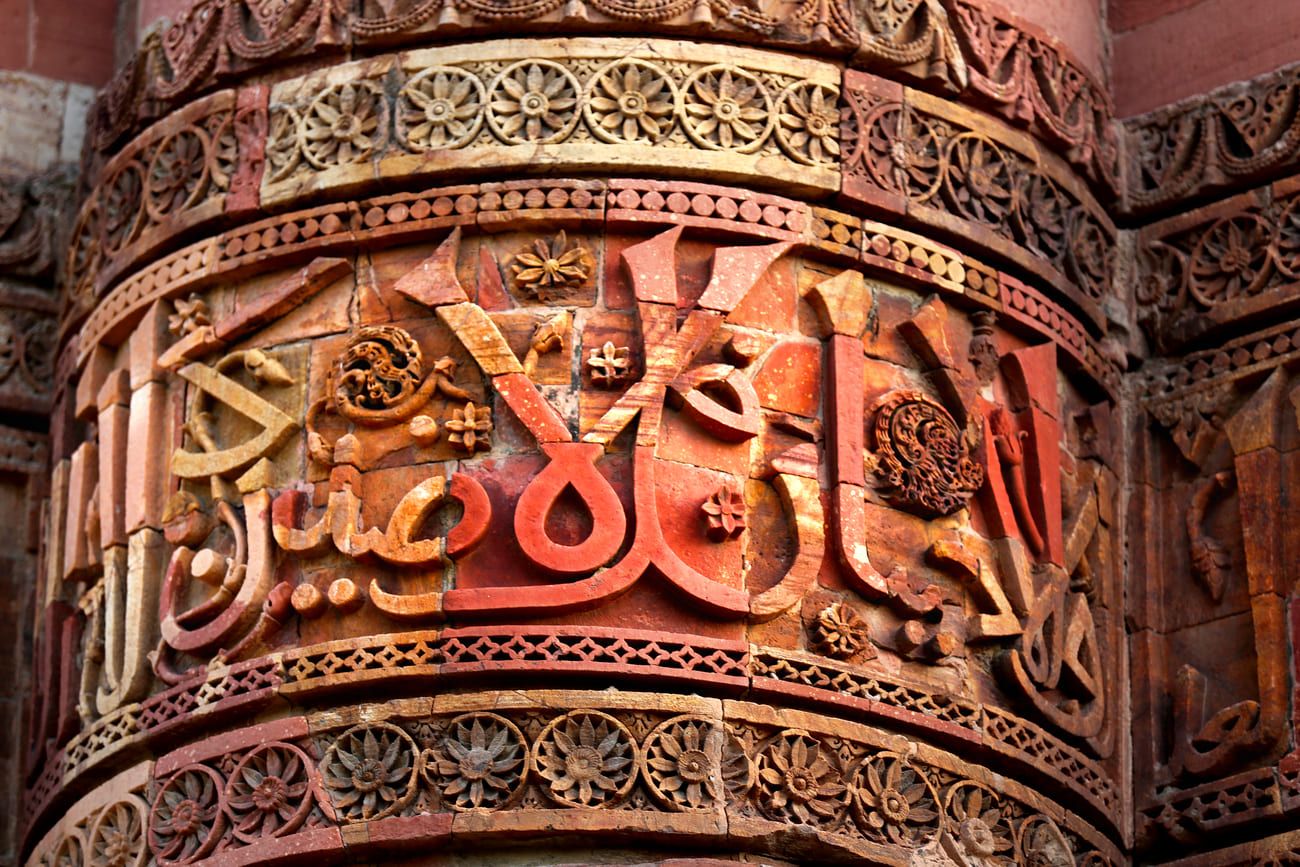
Closeup of the wall decoration on the Qutub Minar. The Quran verses are mingled with Hindu decorative elements of lotus leaves © rvimages / GETTY IMAGES
Aspects of the Minar
The Qutb Minar stands Minar stands a towering 72.5m (238ft) tall. Without doubt, it has to be one of the most perfect minarets to have ever been built in all history. Certainly, it is the tallest one in India. The width at the foundation is 14.4m (47ft), and it becomes narrower upwards to 2.75m (9ft). Thrice it was damaged by lightning: 1326, 1368, and 1503. After these acts of nature, the builders used iron clamps to fortify the stone joints, as well as to be lightning conductors. An interesting observation is that the Minar Tower leans approximately 0.6m (2ft) towards the southwest; however, it is not seen as a threat.
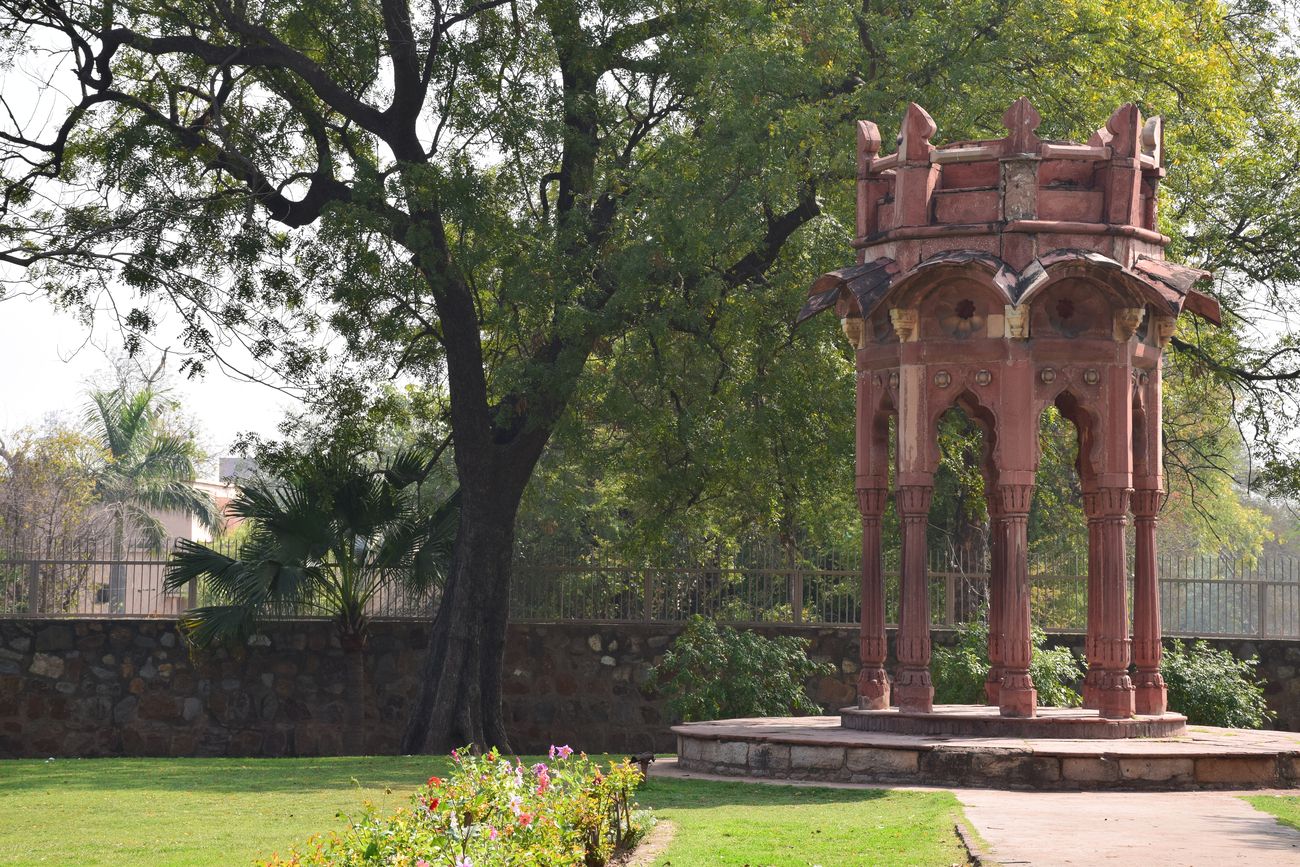
SMITH’S FOLLY: In 1829, after the original cupola was damaged by an earthquake, Major Robert Smith of the Royal Engineers built this chhatri (kiosk) on top of the Minar. However, sometime later, it was removed and given the name “Smith’s Folly.” It is Iocated to the left of the main entry path © Almazoff.
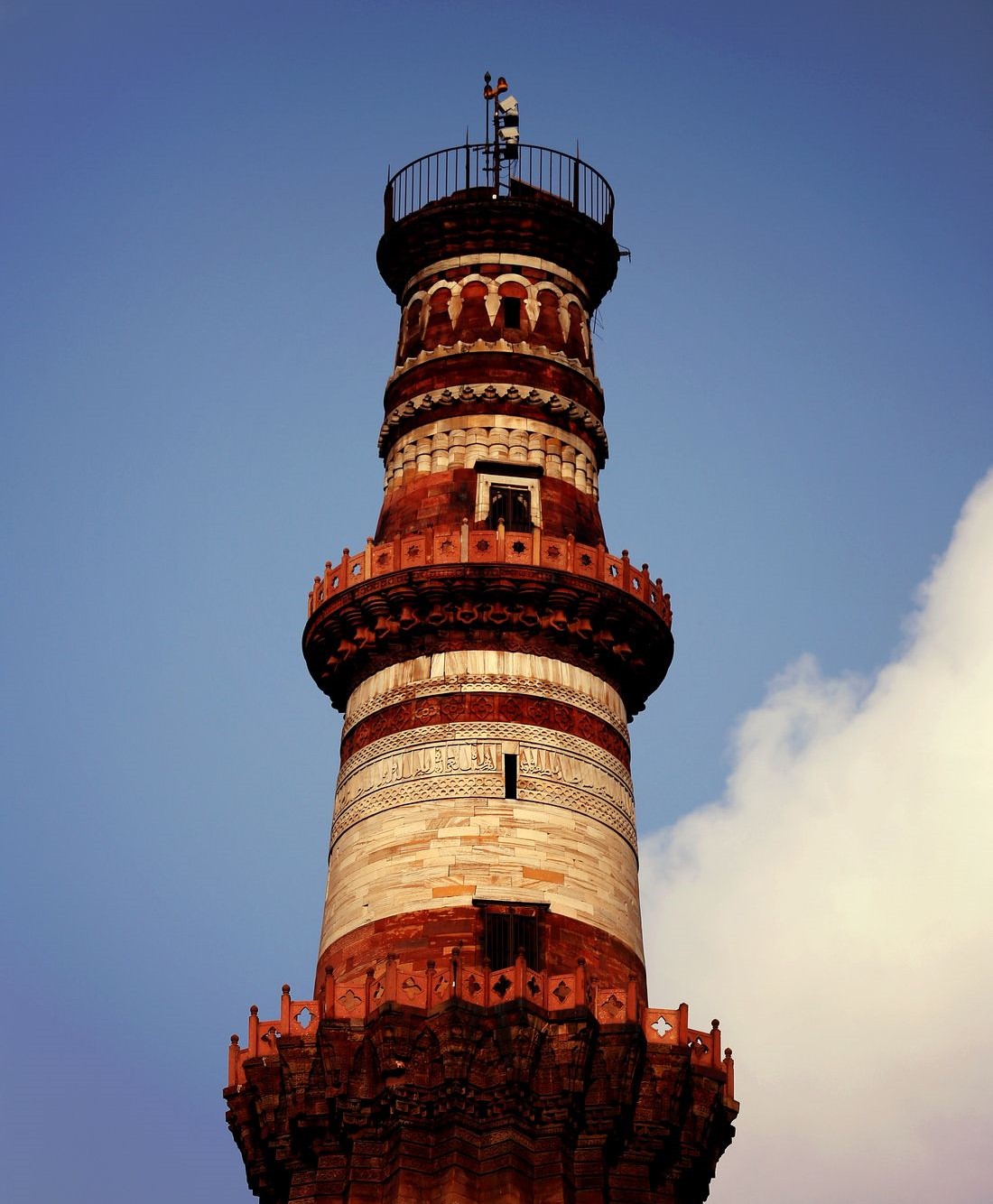
LATER ADDITIONS: It doesn’t take long to notice the pronounced difference in the architectural style of the two top storeys that were built by Firoz Shah Tughlaq. This is clearly seen in his free use of marble. The marble bands have intricate carvings done in fine calligraphy
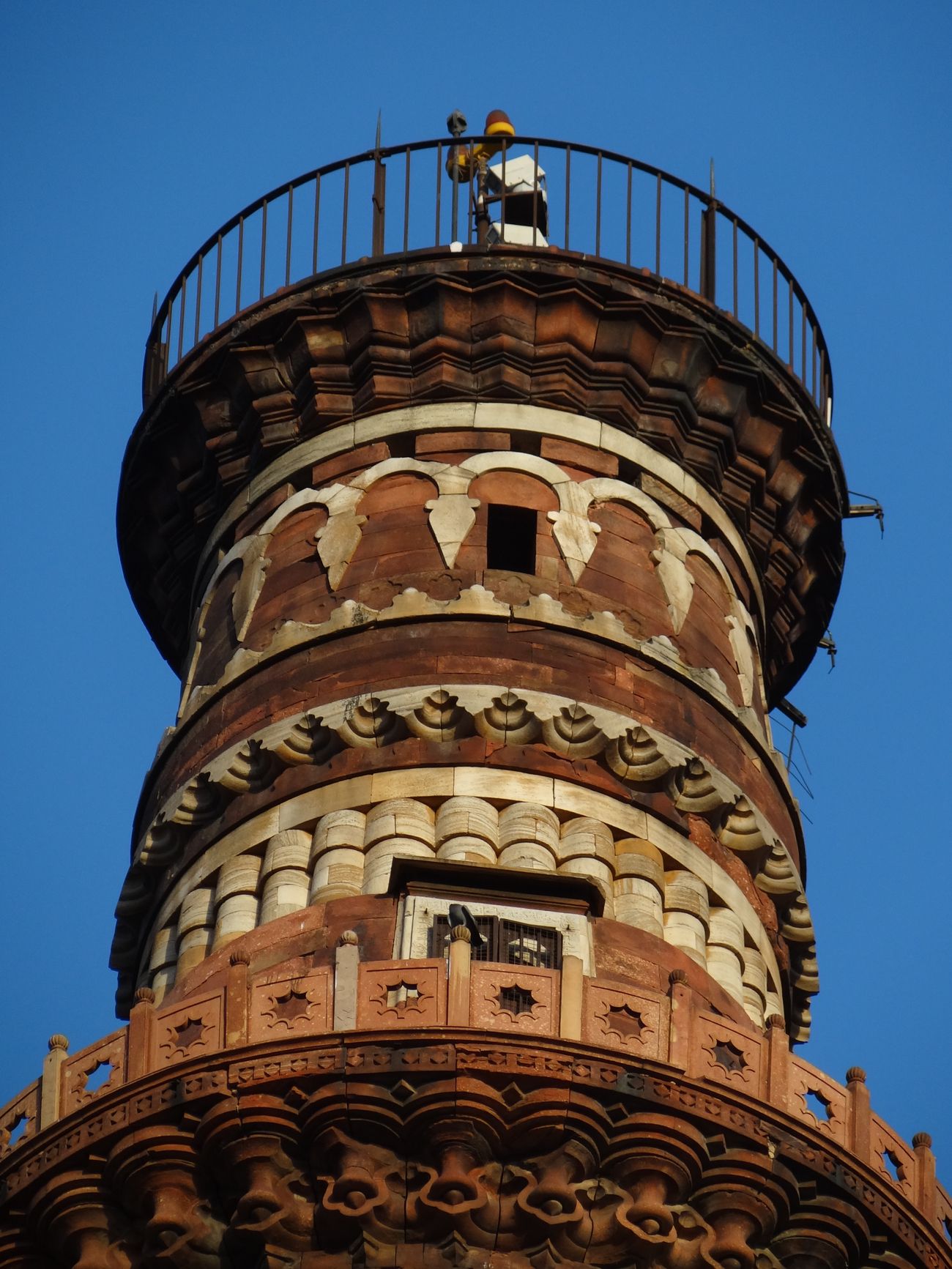
A closer view shows the exquisite detail of the top story and balcony of the Qutub Minar, New Delhi © Incredible_backgrounds
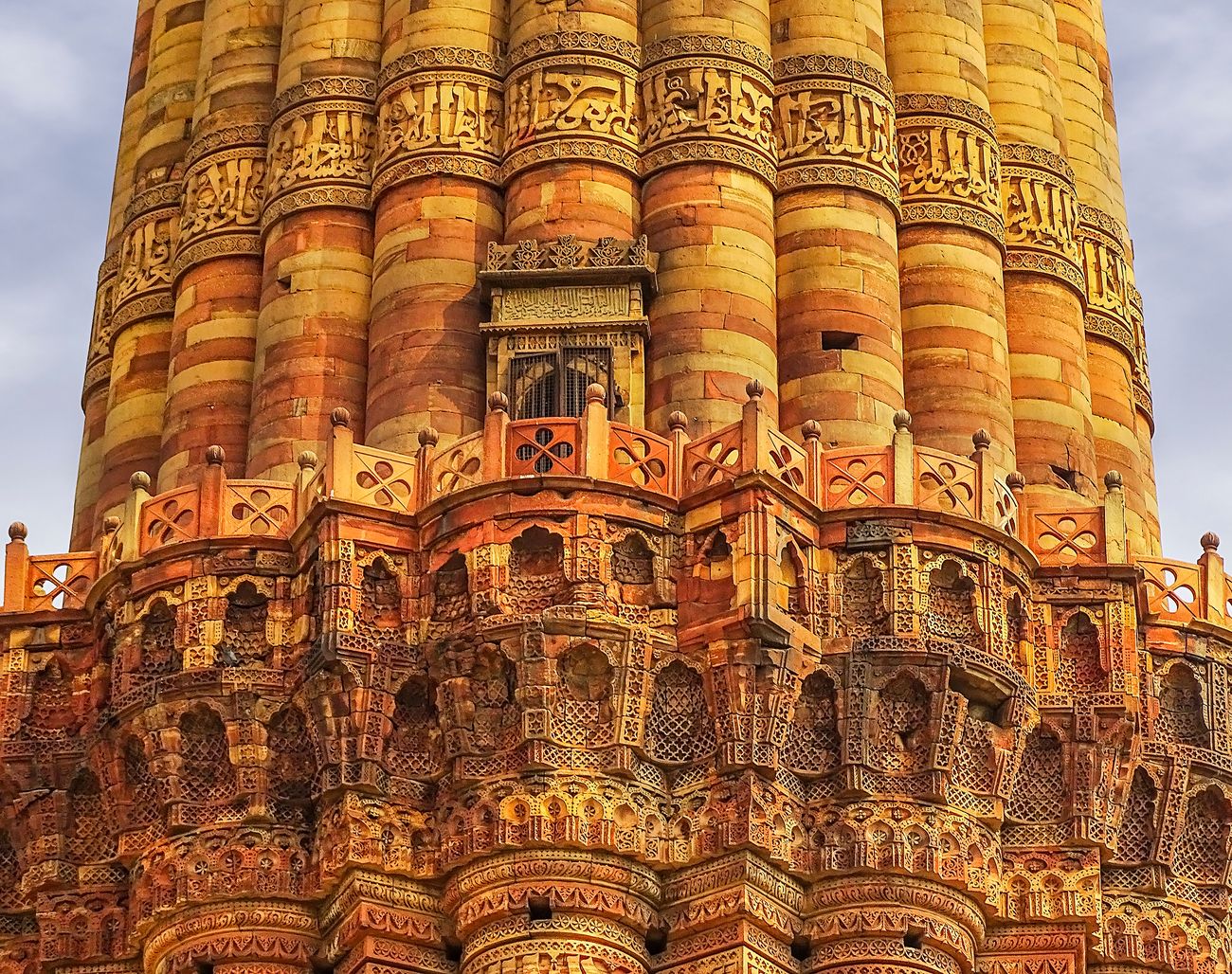
BALCONIES AND ORNATE BRACKETS: The protruding balconies of the first three storeys of the Minar each open out from the staircase on the inside. Stalactite brackets or muqarnas with detailed carvings are their main support. They rest above alcoves with honey combhoneycomb designs. The brackets on the Minar carry an Arabic style of architecture broughtarchitecture brought into India © Ankit M.
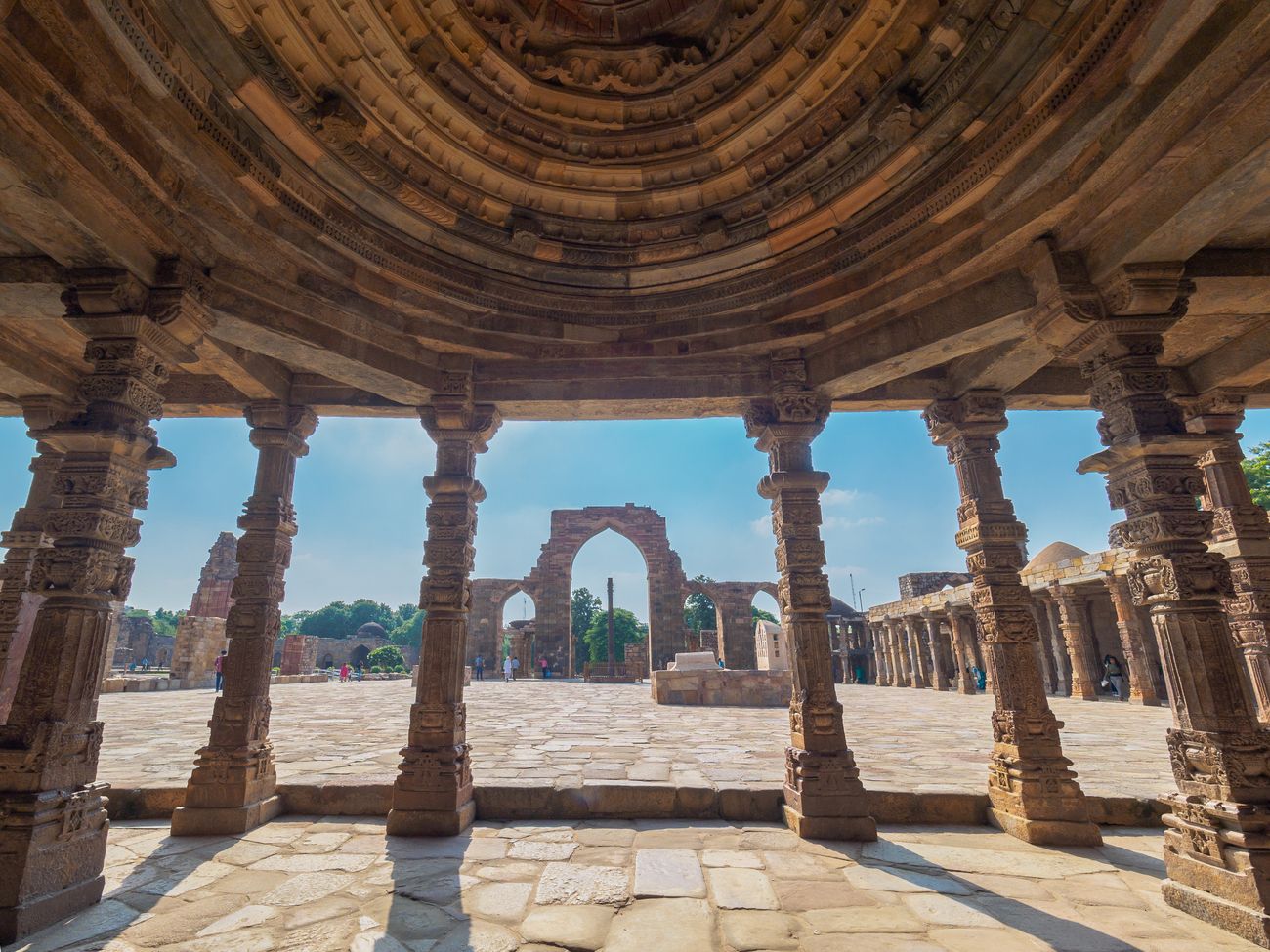
Layout of the Qutb Minar Complex What are the main architectural accomplishments of the Delhi Sultanate? Definitely the Qutb Minar and complex. Note that no initial plan was drawn for this structure as it is. Rather, different leaders over the centuries added various structures to this compound after they conquered northern Delhi. Thus, we have the complex we see today. The Alai Darwaza, which has the tomb of Zamin right next to it and the magnificent Quwwat-ul-lslam Masjid with the sandstone screen are the other monuments you will find here. © Supravee Phathunyupong
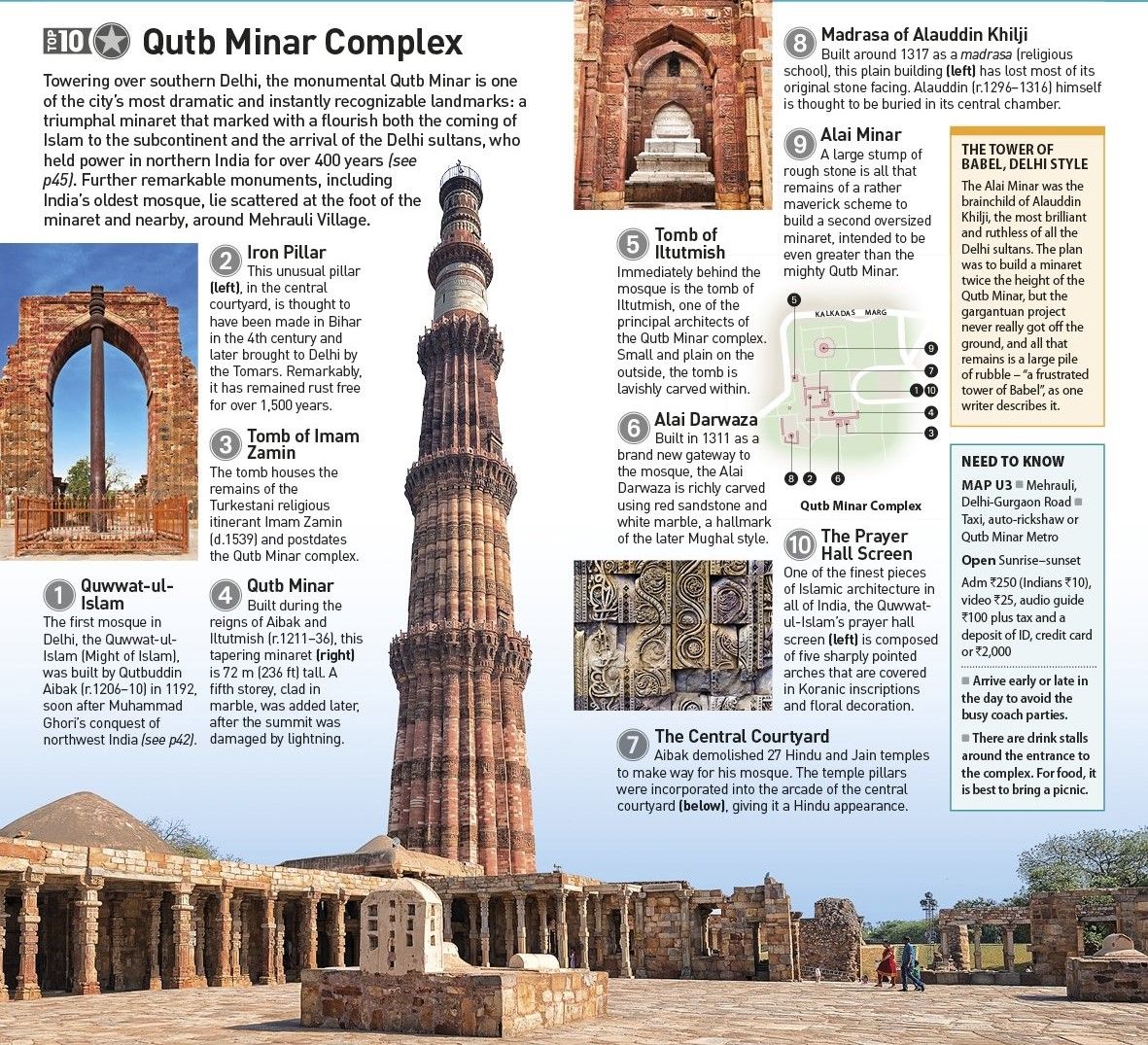
MATERIALS: The builders of this impressive Qutb complex used red and buff sandstone and grey quartzite (metamorphosed sandstone) strengthened with mortar as the main materials. They also incorporated marble from Makrana in the state of Rajasthan, Western India. The surface of the first three storeys of the Qutb is covered with sandstone, while the surfaces of the third and fourth storeys are made up of marble. The pillars taken from the Jain temples that were destroyed are made of quartzite. © Dmitry Strizhakov
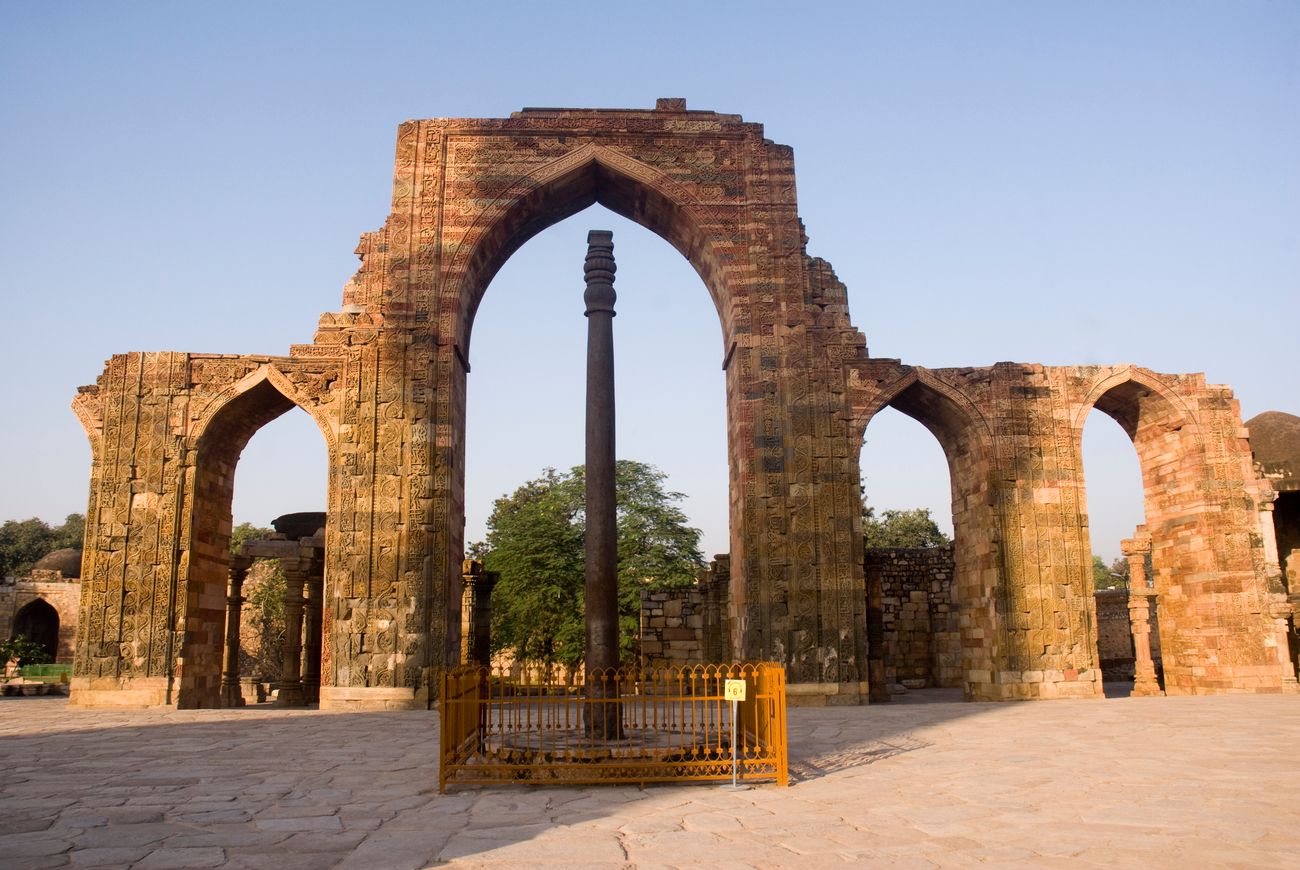
Pillar And The Grand Arches: SCREEN: This renowned Iron Pillar from the fourth century has the late 12th century maqsura or (screen) of the late 12th-century Quwwat-ul-lslam Masjid as its backdrop. The maqsura has pointed arches that are opulently decorated with geometric and arabesque intertwined flowing lines, as well as Quranic inscriptions. Flora/ carvings and calligraphy beautifully decorate the red sandstone screen. It is believed that the amazing Iron Pillar was imported to Qila Lal Pithora from central India by Anangopal who was a Rajput ruler of Delhi. It was set up alongside the 27 temples that were there. © Tukaram.Karve
Quwwat-ul-lslam Masjid (Mosque)
Qutbuddin Aibak specially ordered the construction of the Quwwat-ul-lslam (Might of Islam) Masjid. It was the first mosque to be built in India where people gathered for worship. This structure was built between1193 and 1197. The mosque itself is made up of an elaborate screen, which is intricately decorated and a courtyard surrounded by pillared walkways on three sides.
The Iron Pillar towers some 7m (2ft) in the courtyard. The inscription embedded in it describes it as a beam of the Hindu deity Vishnu. It also memorializes King Chandragupta Il; hence, it appears to have been built sometime during the fourth-century Gupta period.
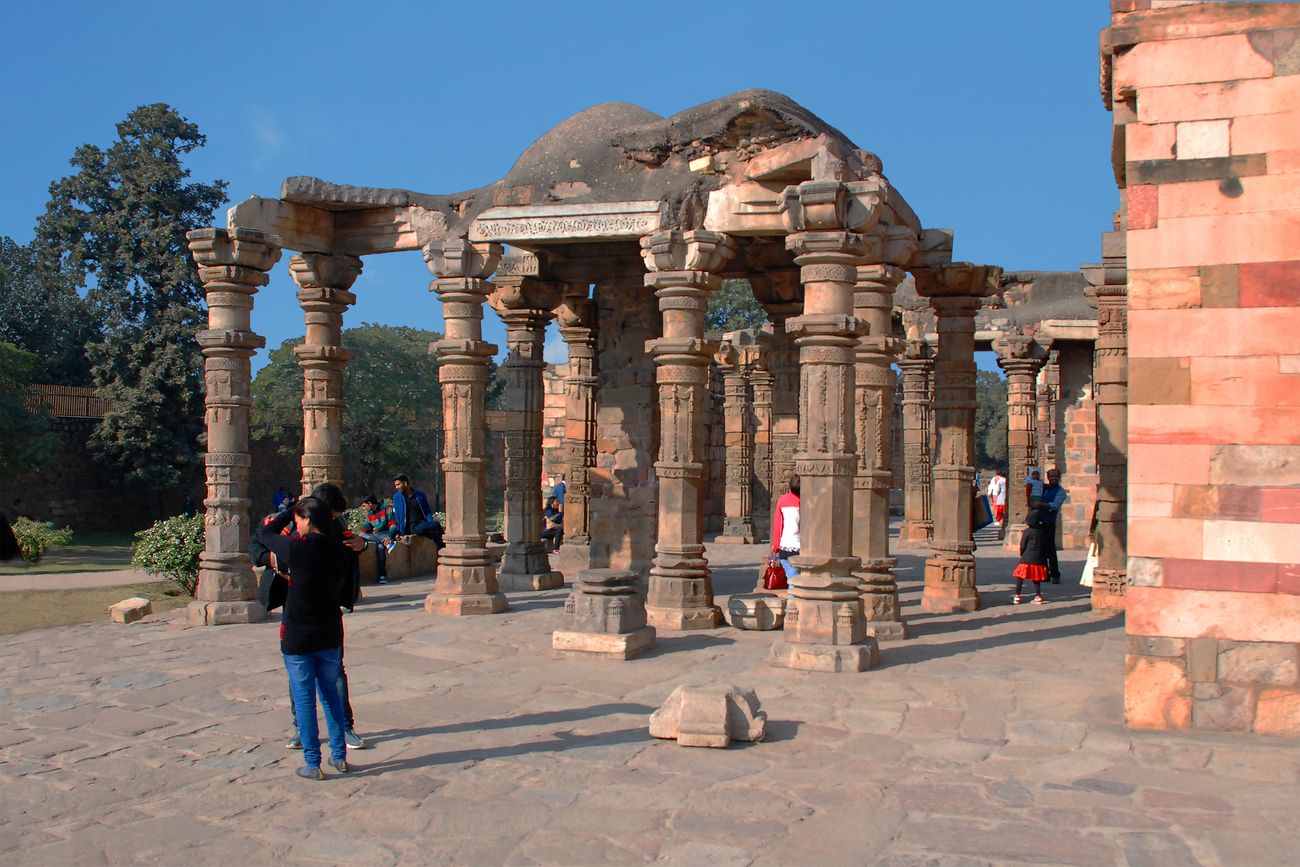
Cloistered Courtyard: To reach this mosque, you have to climb steep steps on the east, west, and north sides because it is built on an elevated platform of a temple that was constructed earlier. It is designed with a main rectangular courtyard measuring 43 x 33m (141 x 708ft) © Faurem.
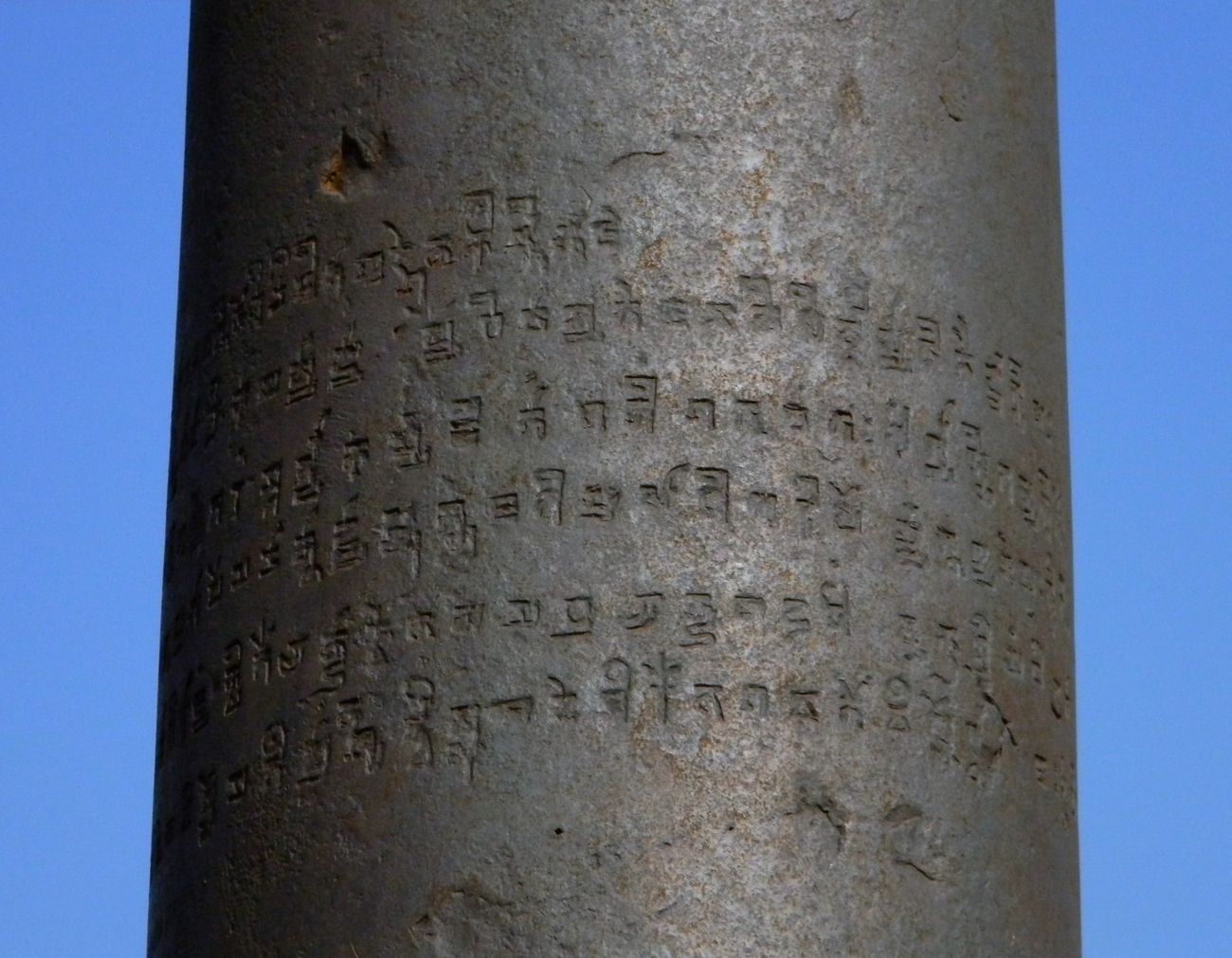
SANSKRIT INSCRIPTION: The iron pillar has an inscription engraved in the Sanskrit language. This is found in the Gupta-Brahmi script and makes mention of King Chandragupta IIII © 3000ad
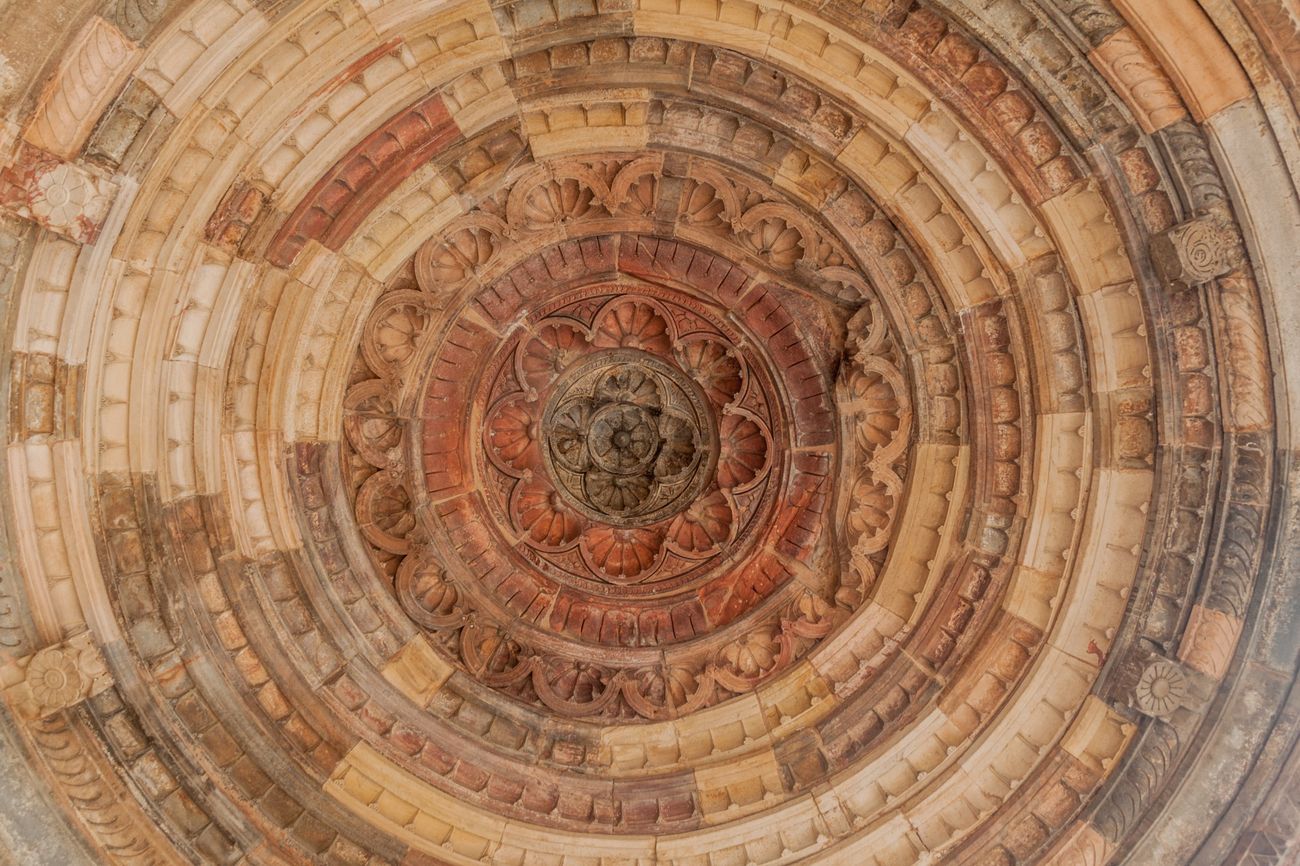
Floral Motifs On Ceiling Of The Mosque © Matyas Rehak
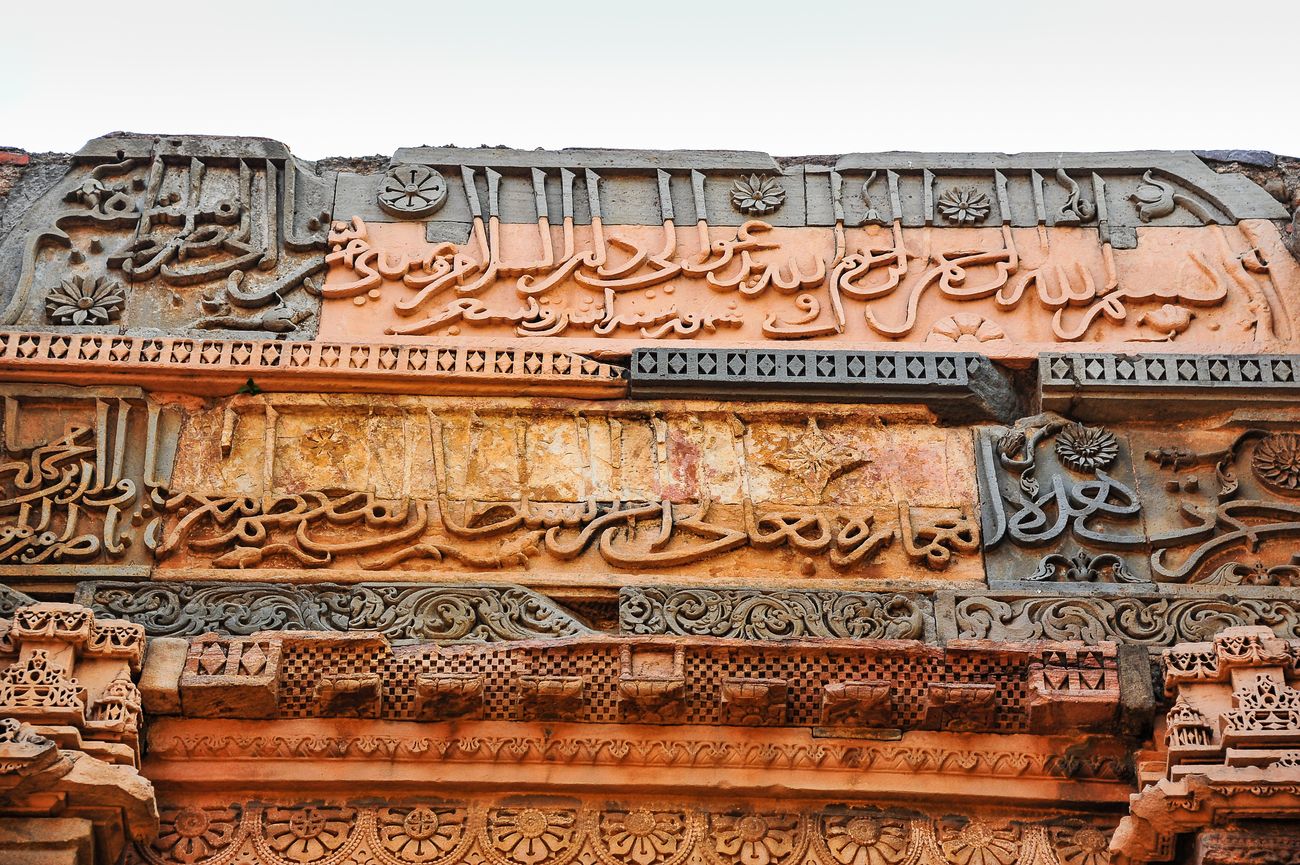
FUSION OF STYLES
This mosque showcases a new style of architecture that mixed the Islamic and Hindu decorative elements. The material to build this mosque was taken from some 27 temples that were destroyed. There is a unique blend of Islamic calligraphy and patterns on the mosque’s sandstone screen with Hindu motifs such as ghata- pallava (flower-pots), lotuses, and tasselledtasseled ropes on each pillar.
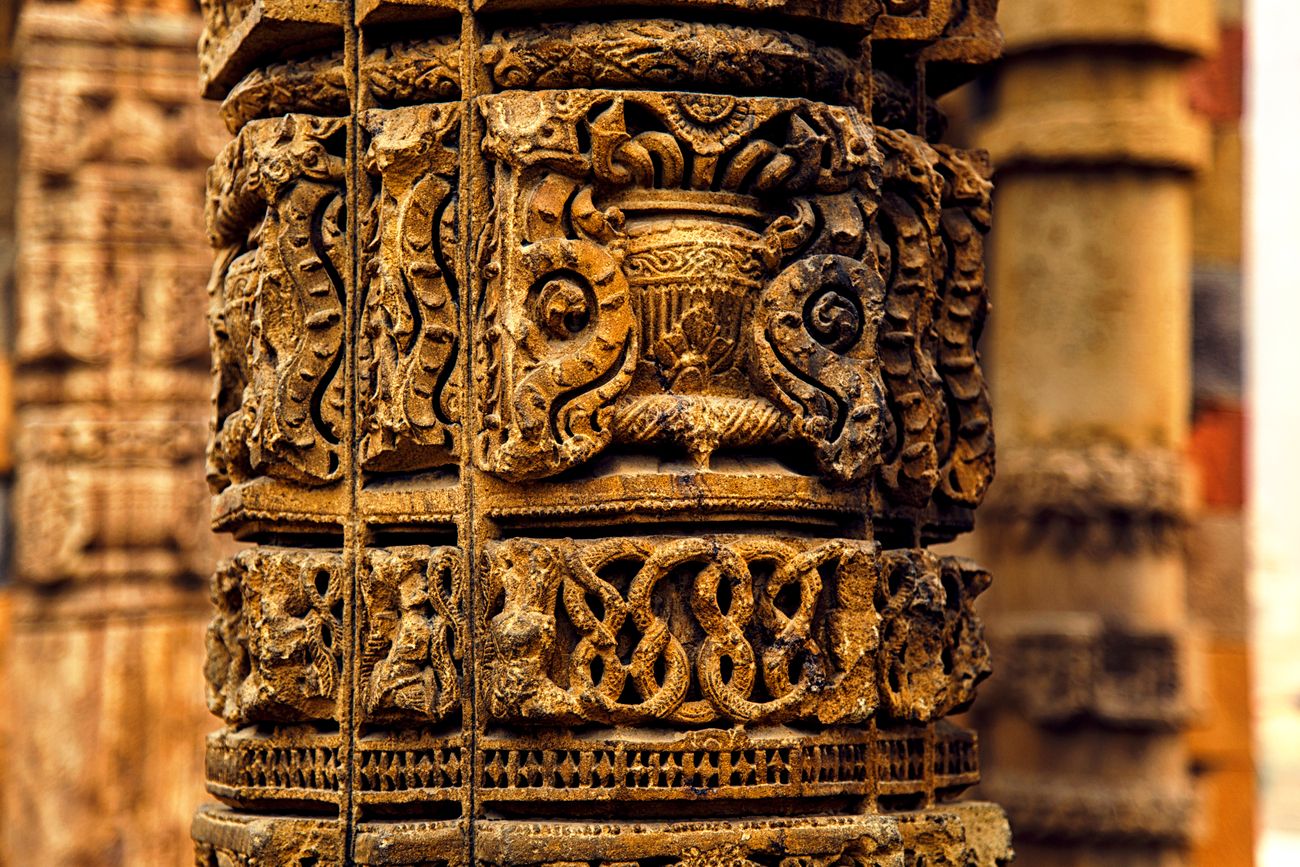
Floral designs decorate many surfaces of the first three stories of the tower, including this intricate flower pot adorning a pillar in the complex flower pot© Emdadul Hoque Topu
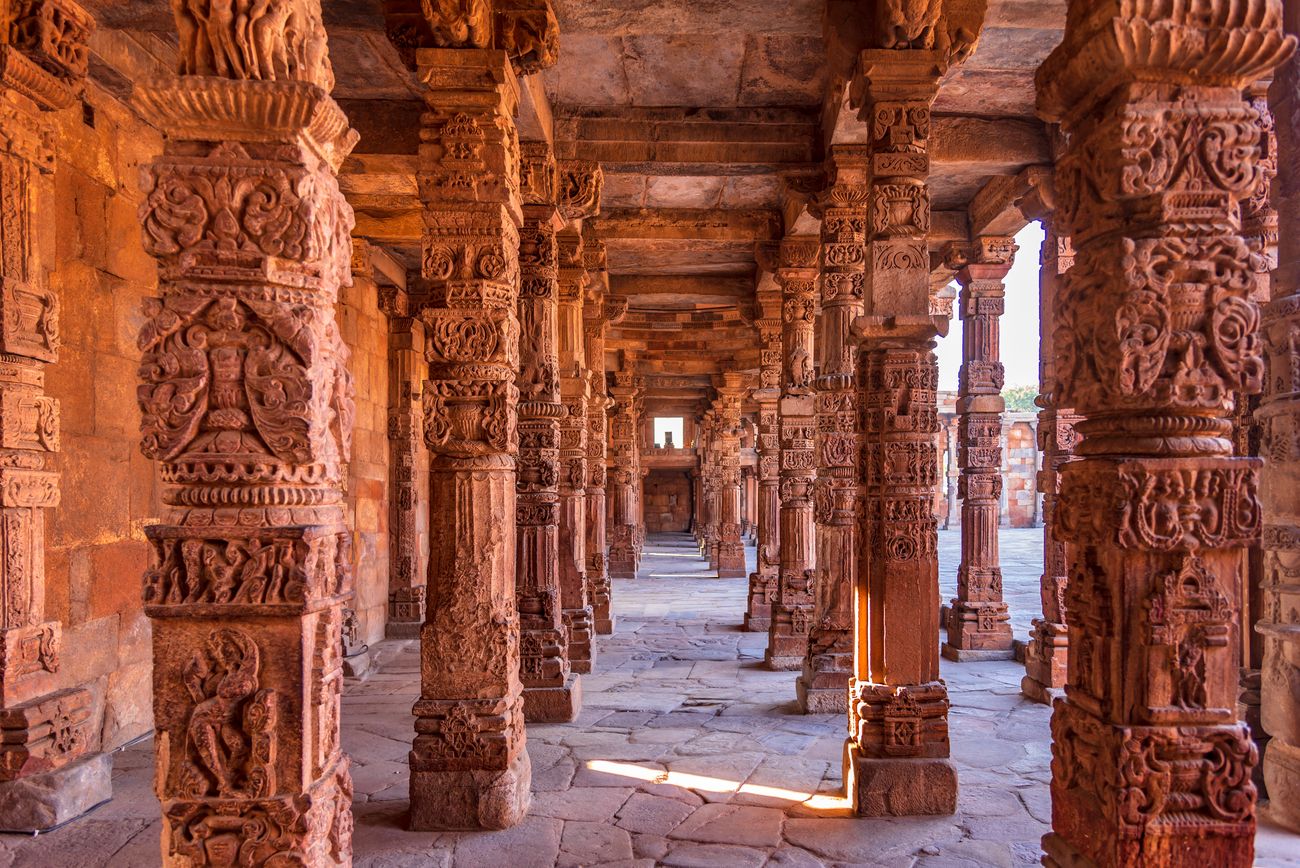
PILLARED VERANDAH: You can observe that the decorated pillars of the verandahs have been designed in square shapes, which is consistent with the Hindu style © By Amit kg
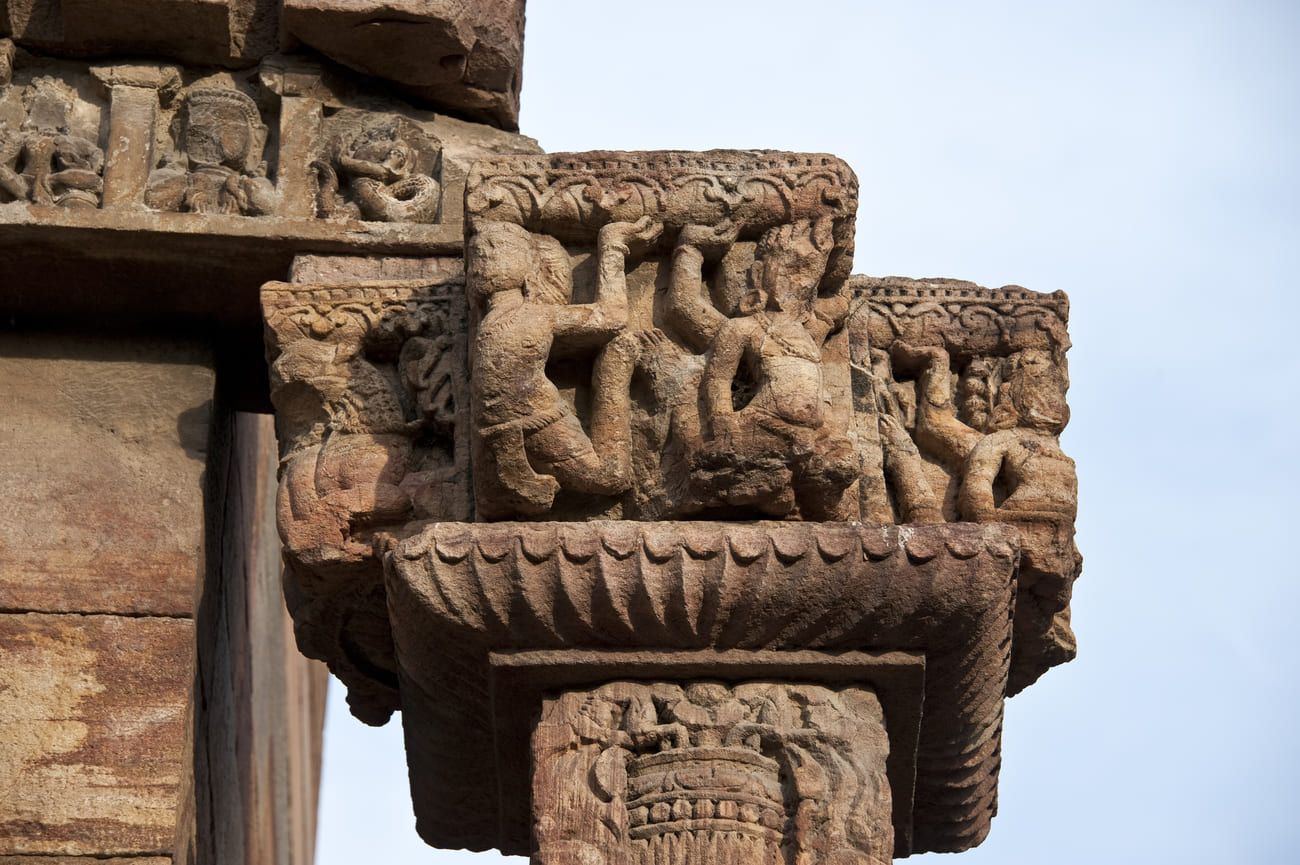
The highest tower in the country, the Qutub Minar’s soaring appearance is softened by many decorative carvings. The adjoining area is littered with ancient ruins, both Muslim and Hindu, indicative of the violent conflict that ended Hindu reign in the Delhi region © manx_in_the_world / GETTY IMAGES
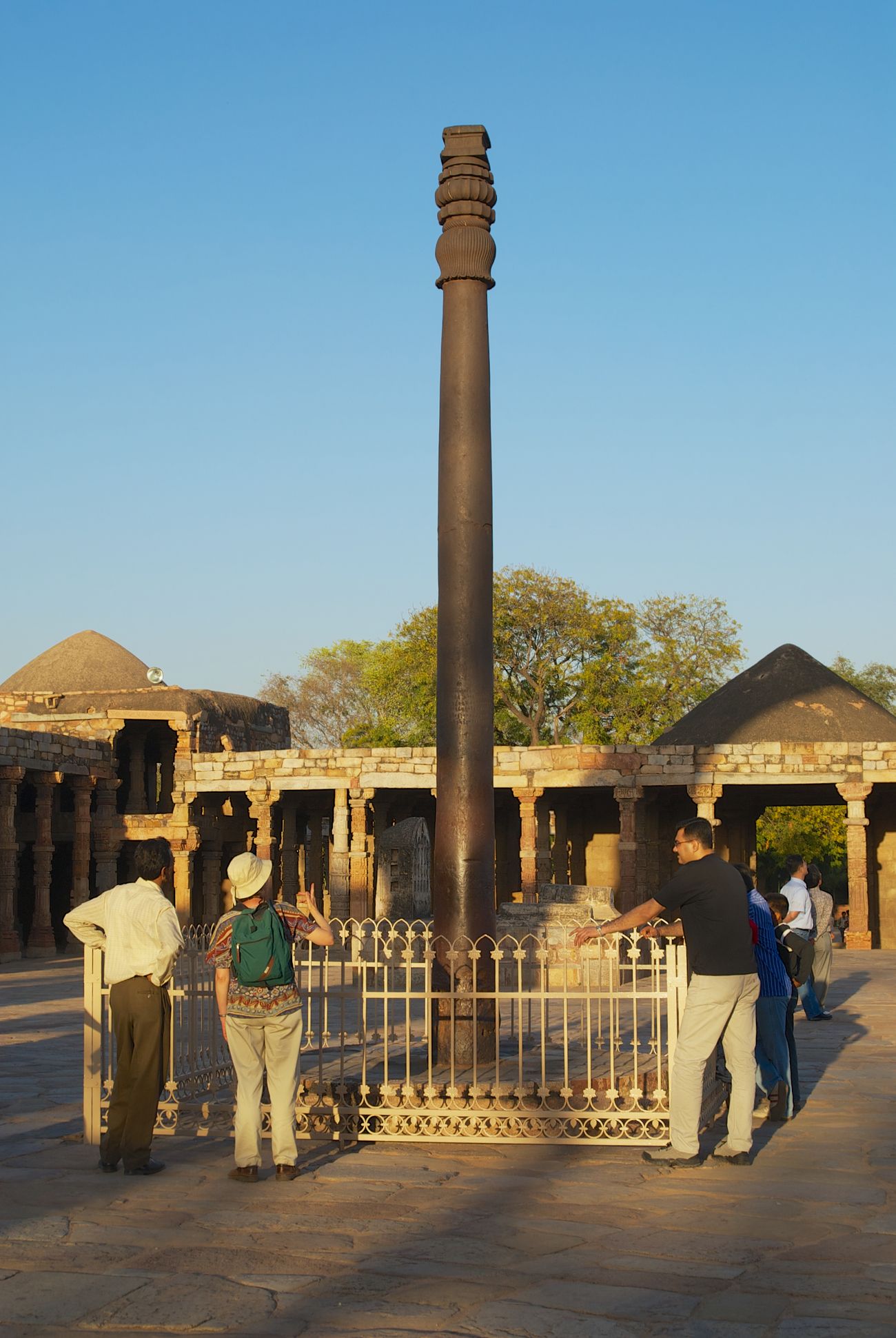
THE IRON PILLAR: As the name suggests, 98 % of this pillar is made of pure iron. It is a memorial to Indian metallurgy. So fantastic is this iron pillar that over the past 16 centuries, it has shown little signs of rusting © Dmitry Chulov.
Sandstone screen
In 1197 when the mosque was completed, a maqsura (a screen that separates an enclosed prayer space) was constructed. The maqsura was built in front of the prayer hall by Aibak in 1199. It had a main central arch with smaller arches on both sides. The maqsura faces the west in the direction of Mecca. It appears as if it was modeled after the screen of the mosque in Medina built by Prophet Muhammad. Later, lltutmish and Alauddin Khilji developed the structure even more and enclosed the Alai Minar and Qutb Minar.
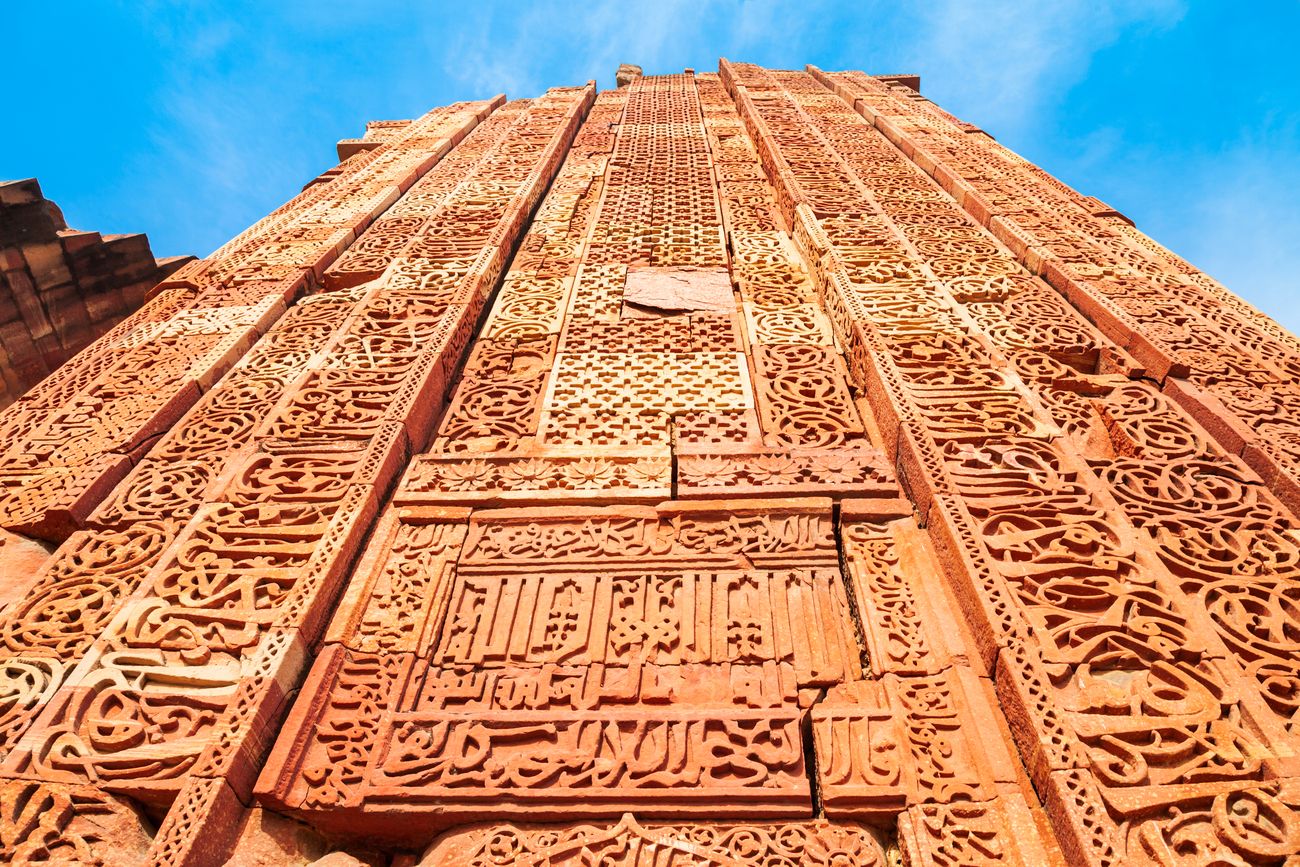
ORNATE CALLIGRAPHY © saiko3p
Alai Darwaza
The Alai Darwaza was built by Alauddin Khilji in 1311 with exceptionally perfect proportions and a fantastically decorated exterior, It is located southeast of the Qutb Minar. Initially, there were plans to build four gateways to the Minar, but this was the only one that was completed because Alauddin died in 1316 before he could finish the building project.The Darwaza has a square shape with tall arched doorways that lead to the four main compass points. This was one of the first buildings to use the true arch, and it displays several inscriptional panels in marble, as well as detailed decorations in the red sandstone. The central arch is elevated to almost the entire height of the building and its bands are attractively ornamented with geometric, floral, and arabesque patterns. It is has a dome, which is supported by corner arches that set back into the wall. Sections of the upper wall’s surface have fallen off. In 1828 Major Robert Smith, a British military engineer did repairs to the structure, which resulted in the square outline of the current wall

ALAI DARWAZA, GATEWAY TO THE MINAR: Alauddin’s title is mentioned in the engravings on the archways. A record of his extension of the OQuwwat-ul-lslam Masjid in 1311 is also there © Matyas Rehak.
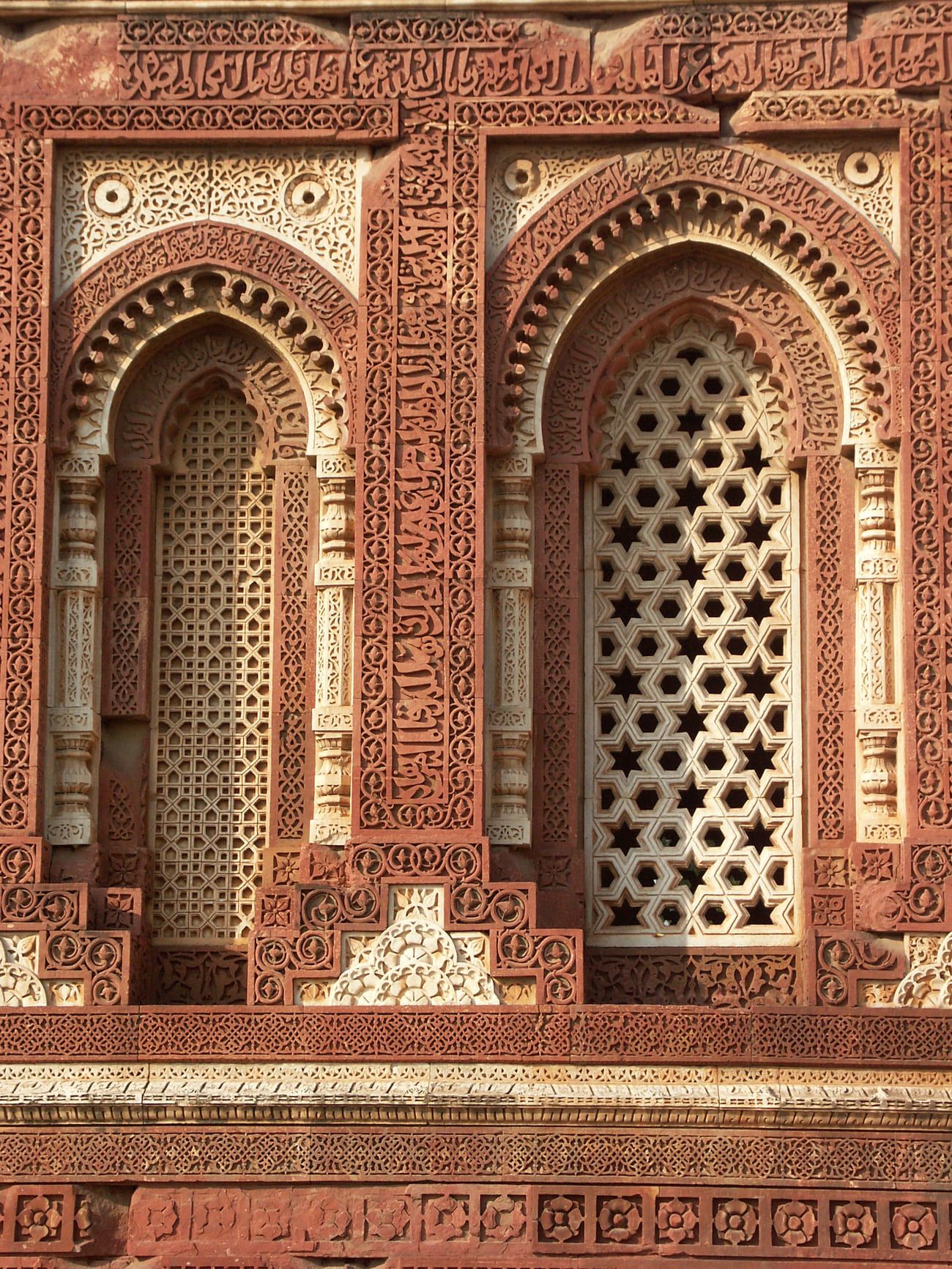
53 WINDOW: These beautifully decorated windows of the Alai Darwaza have latticed screens known as jaalis set within the arches. Notice the lotus-bud border on the arch, which is a distinct feature of the Khilji period © brytta / GETTY IMAGES
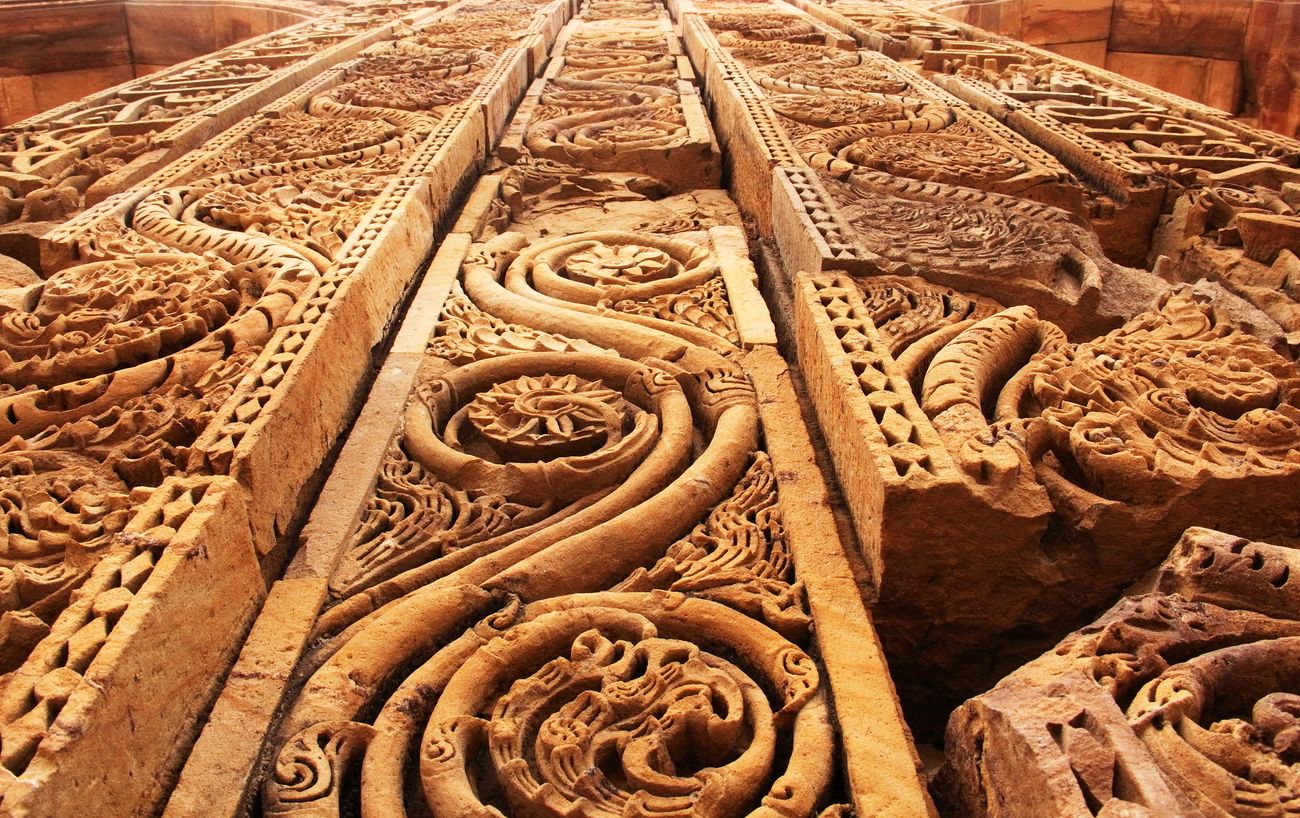
Beautiful bas reliefs and floral decorations on Alai Darwaza © Natalia Davidovich
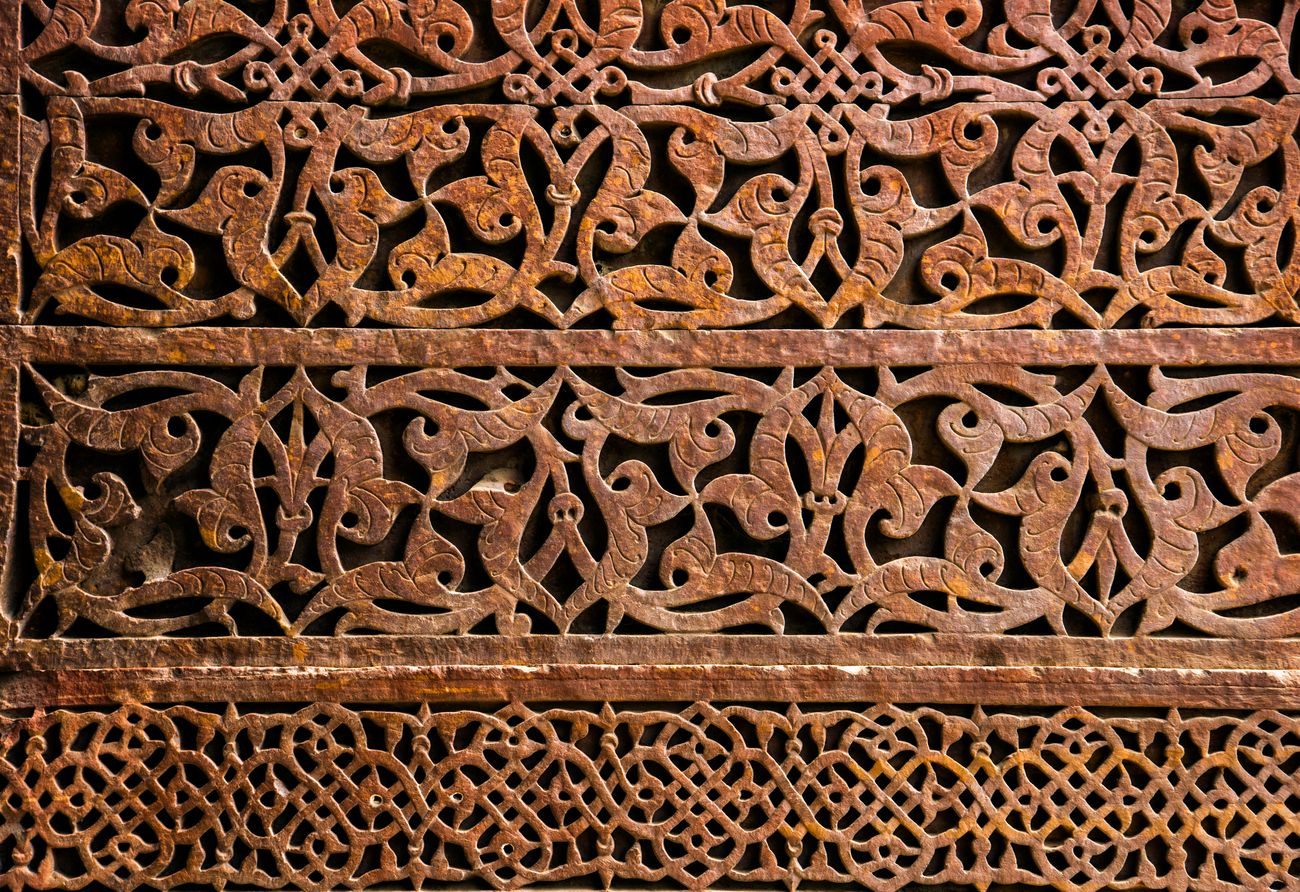
Stone carving detail of the interior of Alai Darwaza ©CRS PHOTO
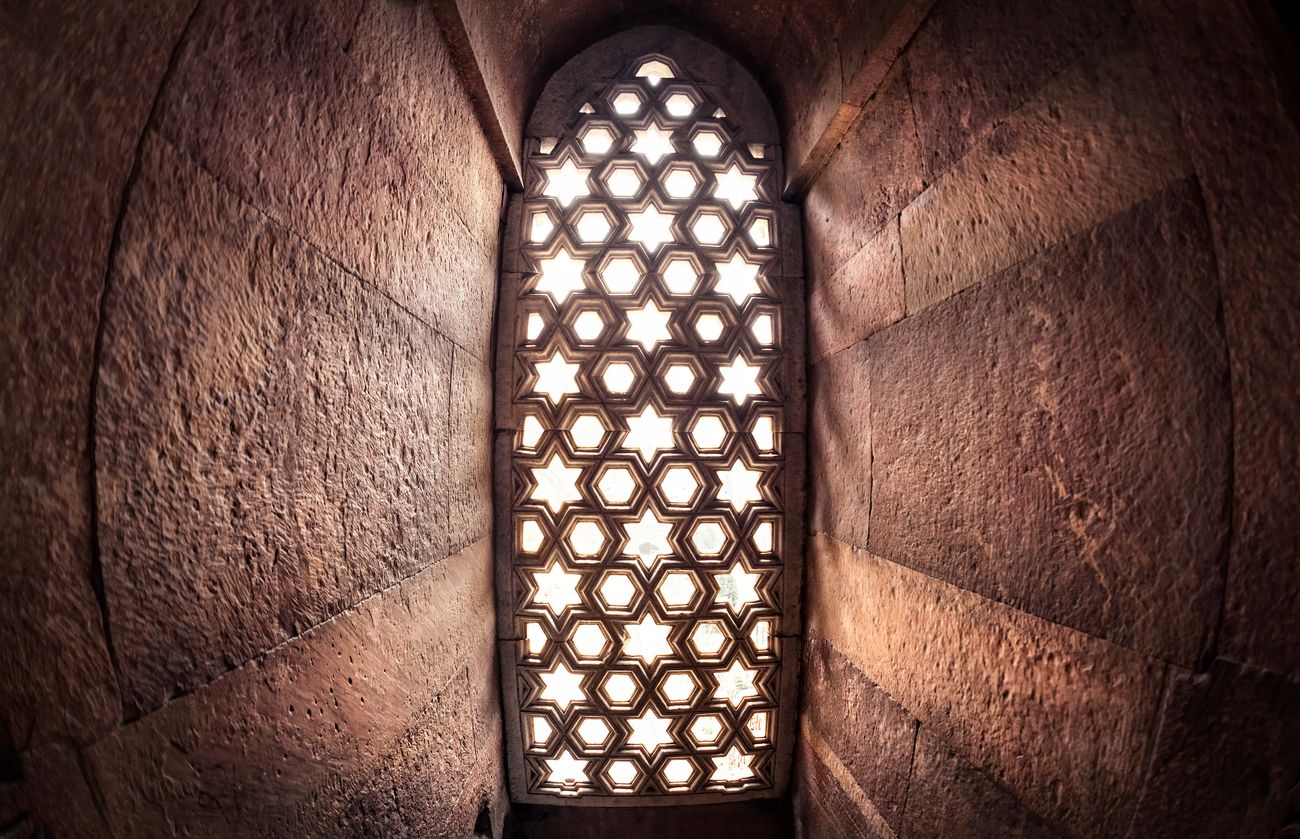
Screen from interior of Alai Darwaza
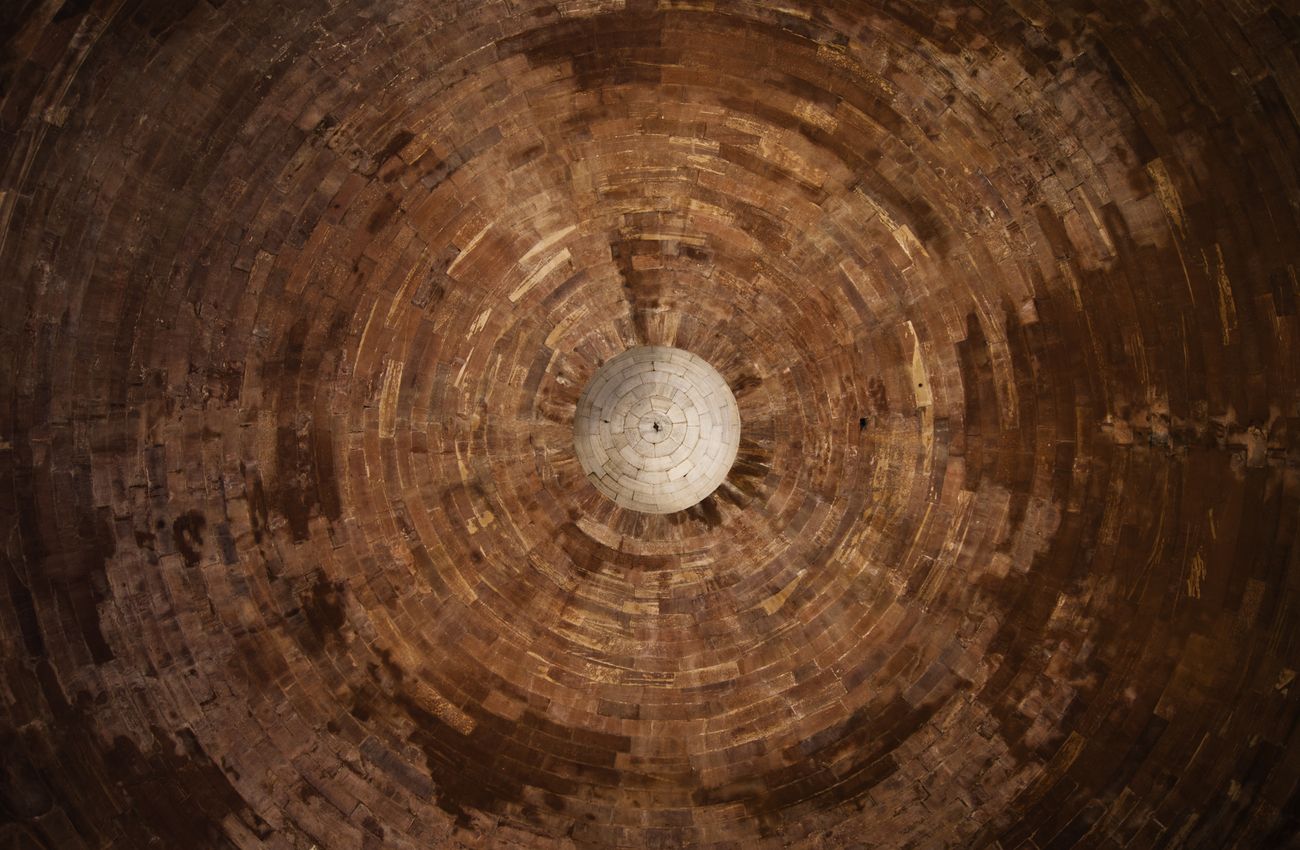
Detail of the carved ceiling in Alai Darwaza © Roberto Mussi
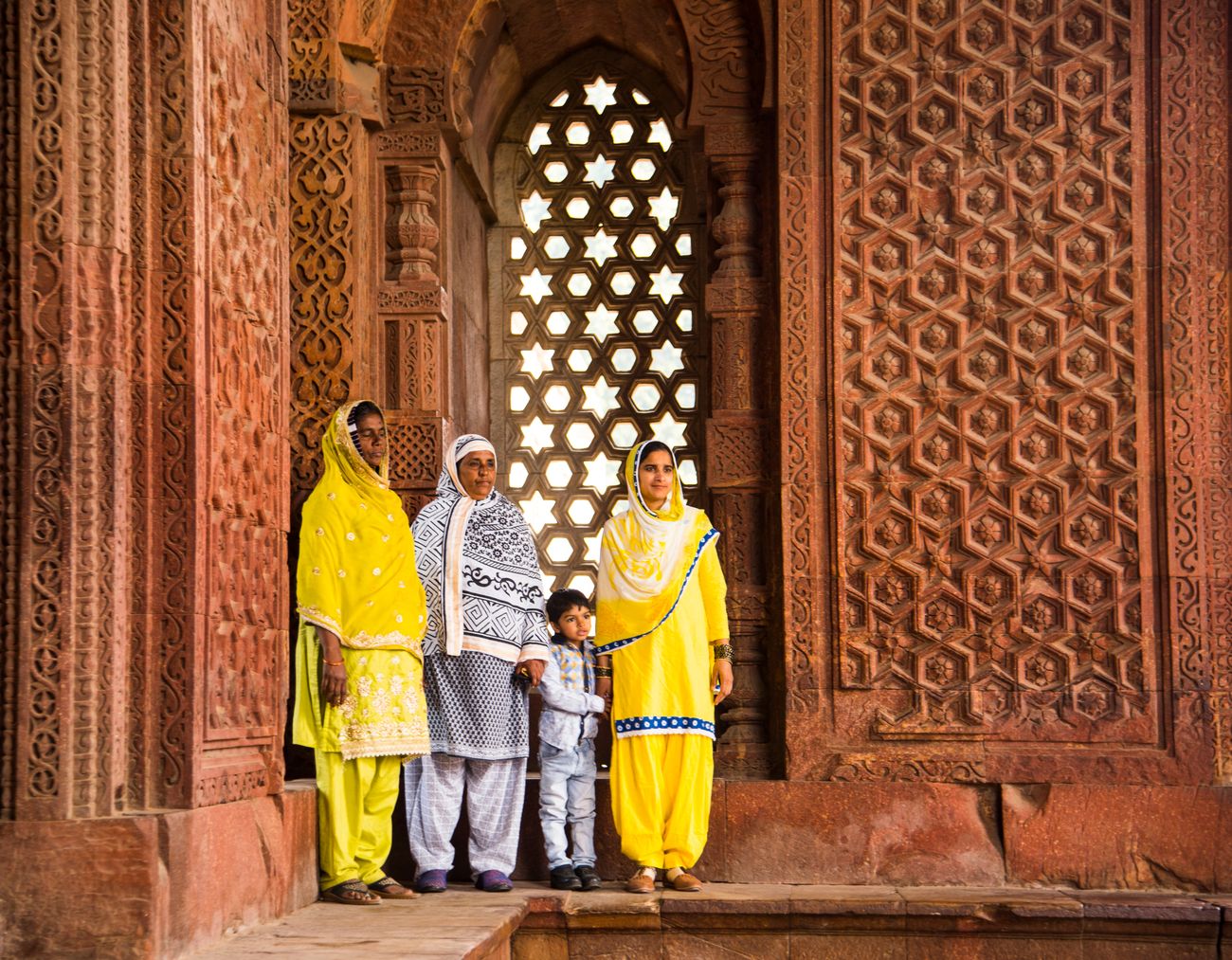
Indian tourists visiting the Alai Darwaza in the Qutb Complex © Roberto Mussi
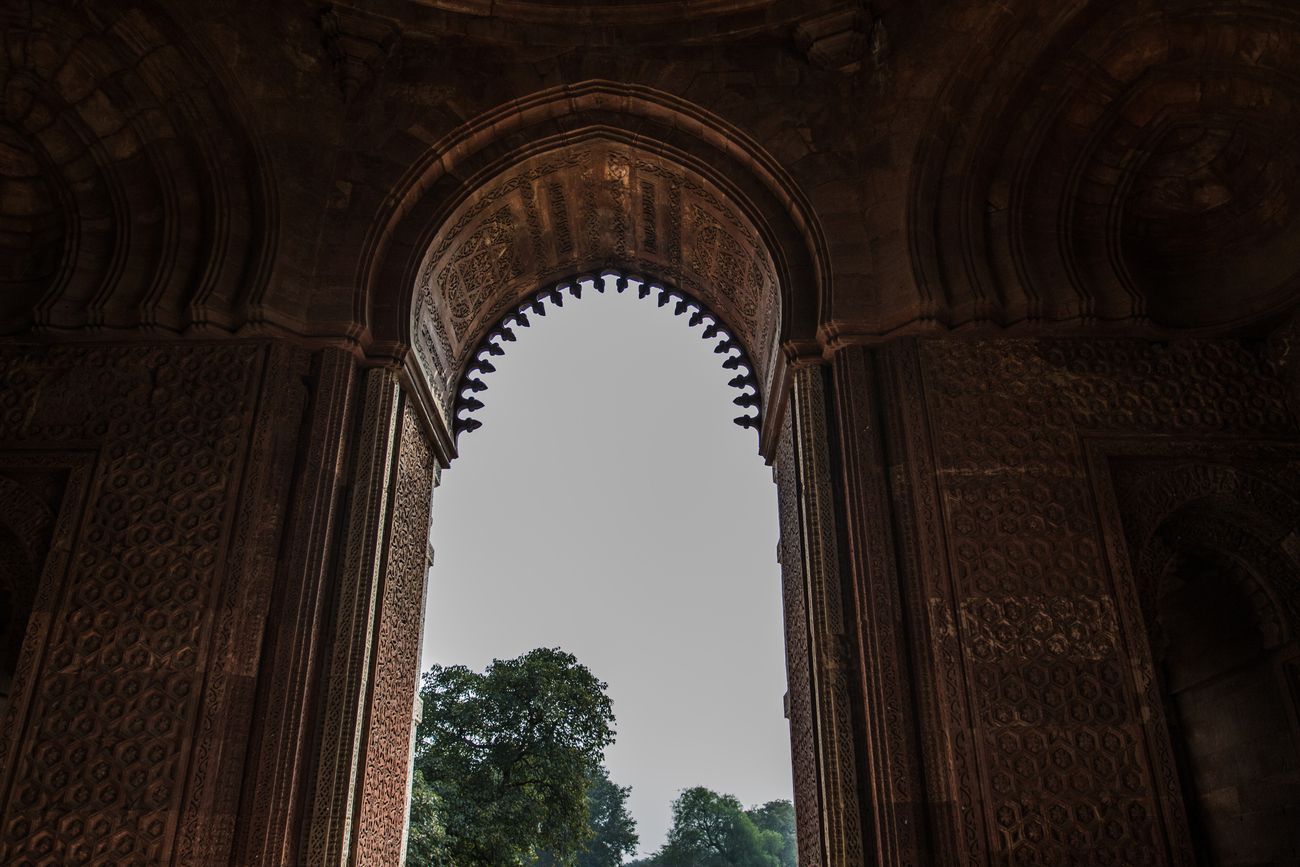
Entrace gate of Alai Dawaza monument © Social Media Hub
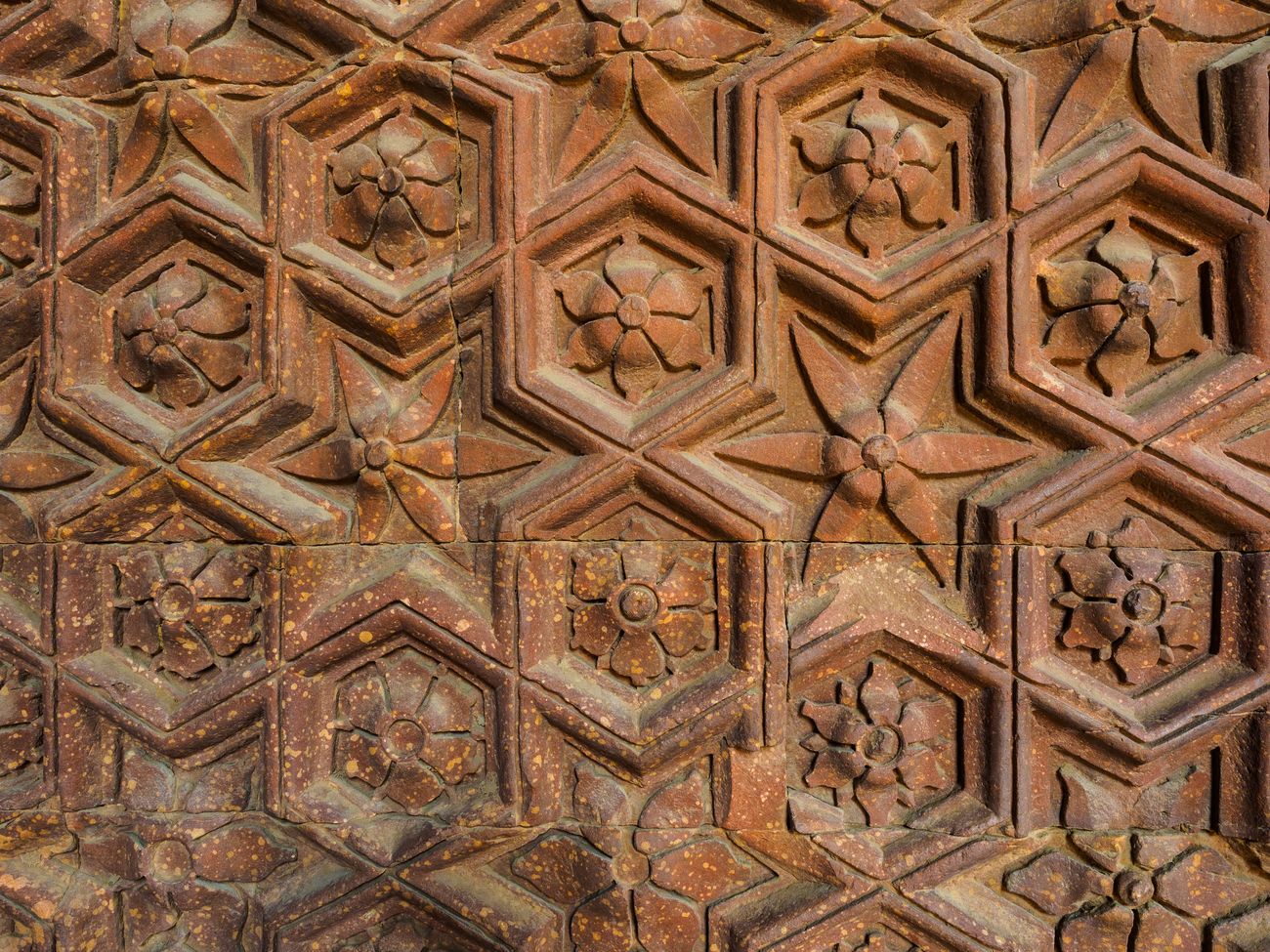
Beautiful floral designs carved in the red sandstone inner walls of alai Darwaza. A perfect example of fusion of Hindu elements in an Islamic structure © Supravee Phathunyupong
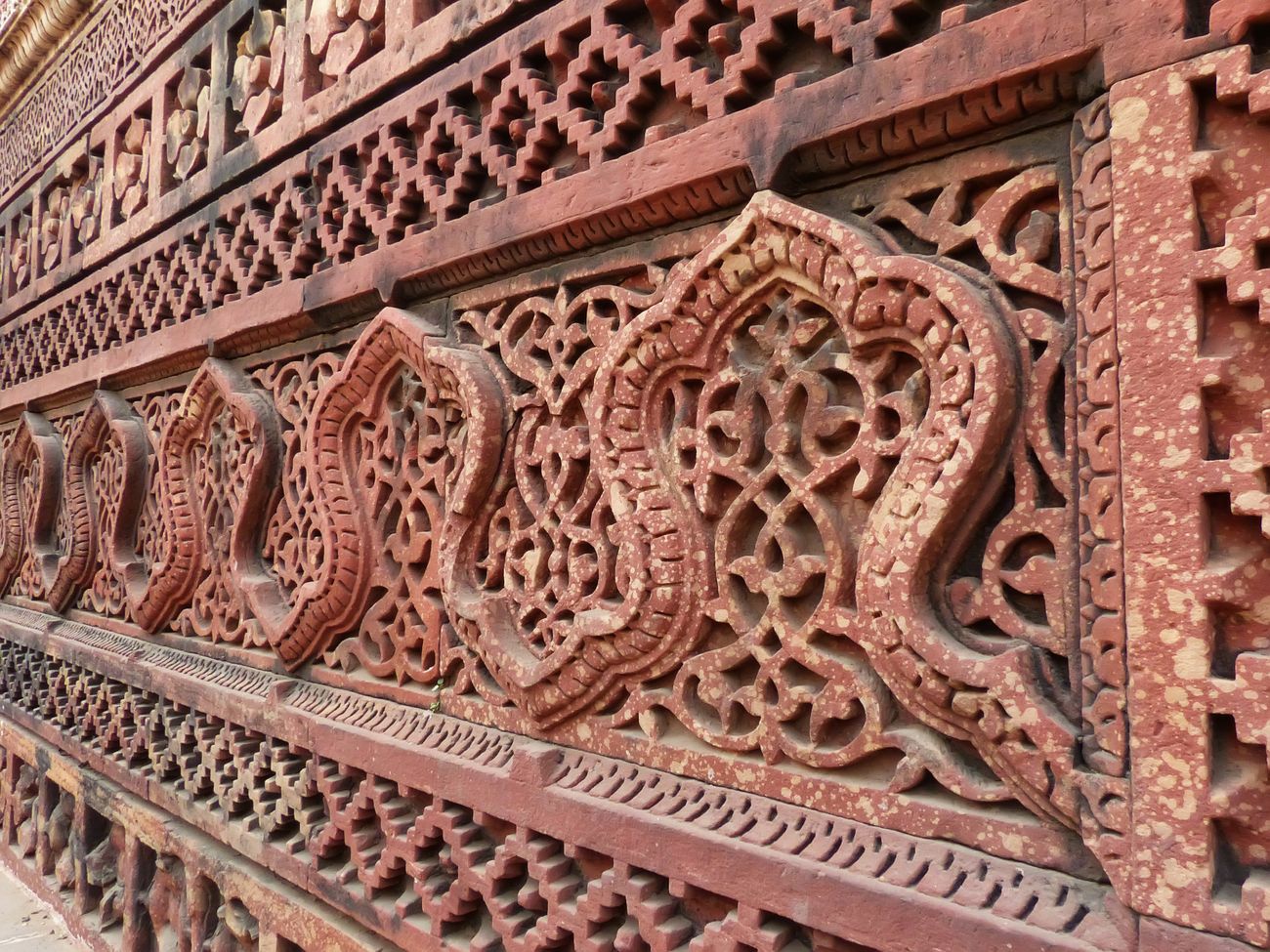
A close-up view shows the skill of the artisans who carved decorative designs on the walls of the main entrance to the complex, the Alai Gate © Don Mammoser
A Builder with Visions of Grandeur
Not only did Alauddin Khilji build the outstanding Alai Darwaza, he also expanded the Quwwat-ul-lslam Masjid’s enclosure and screen. Along with that, he began the construction of the massive Alai Minar. The foundations of Siri wereSiri were built while Khilji ruled. Siri was the second city of Delhi, and it is also the first to be built by a Delhi sultan). Alauddin Khilji also built a madrasa, which was an educational institution and what would become his tomb eventually. He also commissioned the construction of a massive reservoir (hauz khas) to supply his fortress with water.
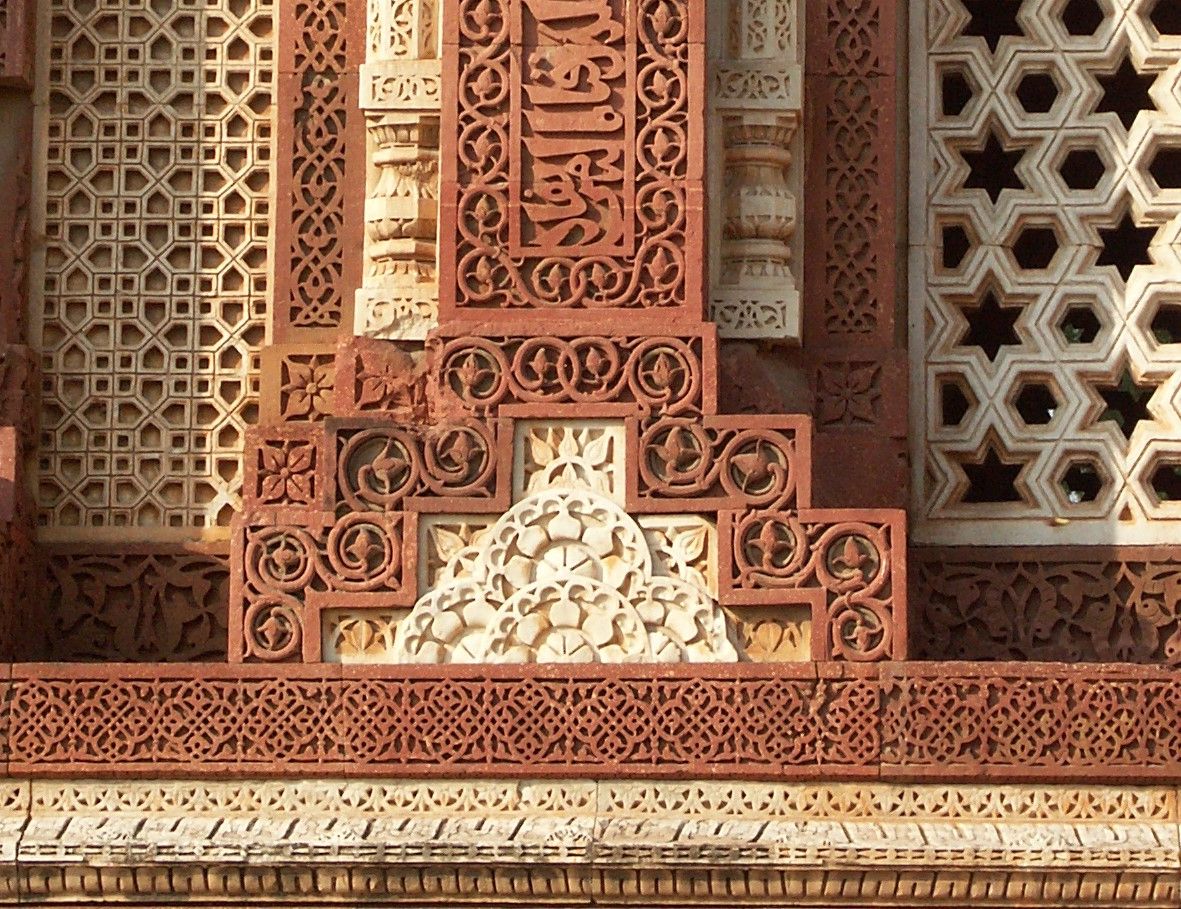
Marble floral designs can be found on the sides of the central arch. These are balanced by carved sandstone lotus-buds and spiraling stems. A band made of sandstone with lavish decorations lies below.
Imam Zamin’s Tomb
Imam Zamin, whose real name was Muhammad Ali, was a Sufi saint in the15th-century Sufi. He journeyed from Turkestan to Delhi during the rule of Sikander Lodi. It is possible that he held a prominent post in the Quwwat-ul-lslam Masjid. His tomb can be found next to the eastern gateway of the Alai Darwaza where it was built during the reign of Mughal emperor Humayun. This indicates that it was built later than the other monuments in the complex. The square-shaped building stands 16.5m (54ft) high and is embellished with marble coverings above the sloping eaves (chhajjas).
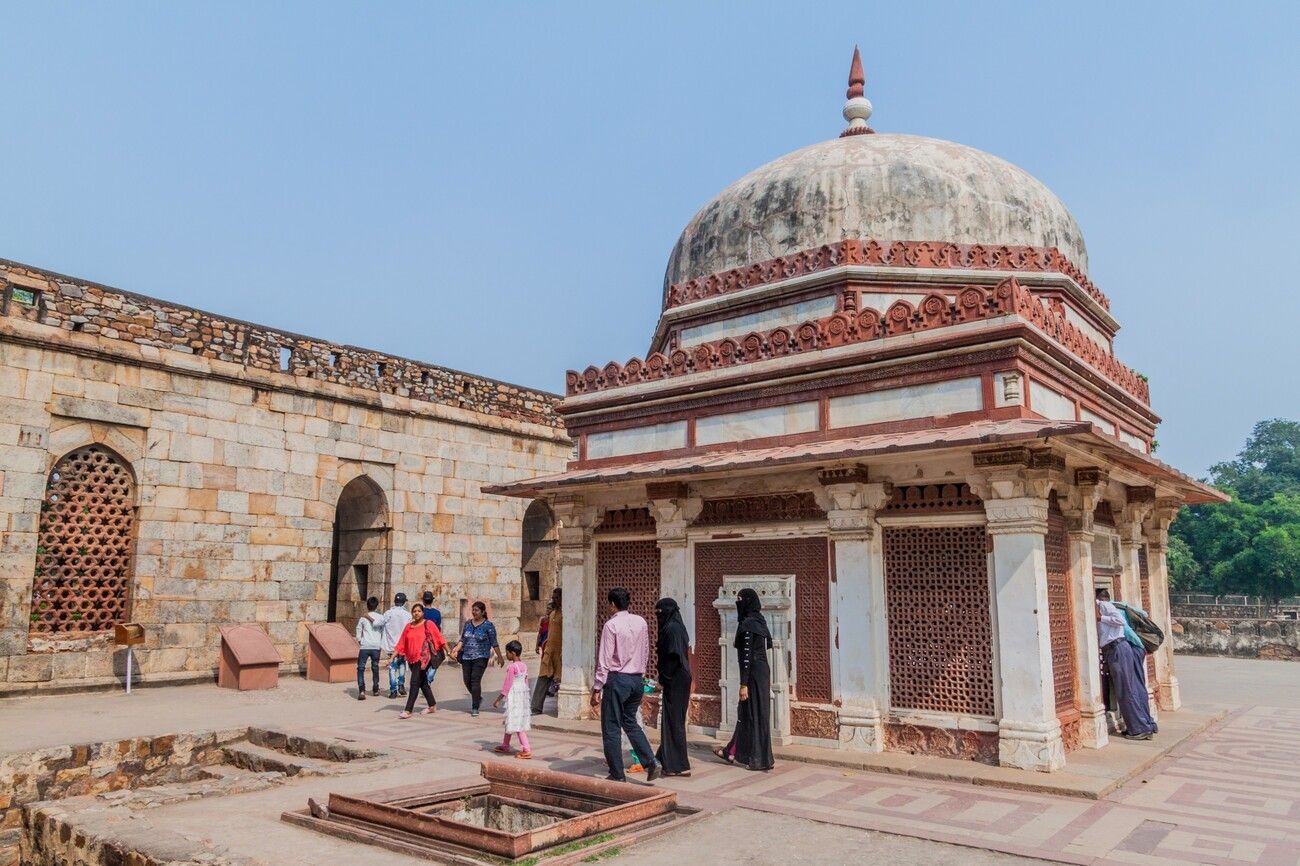
SAINTLY AURA: This small simple building is the tomb of Imam Zamin. It has a sizeable dome, which sits on an octagonal base covered by stepped bastions © Matyas Rehak
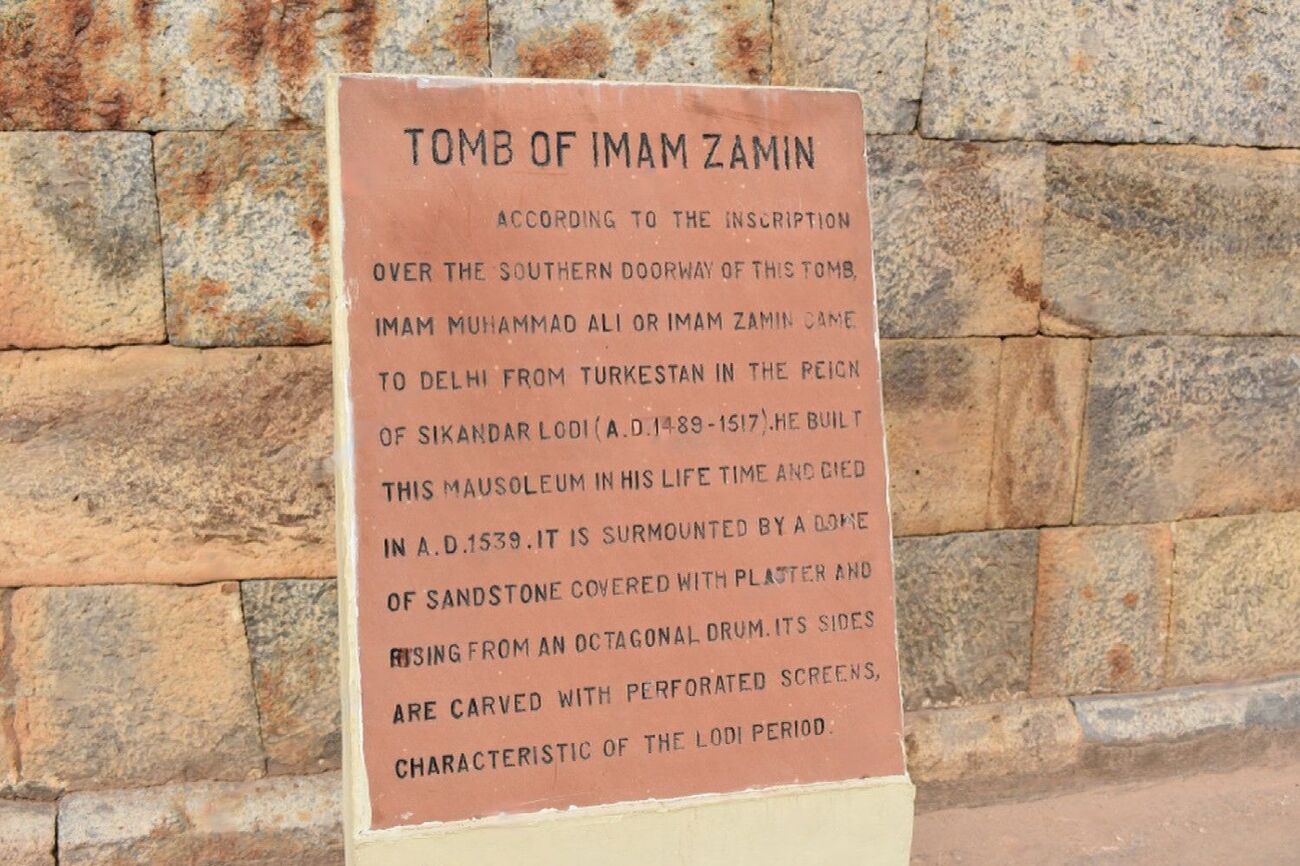
Description of Imam Zamin Mosque engraved in red sand stone, Mehrauli Archaeological Park, Delhi
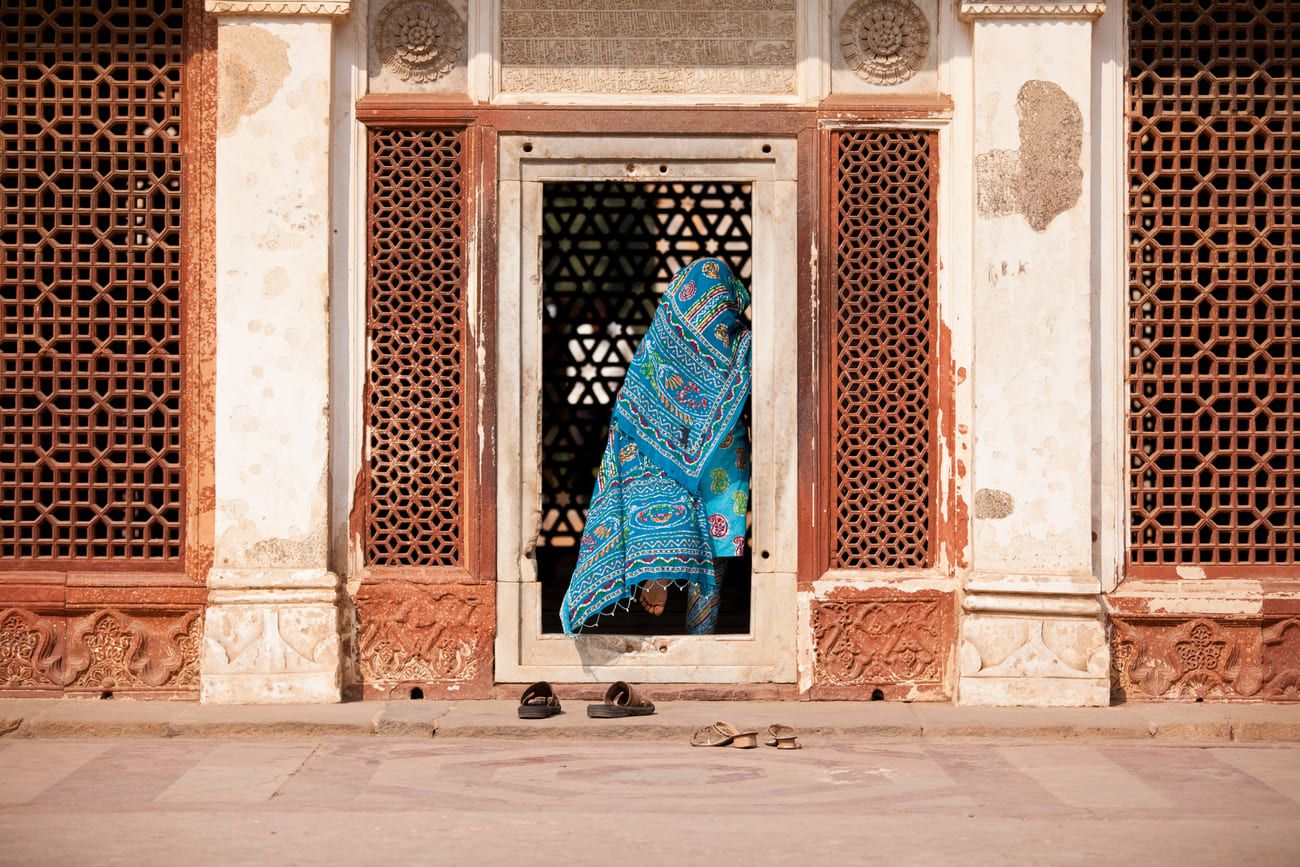
MARBLE SLAB: Based on the inscription in Naskh lettering above the doorway, this tomb was built between 1537 and 1538. The saint died the following year © nullplus / GETTY IMAGES.
LATTICED SCREENS
To protect from the glare of the sunlight, sandstone screens were placed on three sides of the tomb. The detailed geometrical designs and star shapes are their distinct features.
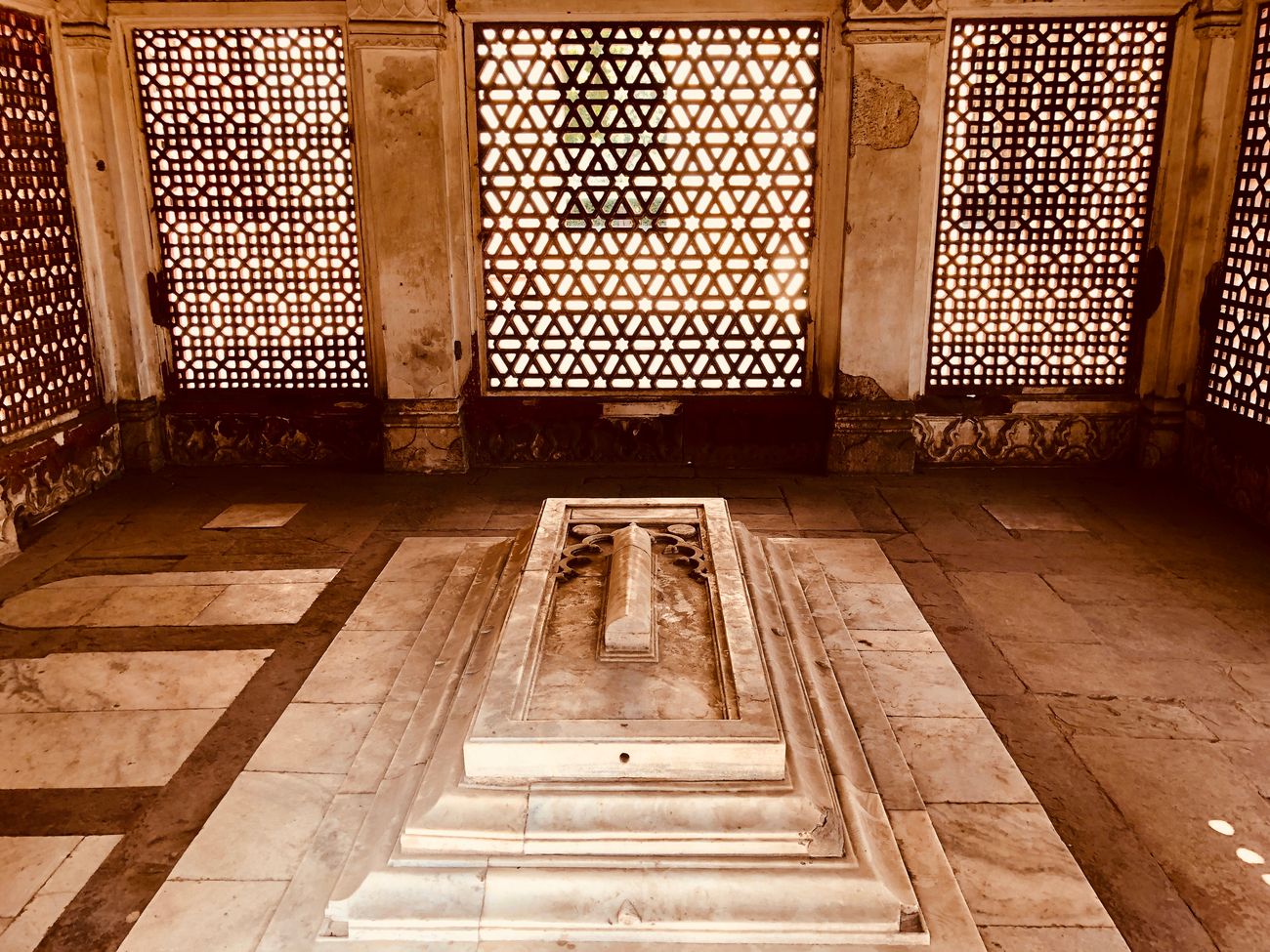
Inside the tomb of Imam Zamin, there are 12 pilasters. These are linked together by sandstone latticed screens (jaalis). The main material used for the sepulchre and to decorate the inside is marble. You will see this especially in the elaborately craved mihrab, which is a niche in the wall of a mosque. It is at the point closest to Mecca, which the congregation faces to pray © Azhar_khan.
Alauddin’s Madrasa and Tomb
The madrasa of Alauddin Khilji is located to the southwest of the Quwwat-ul- Islam Masjid. Alauddin built this structure as a school to teach Islamic scripture. The complex is made up of small chambers, some positioned with their fronts toward the lawn with four sides (quadrangular). It is covered by high domes and the arches of the doorways jutt out of the walls. A large square structure is located to the south of the court. This is believed to be Alauddin’s tomb. You can still see the remnants of the porch that extends outward; however, the original dome, which stood on top of the wall has disappeared.
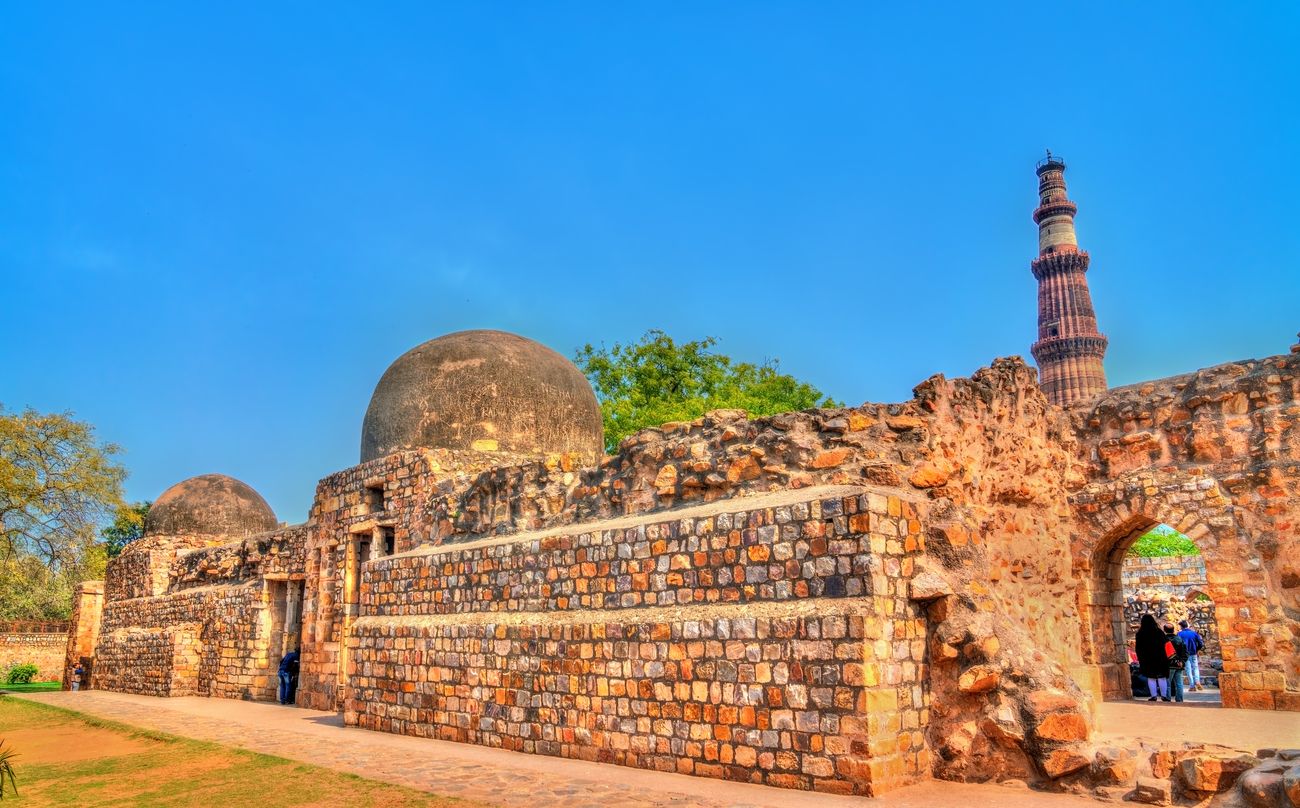
What we see here – the idea of combining a madrasa (Islamic school) and a tomb of Alauddin Khilji– is a first in India © Leonid Andronov.
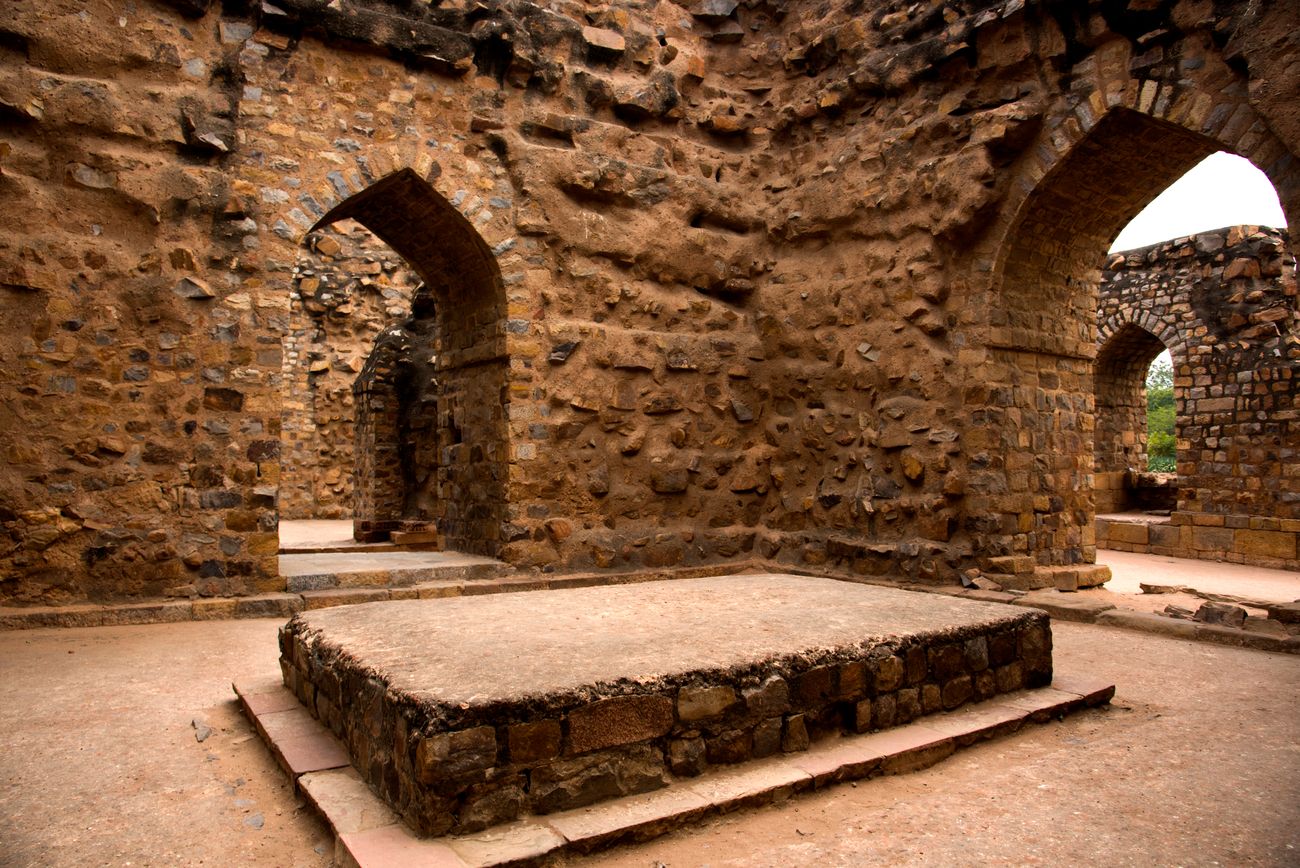
25 ALAUDDIN’S RESTING PLACE: A small mihrab for offering prayers is situated at the western wall of Alauddin Khilji’s tomb © CRS PHOTO
Iltutmish’s Tomb
Shamsuddin lltutmish succeeded Qutbuddin Aibak and in 1235 constructed this tomb for himself. The tomb is situated to the northwest of the Qutb complex close to the very extensions he made to the Quwwat-ul-lslam Masjid. Initially, the tomb was covered by a dome, which was propped by “squinch arches” a kind of true arch. However, because the local artisans had limited knowledge about how to build true arches, the dome collapsed.Unlike many of the structures in India, the outer walls of this tomb are not decorated; they carry bands that are simply carved. Quite the contrast is the tomb’s interior, which is splendidly decorated with geometric and arabesque designs, as well as Quranic engravements in Naskh and Kufic lettering.
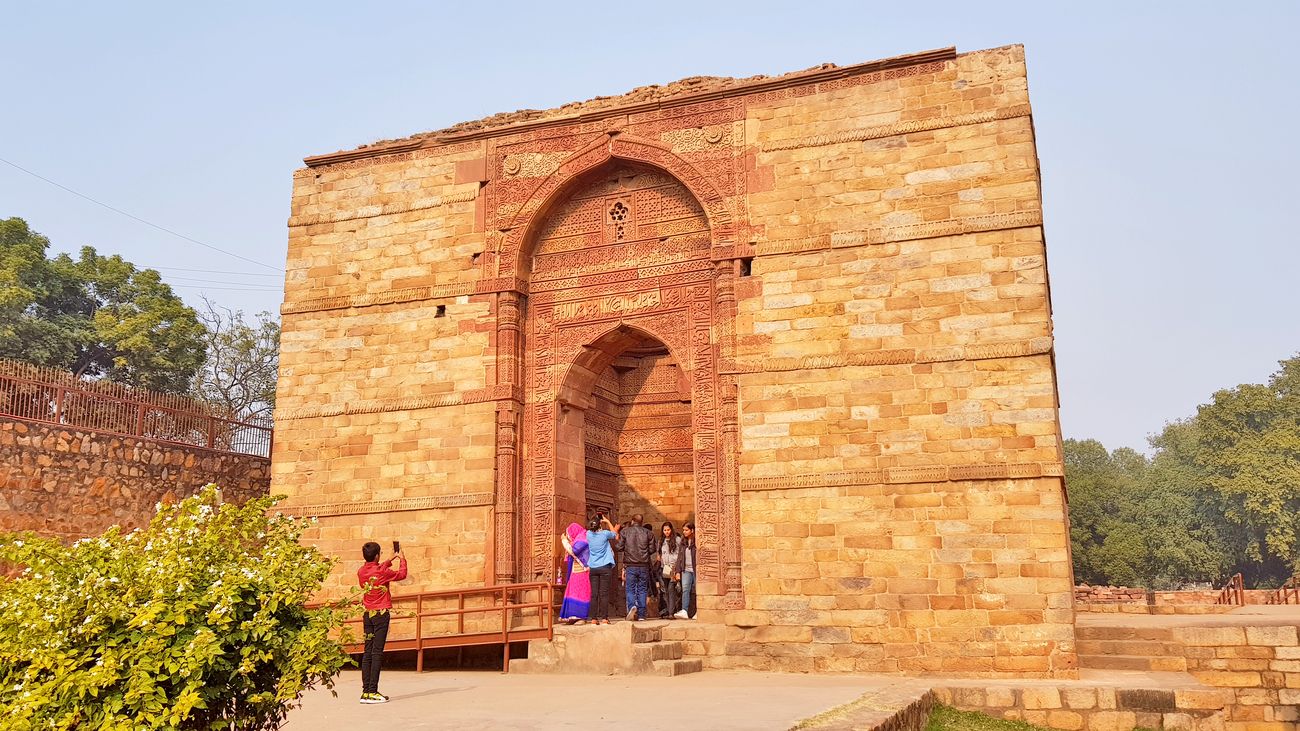
Each side of this square tomb with the unadorned exterior has a length of 9m (29.5ft). The entrances, which were once covered by domes are located on three sides © mdsharma
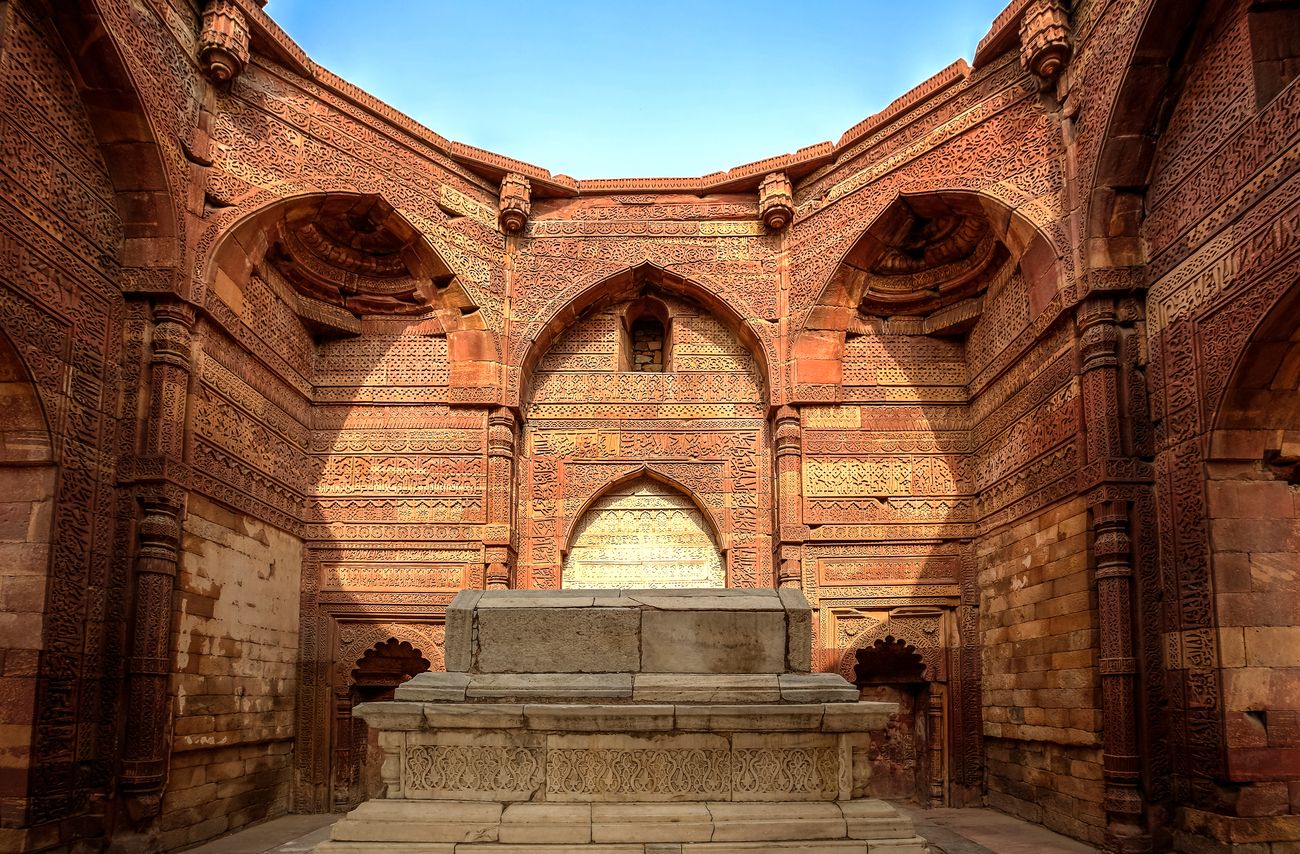
In the center of the exposed tomb chamber is a marble cenotaph. The grave or the kabr itself is in the crypt, which is circled by exquisitely decorated arches © Catalin Lazar
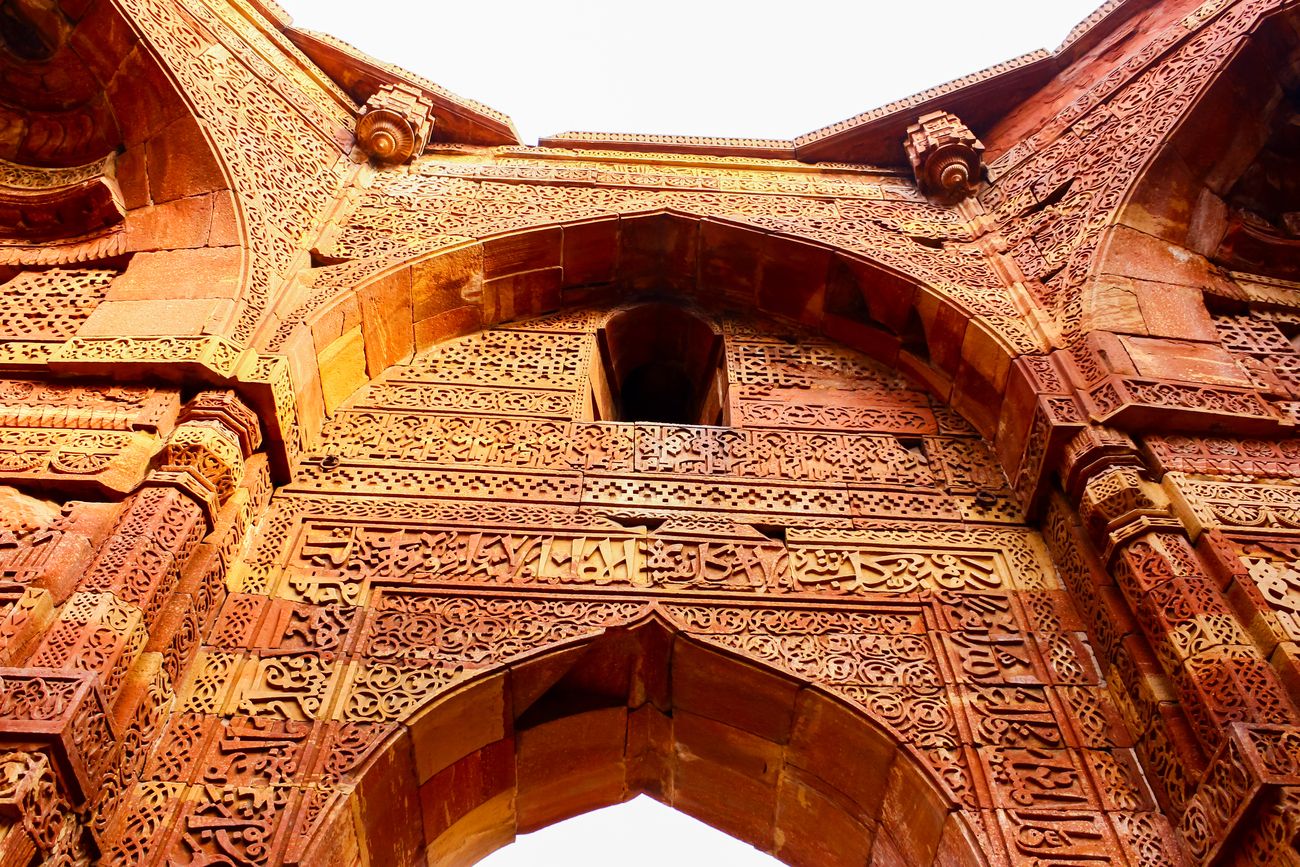
Persian calligraphy and Hindu motifs on the walls of the arches of illtumish tomb, Qutub Minar Complex © Arun Kumar K V
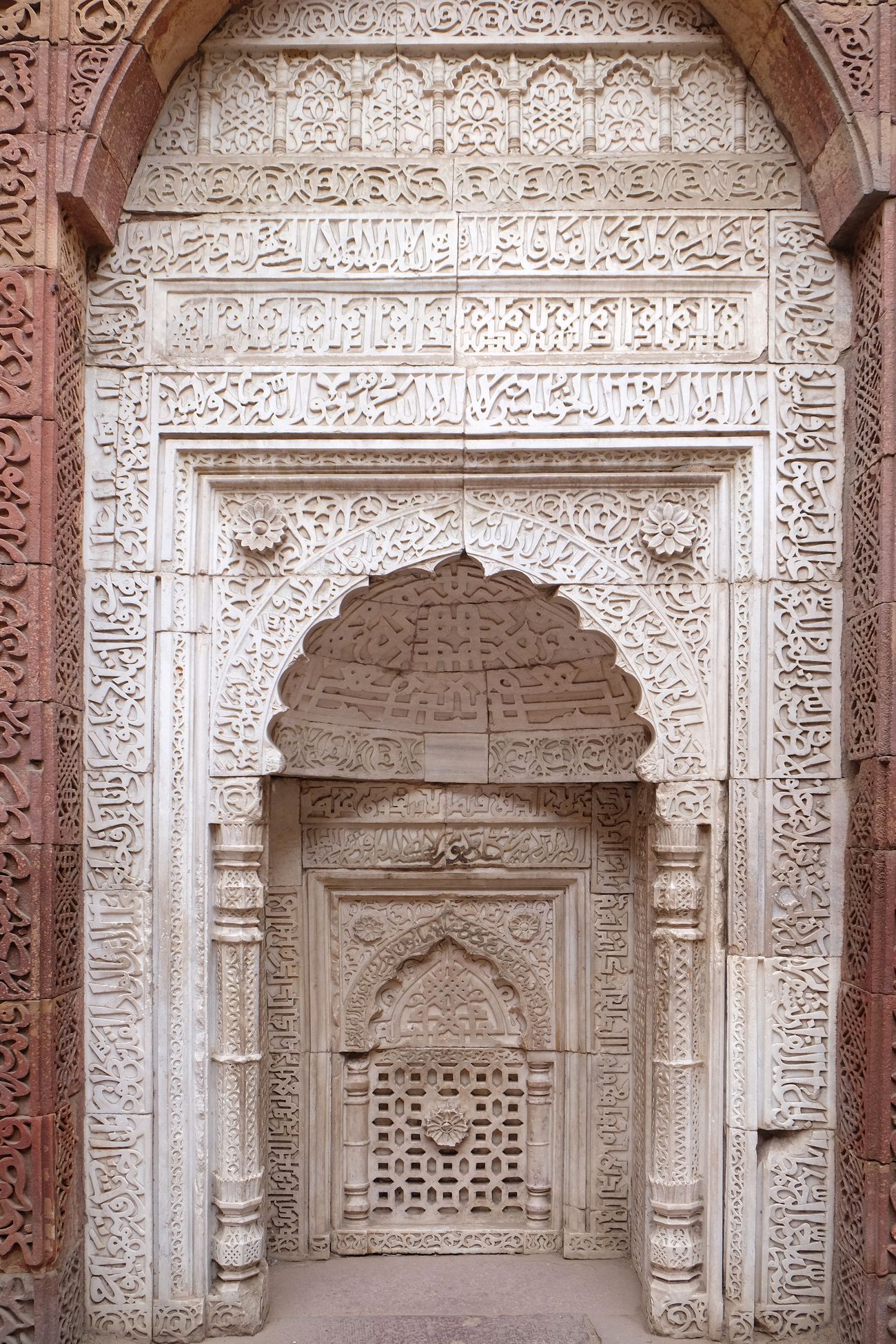
The western wall is closed; there, you will find the three mihrabs – niches in the wall of the mosque facing Mecca. The one in the middle is made of marble and the pillars, panels, and arches are beautified with floral and geometrical carvings. © Zvonimir Atletic
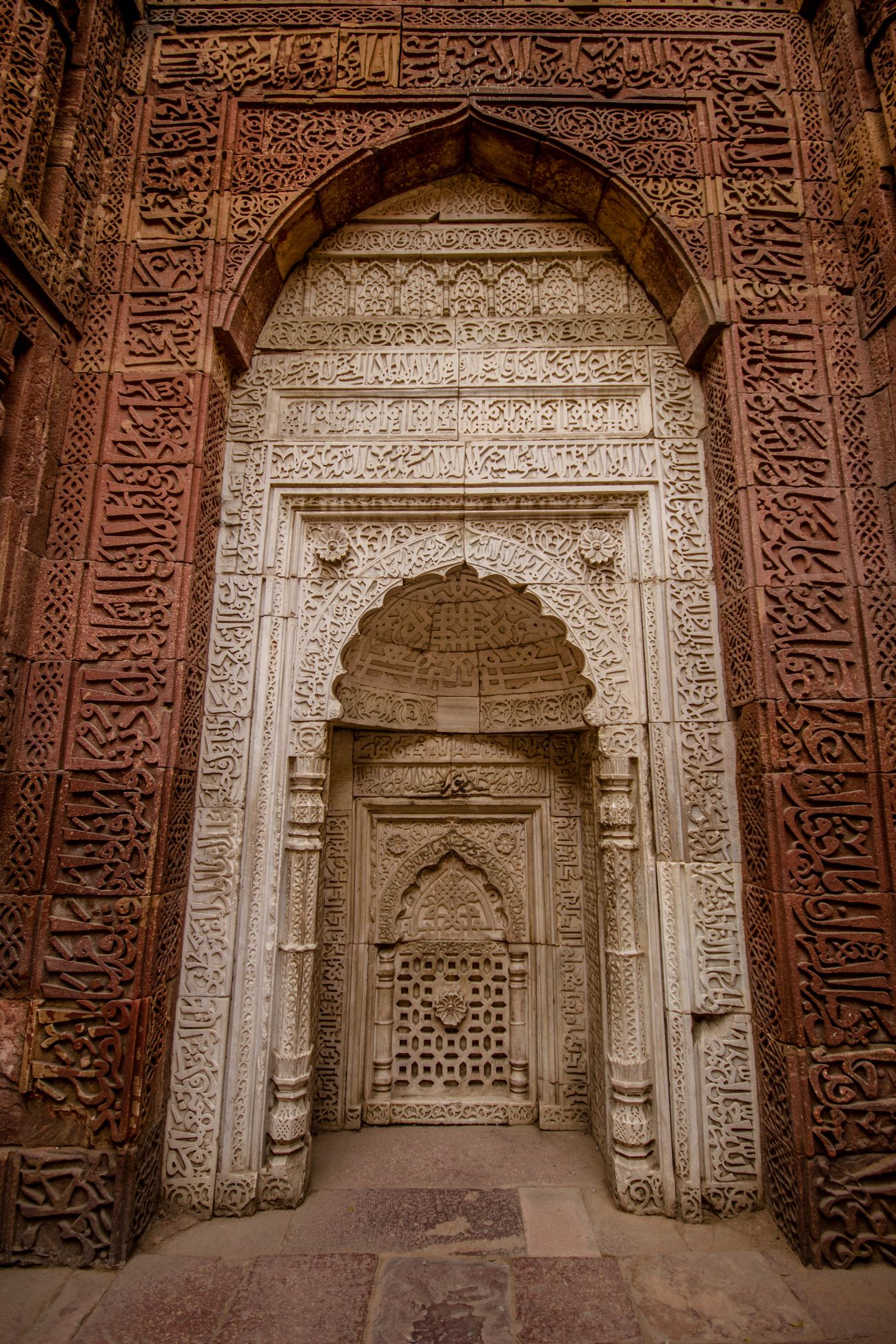
RICHLY ORNAMENTED ARCHES: The three arched doorways of lltutmish’s tomb are full of engraved calligraphic inscriptions and floral designs. These accentuate the structure and bring balance to the generally simplistic facade. © Kattiya.L
The Alai Minar is not far away from the Quwwat-ul-lslam Masjid and Alauddin’s madrasa. In fact, it requires just a short stroll to get there. You will notice that this minaret is unfinished. Alauddin Khilji built the first storey in 1315, but he died in 1316 before he could develop it any further. The structure is 24.5m (80ft) tall. The original plan was to build it two times the height and size of the Qutb Minar. It was a part of Alauddin Khilji’s great project to expand the Ouwwat-ul-lslam Masjid to twice the size it was originally. The Alai Minar was built on a high platform
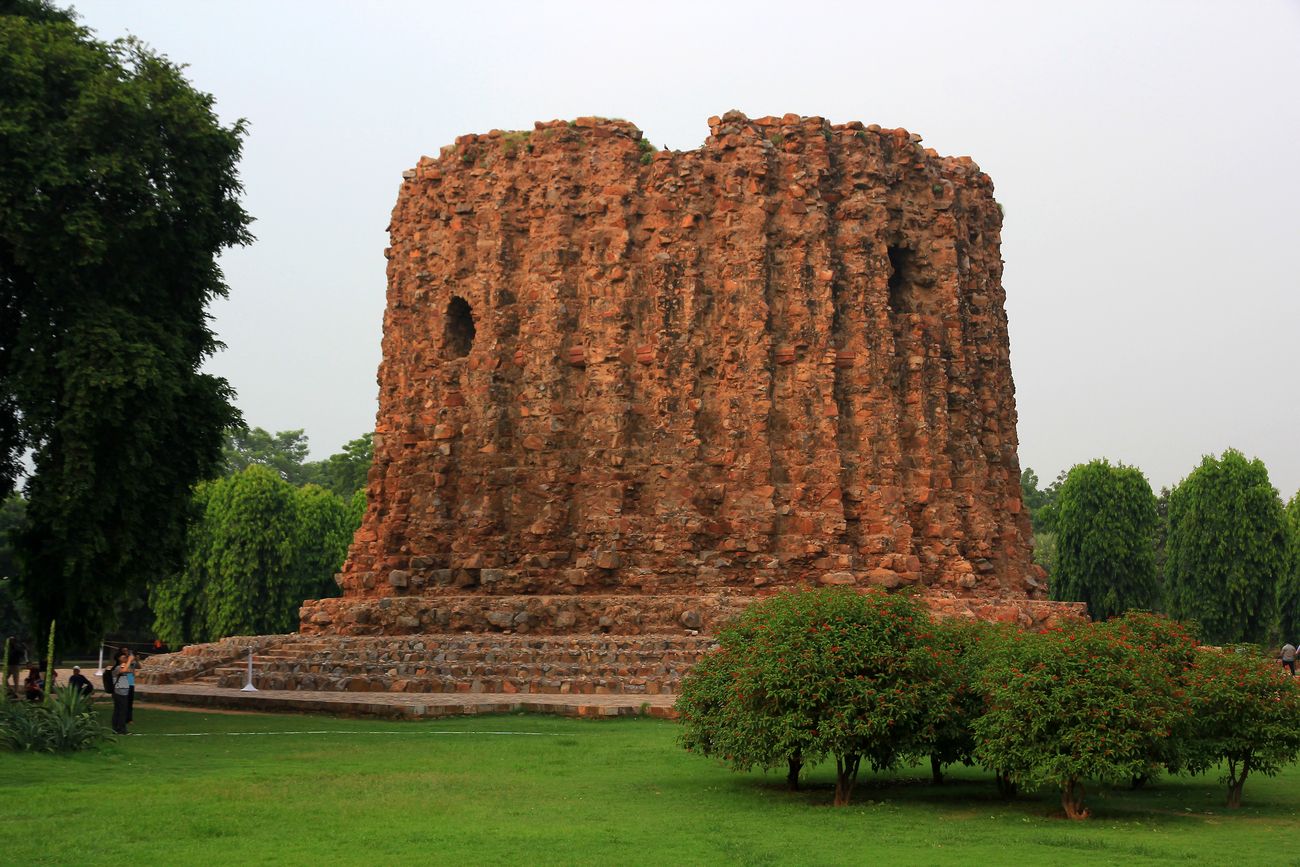
THE SECOND MINAR: Angular grooves forming decorations at the surface are on the outside of this unfinished structure. It also has an entrance on the east, and a ramp that inclines gently on the interior. This gives us a good picture of what the Qutb Minar looked liked at its inception. There is also an unfinished foundation made of sandstone debris. © AntonBkrd
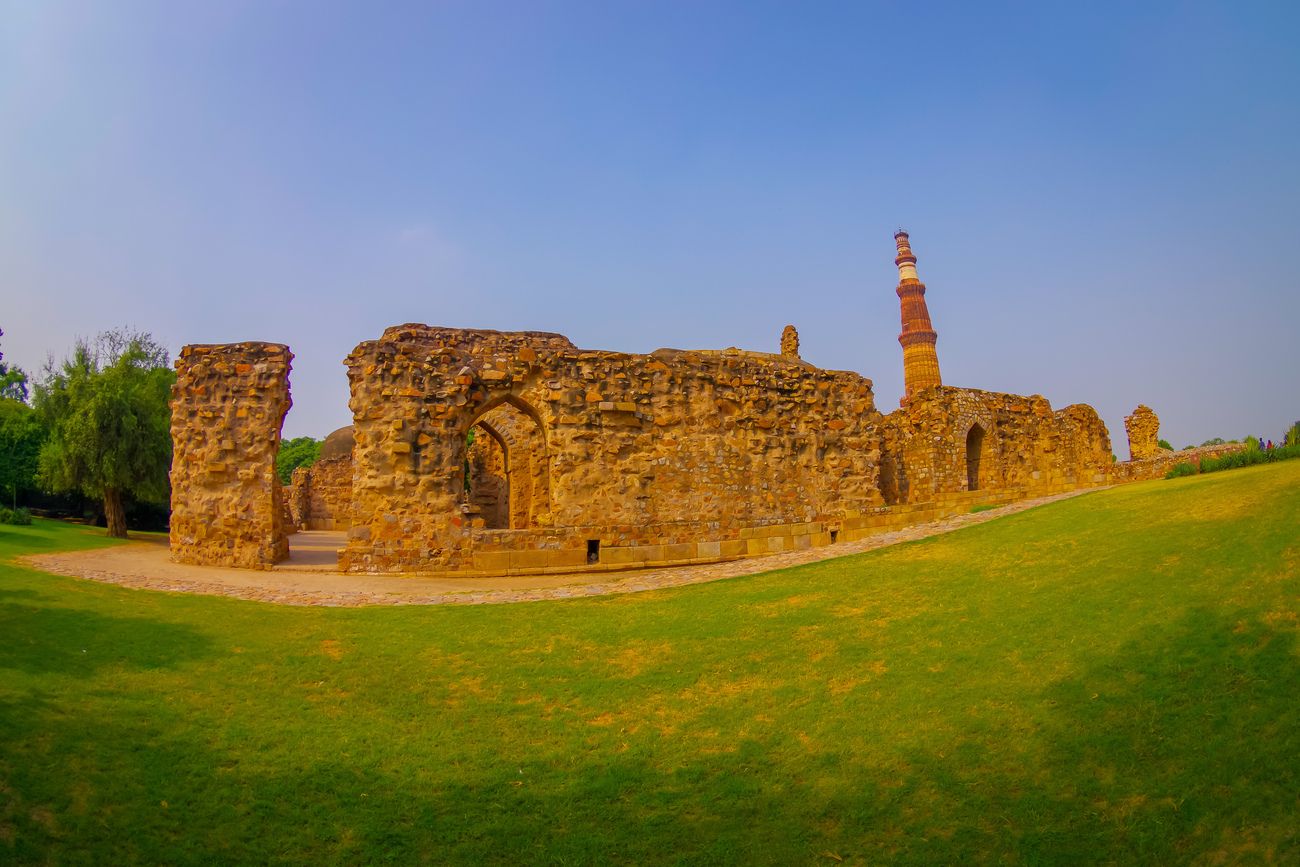
LUSH GREENERY: Visitors can be calmer, more relaxed and happier on the lawns of this lush, peaceful space of the Qutub Minar Complex © Fotos593.
Tourist information
By Air: If you are an international traveler, you can visit New Delhi through the Indira Gandhi International Airport. Local travelers can board flights to and from the domestic terminal of the IGI Airport.
By Rail : If you are travelling by train, all the cities in India are connected to New Delhi by the Indian Railways.
By Road: All the cities in India are connected to New Delhi by road. Taxis, auto rickshaws, and luxury coaches buses are easily available for a fee to take you to the Qutb complex.
Visitor’s checklist
Between the months of October and March are the ideal times of the year to visit Delhi. Visitors are welcome to visit the Qutb complex from Sunrise until Sunset each day. The fees to enter are different for visitors and citizens. If you are a citizen of India or ana SAARC country (South Asian Association for Regional Cooperation), the entrance fee is Rs 50 per head. For visitors from other countries, the fee is around US $8 or Rs 600 per head. You will be happy to know you are allowed to take photographs in the Qutb complex, so do don’t forget to bring your camera with you. Below, we have outlined a few of the important items you should travel with when visiting India.
↳ Water to drink, torchlight, sunblock, mosquito repellent, map or guidebook, loose change ↳ In the summer, travel with light cotton clothes to beat the heat and in the winter, woolen clothing to keep you warm; credit cards or travelers’ cheques (optional, but recommended) umbrella or raincoat, hat, and footwear you can easily take off ↳ The restroom, baggage counter and parking area is located near the ticket counter. Please be aware that food is not allowed inside the complex ↳ Entrance is free for children under the age of 15 (Indian and Foreigners) ↳ A separate line is reserved for foreign visitors. This will reduce your waiting time There are a number of organized tours through the Qutub Minar Complex, if you are interested.
Places to Visit in the Vicinity
Although Delhi’s popular tourist attractions are not located near-by, there is still plenty to see and do in the Mehrauli area. Next to the Qutub Minar lies the Mehrauli Archeological Park where more than a hundred historical relics like tombs, stepwells, mosques and palaces, some dating back a thousand years can be viewed. The park can be visited free of charge every day between sunrise and sunset
Share this post
You may also like.
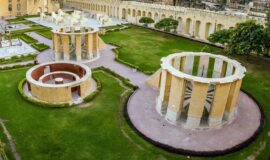
Related Tours

© ALL CONTENT COPYRIGHT UNDER DIGITAL MILLENNIUM COPYRIGHT ACT (DMCA)
ALL RIGHTS RESERVED - PHOTOGRAPHS AND WRITTEN CONTENT CANNOT BE REPRODUCED WITHOUT OUR PERMISSION.
Cookie Settings
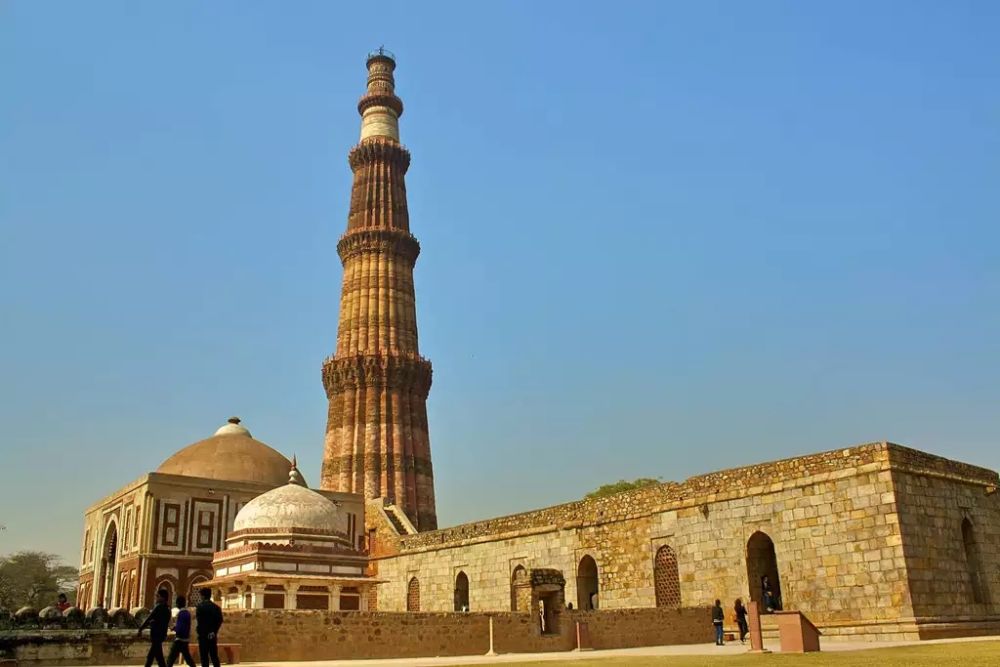
Best Time To Visit Qutub Minar Delhi
- Qutub Minar Delhi
- Things to do
- Best time to visit
- How to Reach
- Tourist Map
- within 25kms
- within 50kms
- within 100kms
- within 150kms
- within 200kms
- within 250kms
- within 300kms
- within 500kms
Best Time to Visit Qutub Minar in Delhi, India
The ideal time to visit Qutub Minar in Delhi is during the cooler months of October to March. Delhi's weather during this period is pleasant, with the monsoon having departed and the scorching heat of the summer months not yet arrived. The temperature ranges typically between 8°C to 24°C, providing a comfortable environment for tourists to explore and admire the architectural marvel of Qutub Minar. This period also witnesses several cultural events and festivals, which add to the charm of visiting the historic site. Visitors can enjoy the intricate carvings and the lush green landscape surrounding the monument without the discomfort of extreme temperatures.
Moreover, the winter season, particularly between November and February, is perfect for photography enthusiasts who are drawn to the detailed architecture of Qutub Minar. The soft sunlight of the cooler months casts beautiful hues on the monument, creating a perfect backdrop for memorable photographs. Visitor footfall is comparatively high during weekends and public holidays during this season, so it is advisable to plan your visit on a weekday for a less crowded experience. Keep in mind that the monument opens around sunrise and closes just before sunset, so timing your visit accordingly can help you witness the grandeur of Qutub Minar bathed in natural light.
Monthwise temperature in Qutub Minar Delhi
Explore Places to Visit Near Qutub Minar Delhi by Type
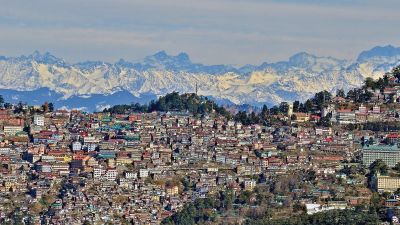
Other Suggested Reads for Qutub Minar Delhi
- About Qutub Minar Delhi Tourism
- Things to do in Qutub Minar Delhi
- How to Reach Qutub Minar Delhi
- Qutub Minar Delhi Tourism History
- Food in Qutub Minar Delhi
- FAQS about Qutub Minar Delhi
- Qutub Minar Delhi Tourist Map

- Qutub Minar, Delhi
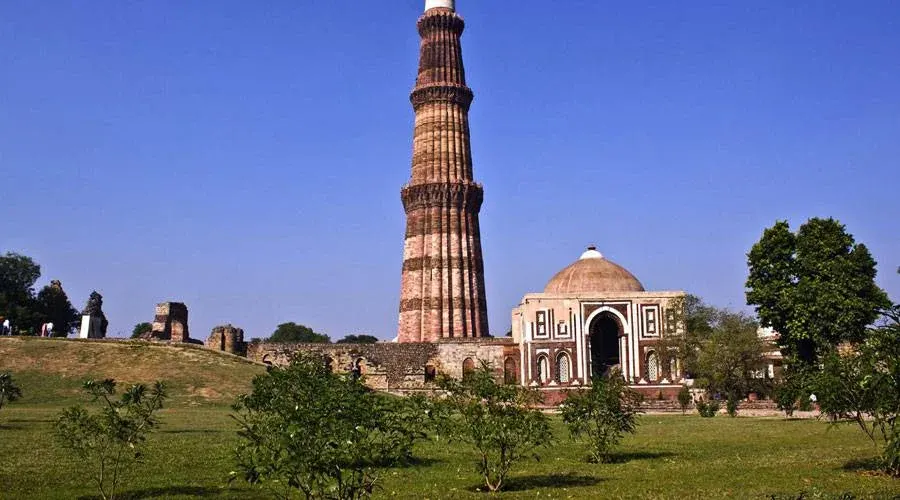
Qutub Minar is a minaret or a victory tower located in Qutub complex, a UNESCO World Heritage Site in Delhi's Mehrauli area. With a height of 72.5 meters (238 ft), Qutub Minar is the second tallest monument in Delhi. Its construction was started in 1192 by Qutb Ud-Din-Aibak, founder of Delhi Sultanate after he defeated the last Hindu Ruler of Delhi. He constructed the basement, after which the construction was taken over by his son-in-law and successor Iltutmish who constructed three additional stories. The fourth and fifth stories were built by Firoz Shah Tuglak.
A UNESCO World Heritage Site, Qutub Minar has always been shrouded in mysteries galore and conflicting views. According to historians, the minaret was named after Qutb-ud-din Aibak, responsible for erecting the monument while some others opine that it was named after Khwaja Qutb-ud-din Bakhtiar Kaki, who was a saint from Baghdad held in high regard by Iltutmish. The Alai Minar was to be the tallest tower in the world twice the size of Qutub Minar envisioned by Alauddin Khilji but post his death his ambitions were never carried on by anyone. Today Alai Minar stands at 27 meters to the north of Quwwat-ul-Islam Mosque and Qutub Minar. One of the last remaining monuments depicting the Afghan-styled architecture, Qutub Minar was inspired by the Minaret of Jam in Afghanistan.
Built as a symbol of victory for Muslim invaders over the Hindu land, Qutub Minar served as a victory tower when Muhammad Ghori took over the Rajput king, Prithviraj Chauhan, in 1192. Later Ghori’s viceroy, Qutb-ud-din Aibak, who went on to become the first ruler of the Mamluk dynasty began the construction of Qutub Minar. The minar has endured the forces of nature and time - it is said to be struck by lightning in 1368, which damaged its top storey, which was later replaced by the existing two floors by Firoz Shah Tughlaq. Then in 1803, an earthquake jolted the minaret, and the then major in the British Indian Army, Robert Smith renovated the tower in 1828 and even installed a cupola over the fifth floor which added another storey to the tower. But in 1848 then Governor-General of India, Viscount Hardinge instructed to take down the cupola and place it at the ground level to the east of Qutab Minar where it exists even today and known as Smith's Folly. This is one of the reasons why the structure has a varied architectural facade ranging from the time of Aibak to that of the Tughlaq dynasty.
Architecture
Qutub Minar has taken architectural and design influences from Minaret of Jam in Afghanistan. The lotus borders carvings, garlands, and looped bells were incorporated from the local sensibilities. The tower has five tapering storeys superposing with a spiraling staircase of 379 steps. The lower three storeys consist of cylindrical hilts of red sandstone, separated by rims and balconies, with Muqarna truss. The fourth column is made of marble and the fifth is built of marble and sandstone with engravings of Quranic texts and decorative motifs. There are inscriptions in Nagari and Parso-Arabic characters on the walls of Qutab Minar which document its construction and reconstructions by Tughluq and Sikandar Lodi between 1381-1517.
The minar is said to be tilting about 65 cm from the vertical but is considered safe with the experts wanting constant monitoring so that the rainwater seepage doesn't affect its base. Back in the day and even today Qutub Minar stands as an inspiration for several towers and minarets built after it. Chand Minar built-in 1445 in Daulatabad, Maharashtra was inspired by Qutub Minar. Visit the minar today to experience its beauty. You can visit other monuments in Mehrauli like Jamali Kamali mosque or Balban’s tomb.
Qutub Minar is open from 7:00 AM to 5:00 PM on all days of the week.
The best time to visit Qutub Minar is November to March.
Seth Sarai, Mehrauli, New Delhi, Delhi 110030
Quwwat-ul-Islam Mosque
Located within the Qutub Minar complex at Mehrauli in Delhi, the Quwwat-ul-Islam Mosque (translating to ‘Might of Islam’) was built by the Mamluk ruler Qutub-ud-din Aibak. Yet another feather in the cap of Delhi, the monument is the first mosque to be built in the city after the Islamic conquest of India and is known as a celebration of Muslim Rule. Also known as Jami Masjid, the construction of the mosque began in 1193 AD; and the ancient mausoleum is also the oldest surviving testament of the Ghorids architecture in the Indian subcontinent. Subsequent additions were made to the monument later, during the reigns of Iltutmish and Alauddin Khilji. Initially, the idea of the mosque was conceived as a stand-alone structure but later, Qutub Minar was constructed along-side simultaneously as a ‘Minar of Jami Masjid” with the idea for the priest to perform again- call-out for namaz.
Iron Pillar
Iron Pillar is one of the many mysterious monuments of wonder present in Delhi- the capital of India. Located within the Qutub Minar complex in the Mehrauli area of New Delhi, the Iron Pillar has been posing as one of the foremost metallurgical curiosities of the world due to its prowess to not exhibit a speck of rust despite being thousands of years old. Made with 98% wrought iron and withstanding over 1600 years of withering, the pillar still stands sturdy and resists corrosion. However, a few studies in recent times suggest that the incorrigible nature of the monument is due to a thin layer of crystalline iron hydrogen phosphate hydrate forming on the high-phosphorus-content iron, which serves to protect it from the effects of the humid climate and weather conditions.
Dating back to sometime during the 4th century AD, the inscriptions borne on the pillar suggest that the pillar was originally constructed as a flagstaff in honor of the Hindu God Vishnu and the memory of the famous Gupta King Chandragupta II. Weighing approximately 6000 kgs, the precise date and place of creation of the pillar are still disputable. Before the metal fence was created around it, you could see a group of tourists, with their backs, turned to the pillar, try to touch both their hands circling the pole. Anyone who could touch their hands was considered lucky.
Among the many historical monuments present within the Qutub Minar complex, Alai Minar stands apart as it has been left incomplete. Alai Minar was designed to be two times higher than the Qutub Minar and well proportioned with the Quwwat-ul-Islam mosque in the area. The idea was however abandoned and as of now, the building is an 80 feet high, mammoth rubble masonry, finished only up to one story. The unhewn structure stands bare and suggests the creator’s intentions to be adorned with dressed stones and fancy architecture. The construction was not taken up by the descendants of the Khilji dynasty and eventually, the minar was left unaddressed and neglected. But, even though in a derelict and decrepit state, the monument resonates with the majesty and the magnificence of the bygone era.
Tomb of Adham Khan
Adham Khan's Tomb located in the North of Qutub Minar is a 16th-century tomb of Adham Khan. He was a general of the Mughal Emperor Akbar.
Near by Places in Delhi
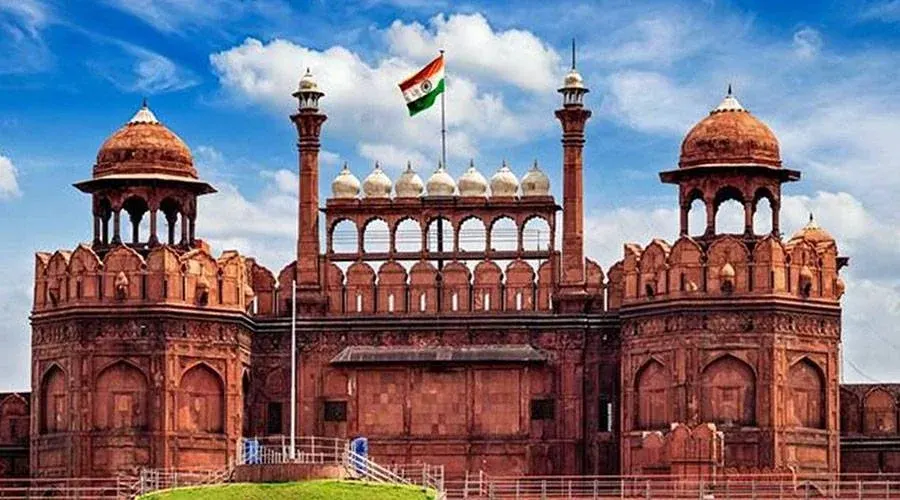
- Red Fort, Delhi
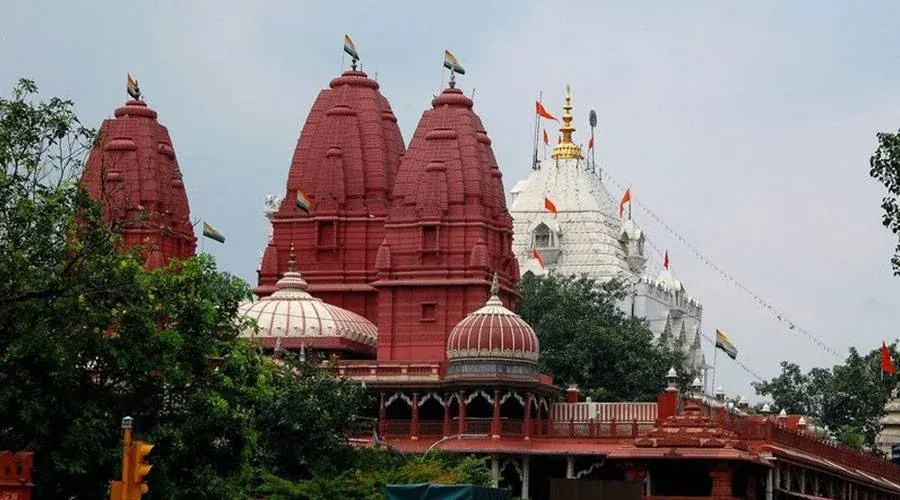
Sri Digambar Jain Lal Mandir, Delhi
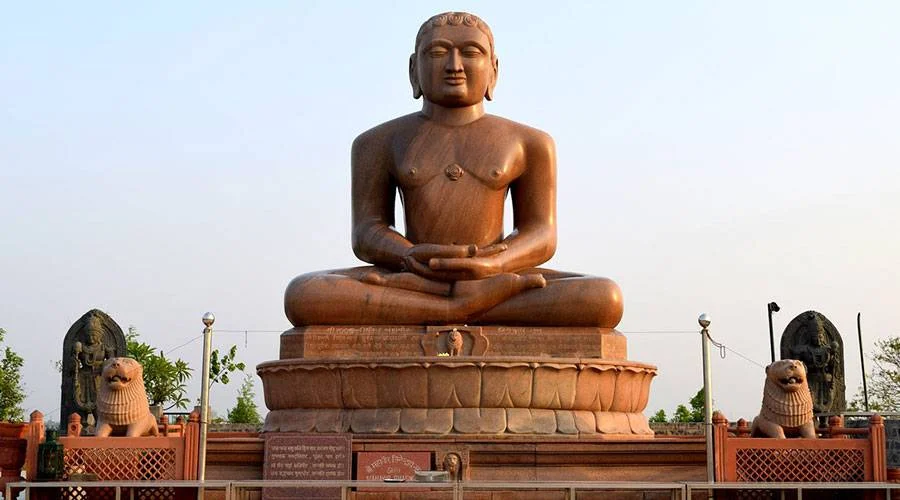
Ahinsa Sthal, Delhi
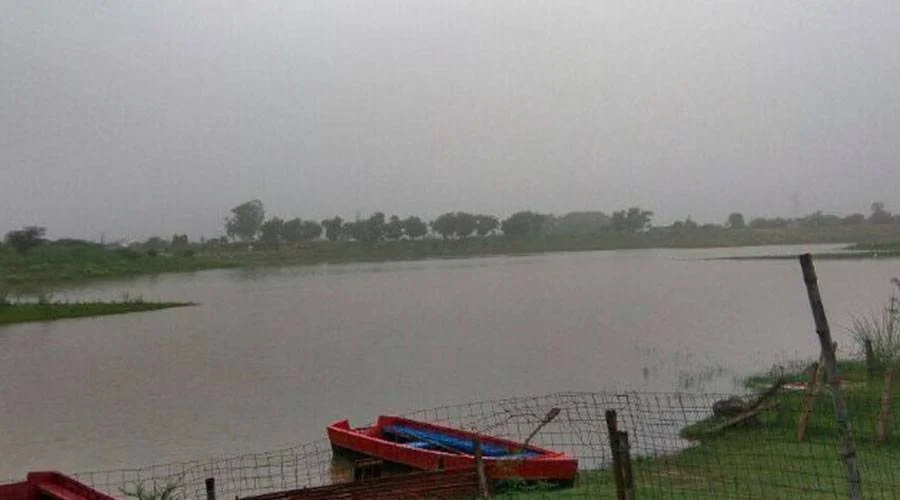
Damdama Lake, Delhi
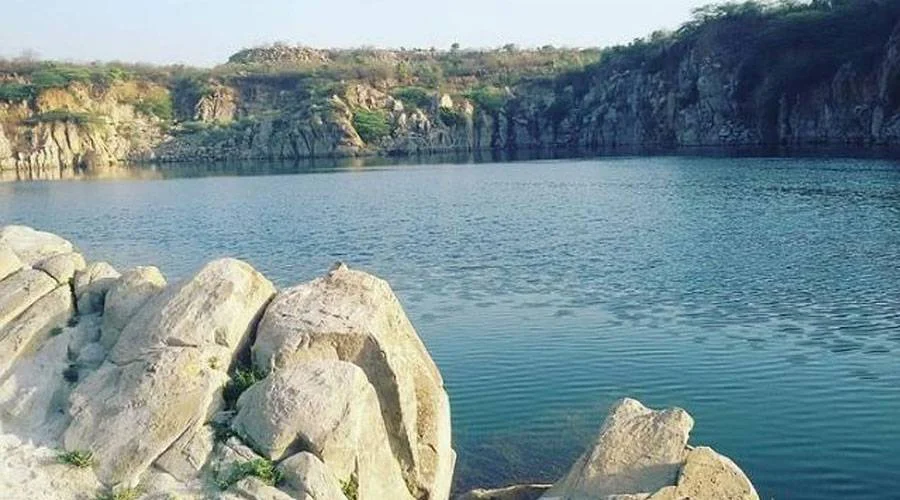
Surajkund Lake, Delhi
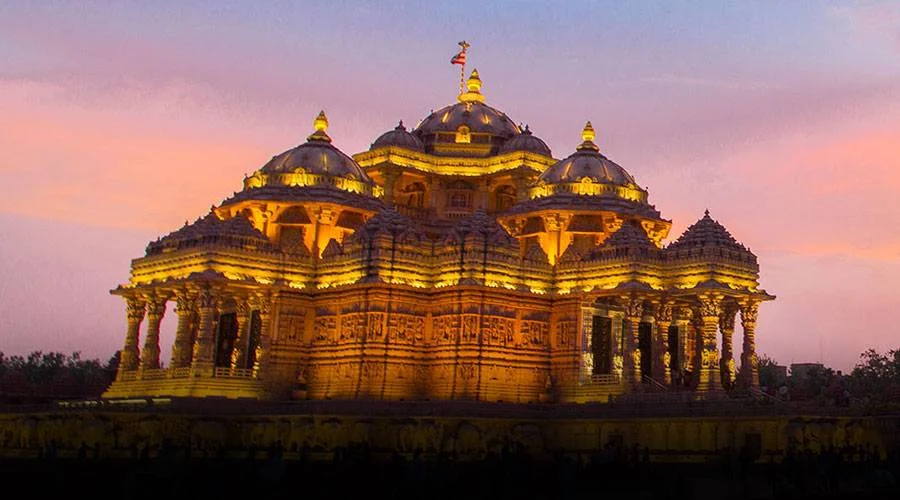
- Akshardham Temple, Delhi
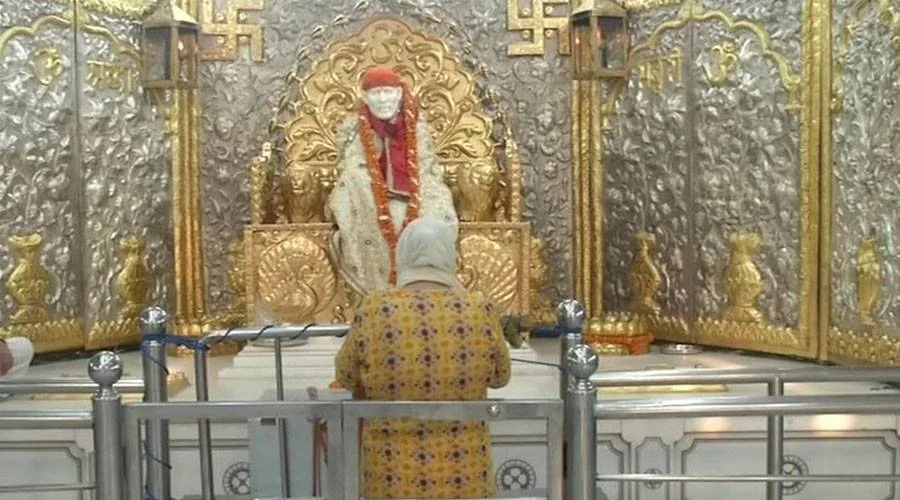
Sai Baba Mandir, Delhi
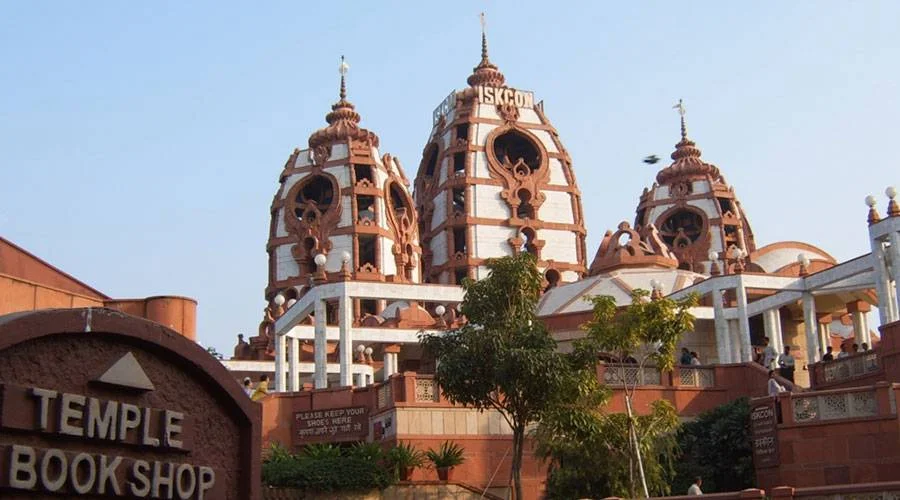
- ISKCON Temple, Delhi
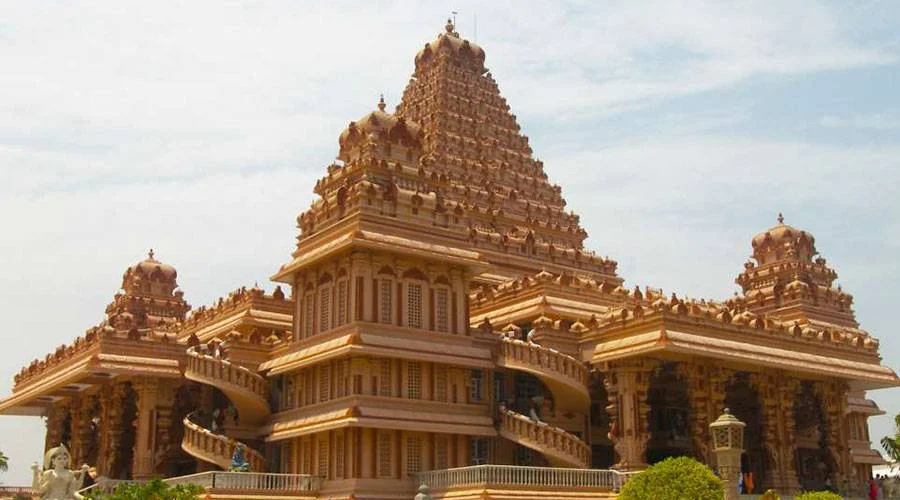
- Chhatarpur Temple, Delhi
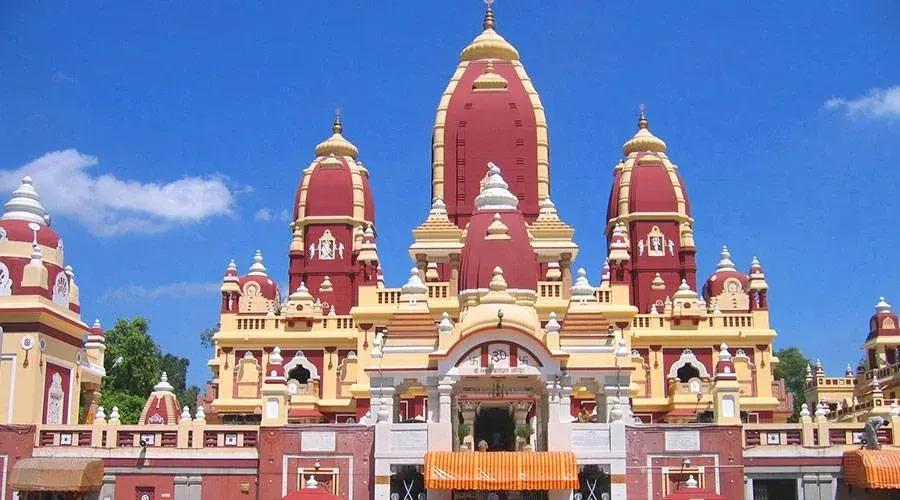
- Birla Temple, Delhi
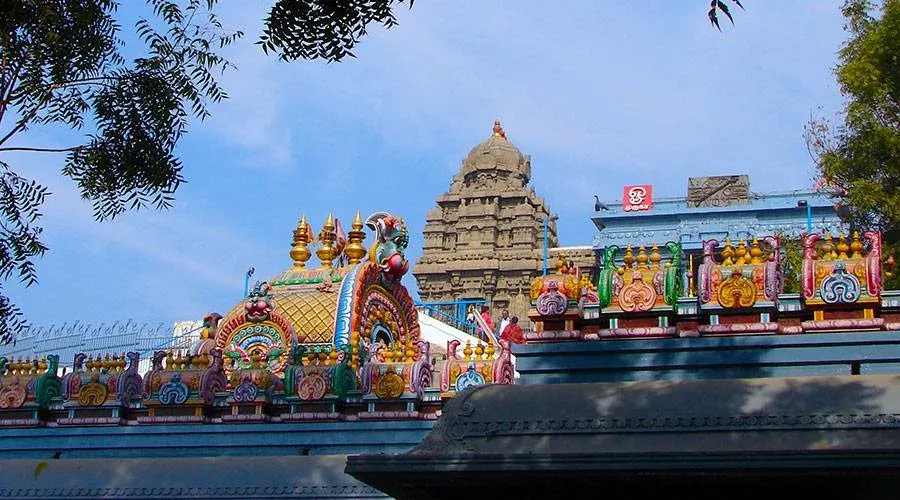
Malai Mandir, Delhi
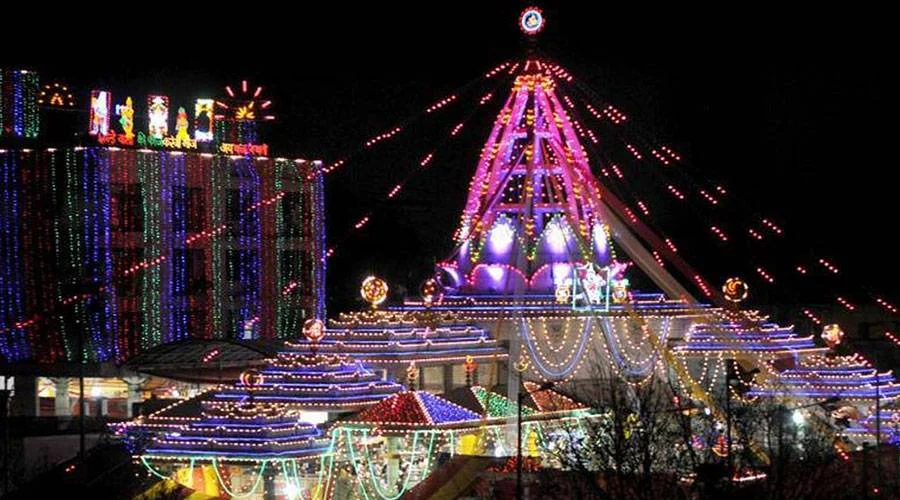
Jhandewalan Temple, Delhi
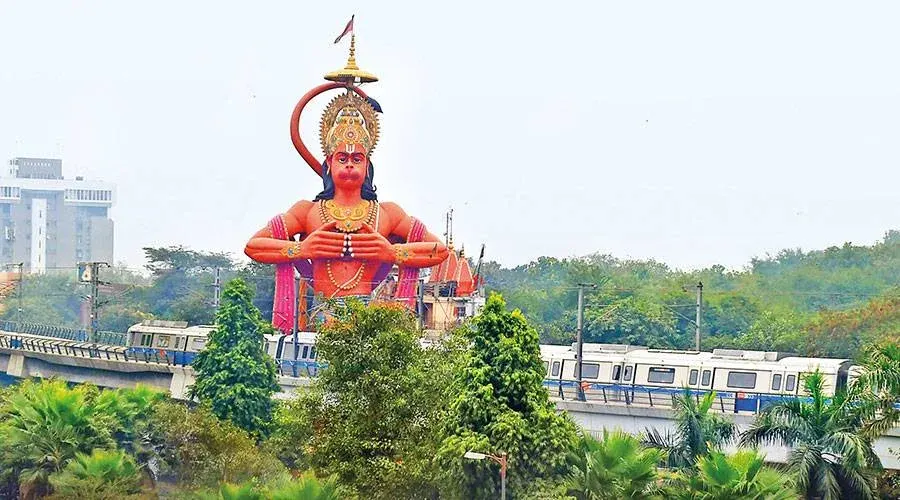
- Jhandewalan Hanuman Temple, Delhi
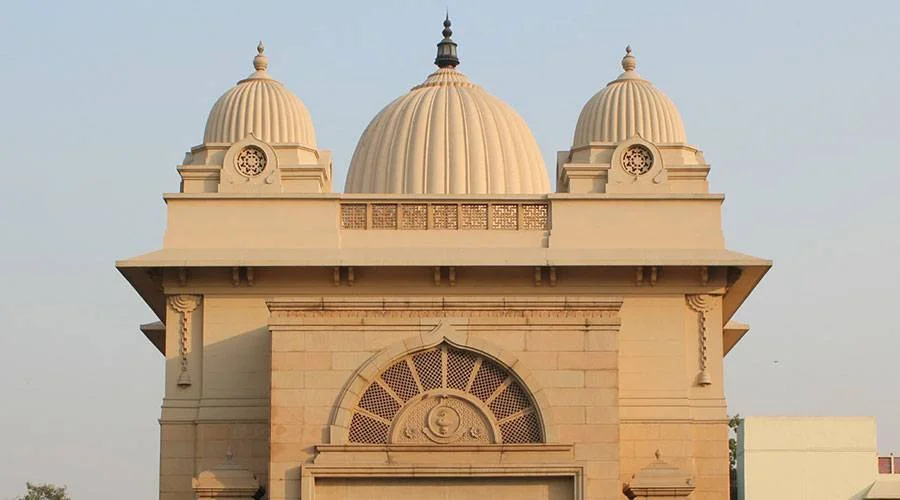
Ramakrishna Mission, Delhi
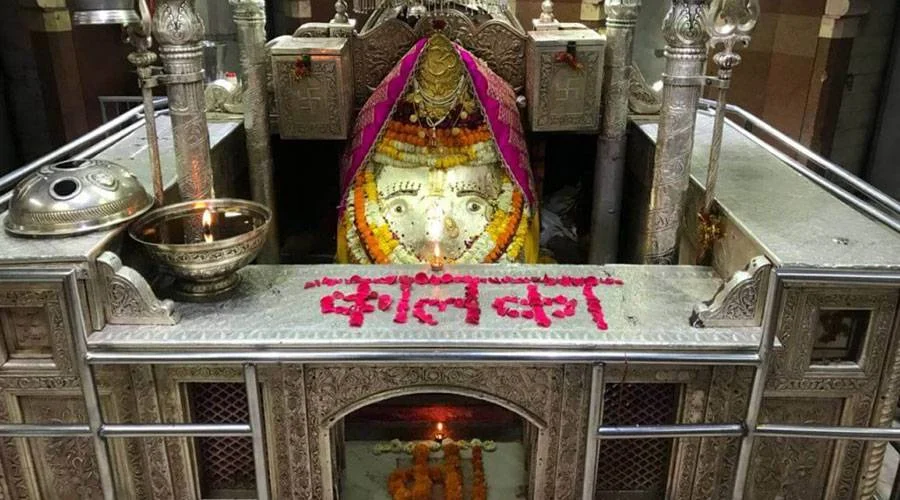
Shri Kalkaji Mandir, Delhi
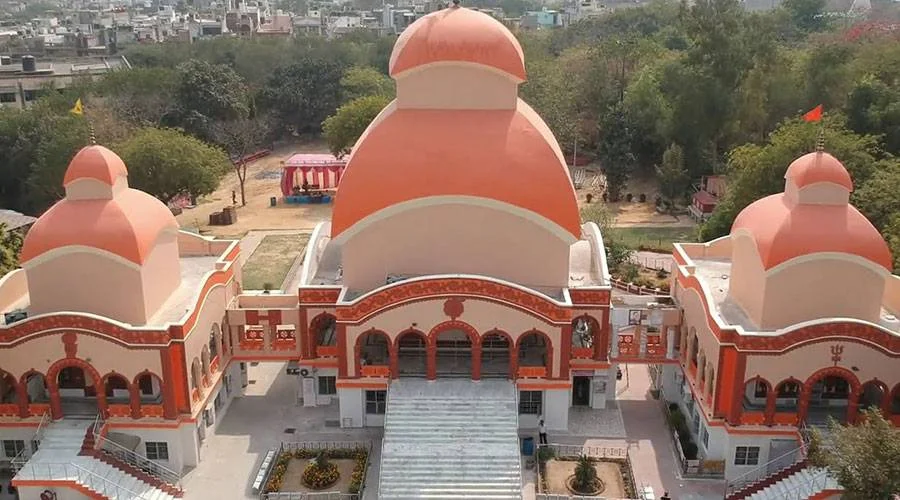
Chittaranjan Park Kali Mandir, Delhi
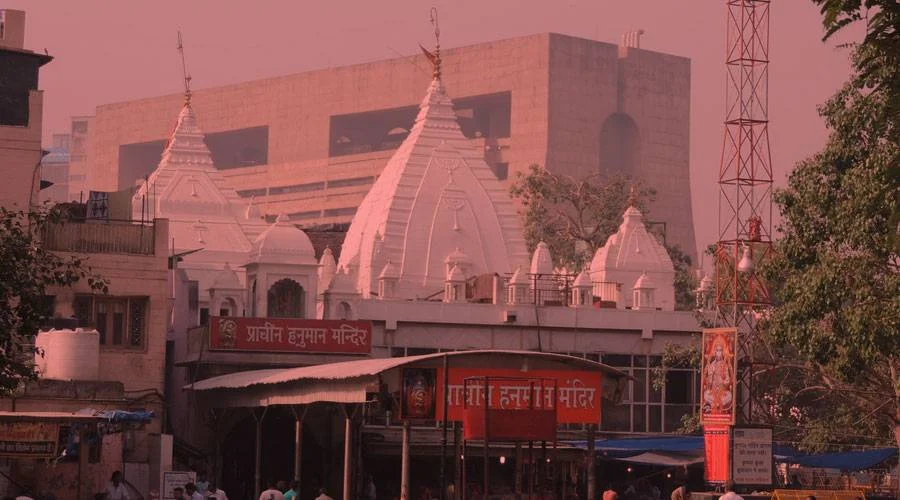
Hanuman Temple Connaught Place, Delhi
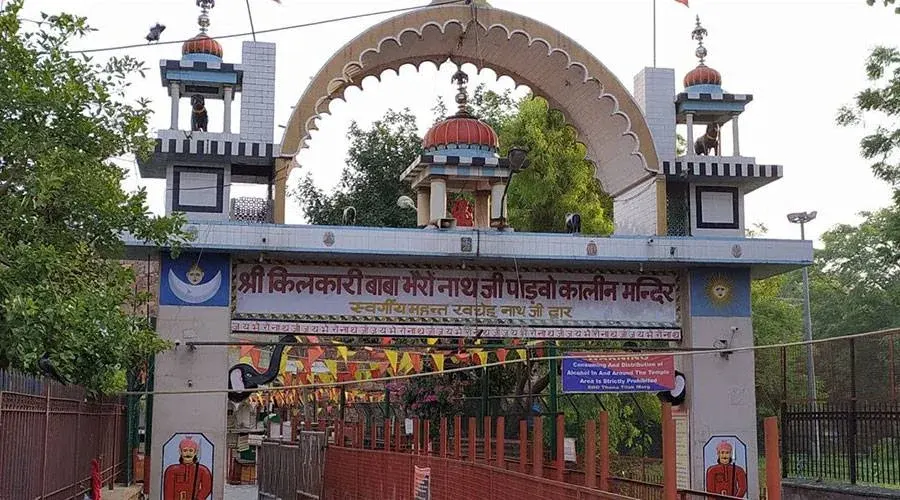
Kilkari Baba Bhairav Nath Temple, Delhi
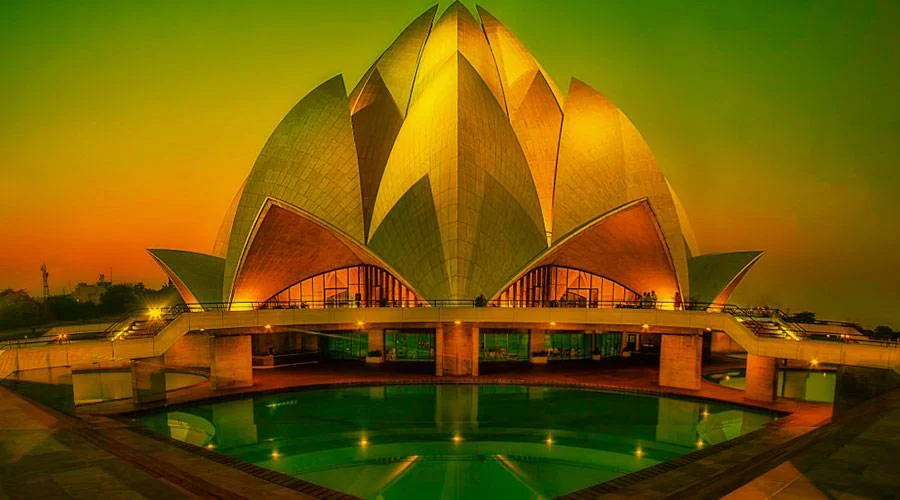
- Lotus Temple, Delhi
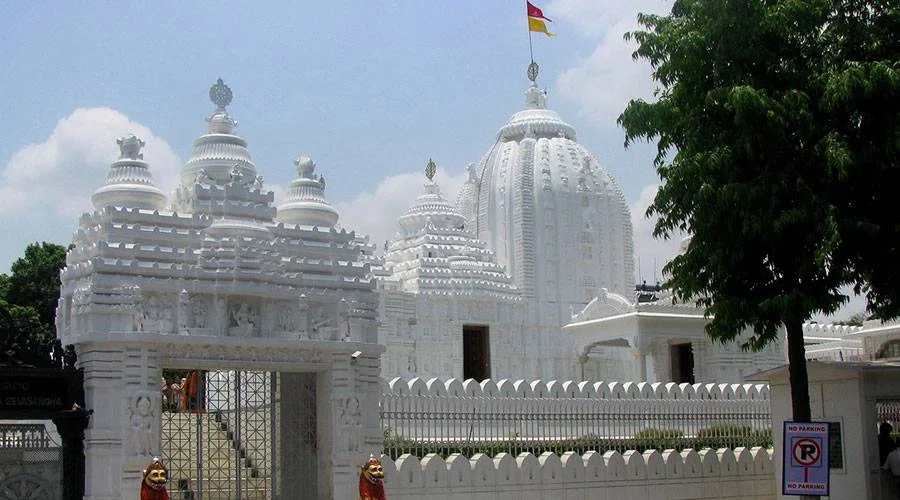
Jagannath Temple, Delhi
More tourist destination in delhi, heritage place in delhi, religious place in delhi, adventure place in delhi, ecotourism place in delhi.
- Dodital-Dayara Bugyal Trek, Uttarakhand
- Jim Corbett National Park, Uttarakhand
- Jogini Falls, Himachal Pradesh
- River Rafting Rishikesh, Uttarakhand
- Shiv Khori, Jammu And Kashmir
- Vaishno Devi Mandir, Jammu And Kashmir
- Vaishno Devi Temple, Uttarakhand
- Delhi Zoo, Delhi
- India Gate, Delhi
- Jantar Mantar, Delhi
- Purana Qila, Delhi
- Rajghat, Delhi
- Rashtrapati Bhavan, Delhi
- The Grand Venice Mall, Delhi NCR
- Gurudwara Bangla Sahib, Delhi
- Gurudwara Rakab Ganj, Delhi
- Gurudwara Sis Ganj Sahib, Delhi
- Jama Masjid, Delhi
Select Your Destination

Sustainable Tourism vs Balanced Tourism Growth
In the travel and tourism industry, distinguishing between sustainable and balanced tourism growth is crucial. While often used interchangeably, they ...

Kedarnath Yatra 2024: Opening and Closing Date of Kedarnath Temple
Kedarnath Yatra 2024, located in the Rudraprayag district of Uttarakhand, is one of the most paramount locations for worshipers of ...

Chaitra Navratri - Navratri is a mixed blend of various cultures and shares a common meaning, i.e. the victory of good over evil
Chaitra Navratri 2024 starts on April 09 Tuesday The word ‘Navratri’ comes from ‘Nav’ meaning ‘nine’ and ‘Ratri’ meaning ‘night’ ...

Vantara Jamnagar, the 3000-acre animal shelter launched by Anant Ambani in Jamnagar
Anant Ambani, the younger son of Mukesh Ambani, Chairman of Reliance Industries, has announced the launch of his ambitious wildlife ...

Holi 2024: The Festival of Colors
Holi Festival in India (also known as the Festival of Colors) is not only a festival about color but also ...
- Andaman and Nicobar Islands (Port Blair)
- Andhra Pradesh (Hyderabad)
- Arunachal Pradesh (Itanagar)
- Assam (Dispur)
- Bihar (Patna)
- Chandigarh (Chandigarh)
- Chhattisgarh (Raipur)
- Dadra and Nagar Haveli and Daman & Diu
- The Government of NCT of Delhi (Delhi)
- Goa (Panaji)
- Gujarat( Gandhinagar)
- Haryana (Chandigarh)
- Himachal Pradesh (Shimla)
- Jammu & Kashmir (Srinagar-S*, Jammu-W*)
- Jharkhand (Ranchi)
- Karnataka (Bangalore)
- Kerala (Thiruvananthapuram)
- Ladakh (Leh)
- Lakshadweep (Kavaratti)
- Madhya Pradesh (Bhopal)
- Maharashtra (Mumbai)
- Manipur (Imphal)
- Meghalaya (Shillong)
- Mizoram (Aizawl)
- Nagaland (Kohima)
- Odisha (Bhubaneshwar)
- Punjab (Chandigarh)
- Puducherry (Puducherry)
- Rajasthan (Jaipur)
- Sikkim (Gangtok)
- Tamil Nadu (Chennai)
- Telangana (Hyderabad)
- Tripura (Agartala)
- Uttarakhand (Dehradun)
- Uttar Pradesh (Lucknow)
- West Bengal (Kolkata)

IMAGES
VIDEO
COMMENTS
The opening time of Qutub Minar is 7 AM and it is best to visit the monument during early morning hours to avoid the crowd. The closing time of Qutub Minar is 5 PM. It is open all days of the week. The entry fee of Qutub Minar is Rs.35 per person for Indian residents, while for the foreign tourists, the ticket charges are Rs.550 per person.
Delhi's Qutub Minar is the tallest brick minaret in the world and one of the most popular monuments in India. Its rather dizzying height of 238 feet (72.5 meters) could be the size of a modern 20 story high-rise residential building! The monument's stark, soaring appearance evokes a sense of mystery, as do the extensive Hindu and Muslim ruins ...
The entry timings of Qutub Minar are from 7:00 in the morning to 5:00 in the evening but in order to increase the prospects of night tourism, the government also started nighttime exploration of the monument. Tourists can also admire the majestic structure of Qutub Minar under the evening sky from 8:00 PM to 10:00 PM. This initiative aims to ...
Qutub Minar is a good place to visit and spend about half a day. Qutub minar metro is about 1.5 km away and Saket is slightly more. ... visiting timings are from 7:00 am to 5:00 pm the best time to visit is during the Indian classical music festival which usually happens during the winter months of November or December. Read all replies.
The Qutub Minar is open everyday from 7am in the morning until 9pm at night. The site gets extremely busy during the weekends, so if you can, visit during the week. In any case we would recommend heading to the Qutub Minar first thing in the morning to minimise the heat and the crowds.
Final Thoughts: A Voyage Through Time and Culture. A visit to the Qutub Minar complex transcends conventional tourism; it's an odyssey through history, an ode to architectural brilliance, and a conduit to India's cultural mosaic. As the sun sets over the minar, casting a warm embrace on its surface, visitors depart with a lasting impression ...
How To Reach. The easiest and fastest way to travel from the Indira Gandhi International Airport in Delhi to the Qutub Minar is by taking a taxi from Terminal 2 of the airport. However, it can be expensive, and if you are looking for cheaper options, you can choose to travel by Subway. From the airport, you can take the subway to New Delhi and ...
Visit Timing: Sunrise to Sunset. Entry Fee: Indian citizens: Rs. 30/- and for foreign nationals: Rs. 500. Entry is free for children up to 15 years of age. How to Reach: By Metro - board from any DMRC station and reach Qutb Minar station and then follow rail map to reach the minar; by DTC buses; by Hop On Hop Off Sightseeing Bus Service offered ...
Best time to visit: Aim for early morning or late afternoon, when the sun's rays create a warm, golden glow on the monument, enhancing its natural colors and intricate details. ... The ideal time to visit Qutub Minar is between October and March, when the weather is more relaxed and more pleasant for outdoor exploration.
The best times to visit Qutub Minar are during the early morning or late afternoon to avoid the crowds and the heat. Visiting on weekdays rather than weekends can help you enjoy a more peaceful experience. The months of October to March, during the winter season, are generally considered the best time to visit Delhi. How To Reach Qutub Minar?
Best Time To Visit Qutub Minar . Since Delhi witnesses scorching temperature in summers, it is wise to explore and unveil the city in winters. October to March is the perfect time to visit Delhi. The tourists generally 2 hours to explore the Complex. Trivia About Qutub Minar . 1. Qutb Minar means pole or axis in Arabic.
The best time to visit Qutub Minar is between October and March. To avoid the crowd, visit during the weekdays. Avoid weekends & holidays. Qutub Minar timings and entry fee . The Qutub Minar timings say it is open from 9:00 am-5:00 pm daily. If you'd like to visit the Qutub Minar, your best bet is to go during off-peak hours when there won ...
Qutub is the highest tower in India and is an UNESCO World Heritage Site. It is among the must visit Delhi tourist places and one of the best heritage sites in Delhi city. It is also commonly featured in the promotion of Delhi Tourism. Qutub-ud-Din Aibak laid the foundation of Minar in 1199 AD for the use of the Mu'zzin (crier) to give calls ...
The Qutub Minar is open every day of the week and is open from 7:00 a.m. to 5:00 p.m. Because Delhi experiences scorching summer temperatures, the best time to visit Qutub Minar Delhi is during the winter season, when the weather is mild and nice for touring. The months of October through March are ideal for visiting Delhi.
Best time to visit Qutb Minar complex. It is advisable to visit Qutub Minar in winter as the cool weather makes it comfortable for sightseeing. The complex is open every day from 7 am to 5 pm. It opens up again at 7 pm in the evening for night viewing and closes back at 10 pm.
Entrance Fee: 30 per Indian and Rs.500 per foreigner. Visiting Time: Sunrise to Sunset. Visit Duration: 2 hours to 3 hours. The Qutub Minar is a world famed structure which stands tall within the capital of the country, Delhi. Located at Mehrauli, the minar is about 240 meters tall and has got five storeys with a staircase which spirals all the ...
Fee Indian/foreigner 30/500. Visiting Time 7:00 AM to 5:00 PM on all days of the week. Qutub Minar is a minaret located in the Qutab complex. It is a heritage site located in Delhi. Qutub Minar is a tapering tower, which was designed similar to the Minaret of Jam located in Western Afghanistan. The first floor of the tower was built in 12th ...
Best Time To Visit Qutub Minar Delhi. The best time to visit Qutub Minar is in the early morning and on weekdays to avoid the crowds. You can also visit from October to March when the weather is pleasant. It might take you around 1-2 hours to completely visit the Qutub Minar so come accordingly. Qutub Minar Delhi Photos/Images Source: Wikipedia
Qutub Minar Online Ticket. Book Qutub Minar ticket online and visit the stunning monument today. You can make Qutub Minar ticket booking easily on Yatra in advance of your visit and avoid wasting time to get the ticket for Qutub Minar.. Other Monuments in Delhi. Red Fort, Humayun's Tomb, Purana Qila, and Tughlaqabad Fort are some other famous monuments in Delhi.
Best Time to Visit. The months from October to March offer a respite from the searing heat of Delhi. The pleasant weather during these months is ideal for exploring the monument. ... After you visit Qutub Minar, you can explore the local markets for souvenirs. Traditional Indian crafts, jewellery, fabrics, and spices are among the popular ...
Qutub Minar Complex Tour & Travel Guide: Architectural Details Exclusive Pictures Best time to visit Entrance Fee Opening Hours. 1 (888) 414-6804 (USA & Canada) +91-99274-65808 ; [email protected]; Covid Guidelines . India is now open for International Travelers
Best Time to Visit Qutub Minar in Delhi, India. The ideal time to visit Qutub Minar in Delhi is during the cooler months of October to March. Delhi's weather during this period is pleasant, with the monsoon having departed and the scorching heat of the summer months not yet arrived. The temperature ranges typically between 8°C to 24°C ...
Aug 17, 2022. Qutub Minar is a minaret or a victory tower located in Qutub complex, a UNESCO World Heritage Site in Delhi's Mehrauli area. With a height of 72.5 meters (238 ft), Qutub Minar is the second tallest monument in Delhi. Its construction was started in 1192 by Qutb Ud-Din-Aibak, founder of Delhi Sultanate after he defeated the last ...